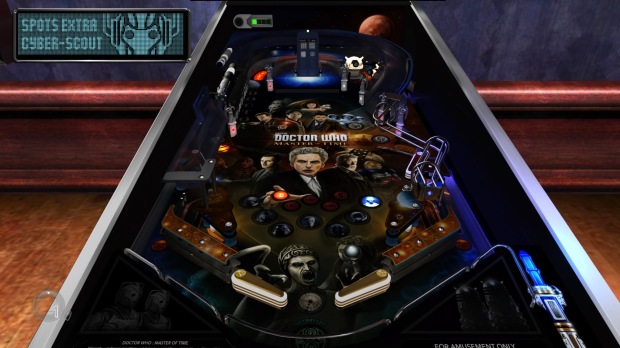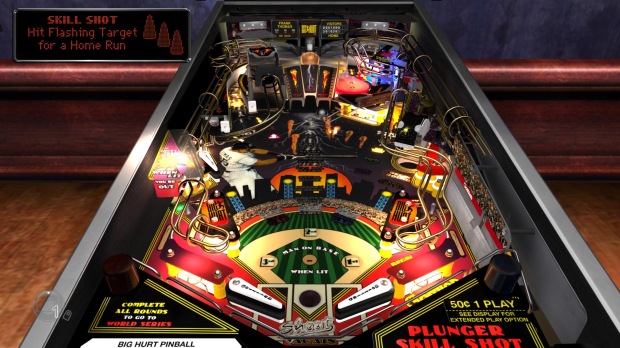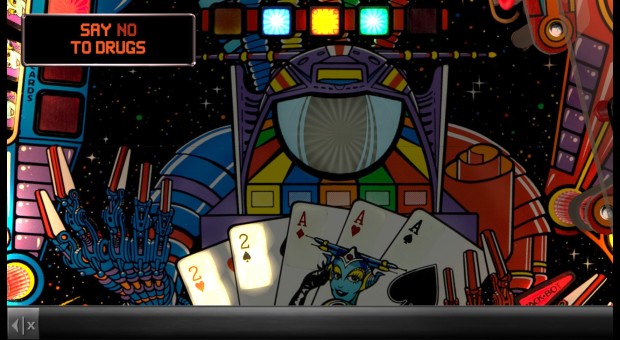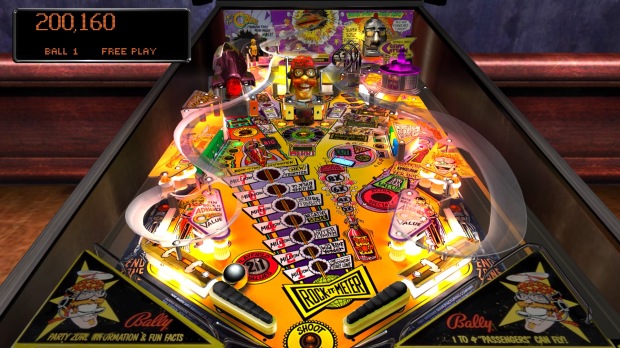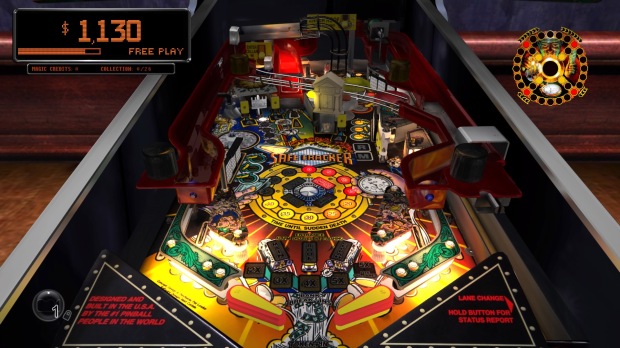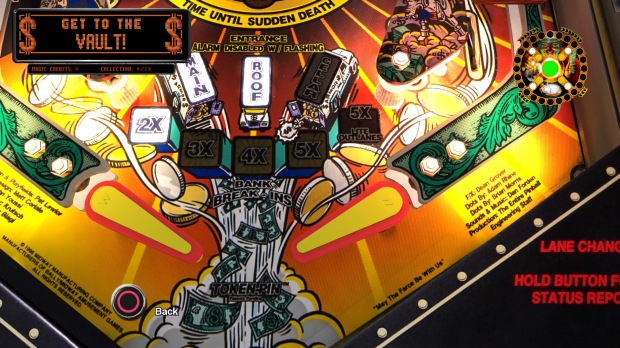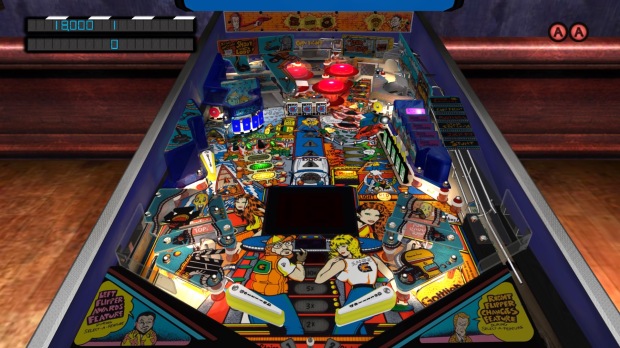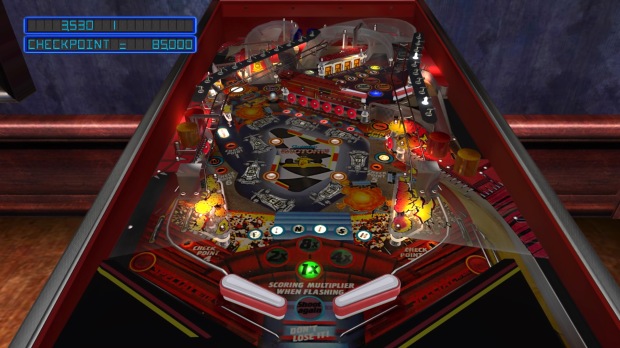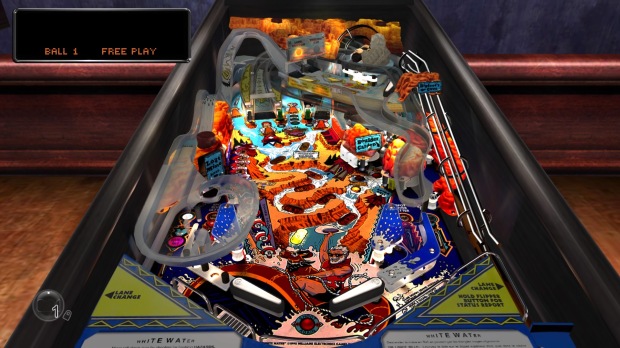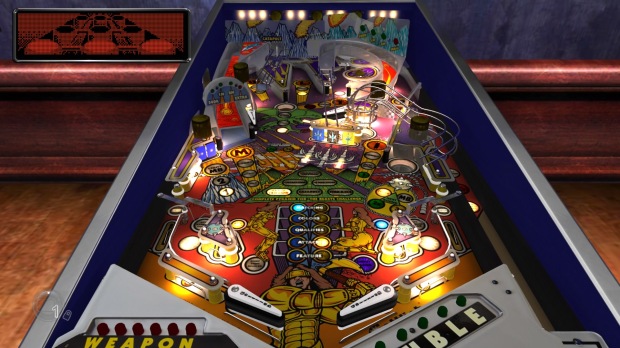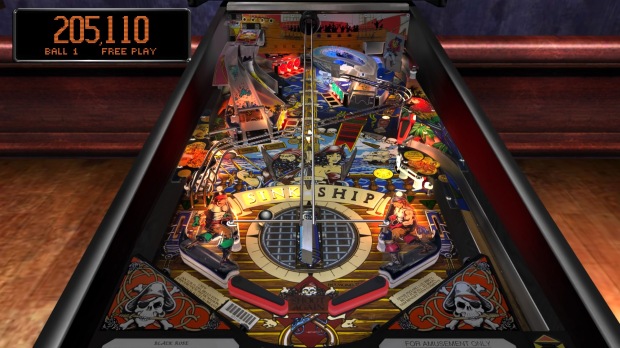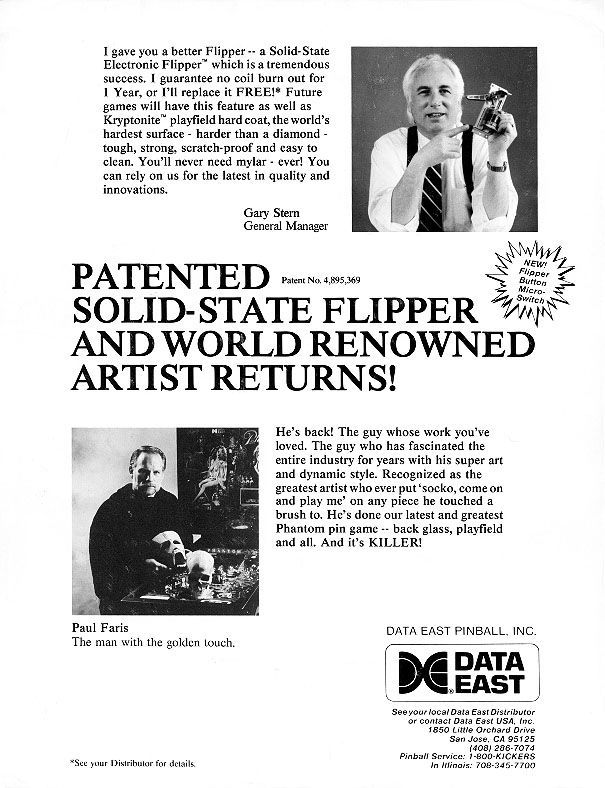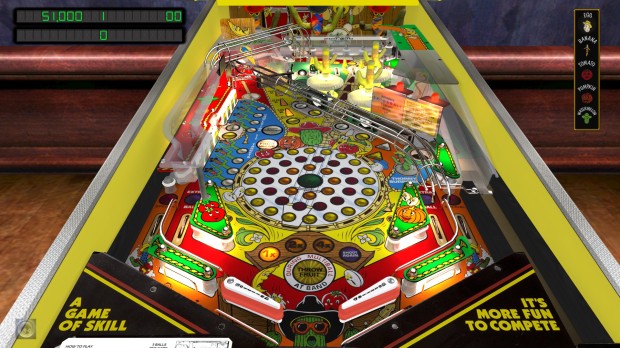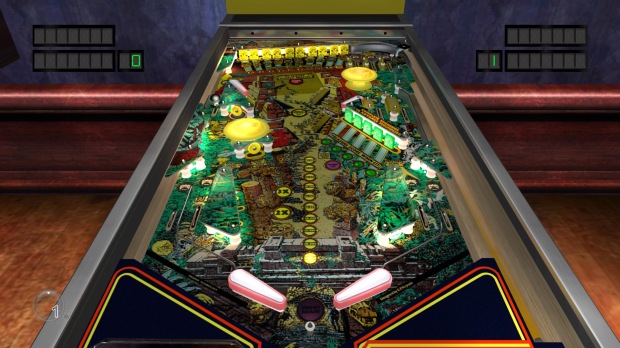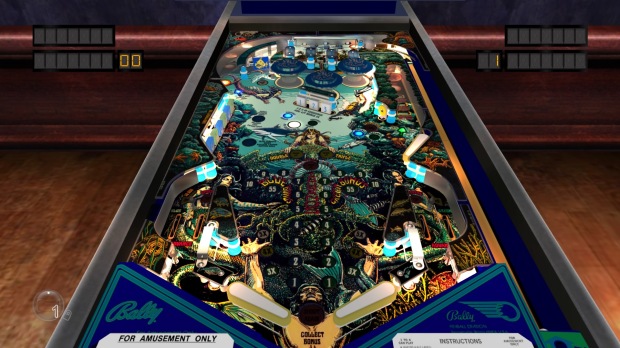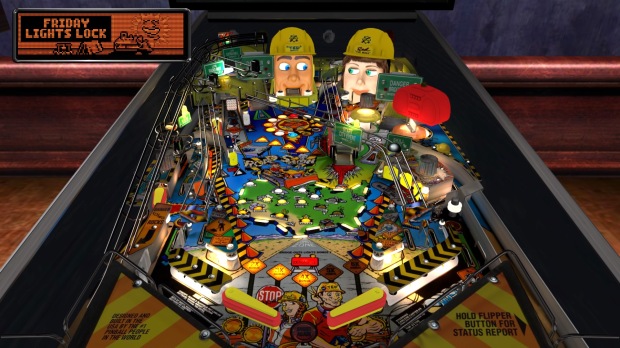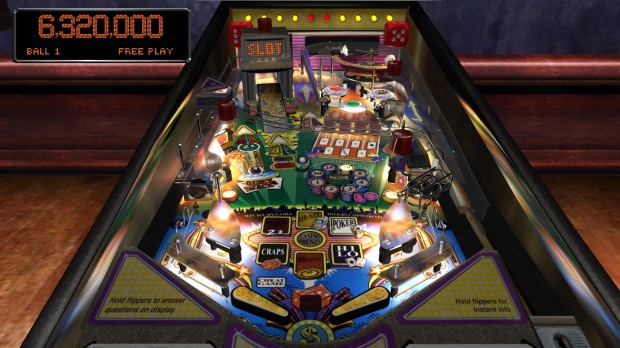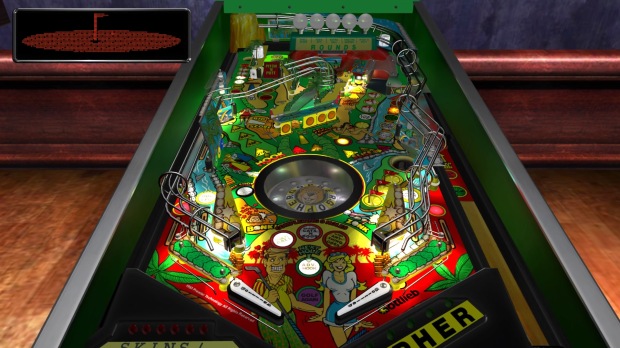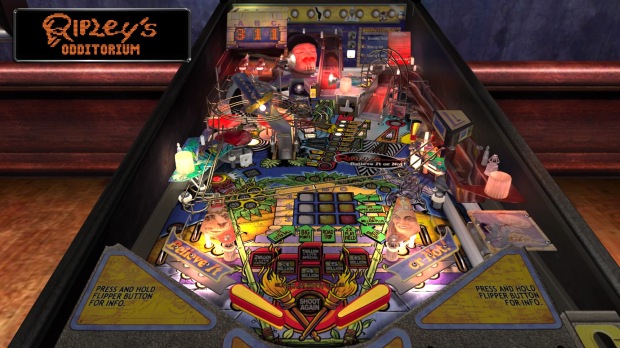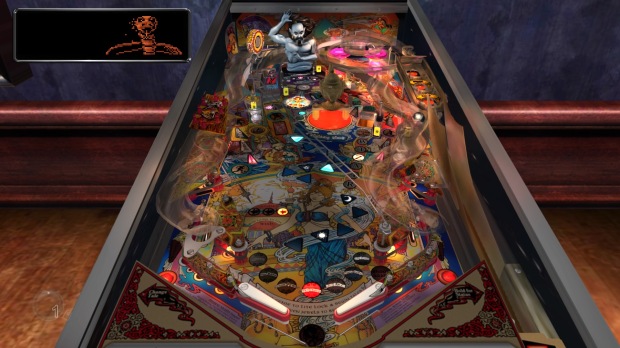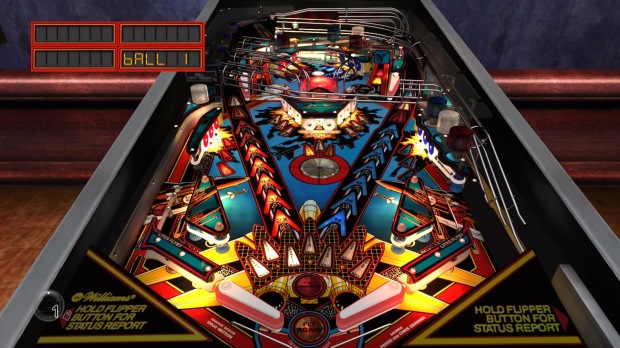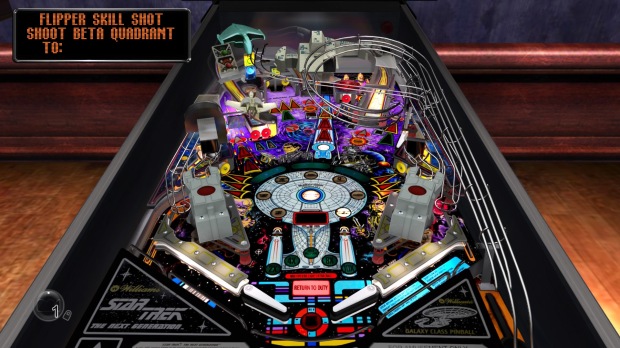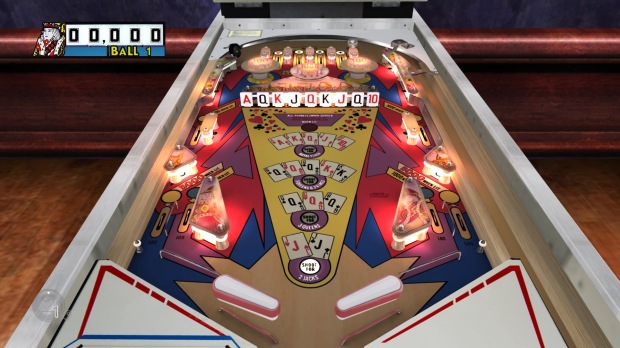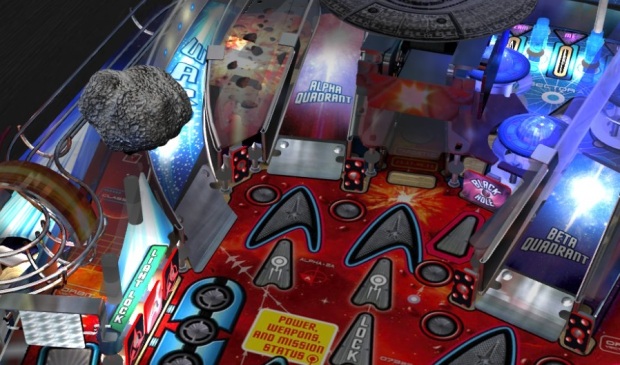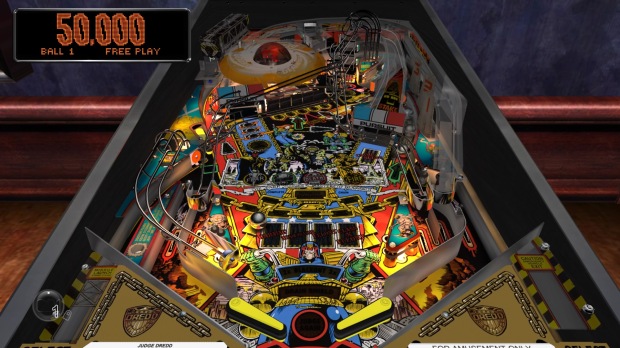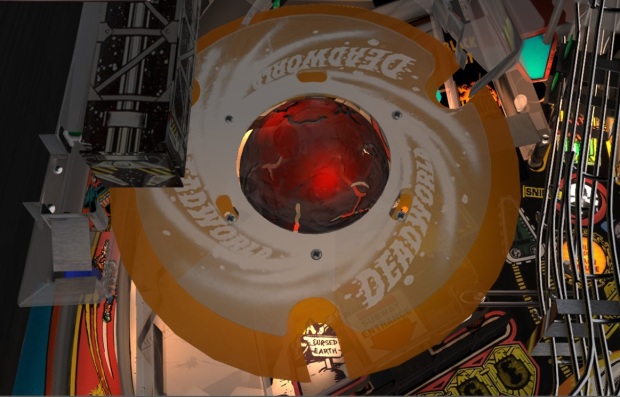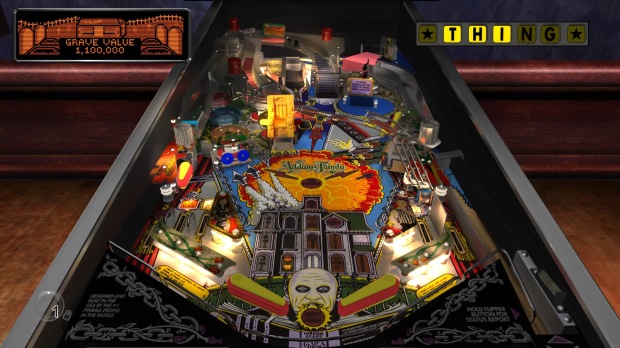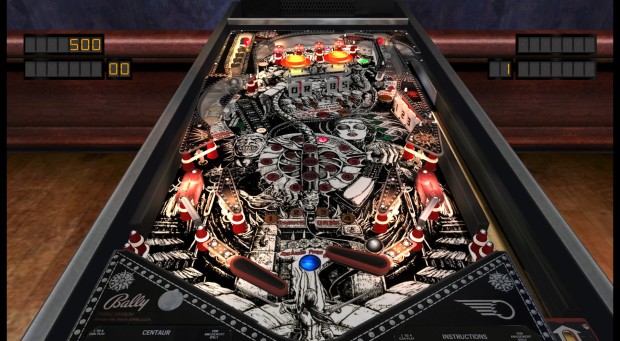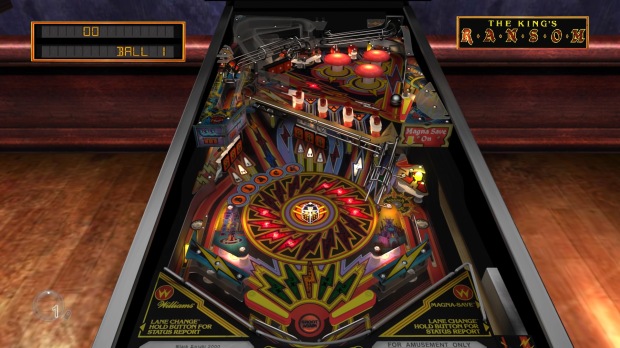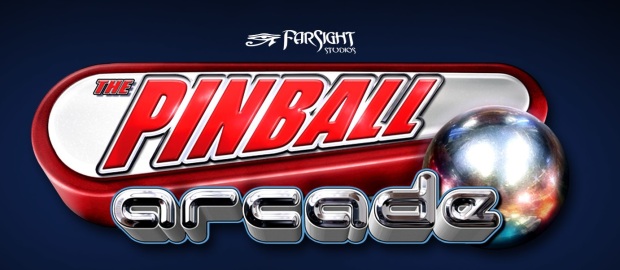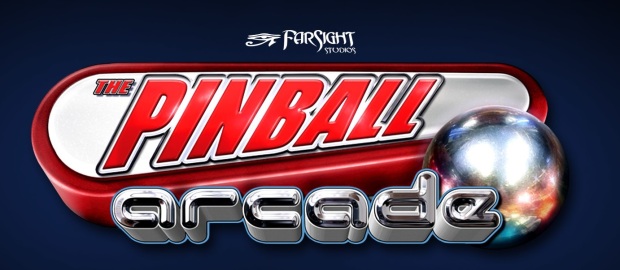 UPDATE – April 8, 2021: The table formating has been completely revamped. Artist/Sound/DMD credits have been added for every table. We’ve also added each table’s Arcooda software status. A full review of the 76 Arcooda tables is coming soon to The Pinball Chick.
UPDATE – April 8, 2021: The table formating has been completely revamped. Artist/Sound/DMD credits have been added for every table. We’ve also added each table’s Arcooda software status. A full review of the 76 Arcooda tables is coming soon to The Pinball Chick.
Welcome to The Pinball Chick complete buyer’s guide for The Pinball Arcade. One-hundred unique tables were released for Pinball Arcade over the course of six years. This guide provides you with full ratings, reviews, and buying options for those tables. Or lack thereof. Addams Family Gold, which was available only to Kickstarter backers, is the only stand-alone release not covered here. These reviews should be considered valid for Stern Pinball Arcade as well, as the engine, tables, and all glitches and problems are universal to both games.
This guide doesn’t cover the Gottlieb 12 in 1 digital table produced by Toy Shock, which uses a modified Pinball Arcade/Stern Pinball Arcade engine.
Please do not copy or reprint this guide. This was the work of nearly a year and hundreds of hours spent across multiple platforms. Passages may be quoted, but otherwise, please link directly to ThePinballChick.com Complete Buyer’s Guide to Pinball Arcade page.
Disclosure: I’d be lying if I said though our enjoyment of tables designed by John Trudeau weren’t affected by the fact that he is now a convicted pedophile that plead guilty to possession of child pornography and was also charged with aggravated sexual assault of a family member 13 to 17 years of age over a seven-year period. Sadly, Trudeau’s contributions to pinball can’t be removed from history. He’s the lead designer of eight tables in this review. Trudeau DOES NOT RECEIVE ROYALTIES for sales of Pinball Arcade or competitor Pinball FX3. You’re not contributing to this monster by enjoying these tables. We thought about removing them entirely from all future Pinball Chick reviews, but we were contacted by an anonymous contributor to one of Trudeau’s tables who wanted us to continue with the reviews, stating that tables are a collaborative effort. Not just artwork, but design ideas, layouts, scoring, and targeting. We agree. The Pinball Chick unequivocally denounces Trudeau and his actions, but tables he directed have merit beyond his own contributions and must be discussed.
PART ONE: DELISTED TABLES AND WHAT YOU CAN DO
63 of the 100 tables featured in The Pinball Arcade were permanently removed from digital stores on June 30, 2018. These tables are gone, and they’re never coming back. If you’re a PC, Xbox One, or Switch player, the only delisted table you can still acquire is AC/DC, by buying the physical version of Stern Pinball Arcade. Otherwise, the only way you can download these tables is if you had already purchased them.
BUT, if you have a PlayStation 4, you still have options for 28 of the 63 removed tables. That’s because, exclusively on PlayStation 4, The Pinball Arcade Season One and Season Two were released physically. These discs are out of print. As of July 1, 2020, the average price for a brand new copy of either season is typically between $18 to $30. Because tables featured are delisted, it’s possible that prices will climb. Yes, my father and I somehow ended up with all the delisted tables for PlayStation 4, Nintendo Switch, and PC. You won’t be able to do that (unless presumably you write a 250+ page review of the Pinball Arcade and they’re impressed enough to hook-you-up with them). So, what are your options?
THE PINBALL ARCADE: SEASON ONE PLAYSTATION 4 PHYSICAL DISC
Season One was released globally on PS4 and contains the following 17 Delisted Tables.
†: The Pinball Chick Certified Excellent Table/Pantheon Certified Table
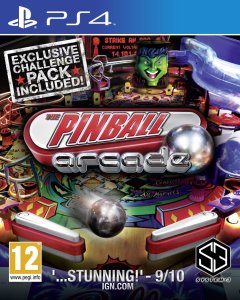 Attack from Mars †
Attack from Mars †
Black Knight †
Cirqus Voltaire
Creature from the Black Lagoon
Elvira and the Party Monsters
FunHouse †
Gorgar †
Medieval Madness †
Monster Bash †
No Good Gofers
Scared Stiff
Star Trek: The Next Generation
Tales of the Arabian Nights
Taxi
The Machine: Bride of Pin*Bot
Theatre of Magic
Twilight Zone †
In addition, it provides the following five tables that can still be purchased via DLC.
Big Shot
Black Hole†
Genie
Harley Davidson: Third Edition
Ripley’s Believe it or Not! (Not available on DLC for Nintendo Switch)
The Pinball Arcade: Season One’s physical release is unanimously recommended by The Pinball Chick team. All PlayStation 4 discs are region-free, but depending on the region you purchase, you might be locked out of obtaining trophies.
BUYING OPTIONS
THE PINBALL ARCADE: SEASON TWO PLAYSTATION 4 PHYSICAL DISC
Season Two was released only in the UK, but the disc will work without complications in all regions. US customers can’t unlock trophies off this disc. Season Two contains the following 11 Delisted Tables.
†: The Pinball Chick Certified Excellent Table/Pantheon Certified Table
 Cactus Canyon
Cactus Canyon
Centaur
Dr. Dude and His Excellent Ray†
Firepower†
Flight 2000
Pin*Bot
Space Shuttle†
Terminator 2: Judgment Day†
The Champion Pub
Whirlwind
White Water
SPECIAL NOTE: Despite being advertised, Tales of the Arabian Nights is NOT included in Season Two’s Disc.
In addition, it provides the following 8 tables that can still be purchased via DLC.
Central Park
Class of 1812
Cue Ball Wizard
El Dorado City of Gold
Goin’ Nuts
Haunted House
Tee’d Off
Victory
Although the lineup has fewer delisted exclusives, Season Two is a legitimate powerhouse of a set, featuring my top-ranked table and the highest team-ranked table (Terminator 2 was ranked #1 by Jordi & myself and #3 by Oscar), and Oscar’s highest rated delisted table can still be acquired (1980’s Firepower, rated #2 by him). Like Season One, this is a must-own for pinball fans who own a PS4.
BUYING OPTIONS
WHAT ABOUT AC/DC?
AC/DC was removed from The Pinball Arcade and from Stern Pinball Arcade on July 1, 2019. While you can’t digitally purchase the table, the physical release of Stern Pinball Arcade for PlayStation 4, Xbox One, and Nintendo Switch includes AC/DC plus two special edition versions of it. If you already previously downloaded the digital version of Stern Pinball Arcade, you must completely uninstall it from your console before inserting the physical media. This may include manually deleting all save files. A new download will happen, and once it’s completed, you’ll have AC/DC. Stern Pinball Arcade uses the same engine as Pinball Arcade, only with worse graphics (God knows how they did that for a game released AFTER Pinball Arcade) and less options, plus a clunkier interface. It’s also one of three Pinball Arcade tables I don’t have for Nintendo Switch, along with Whoa Nellie and Big Buck Hunter. It’s THAT hard to get even with the right connections. It’s also worth noting that I did gameplay footage of it on Twitter and nearly had my account suspended for violating music copyrights. If you do get AC/DC, for God’s sake, don’t stream it, and don’t even post 30-second clips of it to Twitter. The people who own the music are jerks.
WHAT ABOUT FLIGHT 2000?
Flight 2000 is advertised on some DLC packs, but purchasing those packs WILL NOT get you that table. It has been permanently delisted because the rights to the table belong to the estate of Harry Williams, and those were tied to Midway Manufacturing’s Williams/Bally rights. Stern Table Pack 1, which previously contained both AC/DC and Flight 2000, now contains ONLY Ripley’s Believe it or Not!, Star Trek, and Starship Troopers. This set is not available on Nintendo Switch at all. On Steam, while the logo is included on the pack, the set only includes the three tables mentioned above (plus Mary Shelley’s Frankenstein, which you get for free anyway).
WHAT ABOUT PLAYSTATION VITA?
The PlayStation Vita builds are so entirely different from the console/PC/mobile versions (including previous-gen builds like PS3) that it’s essentially an entirely different product. Unlike the other Pinball Arcade games, Vita’s build has physics that feel universal to every table, and those physics are of the “marble in a toy pinball game” variety. They just aren’t good at all. There’s something decidedly off about the whole experience, to the point that I abandoned plans for full-coverage. Unbelievably, despite the loss of license, Season 3 is STILL FOR SALE at the time of this feature’s publication on Vita (which I believe will also net you the PS3 version, but don’t take my word for that). UPDATE: And it’s gone. High Speed is fine on it, at least. Dad liked it. I didn’t.

Dr. Dude and His Excellent Ray on Vita doesn’t look that bad. It plays horrible, though. All Vita tables do. I vaguely remember trying Black Hole and Tales of the Arabian Nights when they came out, not being impressed, and walking away. I did buy several seasons on PS3, which held up remarkably well, all things considered. Meanwhile, Diner is unplayable on Vita. I don’t mean “it’s bad.” I mean it’s literally unplayable, with so much lag and slowdown that I honestly thought the game might crash.
WHAT ABOUT WII U?
Seasons 1 – 5 are apparently, as of this writing, still for sale digitally on Wii U. However, these tables were not patched or maintained like other seasons and are apparently unstable. For that reason, they weren’t covered here.
WHAT ABOUT NINTENDO SWITCH?
One of the strangest things happened on Nintendo Switch: All the Bally and Williams tables were released in April, 2018.. and then immediately delisted. As in, they were gone in ninety minutes. Gone-gone. They never came back. The only explanation I’ve heard is that, although the deal they had for the Williams/Bally licenses wasn’t set to expire for another two months, there was either something in their contract or something in Nintendo’s rules that didn’t allow them to be listed if they knew they’d have to be delisted in short order. And yet, THEY WERE LISTED. I know, because I have them all. Well, everything but AC/DC, which my hook-up believed all codes were destroyed for. Also, Whoa Nellie and Big Buck Hunter were never developed for Nintendo Switch as far as we can tell. If you happen to have a working Nintendo Switch code for AC/DC and you appreciate the effort of this 60,000+ word project (yep, you’re just getting started, bub. Put a pot coffee on!), send it my way so that I can get a complete Switch collection. Plus, then I can eventually do a separate review for Tate mode.
The really weird thing is, I have well-placed sources that suggest to me Farsight themselves never meant to release any of these Bally/Williams tables and it was a series of miscommunications that led to them being sent to Nintendo for approval. Now, I’m chummy with a lot of game developers and a few Nintendo people. I know the process to get stuff listed on the Switch eShop. I find it unfathomable that someone could accidentally begin the process of getting an eShop listing eight times over. I’m not suggesting malicious intent here. I am suggesting a massive communication error. It’s clear that the Williams/Bally tables had development abandoned early, and what work was done wasn’t close to finished. So, what did you miss out on? I won’t lie: it’s pretty cool to have portable versions of these, especially since the Vita ones I had were not truly simulations of real tables. But, these are essentially unfinished prototypes, and it really shows on a few. Cirqus Voltaire and Scared Stiff are nearly unplayable due to slowdown.
WHAT ABOUT PRO MODES?
One of the coolest features of Pinball Arcade is that, for a little extra money, you could purchase “pro modes” of tables that let you explore the tables (most of the screenshots in this feature were taken using that mode) and, in many cases, open up the coin doors. For those that have never owned a real pinball machine (or worked in an arcade), when you can access the operator’s options, you can adjust settings for tables. Funny enough, not every table in Pinball Arcade is on the default setting. Many have included extra time to their hurry-ups (to compensate for the difference in real-world physics), to tone down the difficulty (or, rarely, to scale it upwards), add extra balls where you might otherwise win a useless replay, increase or decrease the odds of certain events triggering, and more. Not all tables had Pro Modes, and not all Pro Modes had coin door access. Either way, this feature is completely gone. It would have been damn decent of Farsight, once they lost the license (and, seemingly, interest in pinball in general) to turn on Pro Mode for everyone. I don’t think any buyers of those modes would object to everyone getting them now. It would be a great way to tip their hat to the fans that have supported them, and still do. Pinball FX3 doesn’t have their own version of this yet, but maybe someday, they’ll include at least some operator options. The only options left if you want pro modes are, weirdly, on Vita (and likely PS3 via cross-buy as well).
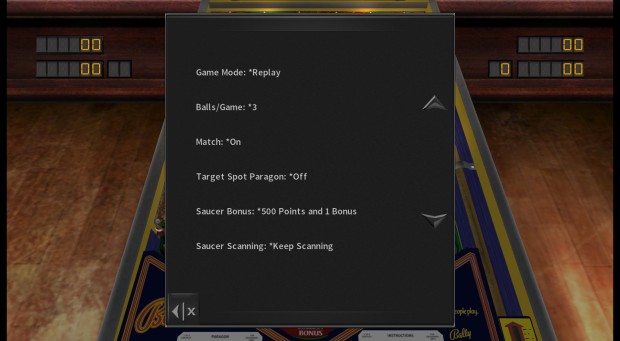
Farsight was kind enough to provide us with pro modes for every table they made them for. Sometimes they just created in-game menus for them, like with Paragon here. For others, like Black Knight, you’d actually need to consult an owner’s manual for a real table online and fumble through the dozens, maybe even hundreds, of options. Once alpha-numeric and dot-matrix displays became a thing, it was easier to make adjustments if you owned a machine. HOWEVER, sometimes Pinball Arcade wasn’t built with them in mind and tinkering with the settings caused all kinds of issues. In fact, every single Gottlieb System 3 table we tried to adjust had some kind of catastrophic failure. Hell, sometimes it didn’t even seem like it was on Pinball Arcade. Sometimes the scoring engine just froze, like it didn’t know what to do next. This never happened to us on a Williams or Bally DMD. On Gottlieb, Sega, Data East, and Stern? It happened. Hell, in cases of games like Last Action Hero, it would seem they didn’t even provide enough buttons for the coin doors to work. Why even charge for them?
Pro Modes were never made for the following tables: AC/DC, Big Buck Hunter Pro, Big Shot, Black Hole, Bride of Pin•Bot, Centaur, Central Park, Cirqus Voltaire, El Dorado City of Gold, Elvira and the Party Monsters, Firepower, Funhouse, Genie, Ghostbusters, Gorgar, Harley Davidson, Haunted House, Monster Bash, Mustang, No Good Gofers, Ripley’s Believe it or Not!, Space Shuttle, Star Trek, Taxi, Theatre of Magic, Victory, and Whoa Nellie. For some tables such as Fireball, it offered only the ability to explore the table, nothing more. EDIT: Yes, and the ability to control the ball with the right analog stick, IE cheat. But I’d NEVER use it for that. I’d never, say, turn it on while Dad was grabbing a drink in the other room and then subtly use it to complete my shots. I’m above using such treachery. (Shifty Eyes)
Also, once you activate Operator Mode, you can’t post high scores to the online leaderboards.
GONE FOR GOOD
The following 34 tables are permanently delisted and can’t be acquired on PlayStation 4, Xbox One, Nintendo Switch, or PC by legal means, EXCEPT if you want to invest in Arcooda’s digital table software.
†: The Pinball Chick Certified Excellent Table/Pantheon Certified Table
Banzai Run†
Black Knight 2000†
Black Rose
Bram Stoker’s Dracula
Cyclone
Diner
Doctor Who†
Earthshaker!
Eight Ball Deluxe
F-14 Tomcat†
Fathom
Fireball
Firepower II†
Fish Tales
High Speed†
Hurricane
Indianapolis 500†
Jack*Bot
Judge Dredd†
Junk Yard
No Fear: Dangerous Sports
Paragon
Red & Ted’s Road Show
Safe Cracker
Sorcerer
Spanish Eyes
Swords of Fury†
The Addams Family
The Getaway: High Speed II†
The Party Zone
WHO Dunnit
Wild Card
World Champion Soccer (World Cup Soccer)
Xenon
Your only options are piracy or getting someone who made all the season purchases to let you use their account. Neither of these methods are endorsed by The Pinball Chick. Share your account at your own risk.
ARCOODA DIGITAL TABLE SOFTWARE
The final bastion for many Pinball Arcade tables is the $499.99 Arcooda branded software. There is still a limited availability of these, and once their supply is gone, it’s gone. Now, these aren’t the exact-same builds that came with the standard versions. These are separate builds designed specifically for digital table projects. If you make the order at their website, you’ll receive in the mail a USB stick that contains 76 of the 100 tables made for Pinball Arcade.
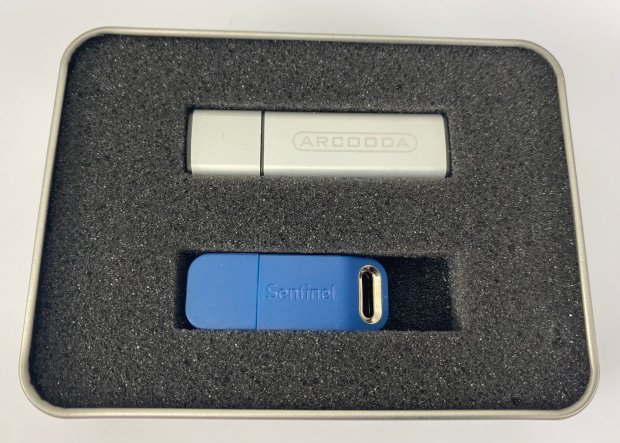
Dash, an associate of The Pinball Chick, ordered the $499 Arcooda software. Just a couple days later, this USB stick arrived in the mail.
The price is steep and some of the missing tables hurt, BUT, these are the best builds of any Pinball Arcade options. While they use the Pinball Arcade software, dimensions are more accurate, giving a more authentic experience. You do need a pretty beefy PC to operate it, and you need two monitors. One monitor will act as each table’s backglass, while the Pinball Chick recommends a 40-inch widescreen monitor that has no glare when turned on its side. ANY widescreen monitor can work, BUT, make sure there’s no glare. If shopping for a table, ask an employee if you can turn the sample one on its side! If you can’t view the table straight-on without glare or (or color bleeding), get a different monitor. You can even include a third monitor to serve as the DMD display!
NOT included is any table from Stern’s catalog, which includes Sega Pinball & Data East’s catalog as well. Also not included is any “Season 7” table. The following tables are NOT included:
- AC/DC
- Banzai Run
- Big Buck Hunter Pro
- Fathom
- Firepower II
- Flight 2000
- Ghostbusters
- Harley Davidson
- High Roller Casino
- Last Action Hero
- Mary Shelley’s Frankenstein
- Mustang
- Paragon
- Phantom of the Opera
- Pistol Poker
- Ripley’s Believe it or Not!
- Sorcerer
- Spanish Eyes
- Star Trek
- Starship Troopers
- Whoa Nellie
- Wild Card
- Wipe Out
- World Champion Soccer (World Cup Soccer)
While no Pinball Chick Pantheon tables are lost, there’s several quality tables not included. BUT, there many more incredible tables, making the Arcooda package your very best option for acquiring a large collection. Not only that, but, you’re getting superior versions of these tables. For example: the standard Pinball Arcade build of Black Hole scored unanimous ratings of GREAT from Cathy/Oscar/Angela. But, the Arcooda version of Black Hole scored unanimous MASTERPIECE ratings and entered the Pinball Chick Pantheon of Digital Pinball. Myself, Oscar, and Angela awarded the standard Twilight Zone “Great” rankings. For Arcooda, we all have it as a Masterpiece and projected to be in our top three, with myself awarding it the #1 spot. These builds are so superior that we have no choice but to score and rank them separately from the standard versions.
One last note: if you already own the Steam versions of the 76 Pinball Arcade tables that are included in the Arcooda software package, you can pay only $149.99 to unlock the cabinet versions. These are NOT the same builds you would get by running the tables on a monitor set to portrait mode. Sometimes the differences are subtle but lead to massive gains in realism. There’s also a glasses-free 3D feature that you can only get with Arcooda. This requires you to have an Xbox One-generation Kinect camera (and a special USB adapter for it if you own a first-gen XB1 Kinect, which can be found on Amazon for under $10) and Windows 10. This effect is fantastic, especially on multi-leveled tables like Black Hole, Haunted House, Black Knight, etc. We highly recommend whatever version of Arcooda’s software you can get. Premium price, but you do get premium builds. And hey, $499.99 sounds expensive, but it works out to $6.57 a table. That’s actually a pretty good deal.
PART TWO: ACTIVE PINBALL ARCADE DLC RATINGS
As of July 1, 2020, there’s 9 DLC sets (36 total tables) you can purchase for The Pinball Arcade, plus a free table (Mary Shelley’s Frankenstein) comes with the launcher’s download. On Nintendo Switch, only seven sets (31 total tables + Mary Shelley’s Frankenstein) can be purchased, with Stern Pack 1 being shown as for-sale, but if you try to purchase it, you will be denied access. Stern Pack 3 (the final pack ever made for Pinball Arcade) was never released on Switch for unknown reasons, and likely never began development.
All reviews are done by me, Cathy, aka Indie Gamer Chick, aka the Pinball Chick. The stand-alone Doctor Who: Master of Time table isn’t included, but at $4.99 for one of the very worst tables in Pinball Arcade, you’d be better lighting your money on fire. At least it’ll create warmth for a few seconds.
#1: Gottlieb EM Table Pack
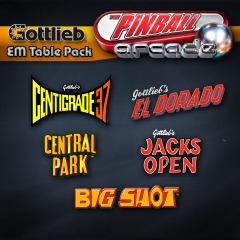 5 Tables for $8.99
5 Tables for $8.99
Certifications: Centigrade 37 (Certified Excellent)
TOP TABLE
Cathy: Centigrade 37 (#17)
Oscar: Big Shot (#31)
Jordi: Centigrade 37 (#13)
Score one for senior citizens everywhere. Because, following the delisting of Bally/Williams tables and the abandonment of the Season model, the best DLC set you can get for Pinball Arcade is the Gottlieb EM Pack. A pack where the newest table came out twelve years before I was born. But, before you roll your eyes and think our team is some kind of Boomer crowd, think again. I’m 30 and a Pat Lawlor fan. Jordi prefers a casual, non-committal pinball experience. Okay, so this was clearly our resident old fart Oscar’s doing, right? He’s in his 70s and has one foot in the grave. This was his fault! WRONG! Oscar (aka my Dad) was the lone hold out for Centigrade 37 getting a perfect score (and in fact ranked it GOOD, two tiers below the MASTERPIECE ratings that Jordi and I gave it) and thinks the Golden Age of pinball was from 1979 to 1987.
No, it turns out, this set is just plain timeless. And polarizing. My Dad and I enjoyed Jack Opens’ simple targets. Sort of like the basketball game H-O-R-S-E in pinball form, but Jordi hated it. Jordi and I loved the white-knuckle thrills of seeing the ball travel down the bonus trails of Centigrade, but Dad rolled his eyes and thought it was just alright. Jordi and Dad enjoyed the target-range feel of Big Shot, while I thought it was a bore. I loved the “ANOTHER FREE BALL!” joy of Central Park while they scoffed at me. And El Dorado was.. just there. It’s hard to rate that one because there’s a solid state remake of it that plays better included in Gottlieb Table Pack 2. Either way, the Gottlieb EM Pack isn’t just for old timers, or for pinball purists. If you’re open-minded, the thrills and fun that are found within this pack are as legit in the 2020s as they were in the 1960s and 70s!
SET RECOMMENDED
#2: Stern Table Pack 1
3 Tables for $4.99
NOT AVAILABLE FOR NINTENDO SWITCH
Certification: Star Trek (Certified Excellent)
TOP TABLE
Cathy: Star Trek (#29)
Oscar: Star Trek (#20)
Jordi: Ripley’s Believe it or Not! (#26)
Probably the best value in Pinball Arcade is Stern Table Pack 1, despite the table rating. Ignoring the putrid Starship Troopers, five bucks gets you two extremely solid tables. Ripley’s Believe it or Not! is Pat Lawlor’s spiritual sequel to Twilight Zone, while Star Trek is easily the most consistently good post-90s table that should be able to please anyone.
Yea, Starship Troopers, an extremely sloppy Sega Pinball table that runs like snot, drags the other two down. Trust me, it’s the poster child for everything wrong with their pinball division (which was formerly known as Data East Pinball) and isn’t even as bad as they got around this era. Ignore it. Ripley’s makes for a good challenge, while Star Trek is the perfect introductory table for shooting combos. Honestly, you could download Pinball Arcade’s launcher and enjoy Frankenstein, Ripley’s, and Star Trek, never purchase another table, and still get a wonderful feel for the medium. By the way, Star Trek is known as Vengeance Edition because that’s the model of the real Stern table, as opposed to the special Enterprise Edition that you can buy in Stern Pinball Arcade if you feel like taking a torch to your income.
SET RECOMMENDED
#3: Stern Table Pack 2
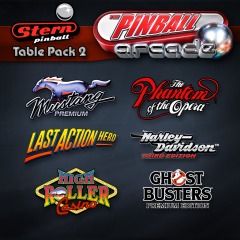 6 Tables for $19.99
6 Tables for $19.99
Certifications: None
TOP TABLE
Cathy: Mustang (#38)
Oscar: Ghostbusters (#46)
Jordi: Harley Davidson – Third Edition (#22)
We’ve reached the point where value is harder to justify. Now, in fairness to Stern Table Pack 2, of the eighteen ratings cast by The Pinball Chick team for tables in this set, fifteen of the eighteen were “GOOD”, one was “GREAT” and two were “BAD”. It’s a quirk of math that this set scored averages below “GOOD”. So, we’re going to bend the rules and award this set (and the next set as well) a VERY tepid “worth buying” recommendation. But it really tells you just how tragic the Bally/Williams purge was that this is now the third best set left you can buy.
Stern Pack 2 is as middle-of-the-road as it gets. The highest rated table if you consider the entire Pinball Chick team? Harley Davidson (Good/Good/Great), a typical post-Arcade style Stern table where my Dad and I once had thirteen multiball rounds over the course of a typical three-ball duel. I mean, Jeez! Does it have nothing else going for it? No, it doesn’t. It really is just a spam-multiballs table. Mustang and Ghostbusters are in a similar boat, with Mustang being fine but bland. Ghostbusters had the highest potential of any of the Stern Pack tables, and certainly is the most ambitious table you can still purchase. But, bizarre magnetic playfield mechanics and straight-up unfair shots make the table so maddening that it defies full enjoyment. Meanwhile, Jon Norris & Keith Johnson’s High Roller Casino is a solid table undone by the fact it was never designed to work with the Pinball Arcade’s physics, rendering it merely okay.
Probably the most significant table in this pack is Last Action Hero, which was, once upon a time, the most expensive (or possibly second-most-expensive) pinball machine ever made. It’s fascinating to play today knowing that it’s directly responsible for the death of Data East Pinball (which was later sold to Sega, becoming Sega Pinball). I suppose the best thing about playing it on Pinball Arcade is that all the notorious hardware failures that plagued real machines don’t happen to it, though no table featured us marooning more balls than Last Action Hero did (except Ripley’s Believe it or Not!). Meanwhile, Phantom of the Opera is just sort of there. I didn’t like it. The boys did, but barely so.
SET RECOMMENDED
#4: Gottlieb Table Pack 2
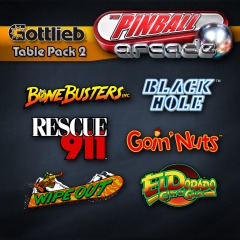 6 Tables for $9.99
6 Tables for $9.99
Certification: Black Hole (Certified Excellent), Goin’ Nuts (Certified Turd), Rescue 911 (Certified Turd)
BEST TABLE
Cathy: Black Hole (#30)
Oscar: Black Hole (#25)
Jordi: Black Hole (#25)
Ignore the bottom three tables (Goin’ Nuts, Bone Busters, and Rescue 911) and Gottlieb Table Pack 2 is a solid value for $9.99. Black Hole is an all-timer. It was one of the first “notoriously unreliable” tables of the solid-state era, which means that a digital table that’s 90% close enough to the real thing is a better choice to own than tracking down a real table and spending a few grand on it. Sadly, the physics for this one are probably closer to 80% there. It’s still far and away the machine that anchors Gottlieb Table Pack 2.
The rest of this pack is a bizarre mash-up. El Dorado: City of Gold is a solid-state remake of the same electro-mechanical table found in the Gottlieb EM Pack. Having both ported to Pinball Arcade is an insult, but at least the table is still fairly decent. Wipe Out is a perfectly average table despite its ambitious tilt-table mini-game. Bone Busters is one of the better “bad” tables and it’s certain to leave you walking away saying “it feels like I should like that table more than I did, which isn’t a lot.” That’s all you can hope for from that era of Gottlieb. Suck it up, everyone, it’s downhill from here.
SET RECOMMENDED
#5: Gottlieb Table Pack 3
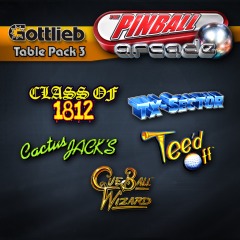 5 Tables for $8.99
5 Tables for $8.99
Certifications: None
TOP TABLE
Cathy: Tee’d Off (#46)
Oscar: Class of 1812 (#63)
Jordi: Class of 1812 (#24)
The drop in quality between Stern Pack 2 and Gottlieb Table Pack 3 is huge. With the possible exception of Tee’d Off, which Dad can literally not believe we rated as highly as we did, nothing in Gottlieb Table Pack 3 is the least bit memorable or lasting. Not for the lack of effort, though. Class of 1812, which Dad can literally not believe we rated as highly as we did, was ahead of its time. Releasing in 1991, it flopped BAD for Gottlieb. A year later, Addams Family would set-off a wave of sardonic gothic-horror tables that culminated in Monster Bash, which is the same exact concept (though done so much better). Go figure, right?
That’s the story with Gottlieb Table Pack 3. Cue Ball Wizard is the most ambitious pool-based pin ever made, with an actual Brunswick cue ball and everything! It even has probably the best sense of flow of any 90s Gottlieb featured in Pinball Arcade. Sounds great, right? But, the table is insanely crowded to accommodate the cue stick and ball, leaving no room for finesse shots. While *I* liked it, as a team, Cue Ball Wizard got mostly bad scores. TX-Sector? High concept and visually striking (if you’re into that sort of thing) but the execution is extremely bland and scoring feels like a grind. Cactus Jack’s? Overly simple and limited. Tee’d Off, a game based on golf, has absolutely nothing to do with golf. Gottlieb Table Pack 3 isn’t horrendous by any means, but it’ll leave you wondering how Gottlieb competed at all during the arcade era.
SET BARELY NOT RECOMMENDED
#6: Gottlieb Table Pack #1
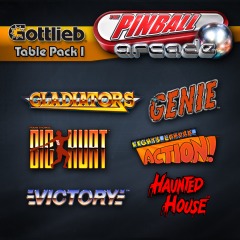 6 tables for $9.99
6 tables for $9.99
Certifications: Frank Thomas’ Big Hurt (Certified Turd)
BEST TABLE
Cathy: Genie (#44)
Oscar: Genie (#13)
Jordi: Haunted House (#32)
I’m going to catch flack for low-balling Haunted House, placing it in the BAD category (I have it #69), while both the boys have it in the GREAT category. A table with no flow and a design like they put a bunch of pinball elements in a circle around a cherry bomb, lit the fuse, and installed the elements wherever the parts landed after the explosion. For me, this was the worst possible six table set. What Gottlieb Pack 3 was to my father, only worse. I have one table rated as GOOD, three as BAD, and two in THE PITS. As for Haunted House, it’s one of the most polarizing tables of the solid-state era. People either love it for being just so weird or are bored silly by it. Count me as bored.
Only one table did all three of us all agree was unambiguously good: 1979’s Genie by the legendary Ed Krynski. Besides it and Haunted House, you’re not getting very memorable tables here. The history of Gladiators (it began production under the expectations of being based on the Nintendo franchise Legend of Zelda) is so much more interesting than the table itself, which is a confusing mess. Victory is a failed attempt by Gottlieb to have an answer to Williams’ High Speed or F-14 Tomcat. Frank Thomas’ Big Hurt was supposed to be their answer to World Cup Soccer, and it might have been a decent real table (I have my doubts) but this digital conversion is a huge swing and a miss, making it one of the worst tables in Pinball Arcade. Lights…Camera…Action is just a hot mess. A horrible pack with (mostly) horrible tables.
SET NOT RECOMMENDED
#7: Alvin G. & Co Table Pack
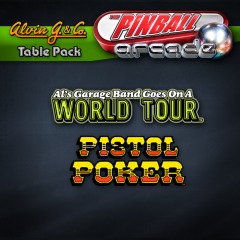 2 tables for $7.99
2 tables for $7.99
Certifications: None
BEST TABLE
Cathy: Pistol Poker (#81)
Oscar: Al’s Garage Band Goes on World Tour (#78)
Jordi: Pistol Poker (#88)
The sad thing is Alvin G. & Co’s pack isn’t even the worst set in Pinball Arcade, but it is the sole pack that didn’t receive a single positive score. Two tables and three reviewers = six votes cast, six negative votes total. Alvin G. & Co was a short-lived company, and with these tables it’s not hard to see why. These are abysmal pins. I think all three of us like the idea of fringe companies being represented in major digital pinball platforms and wish we could see more of them. Sadly, both tables have absolutely no flow. Pistol Poker had the most potential and I’d love to play a real table since I suspect the issues are related to translation. These tables feel especially floaty. Pistol Poker does have the distinction of being the rarest commercially-released table in Pinball Arcade (Goin’ Nuts was never put into production) at only 200 units produced. Of course, that doesn’t make it more fun to play. Al’s Garage Band feels like a cynical and transparently desperate attempt to connect with 90s kids, as attempted by a 60s kid. This set sucks, and that’s heartbreaking because we want to encourage more of this.
SET NOT RECOMMENDED
#8: Stern Table Pack 3
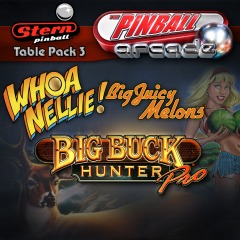 2 Tables for $14.99
2 Tables for $14.99
NOT AVAILABLE FOR NINTENDO SWITCH
Certification: Big Buck Hunter Pro (Certified Turd)
BEST TABLE
Cathy: Whoa Nellie! Big Juicy Melons (#91)
Oscar: Whoa Nellie! Big Juicy Melons (#84)
Jordi: Whoa Nellie! Big Juicy Melons (#70)
Only two tables that weren’t removed from rating consideration for being so glitchy that they’re broken received a rating of THE PITS from all three of us. One of those tables is Big Buck Hunter Pro, which finished #95 (Me), #95 (Dad), and #94 (Jordi) out of 96 rated tables. To say this table is an unprecedented disaster as far as modern conversions of real pinball tables go is an understatement. I don’t know if the real table is any good, but the digital version feels terrible to play. Like what digital pinball felt like a decade ago. Pinball Arcade has inconsistent physics (many Season One and Two tables are genuinely outstanding playing, while this set and Alvin G. & Co feel like they’re based on moon gravity), but Big Buck Hunter Pro is remarkably bad. Meanwhile, Whoa Nellie! Big Juicy Melons is a modern electro-mechanical table based around the premise that “melons” is a slang word for “breasts” with scantily clad women selling rednecks their “melons.” Yeah. Basically, $14.99 buys you our team’s lowest rated table (by far) and boob jokes. This is the single worst value in digital pinball. Any digital pinball.
SET NOT RECOMMENDED
PART THREE: TABLE RATINGS AND REVIEWS
All ratings are in my order, because, you know, my site, my idea. Tables so glitchy that they’re unplayable aren’t assigned a ranking.
Total Tables: 100
Masterpiece: 17
Great: 19
Good: 30
Bad: 18
The Pits: 12
Broken: 4
CERTIFICATIONS: The Pinball Chick team of myself, my father (Oscar), and Jordi all put significant time into each table before deciding our ratings, and then double-check and triple-check our notes to be extra sure. Once we’ve decided our ranking for each table, the table can be “certified” into one of three categories.
- Certified Excellent: Our team’s average rating is “Great” or better. A table earning three “great” scores gets this. A table earning a “Masterpiece”, a “Great”, and a “Good”, earns this. A table earning two “Masterpiece” scores and a “Bad” earns this.
- Certified Turd: The table must score at least two “The Pits” rankings from the team + the third score must be “Bad” or “The Pits.” 3 Pits = Turd. 2 Pits + 1 Bad = Turd. Two Pits + anything else = not a certified turd.
- The Pinball Chick Pantheon of Digital Pinball: All three of us award the table “Masterpiece” status. Two “Masterpiece” ratings + a “great” = the table is Certified Excellent. The rarest of the rare will enter the Pantheon, as it should be.
CLUBS: Any real table that sold 6,000 units receives “Club Status” from The Pinball Chick. It means that the average video arcade in America, at the time of the table’s release, was likely to have at least one of that table installed. Being in the 6K Club denotes an incredible sales achievement. From there, every additional thousand units sold raises the table into the next highest Club. The highest Club Status is the 12K Club, which means the table was all but guaranteed to be installed in every arcade in America PLUS was relatively commonly spotted outside arcades as part of vending routes. Only 23 pinball tables sold 12,000 or more units, plus two “honorary” tables (Big Shot and El Dorado) verified to have enough official clones of its playfield to clear 12,000 total units. Pinball Arcade has ten 12K Club Members. In order of total sales, they are: Addams Family, Firepower, (El Dorado), High Speed, Twilight Zone, Terminator 2, (Big Shot), F-14 Tomcat, Fish Tales, The Getaway: High Speed II, Black Knight, & Pin•Bot.
All reviews by Indie Gamer Chick
BROKEN
These tables were so glitchy that it’s almost impossible to enjoy them without glitches consistently, even predictably, interfering in gameplay.
#100*: The Champion Pub (Would have been rated THE PITS)
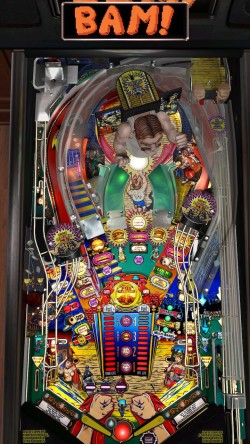 Featured in The Pinball Arcade: Season Two (PS4 Disc Only)
Featured in The Pinball Arcade: Season Two (PS4 Disc Only)
Included in Arcooda Software
Alternative Version: Pinball FX3 Williams Pinball Volume 3
Table Type: Pick ‘n Flick
TABLE FACTS
Based on a concept by Pete Piotrowski
Art by Linda “Deal” Doane & Paul Barker
Sound by Rich Carle
1998 Midway Manufacturing, 1,369 Units Made
TRIVIA
-Like other 1998 Midway tables, development was halted and no route testing was given to Pub.
-One of eight tables that reoccurring character “Crazy Bob” appears in.
REST OF THE TEAM
Oscar’s WOULD BE Rating: The Pits
Jordi’s WOULD BE Rating: The Pits
Angela’s WOULD BE Rating: The Pits
Eala’s WOULD BE Rating: The Pits
THE PINBALL CHICK CERTIFIED TURD
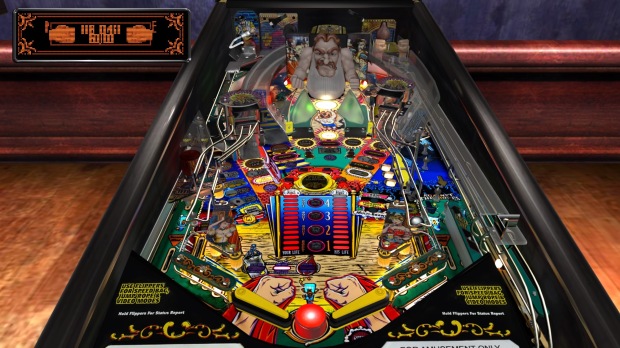
Weirdly, the Pinball Arcade version of Champion Pub plays faster. It’s not to the table’s benefit, either.
Even if The Champion Pub had worked.. and it doesn’t.. it would have been one of only three tables in Pinball Arcade to have scored five THE PITS ratings. Pub is one of the worst tables ever made, the worst of the Williams recreations in Pinball FX3, and at the bottom of The Pinball Arcade as well. This port brings all-new glitches along for the ride. Like the ball getting caught-up in the jump rope mini-game during a fight, thus eating up precious time. Or punches failing to register even worse in this version of the table than in the Pinball FX3 one. Like seriously, there’s nothing quite like landing full-speed flush-hits on the heavy bag only for NOTHING to happen. Then again, other targets sometimes don’t trigger as well so at least it’s consistent in its inconsistency. It’s the only table the five of us universally agreed on: the worst.
Or the jump rope going right through the ball. I got credit for ten jumps when I should have realistically gotten two or three at most. Combine this with the already present problems of the Champion Pub: the starving outlanes (especially the right one, which swallowed more balls than Pat “Deep Dish” Bertoletti, world record holder for eating Rocky Mountain Oysters), horrible layout, and an overall lack of refinement and you have one of the worst pinball machines ever. Functionally, the only difference between a digital Champion Pub and a real one is instead of breaking the boxer toy, you just break the game’s engine. Apparently this is true regardless of what engine you’re using. Also, I’m told the slingshots are considered some of the most disgustingly lethal on real tables, so yea, Champion Pub is going to be crap either way.
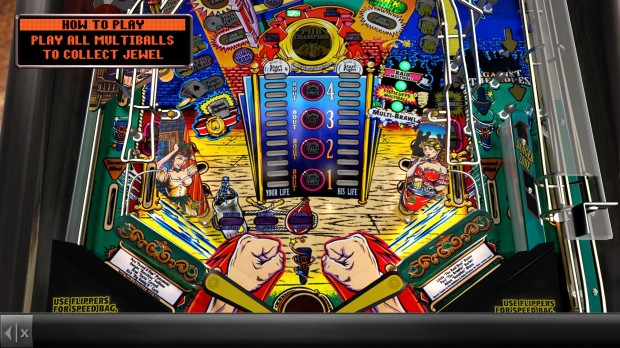
Not that this means anything, because gameplay is king, but the one and only positive I can say about Champion Pub is it’s a damn good looking table.
And then you get to the game-killing glitches. Like, you’ll do the jump rope section and the ball will fall off, but the mini-game will continue and you won’t have control of the flippers until the ball has already drained-out. This actually happened to my poor Mother of all people when we were going to attempt to show the worst tables in Pinball Arcade. Never mind that she was getting credit for jumps she didn’t complete. The mini-game kept going and she lost out. The Champion Pub, even if it works 100%, is unplayable due to starving drains, horrible rail design, dead zones, and terrible scoring. This glitch seals the deal as the worst digital pinball table you can get this generation. You did it Farsight! Top of the World.. in Opposite Land!
#99*: Doctor Who: Master of Time (Would be rated THE PITS)
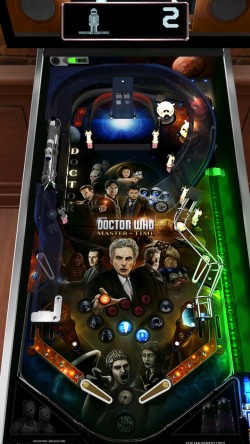 Stand Alone DLC ($4.99)
Stand Alone DLC ($4.99)
Included in Arcooda Software
TABLE FACTS
Original Table “based” on Doctor Who (1992 Midway Manufacturing) in the same way Texas Chainsaw Massacre is based on a serial killer who never used a chainsaw.
Table Concept by Michael Strizelka
Art Direction by AJ Sall
Sound Direction by Norman Stepansky
TRIVIA
-Based on the “Day of the Doctor” special episode of Doctor Who, celebrating the 50th anniversary of the franchise.
-No original audio was recorded for the table. All sound bites are taken from episodes of Doctor Who.
REST OF THE TEAM
Oscar’s WOULD BE Rating: The Pits
Jordi’s WOULD BE Rating: The Pits
Angela’s WOULD BE Rating: The Pits
Eala’s WOULD BE Rating: The Pits
THE PINBALL CHICK CERTIFIED TURD
Master of Time is currently the only Doctor Who table you can access. That’s sad, because Master of Time is the second-worst table in Pinball Arcade. The fact that there was even a table that could contend with Champion Pub is sad, for that matter. Waste of Time is based around simple targets and orbits. What limited ideas are here are hard to appreciate when the game frequently glitches out. Balls playable after the third ball drains out. Inability to enter initials for high scores. Balls getting stuck behind targets when activating multiball. Launching two balls instead of one off a serve and if one drains out, your turn ends. The game CONSTANTLY screams the extra ball is lit when it’s not. I think most of the problems stem from the game using a modified version of the original 1992 Doctor Who ROM, instead of their own original work. This became REALLY apparent on Steam, when the ROM for Master of Time suddenly became the original 1992 Doctor Who ROM, and the game stopped keeping score accurately.
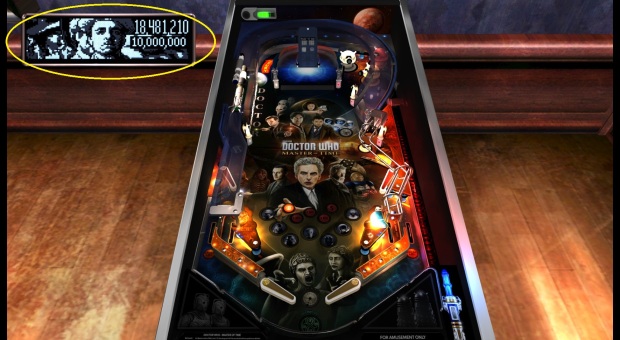
In nine years of reviewing games, this is the single weirdest glitch I’ve ever encountered. The game started keeping track of Doctor Who: Master of Time as the original Doctor Who, despite all that game’s targets now being different things. It’s weird how they built this table.
It makes the dev team seem kind of hopeless without having real tables to simply port from. Not that porting is easy, but when left to their own designs, it’s worrying that this is what they came up with. That they turned one of the most colorful, lively tables into a dark, bleak, unhappy experience hammers home how far they missed the mark. Yea, there’s some intense stuff in modern Doctor Who. But Master of Time is so devoid of the joy and happiness the Doctor at his (or her) best invokes that it’s just depressing. The W-H-O sequence shot, the ONLY carry-over from the original table, is literally the only exciting thing this table has going for it. The multiball modes, TARDIS shot, and actual voice work by Peter Capaldi and Michelle Gomez feel phoned in (Edit: that’s especially incredible because they didn’t record original dialog for this!). This table isn’t worth the bandwidth it takes to download it. $4.99 just for it, with no other tables? That’s a big “no” from me. Exterminate this one.
#98*: Eight Ball Deluxe (Would be rated BAD)
Member of the 8K Club
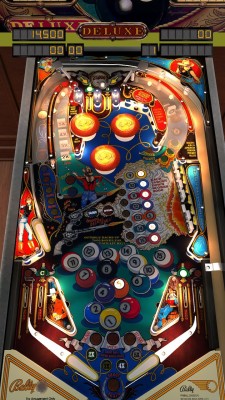 Standard version Permanently Delisted
Standard version Permanently Delisted
Included in Arcooda Software
TABLE FACTS
Designed by George Christian
Art by Margaret Hudson
1981 Bally, 8,250 Units Sold
TRIVIA
-Despite not being among the top-selling pins, Eight Ball Deluxe had a reputation of being one of the highest-earning tables for route operators. So potentially lucrative was Eight Ball Deluxe that it drove-up the used-table price, resulting in Bally re-releasing it twice, once in 1982, and again in 1984.
-Eight Ball Deluxe was one of the first pinball tables to get an “arcade-accurate” digital translation. In 1993, a company called Amtex published Eight Ball Deluxe for Windows/Mac. It, along with a translation of Gottlieb’s Royal Flush, were the first digital tables that combined media of real tables with video game elements to simulate an authentic pinball experience.
REST OF THE TEAM
Oscar’s WOULD BE Rating: Good
Jordi’s WOULD BE Rating: Bad
Angela’s WOULD BE Rating: Bad
Eala’s WOULD BE Rating: Bad
Because of a game-ruining glitch (in this case, what my team has dubbed “teleporting”), Eight Ball is unplayable in The Pinball Arcade. But, even if it wasn’t, this wouldn’t exactly be a stellar table. Dull angles, extremely annoying digital voices, and unbalanced scoring make this a stinker either way. The highlight would be the series of drop targets, but alas, the glitchiness caused the ball to teleport around the flippers, making it impossible to play. Oh gee, what a shame. We really did give it a fair shake, but this was the hardest table to judge on potential, especially when balls would drain out, but a little seal-clapping would magically teleport the ball above them. Even though I’m pretty sure I wouldn’t like Eight-Ball Deluxe, I’m pretty bummed about missing it just because of the historic factor. A lot of purists settle disputes over who is the superior player using this table. They do that with Big Shot too. Apparently people who are good at Pinball use pool-based tables to settle scores.
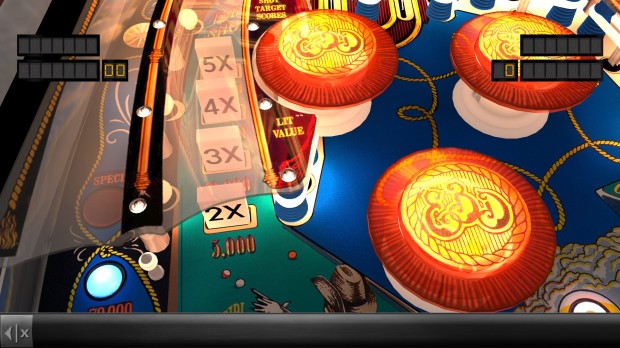
Arguably the most valuable in-line in pinball. Although Paragon did it first, Eight Ball Deluxe’s row of targets became the most popular multiplier-shot of the early solid-state era. Why didn’t it become a staple? A high breakdown rate and the fact that other uses of in-line targets proved less popular (Centaur, Fathom), not to mention Bally owned a (probably worthless) utility patent on it.
#97*: No Good Gofers (Would be Rated GOOD)
 Featured in The Pinball Arcade: Season One (PS4 Disc Only)
Featured in The Pinball Arcade: Season One (PS4 Disc Only)
Included in Arcooda Software
Alternative Version: Pinball FX3 Williams Pinball Volume 5
Table Type: Finesse-Kinetic
TABLE FACTS
Designed by Pat Lawlor & Louis Koziarz
Art by John Youssi
Sound by Vince Pontarelli
DMD by Adam Rhine
1997 Williams, 2,711 Units Sold
TRIVIA
-Rumors persist that a prototype that featured a gopher popping out of the center of the playfield existed, but no tangible evidence for it has ever been found. The whitewood (undecorated prototype) lacks this feature, and no function for the gopher exists in the scoring code. However, it is insisted by insiders that fifteen prototypes with a third gopher exist.
-The Hole-in-One is the highest open-ramp shot in pinball.
-Pat Lawlor’s final table for Williams/Bally.
-Jon Hey and sound designer Vince Pontarelli provide the voices of the gophers.
-The gophers reference other Pat Lawlor tables Whirlwind and Earthshaker.
THE REST OF THE TEAM
Oscar’s WOULD BE rating: Good
Jordi’s WOULD BE Rating: Good
Angela’s WOULD BE Rating: Good
Eala’s WOULD BE Rating: Bad
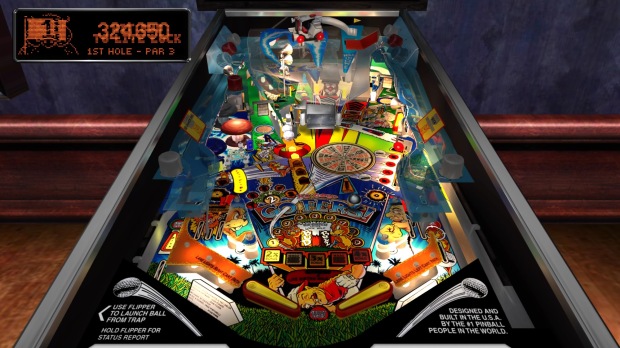
You mean to tell me they couldn’t afford the Caddyshack license? That couldn’t have cost more than my lawn guy does.
On literally my VERY FIRST SHOT, the very first time the ball met the flipper in my very first game of No Good Gofers for Pinball Arcade, I was busy taking the media I use for these reviews and barely noticed the ball clip right through the table. My Dad didn’t. “Something just happened” he said. “Oh, I just paused the game” I said. “No, it looked like the ball just went through the table like a ghost.” I accidentally didn’t save a video of it. I didn’t need to. What my Dad said he saw happened again immediately. I struck the ball, and it went through the table and respawned in the chute. It happened again a few more times over a few rounds of Gofers, including once during a multiball. Eventually, some games had every multiball lose balls through the table at least once, but usually multiple times. This is broken. Now, in fairness, this glitch happened to several Pinball Arcade tables, but it was a relatively rare happening elsewhere in this collection. Not here.
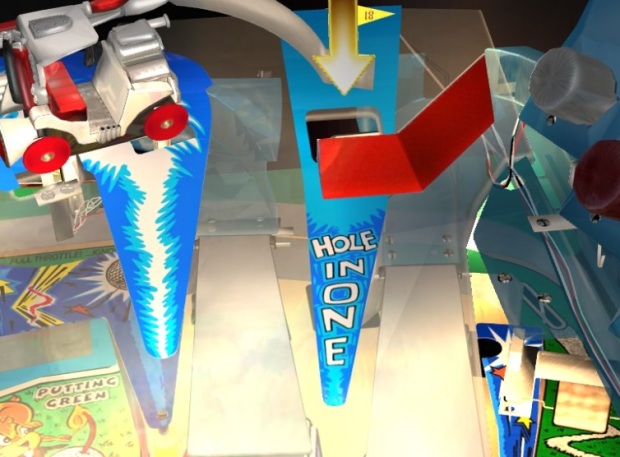
A fun shot on the real No Good Gofers machine, here it’s bait to launch the ball through the table like a ghost. Now all you need to do is play Unchained Melody and you can have a hell of a supernatural love story.
I mean, it’s not like No Good Gofers was a late table release that they lost interest in right after they lost the Williams license. This is one of the first tables. This crap is unacceptable. The clipping was consistent enough that I can declare Gofers unplayable, since the balls, you know, staying on the playfield and not passing right through the sides is something that shouldn’t happen. Once? Eh, weird stuff happens. Twice? Eh, games are complex. Multiple times? No. That’s just straight-up unfinished. Other tables did have it happen more than once. Fish Tales had it happen the second most times, usually off a serve. But one clipping for every 30 or so balls is still pathetic but you can laugh it off. Every other game? No. This was a shamefully unfinished effort.
THE PITS
#96: Goin’ Nuts
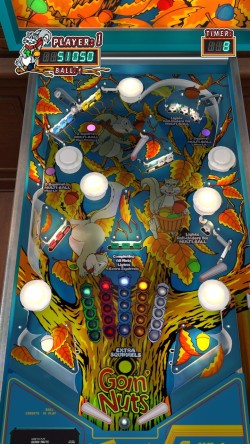 Featured in Gottlieb Table Pack 2 (DLC), The Pinball Arcade: Season Two (PS4 Disc)
Featured in Gottlieb Table Pack 2 (DLC), The Pinball Arcade: Season Two (PS4 Disc)
Included in Arcooda Software
Table Type: Kinetic
TABLE FACTS
Designed by Shing Lam
1983 Gottlieb, 10 Units Produced for Location Testing
TRIVIA
-The only digital recreation in Pinball Arcade based on an unreleased prototype.
-The table was too fast and chaotic, leading to balls colliding hard enough to damage them, which in turn results in “disco-balling” that causes damage to the surface and elements of the table. Some of the tables used in testing had such heavy damage after even a short period of installation that it led to production being cancelled, despite the table being fully completed and ready for manufacturing. Even the Goin’ Nuts installed at the Pinball Hall of Fame is often pulled from service due to risk of damage.
-Would have been the first table with an auto-plunger serve if released.
-Larry Day was credited as the artist for years, but he confirmed he wasn’t involved in Goin’ Nuts. As of 2/4/21, nobody knows who did the artwork for this table.
TEAM RANKING: #94 of 96
Oscar’s Rating: The Pits (#96)
Jordi’s Rating: Bad (#92)
Angela’s Rating: Bad (#90)
Eala’s Rating: Bad (#82)
THE PINBALL CHICK CERTIFIED TURD
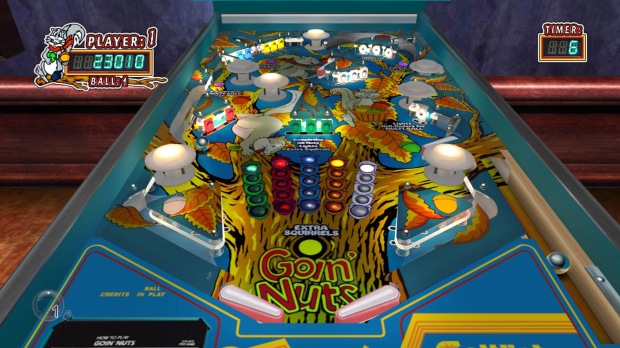
That Gottlieb allowed this to get as far along in production as they did is the only thing that’s nuts.
Goin’ Nuts would have been the worst Gottlieb machine ever released if they’d actually gone through with it. Ten Goin’ Nuts machines were manufactured, which is astonishing: they actually had ten of these completed before anyone thought to say this was the worst crap ever? The idea here is there’s no plunger or outlanes, and you have X amount of time to deal with a three ball multiball that adds time based on hitting targets. If you run out of time before running out of balls, the flippers go dead. You still get three lives. The idea could have worked. I guess. But not with this layout.
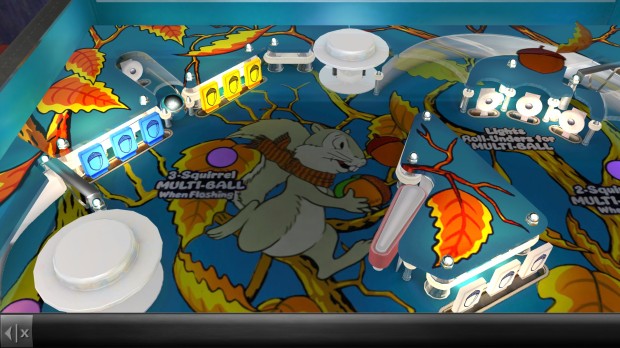
Designed by the same dude who co-designed Black Hole, he actually never designed another table after this. I think this flipper tells you everything you need to know. Nobody would design this capture ball to be stationed at this angle from this flipper. It’s one of the most inelegantly-placed targets I’ve seen.
What can I say about Goin’ Nuts? It’s one of the most boring, nonsensical tables ever made. It’s so bad that we actually had to debate whether a table this God-awful is worse than a more ambitious table ruined by the engine’s glitches. Goin’ Nuts is absolutely worthless and the single worst working table you can play in Pinball Arcade. There are 15 drop targets to shoot and one capture ball that can recover lost balls. Whoopie. The capture ball is situated in a way where you can’t really access it without lucky bounces, and what limited targets are here aren’t situated for multiball playing. It’s absurd this was a season two table. The novelty of having a cancelled table sounds fine and dandy until you remember that (1) there were FAR better options besides Goin’ Nuts and (2) if this idea was any good, Gottlieb WOULD have released it in 1983. It wasn’t arbitrarily cancelled, people. It was cancelled for a reason. Someone should be charged with desecration of a corpse for digging up this putrid carcass.
#95 Big Buck Hunter Pro
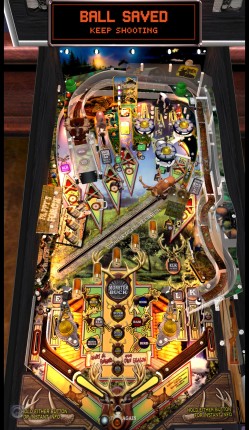 Featured in Stern Table Pack 3 (PS4/Xbox One only)
Featured in Stern Table Pack 3 (PS4/Xbox One only)
Not Included in Arcooda Software
Table Type: Kinetic
TABLE FACTS
Designed by John Borg
Sound by Ken Hale
Dot Matrix Display by Mark Galvez
2010 Stern, Unknown Sales (We’ve heard 750 units)
TRIVIA
-Video game design legend Eugene Jarvis, whose company Raw Thrills worked on the Big Buck Hunter video game series, assisted in the development of Big Buck Hunter Pro.
-Pinball design legend Mark Ritchie also assisted in the creation of this table.
-Big Buck Hunter franchise creator George Petro provides the narration.
TEAM RANKING: #96 of 96
Oscar’s Rating: The Pits (#95)
Jordi’s Rating: The Pits (#94)
Angela: The Pits (#96)
Eala: The Pits (#95)
THE PINBALL CHICK CERTIFIED TURD

To Stern’s credit, this looks like the type of table I’d expect to see in a hunting lodge. Then again, I have been in a real hunting lodge that had a pinball table. That table was Fish Tales, because OF COURSE IT WAS!
Big Buck Hunter: a pinball game where you kill large mammals based on a series of video games where you kill large mammals. No, I’m not going to mock hunting. Look, I’ve been deer hunting. Well, maybe. If you walk into the woods with your family, armed or not, I don’t know if it technically counts as “hunting” if you never see a deer, let alone get to fire your gun at one. Apparently all the deer in Northern California were on vacation when we went. Which is just as well. As tiny as I am, if I shot a gun, there’s a good chance I would fly 20 feet backwards, leaving a comically Cathy-shaped hole in a tree like Elmer Fudd. The experience was so miserable that I asked my father if the next time we decided to pretend that we could actually fend for ourselves and make our own food if we could go fishing instead, and I hated doing that too. Plus I hate the taste of fish.. all fish.. and deer is stringy and too gamey. Makes good jerky, though.
Where was I?
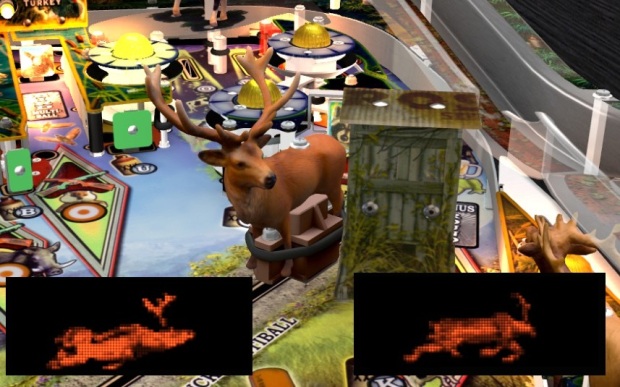
The sadist in me laughed her ass off at the animations of deer being shot dead. And how do you do this? By hitting what might be the largest moving target I’ve ever seen in a table. It would be harder to MISS the deer when it’s in the open field. And you only need to hit it three times to open up a multiball, and during THAT multiball you’re likely to activate even more multiballs. The scoring is fine-tuned for them but this table is so dumb and gives players so little credit.
Big Buck Hunter Pro Pinball. Well, the table seems like it would be fun. Like most post-arcade Stern tables, Buck relies on tons of multiballs, one after another, that are easy to trigger. Because nuance or substance? Screw that. But, the table is plagued with moon physics, just like Pistol Poker and Al’s Garage Band in the Alvin G & Co. pack have. The result is playing pinball with one of those $0.50 high-density rubber bouncy balls you get from a vending machine. This leads to weird-feeling crap like seeing balls go off the slingshots with so much lift that they can soar high onto the playfield, or balls getting caught forever in the bumpers, or balls simply bouncing with high arcs based on no physics known to this Earth. It’s ridiculous. The shame is, it seems like the scoring is fine-tuned and it abuses multiball to the same absurd degree that Harley Davidson did, and I liked that. This had the tools to be, at the very least, alright. And it’s not. It’s not even bad. Buck Buck Moose is horrendous.
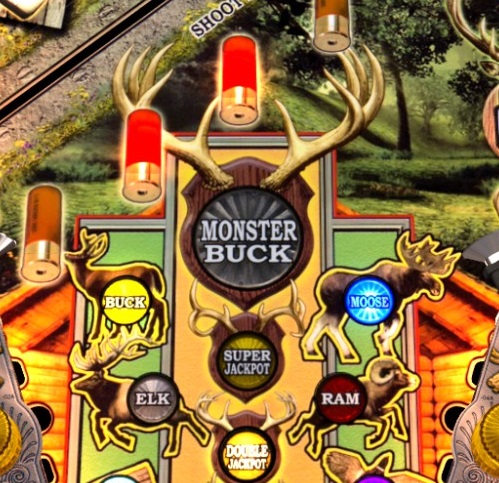
Monster Buck? Well, is it a Turdy Point Buck?
That’s not to mention the fact that balls drain straight out on almost every version of multiball. I have no idea what the story with these late Pinball Arcade releases is. Maybe they were done by a different, significantly less-passionate team than those who did the original tables with such care and effort (glitchy outliers like No Good Gofers not withstanding), but Big Buck Hunter is nearly unplayable based on the physics alone. Along with Champion Pub, Doctor Who: Master of Time (before we realized the table had its game-killing glitch that started activating with relative regularity), and Jack•Bot, it’s one of four tables that swept THE PITS ratings from all three of us. It deserves it. On the plus side, I figured out that holding the plunger down to cheat on multiball works (hugely illegal in real pinball and grounds for being banned for life from tournaments if caught). On the minus side, after my Dad cussed me out (“YOU DAMNED CHEATER!” he screamed at me, and that’s just what I can print), he used the trick and went on to destroy me. I had it coming.
#94: Rescue 911
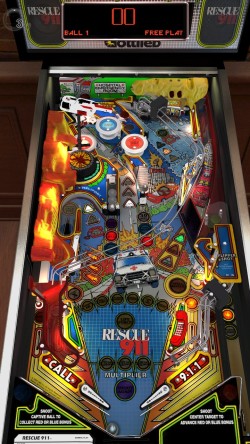 Featured in Gottlieb Table Pack 2 (DLC)
Featured in Gottlieb Table Pack 2 (DLC)
Included in Arcooda Software
Table Type: Pick ‘n Flick
TABLE FACTS
Designed by Bill Parker
Art by Constantino Mitchell, David Moore, & Jeanine Mitchell
Sound by Craig Beierwaltes
Music by Duane Decker
DMD by Daryl Moore, Alycen Hareas & Rand Paulin
1994 Gottlieb, 4,000 Units Sold
TRIVIA
-The four white stand-up targets on the right side of the table do nothing. They score no points. They have no lights. They activate no modes. Nobody has ever fully confirmed what they’re for.
-The most persistent rumor for the purpose of the blank targets is that, anticipating William Shatner’s participation, designers wanted to pay tribute to him by having targets spell out K-I-R-K (others have reported they would spell T-R-E-K). When Gottlieb refused to pay Shatner’s fee, the targets went unused. I can’t believe this is true, as implying any connection that directly to Star Trek would violate the license, which was held by Midway at the time.
-It’s also possible they were going to be used to activate the helicopter and spell either H-E-L-I or H-E-L-P but they’re near-impossible to directly hit (they’re along a blind angle and curved away from the flippers), which meant few players would see the helicopter in action and the mode was scrapped.
-Finally, it’s also possible that those targets were a fail-safe and would allow an update ROM to make the helicopter harder to activate if arcade/route operators complained about play times.
TEAM RANKING: #95 of 96
Oscar’s Rating: The Pits (#94)
Jordi’s Rating: Bad (#85)
Angela’s Rating: The Pits (#92)
Eala’s Rating: The Pits (#93)
THE PINBALL CHICK CERTIFIED TURD

This really shows what dire shape Gottlieb was by this point. That the best license they could get was, chuckle, Rescue 911? What, did Entertainment Tonight or the People’s Court want too much money? I mean, Jesus Christ, it seems like a joke on the Simpsons. Midway and Data East are scooping up big blockbuster movies, while Gottlieb gets a show where actors too crappy to play dead bodies on Unsolved Mysteries recreate 911 calls. I don’t have nearly enough forehead to facepalm myself as much as this license deserves.
Even in failure, Rescue 911 is an interesting turd. I’ll give it that. One of those “what WERE they thinking?” type of situations. Who on Earth would base a table on a television show like Rescue 911? Even worse, why even get the show if you can’t have its iconic host: William Shatner? Because he’s nowhere to be found here. It’s almost surreal that this ended up moving 4,000 units, more than this era of Gottlieb’s more successful fare like Tee’d Off or Wipe Out. You can probably chalk this up to Rescue 911 having one of the more neat toys of the era: a helicopter that grabs the ball magnetically, which you then drop using the flippers. It’s fun, until you realize it kills the game’s pace.
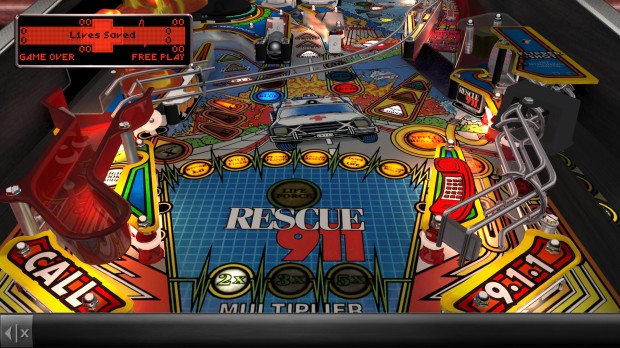
Did anyone really say “Look at that? A Rescue 911 table. Gosh darn, I love that show where bad actors recreate 911 calls!” and play this that otherwise wouldn’t have? It seems like Gottlieb could have saved $50 or whatever this license cost them, especially if they weren’t willing to spring for William Shatner. Pay him the extra $50 and have him say “MULTIBALL!” into a tape recorder or something. If you can’t do that, forget the Rescue 911 branding and just call the table “EMERGENCY!” or “RESCUE!” without the license. I mean why not? Good lord, Gottlieb was helpless during this era. I picture some executive going up to the engineers. “You guys will never believe what license I just got!” with a triumphant look, while the designers put notes in bottles and cast them out to sea, hoping someone at Midway will find them and rescue them.
Rescue 911’s lightning-style tiny flippers with an absolutely humongous flipper gap actually don’t factor in as much as you would think. You can tell they were proud of the helicopter toy, because the shot for it (which the jackpot is also tied to) is absurdly easy. It’s front-and-center on the table, along a primary angle. It’s harder to miss the shot. But that’s ALL Rescue 911 has going for it. The scoring balance is non-existent. Rescue 911 has the easiest capture-ball target in Pinball Arcade, one that even a grazing shot will trigger (Theatre of Magic has this problem too, but at least the capture ball requires SOME aim to hit), and it’s over-valued to such an absurd degree that versus matches with my Dad and I came down to chopping wood on that shot. Nothing else was really worth attempting. Forget 911. Just call the coroner. This table was dead on arrival.
#93: Frank Thomas’ Big Hurt
 Featured in Gottlieb Table Pack 1 (DLC)
Featured in Gottlieb Table Pack 1 (DLC)
Included in Arcooda Software
Table Type: Pick ‘n Flick
TABLE FACTS
Designed by Bill Parker
Art by Susan O’Reilly, Constantino Mitchell, & Jeanine Mitchell
Sound by Craig Beierwaltes
Music by Duane Decker
DMD by Rand Paulin, Alycen Hareas, Vecennia Jordan, & Scott Melchionda
1995 Gottlieb, 1,985 Units Sold
Alterations: Reebok logos & branding have been removed.
TRIVIA
-Wikipedia credits Ed Krynski as coming up with the concept for Big Hurt. I couldn’t find anything that confirms he had any involvement. He’d been retired for eleven years by the point Big Hurt came out.
-Gottlieb approached Reebok and Nike about sponsoring a baseball-themed table, and ultimately worked with Reebok because Frank Thomas was coming off back-to-back seasons as MVP of the American League (1993 & 1994) at the time the table was in production.
TEAM RANKING: #93 of 96
Oscar’s Rating: Bad (#86)
Jordi’s Rating: The Pits (#95)
Angela’s Rating: Bad (#82)
Eala’s Rating: Bad (#86)
THE PINBALL CHICK CERTIFIED TURD
Frank Thomas’ Big Hurt was based in part around Reebok. That stuff has all been removed, leaving only Thomas, whom I’m sure Farsight had to cut a pretty penny to. Literally, that’s probably what it costs to license Thomas today, though I’m sure it was a very pretty penny. One of the ones from 2009, a year they were especially shiny. Now, I have it on very good authority that Farsight at least explored trying to get the Gottlieb tables based on Shaquille O’Neal but he was too expensive. Frank Thomas is the discount retired 90s athlete. Let’s face it: he never won anything (not ENTIRELY true.. he was the AL batting champion in 1997 for a team that missed the post-season) and the only notable legacy he left was that there’s a debate between who was the best hitter of the steroid era that wasn’t on the gas. It was him or Ken Griffey Jr. I’d taken Griffey because at least he could catch a ball too. And also because he had that bad-ass swing where he let go with one hand during the follow-through.
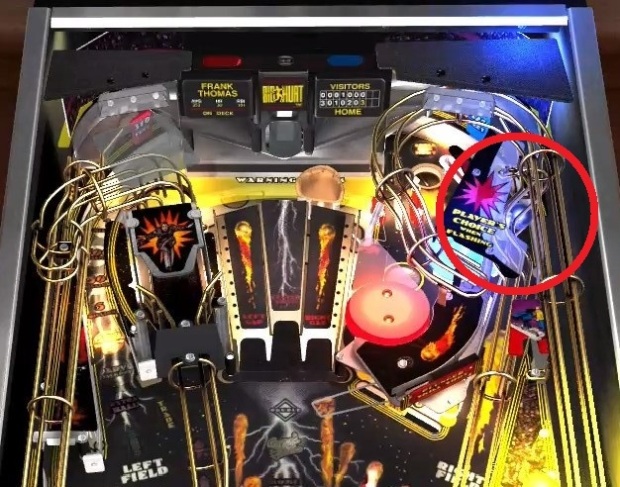
We played dozens of rounds of each table for this review, on PS4, Steam, and Switch. It was rare to have a glitch or table hang-up that was unique to a platform, but this is an exception. The ball getting stuck and requiring a soft reset only happened on Switch and only in Tate mode. You can see it stuck here, in the red circle. If you call the attendant and the ball dislodges, you have to pause the game and call the attendant again, or risk having two balls every round, only one of which has to drop for you to lose your turn. And calling attendants for any table in Pinball Arcade sometimes causes the game to suffer fatal failure and lose track of where the ball is, leading to turns ending or games ending while a live ball is still on the playfield. True to life, sometimes a marooned ball means your game just ended.
When it comes to Big Hurt, I’m told the real table plays better. Gee, I’d hope so. Big Hurt was one of many tables I felt just didn’t feel quite right on Pinball Arcade, though camera angles 1 and 4 didn’t have that flat, barely a slope, playing with a marble, cheap toy pinball table you order from a 1995 Sears catalog feel. But, to be fair, even when I felt the table played.. not exactly fine but good enough to evaluate.. I wasn’t a fan either way. Big Hurt is based around shooting home runs off a ramp, moving the innings up, and lots and lots of multiballs. There’s a center ramp with a moving baseball glove. Behind the glove is a small hole. It’s sort of like pinball meets skee-ball. This is the “home run” hole that drives the scoring and would be an excellent feature if they’d truly left it at that. They didn’t.
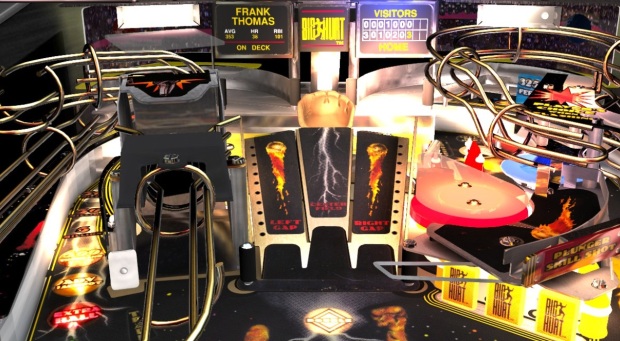
The home run ramp is a great idea. The glove is a great idea. Neither works particularly well. It’s so obvious that Frank Thomas Big Hurt wanted to be Gottlieb’s answer to Midway’s hugely successful World Cup Soccer, using an even more popular sport (in the United States, at least), with an even better moving target that represented both offense and defense than World Cup’s cardboard goalie. But man, did Gottlieb fail. That’ll be a reoccurring theme in this feature when it comes to them.
So, a potentially awesome feature is compromised by horrific scoring balance. There’s a feature where you collect cards that you can trade for special features, but those cause the end of third-ball bonuses to potentially pay off with massive points. So many points that it can be a high multiple of what you score doing “high payoff” modes like multiball. The mystery score mechanic that wrecked earlier 90s Gottliebs is replaced with a bumper-driven mystery feature that further throws the balance off. Also, the ball gets stuck in the bumpers fairly often on Switch in tate mode. Of all the truly rotten tables, Frank Thomas is the one that had the most potential. Poor flow and scoring issues make this one of the worst Pinball Arcade has to offer.
#92: Ghostbusters
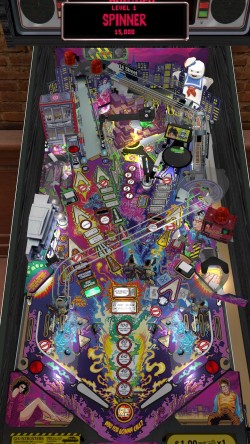 Featured in Stern Table Pack 1 (DLC), Stern Pinball Arcade Add-On Pack 1 (DLC/Physical)
Featured in Stern Table Pack 1 (DLC), Stern Pinball Arcade Add-On Pack 1 (DLC/Physical)
Not Included in Arcooda Software
Table Type: Finesse-Kinetic
TABLE FACTS
Designed by John Trudeau
Art by Jeremy “Zombie Yeti” Packer, Steven Martin, & Dave Link
Sound by Jerry Thompson
Music by Shawn Myers & Ian Sturgeon
DMD by Chuck Ernst, Mark Galvez, Zac Stark, Tom Kyzivat
2016 Stern, Unknown Sales
TRIVIA
-The original rule sheet teased “ARE YOU A GOD” wizard mode, but the actual mode wasn’t included in actual Ghostbusters tables until a 2019 ROM update. It’s not included in Ghostbusters for Pinball Arcade/Stern Pinball Arcade.
-Ernie Hudson provides the game’s narration.
TEAM RANKING: #77 of 96
Oscar’s Rating: Good (#58)
Jordi’s Rating: Good (#46)
Angela’s Rating: Bad (#77)
Eala’s Rating: Bad (#84)
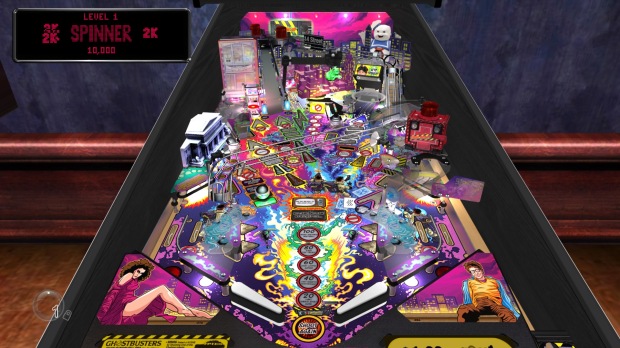
It’s a shame the table is more frustrating than fun. One of the most visually striking tables of the Stern era.
Ghostbusters: the table that out-Lawlors Pat Lawlor. The most complex, unintuitive table in Pinball Arcade. It’s not even worth being that table too. It’s Ghostbusters! Why does it have to be so complex? Why does the table have to do so many cheap tactics to kill you? Of all the truly horrible Pinball Arcade tables, it probably has the best layout with the most potential to appeal to players of all tastes. Naturally, they screwed it up. Ghostbusters has too many ways to kill you. The #1 issue by far is the”paranormal flippers”, magnetic pulses placed right above the flippers that send the ball in totally random directions, sometimes.. often.. straight down the drain. It’s the most cheap, disgusting, thoughtless design mechanic I’ve ever seen. It’s just stupid. It goes against the spirit of pinball.. no pun intended.
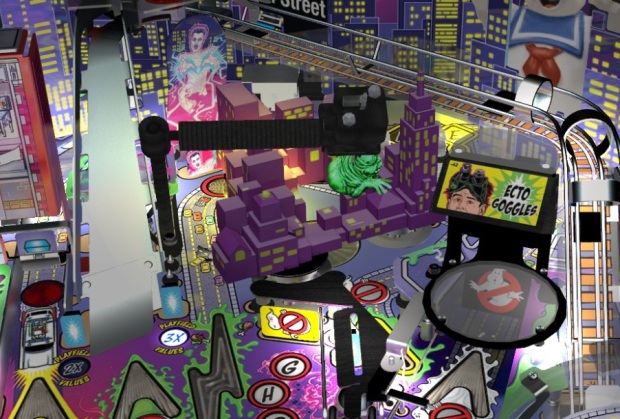
Slimer is the highlight of an otherwise miserable, cynical table. Plus the little holographic ghost projected above the right orbit. Really, Zombie Yeti’s art (yes, that’s really what he goes by) is the only positive thing I can say about Ghostbusters at all. Hopefully Pinball FX3 will eventually pick up the Stern license. They already have the Marvel license and could then adapt Stern’s Deadpool, which he also did the art for.
It’s hardly the only problem. The primary ramp is overly steep and the playfield too crowded for multiball management (not to mention the ghost flipper things). Really, every issue with the table comes down to “you have to do something while dealing with these magnets right next to the flippers and slingshots” that turns the game into complete random chance. Those ghost flippers feed the outlanes and the drain and no amount of nudging or defensive play can prevent them because it comes down to RANDOM CHANCE whether the magnets will throw the ball the way you can play it. It doesn’t help that the drain is so large that’s it’s legally classified a chasm. Also, the VUKs are placed too-close to the flippers and violently throw the ball at the flippers in a way designed to straight-up cheat players out of balls. This feels like a fan service that has contempt for Ghostbuster fans. We already had one of those in the 2016 in the form of the awful franchise reboot. Man, 2016 sucked for Ghostbuster fans. This is a table made to sucker fans of the IP. It feels like a shady 90s table dressed like a slick, modern one. All modern Stern pins are too toy heavy. Ghostbusters, the one property where that works, is garbage. Go figure.

The “haunted flippers” or whatever they’re called is the dumbest idea I’ve ever seen. I hate magnetic play-fields for the most part, but having them be such a prominent part of THE FLIPPER AREA is taking it too far. How do you screw up a table this bad?
Also, for the love of God, don’t stream gameplay footage of Ghostbusters. This is one of a few tables where a 30 second gameplay clip on Twitter landed me a DMCA takedown of my feed because the Ghostbusters song plays on loop and I guess it was felt that I was “stealing” the song. The song that you could barely hear over all the pinball noises and racket. So very, very petty.
#91: Whoa Nellie! Big Juicy Melons
 Featured in Stern Table Pack 3 (PS4/Xbox One/Mobile/PC only)
Featured in Stern Table Pack 3 (PS4/Xbox One/Mobile/PC only)
Not Included in Arcooda Software
Table Type: Boardwalk
TABLE FACTS
Designed by Dennis Nordman
Art by Greg Freres
Sound by Jerry Thompson
2015 Stern, Unknown Sales
TRIVIA
-Based on a 2011 homebrew project sold through Whizbang Pinball.
-The real table has the option of sitting on a crate instead of using legs (real legs were also included for purists). To adjust the slope, Stern provided two Whoa Nellie branded crushed beer cans, but encouraged players to use their own favorite brand’s crushed cans.
TEAM RANKING: #86 of 96
Oscar’s Rating: Bad (#84)
Jordi’s Rating: Good (#70)
Angela’s Rating: Bad (#88)
Eala’s Rating: Bad (#79)

I’m not really offended so much as I’m shocked that anyone would think to make a table this nakedly sexist in the 2010s. Okay, poor choice of words.
The story behind the creation of Whoa Nellie is so much more interesting than the table itself. Legendary designer Dennis Nordman had a broken 1957 Gottlieb table called Continental Cafe that he hand-converted into Whoa Nellie. A company ended up locating and buying three more Continental Cafes to be hand-converted into Whoa Nellies at $14,000 a pop, before Stern swooped in and licensed it. The ones Stern sold went for a whopping $6,500 in 2015, and I don’t get it. Who in their right mind would pay that much for THIS table in the modern era, when that kind of money can get you the standard edition of any other Stern game. Unreal.
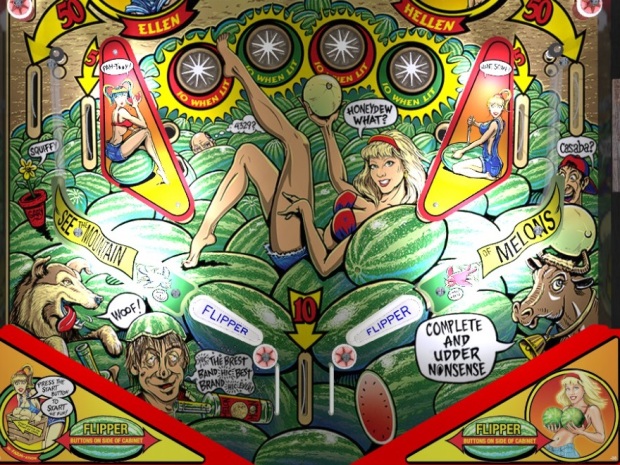
This seems like something that should never have made it past being a garage project. Something that you only show to friends that you’re afraid to admit to your other friends that you’re friends with.
$6,500 for a joke table, with the joke being “melons is another word for BOOBS, and there’s women with big BOOBS on the table, but they’re selling actual MELONS in the form of watermelons so it has a double meaning! HAH!” No. This is stupid and not remotely clever. I’m not offended, because it’s too stupid to even be offended by. What offends me is this is paired with the also terrible Big Buck Hunter Pro for an outrageous $14.99. Switch fans, angry that these tables are exclusive to Xbox One and PlayStation 4, trust me, you dodged a bullet on this one. Whoa Nellie is just such a nothing table. Simple angles with old timey nub flippers, without any added benefit of sharp targets or balanced scoring to level things out. The only credit I can give Farsight is they did right in pairing this with Big Buck Hunter, because putting two of the worst tables together at THAT price makes this the easiest pass for any of the major pinball launchers’ DLC packs.
#90: Paragon
Member of the 9K Club
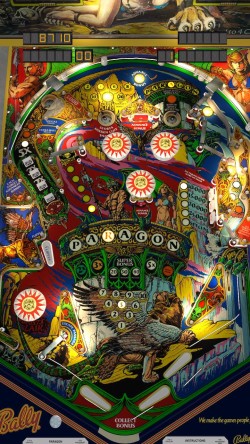 Standard version Permanently Delisted
Standard version Permanently Delisted
Not included in Arcooda Software
Table Type: Sharpshooter
TABLE FACTS
Designed by Greg Kmiec
Art by Paul Faris
1979 Bally, 9,120 Units Sold
TRIVIA
-Paragon is a direct sequel to the popular 1978 Bally classic Lost World, which sold over 10,000 units. While the table’s style is radically different, the Barbarian characters from Lost World returned in Paragon.
-Paragon is the largest Bally table ever widely-released before the Midway purchase.
-Features the first in-line drop target sequence in pinball.
-When you max-out the Golden Cliffs value and land the ball in the saucer, the table plays the tune from the Ohio Players song Funky Worm.
TEAM RANKING: #84 of 96
Oscar’s Rating: Bad (#73)
Jordi’s Rating: The Pits (#93)
Angela’s Rating: The Pits (#95)
Eala’s Rating: Good (#48)
THE PINBALL CHICK CERTIFIED TURD
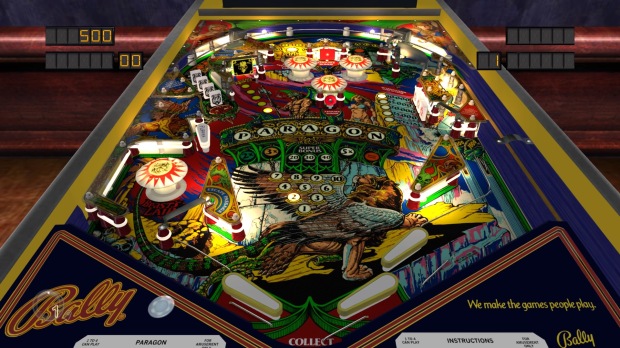
The ultra-wide bodies of the era really feel so gimmicky. The biggest one, Hercules, I’ve seen in person though never played. It’s huge, but by reputation, quite boring.
Welcome to the exciting world of pinball design, where one single misguided element can ruin an entire table. Take a look at Paragon, a massive wide-body by legendary designer Greg Kmiec. Mr. Kmiec has five of the thirty-five 10,000-units-sold machines of the solid-state era to his name, and Paragon was one of the best sellers of the absurd super-duper-huge era of wide bodies. I’m not the biggest fan of them. They only really exist because going bigger was the only solution to the “how to compete with these newfangled video game thingies?” question that the egg-heads running the show could think of at the time. But bigger doesn’t always mean better. In fact, because these tables cost more for operators to purchase and took up more space, they had to be made more difficult so that players would have quick ball times. So for Paragon, which has an ambitious layout that includes, among other things, the first-ever row of in-line drop targets, this was how they decided to add difficulty.
“Let’s put a drain directly behind the right flipper! It’ll make it so players can’t trap and do set-shots at that innovative in-line target so that nobody can possibly enjoy it!” Bravo, Bally. You ruined a great table. It’s not like Paragon would be a slouch without it. The massive left outlane is starving and has a bumper to spoon-feed it, while the right outlane is quite hungry itself. Not to mention the moderately-risky angles for the P-A-R-A-G-O-N lights and the inline targets, which can feed the drain. That’s what floors me about Paragon: it did NOT need that flipper drain. The challenge was already there. The only role it serves is to make the table less enjoyable to explore. It’s such a cheap move and so beneath a table of this quality.
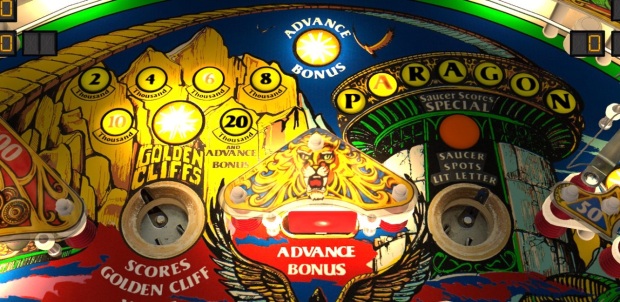
The two kick holes are another conceptually smart idea that I feel fails completely here. Kick holes are perfectly common off-the-plunger shots. But, the ball doesn’t seem to lock into them quite enough in Paragon, and what should be good shots rolls right over them. Also, tying the P-A-R-A-G-O-N letters to the right hole instead of targets was just dumb. I’m sure some wise ass could practice on this for years and get the timing of the letter down rock-solid. But, that the lights rotate turns the whole thing into, let’s face it, random chance. Man, this table didn’t do anything right.
And, yeah, the drain behind the flipper totally ruins Paragon. It’s just too much to deal with, because the upper right flipper doesn’t really have valuable angles. The little nubby upper-left flipper (which may or may not have been mandated by Bally to clear out their EM-era flipper surplus) is one of the most ineffective bat flippers I’ve seen. All it does is hit the waterfall drop targets, which are low-yielding targets. You NEED the primary flippers, and not being able to trap with one of them is just stupid. The upper-right flipper does allow for some trapping, but it’s too crowded to use for free-catches and too-shallow a radius for traditional trapping. The really depressing thing is the European version of Paragon is a simple three-flipper design that lacks the flipper drain AND has a pin to make the left outlane less lethal. Just looking at pictures of it makes me salivate. That’s a potential Masterpiece table, and if Zen Studios ever does pre-DMD solid-states, I hope they give us the option for both. Because the version on our side of the pond is so prohibitively difficult that it’s unlikable. A potential top-10 table gets one pit too many and is now in The Pits. Go figure.
#89: Jack•Bot
 Standard version Permanently Delisted
Standard version Permanently Delisted
Included in Arcooda Software
Table Type: Pick ‘n Flick
TABLE FACTS
Designed by Barry Oursler & Larry DeMar
Art by John Youssi & Doug Watson
Sound by Jon Hey
DMD by Adam Rhine & Brian Morris
1995 Williams, 2,428 Units Sold
TRIVIA
-Jack*Bot was built with two different MPUs. It was designed to use the Williams WPC-S. But, when inventory ran out at the end of manufacturing, the last couple hundred units instead used the new WPC-95 (the same MPU that powered Attack from Mars and Medieval Madness).
-Although Python Anghelo was considered the driving force of the Pin•Bot series, he left Williams shortly before the final design for Jack•Bot was approved.
-The idea for a “intergalactic casino” table had been on the drawing board at Williams since the mid 80s.
TEAM RANKING: #82 of 96
Oscar’s Rating: The Pits (#90)
Jordi’s Rating: The Pits (#96)
Angela’s Rating: Great (#27)
Eala: The Pits (#89)
THE PINBALL CHICK CERTIFIED TURD
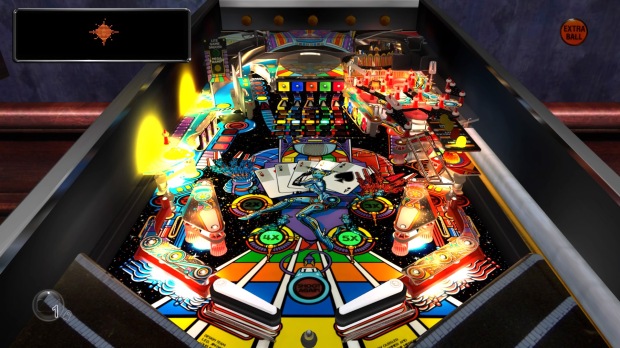
Angela ended up being the sole “not the pits” rating on The Pinball Chick team. She was genuinely shocked that everyone rated Jack•Bot so low. “Just because of that drain angle? Y’all are a bunch of wussies.”
The third of three tables that scored three THE PITS ratings from the Pinball Chick team. We put a LOT of time trying to get to the bottom of why this table fails on so many levels. Unquestionably the worst Barry Oursler table and a legitimate contender for the worst DMD Williams put out, Jack•Bot is truly awful. It failed to such a degree that Python Anghelo reported washed his hands of it, despite the Pin•Bot Trilogy being his most beloved baby. One of the most beloved personalities in the industry saw the progress on Jack•Bot, said “nope” and walked. Wow. This table sucks.
The weird thing about Jack•Bot is that it’s really close in terms of layout to Pin•Bot. It’s not exactly same, with the ramp slightly off-angle this time around, but otherwise it brings back the visor mechanic, the Plinko-like plunger maze, and more. The biggest difference is this one is about gambling and casino mechanics. There’s four primary games: poker, keno, dice rolling, a slot machine. Keno is probably the most interesting idea, since it uses the panel of visor lights from the original Pin•Bot. It still comes down to luck though, which is the main problem with all four games. The really potentially interesting idea is that you can then do a double-or-nothing with your prize from each casino game if you can convert a hurry-up left orbit shot. It especially lends itself to versus mode, where my Father and I probably had some of our best dueling of this entire Pinball Arcade marathon. Though the fun came from how close the games were. We were complaining the entire time about how badly made the actual table was.
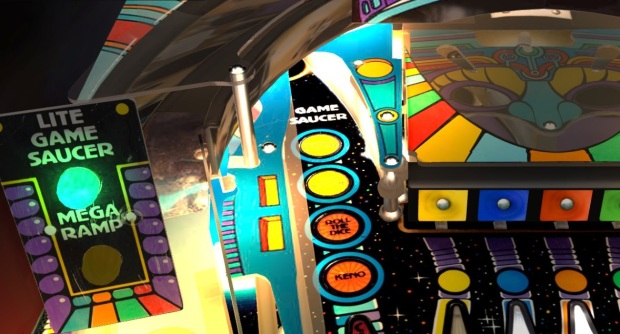
Of the many, MANY problems in Jack•Bot, this kicker and the wide drain (with near-worthless drain post) was the fatal element that ended the Pin•Bot series for good. This should have never made it past play-testing.
The problem is, the casino kicker has a seemingly unavoidable chance of auto-killing you. In more than one way too. Sometimes the ball is drained in an angle where it misses the flippers but hits the drain post in a way that it just dies. Other times it hits the drain post but clears the flippers to hit the outlanes. Tilting doesn’t save either. The primary, mode-starting kicker can and does kill you, at least in the Pinball Arcade build. My Dad has the hang of nudging or using drain posts on Pinball Arcade much more than me and he couldn’t de-lethalize the kicker with consistency. So you have a fatal kicker combined with a table that relies very, very heavily on luck. We put more time dueling in Jack•Bot than any other table we both negatively rated hoping the legendary Casino Run mode would save the day. It didn’t. It’s just a roided-up version the game’s “double or nothing” hurry-up mechanic, nothing more. Jack•Bot ain’t worth jack.
#88: The Party Zone
 Standard version Permanently Delisted
Standard version Permanently Delisted
Included in Arcooda Software
Alternative Version: Pinball FX3 Williams Pinball Volume 2
Table Type: Pick ‘n Flick
TABLE FACTS
Designed by Dennis Nordman
Art by Greg Freres & Jerry Pinsler
Sound by Dan “TOASTY!” Forden
DMD by Jim Gentile
1992 Midway Manufacturing, 3,862 Units Sold
Alterations: The songs Come Fly With Me and Purple Haze have been removed.
TRIVIA
-John Keeney provides the voice of Captan B-Zarre.
-Characters and references from previous tables Party Animals, Elvira & the Party Monsters, and Dr. Dude and his Excellent Ray are all present.
-The Jimmy Hendrix riff Purple Haze plays when you score a jackpot on real Party Zone tables. This has been removed from the digital version.
-A persistent rumor states that Party Zone’s prototype was initially designed to be based on Ghostbusters.
TEAM RANKING: #68 of 96
Oscar’s Rating: Bad (#75)
Jordi’s Rating: Good (#41)
Angela’s Rating: Good (#48)
Eala’s Rating: Bad (#65)
Who was Jack the Ripper? Where is Jimmy Hoffa? Truly puzzling mysteries for sure, but for me, the greatest mystery of the 20th century is “how on Earth does The Party Zone have fans?” This is THE wood-chopping table to end all tables. You really only need two shots: the left rocket shot and the right comedian shot. Both are forgiving. Both feed the flipper. Most modes can be activated just by passing the ball back and forth between these. With a little practice, you can add the special shot (an off-angle toe shot off the left flipper) to your rotation as needed. You can also mostly ignore the low-yielding “select a song” kicker that’ll score you 250K but often kicks you straight down an outlane. You need to nudge to save yourself, and thankfully nudging is easier on Pinball Arcade than it is on Pinball FX3. Normally that’d make the table better, but those left and right primary shots are more forgiving for Pinball Arcade, rendering this table a toothless bore. I don’t give a darn either way: this table SUCKS! Yea, you can do things other than shoot those two targets, but there’s no incentive to explore the table when you can generate points repeating the same two shots over and over and over..
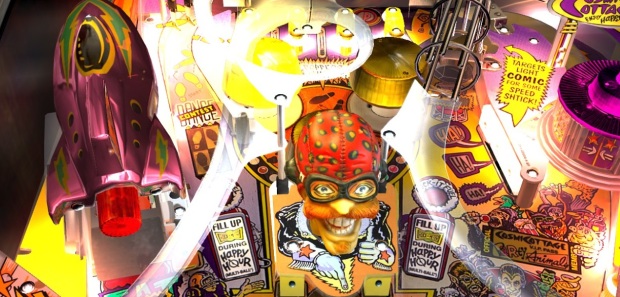
The rocket shot (along with the dance contest shot) and the comic shot are all you need, and they’re simple, forgiving shots. Hell, you almost have to be trying to miss the comic shot. It’s a lay-up.
I’ve still never played a real Party Zone, but having played two equally putrid digital versions of it (three if you count Visual Pinball), the only real question left is “in a perfect world, on a real table, with a real Champion Pub and a real Party Zone, which would be the worst?” Pub seems to have a lot more going for it, but every digital version is deeply flawed, and the only real version I played had features shut off. Meanwhile I’ve never played Party Zone, but other digital versions I played had the exact same issue: too little to do, too stupidly simple. There’s a good possibility that, in laboratory conditions, Party Zone might be my choice for the worst Midway-produced DMD ever made. I might travel to the Pinball Hall of Fame in Las Vegas just to get that answer.
#87: Safe Cracker
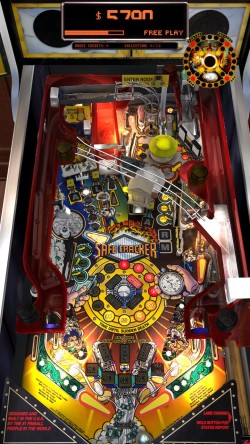 Standard version Permanently Delisted
Standard version Permanently Delisted
Included in Arcooda Software
Alternative Version: Pinball FX3 Williams Pinball Volume 3
Table Type: Kinetic
TABLE FACTS
Designed by Pat Lawlor
Art by John Youssi
Sound by Dan “TOASTY!” Forden
DMD by Adam Rhine & Brian Morris
1996 Midway Manufacturing, 1,148 Units Sold
TRIVIA
-Safe Cracker was developed under the assumption it would be based on the board game Monopoly.
-Designer Pat Lawlor later did do a Monopoly-themed table for Stern in 2001.
-The only “small body” table done by Williams/Bally in the solid state era.
-Despite the flyer advertising 10 unique “Magic Tokens”, twenty different ones were made.
TEAM RANKING: #92 of 96
Oscar’s Rating: Bad (#89)
Jordi’s Rating: Bad (#78)
Angela’s Rating: The Pits (#91)
Eala’s Rating: The Pits (#92)
THE PINBALL CHICK CERTIFIED TURD
One of pinball’s greatest legends is that Safe Cracker spent at least some of its development cycle under the assumption that the final game would somewhat resemble the popular board game Monopoly. Guess what? It’s true! Midway apparently expected to do some kind of deal with Hasbro that would see pins (along with redemption games) based on their popular board games. The deal never finalized, and so Monopoly became Safe Cracker while it’s possible plans for a table based on Clue (that’s Cluedo outside the United States) became WHO Dunnit. The loss of license resulted in a delay to Safe Cracker, which was meant 1995 is the only year from 1988 to 1998, besides 1991, that no Lawlor table came out. WHO Dunnit made its release date because it took a lot less to remove Clue from it than Monopoly from Safe Cracker (assuming WHO Dunnit was meant to be Clue, since that part of the story is unverified). Lawlor did eventually get to do a real Monopoly for Stern. So the story has a happy ending of sorts.
UPDATE 7/4/2020: Consider the Clue rumor to be busted. Two sources tell me that if Clue was the genuine inspiration, it was only in the most loose sense possible and WHO Dunnit was never going to be a Clue table.
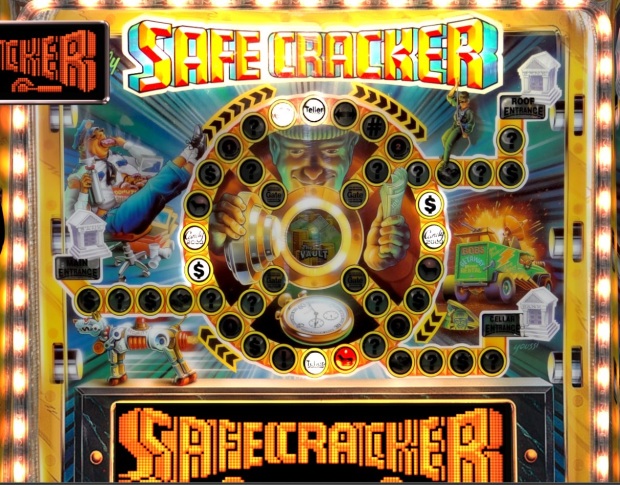
Here’s a hypothetical question for everyone: would Safe Cracker had been good without the board game? Because this is a crap game. Too many negative squares. It’s too loaded against players, and frankly, it turns Safe Cracker into complete, random chance. Sure, playing well on the pinball table gives you more chances at the board, but once there, your success is up to how frequent the operator has set the game to pay off in the operator’s menu, no different than a crane game for stuffed animals. It’s true. Remove the board game and add more incentives to the pinball table itself and Safe Cracker might have been a dang good table.
Hell though, Monopoly for Stern was a mediocre-at-best-table and having the Monopoly license wouldn’t have done anything to fix what’s wrong with Safe Cracker. This goes beyond merely being a bad table since it’s not really THAT bad. The problem is this was a bad idea from the start. A smaller playfield and little nubby flippers? Bad idea. Transitions from the pinball portion to the board game portion being as slow as watching erosion? Bad idea. Running the table on an (absurdly fast) timer instead of having three balls? Bad idea. By the way, the default timer is “extra slow” and can’t be made slower. At most, you can add “ten minutes” to it in the pro menu, which is like 20 seconds. Also, Dad won two of the “magic tokens” that allows you to play “Assault the Vault”, only it didn’t happen because I guess the pro mode-earned tokens don’t count. And, as a reminder, real tables paid off real souvenir tokens you got to either keep or insert into the machine to play a special game mode. That’s why the game relies on luck so much. It’s to limit the amount of physical items players could earn playing this. Again, just like a crane machine.
On Steam, we got five magic tokens to play the big bonus game. Sadly, Assault the Vault is crap. A timed four-ball multiball mode, which is one of the worst multiballs in the sport. The table is too small and too packed to accommodate a four-ball mode. Hell, it’s packed enough with three balls. Make Assault the Vault a two-ball mode and the barrier for accessing it less prohibitive and it might be fun. But we’ll never know. I wish you could control the balls being served, like you can in the wizard modes for Tales of the Arabian Nights or World Cup Soccer. Having it done automatically cripples the game because it’s just too congested. Unless the balls are jammed in bumpers, you’re not going to get any clean shots, and the nubby flippers and speed the balls comes down at you make trapping next to impossible. There’s nothing redeeming about Assault the Vault.
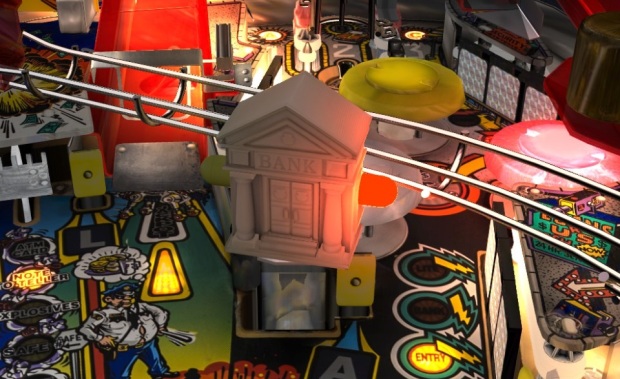
One more hypothetical, and this one is for you homebrew types: how good would Safecracker had been with a standard-sized table? Maybe some enterprising Visual Pinball fan should monkey around with the table, keeping all the targets and elements but spreading them out, and see how good it plays that way.
And actually, I feel that way about Safe Cracker in general. Even something as petty as the layout of the spaces on the board game is a bad idea. There’s too many whammies on the board to lead to a fail condition. And since the movement is based on digital dice rolls rather than your actions on the pinball table itself, it feels like success comes down to blind luck. Safe Cracker is flawed from the start, and I now believe that extends beyond the novelty factor. I don’t think this ever had potential to be good. MAYBE if the board game action was dictated by your shooting on the table instead of rolling a dice on the DMD, then MAYBE this would have been fun. Or, maybe you earn dice rolls on the table and can choose to enter the board game whenever you hit VUKs. That’s the big issue: they never married the board game to the pinball action. They feel completely disconnected from each-other. A worthy experiment? No, because the concept was broken to begin with. Safe Cracker is barely a step above Baby Pac-Man in terms of entertainment, but I dare say even Baby Pac-Man married its ideas better. When you’re being compared unfavorably to Baby Pac-Man, you are made of fail.
#86: Lights…Camera…Action!
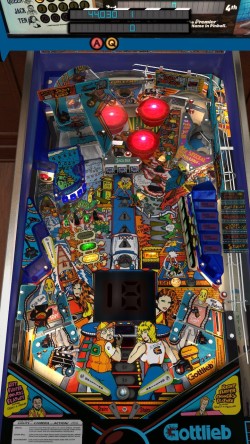 Featured in Gottlieb Table Pack 1 (DLC)
Featured in Gottlieb Table Pack 1 (DLC)
Included in Arcooda Software
Table Type: Finesse
TABLE FACTS
Designed by Jon Norris
Art by Constantino Mitchell, Brian R. Johnson, & Jeanine Mitchell
Sound by Dave Zabriskie
1989 Gottlieb, 1,708 Units Sold
TRIVIA
-Lights…Camera…Action! was rumored to have originally been planned to be a direct sequel to Gottlieb’s 1976 best-seller Royal Flush, which sold over 12,000 units and is considered one of the greatest EM tables ever. However, Gottlieb had released a table the year before Lights! called Diamond Lady (also by designer Jon Norris) that had a playing card theme, so the theme was changed to film-making.
-This was the first table with a rotating path element.
-Lights! is the first pinball machine that might ask players to input their initials before the game ends. If you get five-of-a-kind, you’re awarded five “specials” and put your initials in.
TEAM RANKING: #90 of 96
Oscar’s Rating: Bad (#85)
Jordi’s Rating: Bad (#84)
Angela’s Rating: Bad (#80)
Eala’s Rating: Bad (#87)
The definitive “Gottlieb had no clue what they were doing” table, success in Lights…Camera…Action! comes down to blind luck far too much. There’s too many mystery award elements to make competitive play viable. Every game I played with my Father, regardless of how well (or poorly) we played, victory came down to the random elements being more kind to one or the other. This includes a versus-mode breaking mystery award called “Catch-Up” that equalizes your score when your ball drops out. You can make COLOSSAL comebacks with this. If not for that, I’d swept my Dad at the table on Steam, and sweeps are super rare for me. I imagine Lights was probably better in 1989, when you didn’t see a lot of tables with moving parts on the backglass that factor into the gameplay or elements on tables that change shape. But the quick draw gunfight is too easy to win and too easy to unlock. A shame, because it’s the only memorable aspect of the table.
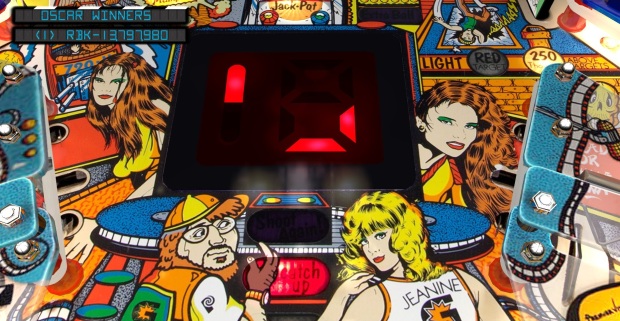
This is one of the most worthless elements of its era. This really doesn’t add to the table at all. Gottlieb might as well have drawn more on the wood and saved a couple bucks.
There’s exactly two good shots on LCA: the hurry-up countdown shot and the million-point loop shot. Sometimes two good shots can carry a table, but getting the countdown is determined by random chance. The table flows about as smoothly as constipation, and multiballs have an uncanny knack of draining each-other out. The theme is boring. Scoring balance is non-existent. Really, I have nothing nice to say about Lights…Camera…Action! I went back to it multiple times during this review process trying to make double-triple-quadruple certain I didn’t like it and almost put it in the “bad” category, but the random chance factoring into our duels was the last nail in the coffin. Lights out.
#85: Starship Troopers
Featured in Stern Pinball Arcade Add-On Pack 1 (DLC/Physical)
Not Included in Arcooda Software
Table Type: Kinetic
TABLE FACTS
Designed by Joe Balcer & Joe Kaminkow
Art by Morgan Weistling
Sound by Brian Schmidt
1997 Sega Pinball, Unknown Sales (Guesstimated by an anonymous source to be 1,200)
Alterations: All Sega references have been removed.
TRIVIA
-One of the most commonly modded Sega tables, as a real table Starship Troopers cabinet has mono sound, despite being made for stereo sound. The system allows for a simple modification to add a second speaker.
-Fred Young provides the voice work for the game.
-Installing Starship Troopers in your Pinball Arcade library changes the game’s rating from E to T.
TEAM RANKING: #78 of 96
Oscar’s Rating: The Pits (#92)
Jordi’s Rating: Good (#51)
Angela: Good (#47)
Eala: The Pits (#91)
Starship Troopers has an off-center drain & flippers, along with a weird little secondary flipper grafted onto the right flipper like a tumor. Dad and I called this the “freckle” (because it’s red and makes an excellent target for shooting rubber bands at) and I swear, every angle is based around using this thing. In fact, the whole table feels like it was designed around this cancerous growth of an element that completely makes Starship Troopers one of the most unfair and unplayable tables in Pinball Arcade. This is HORRIBLE table. It makes me angry how bad it plays because the theme is excellent and the bug body count counter is such a fun, inspired idea.
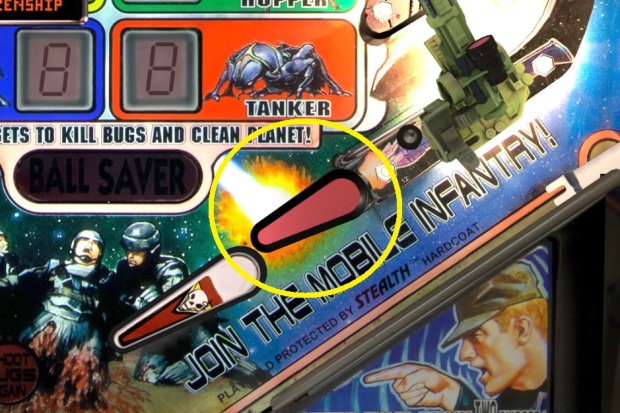
This is the freckle. You control it separately using a different button. There is a neatish thing you can do where you trap the ball in the primary flipper and hit the freckle, which traps the ball in a scoop that drives multiballs and extra balls. Okay, not that neat. Eh, I do approve the Clancy Brown cameo.
But, the extremely bouncy balls, under-powered flippers, and the freckle make this table an exercise in frustration. In standard three-ball mode, it’s so hard you’ll be lucky to see 5% of the game’s content even with lots of practice. The right outlane has a “death drop” above it that makes sharp angles incredibly high risk, while the frequent multiballs (in a table not remotely optimized for multiball play) are unmanageable and designed to result in collisions. The best thing I can say about Starship Troopers is it has a generous ball save, but that’s like saying it knows the table is crap. Sega made some BAD machines during this era, and Starship Troopers is just a taste of how bad it got. I did not, in fact, lose my heart to a Starship Trooper.
THE BAD
#84: Fireball
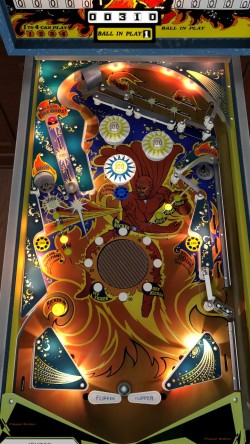 Standard version Permanently Delisted
Standard version Permanently Delisted
Included in Arcooda Software
Table Type: Boardwalk-Kinetic
TABLE FACTS
Designed by Ted Zale
Art by Dave Christensen
1972 Bally, 3,815 Units Sold
TRIVIA
-Fireball received a solid-state sequel in 1981, with artist Dave “Mad Dog” Christensen postponing his exit from the pinball industry to do the art. Fireball II sold 2,300 units and was considered a massive flop by Bally.
-Pat Lawlor’s seminal classic Whirlwind was based on Fireball.
-Midway remade Fireball as a solid state table in 1985. Fireball Classic has a similar playfield, but it uses modern-sized flippers without the zipper mechanism. Artist Dave Christensen declined to return for the remake, and so artist Doug Watson redid the iconic artwork.
TEAM RANKING: #80 of 96
Oscar’s Rating: Good (#71)
Jordi’s Rating: Bad (#83)
Angela’s Rating: Bad (#86)
Eala’s Rating: Good (#63)
Fireball is one of the legends of the 70s era of Bally. And I get that. There was literally nothing like this as far as pinball went in 1972. A huge spin disc that sends the ball all over the table (mostly into the right outlane if you’re me). “Zipper Flippers” that open and close, thus shrinking the drain, depending on what targets you hit. Three-ball multiball. This is a crazy, ahead-of-its time table. And man, was it popular back in the day. In fact, Bally got so many people asking about getting one for their homes that they made a special home version of Fireball to sell in catalogs. That home version was nothing at all like the famous arcade counterpart. It had no spin disc, no zipper flippers, and no multiball. It is literally a stripped down, generic pinball machine (reusing a generic playfield from the table Hokus Pokus only with expensive elements further removed, meaning this is a stripped-down-stripped-down table) that wears similar branding and artwork (but not identical) to the famous coin-operated Fireball. People ordered this out of the Sears catalog for $645 (about $3,000 today). I can’t imagine how pissed they must have been. 10,000 of these fake-real-fake “professional home editions” sold through, which means the fake version of Fireball is one of the highest-selling tables ever (though we don’t grant home-tables Club Status). This was a grifting, plain and simple. On the bright side, it set a precedent for gamers being disappointed by the home versions of beloved arcade games.
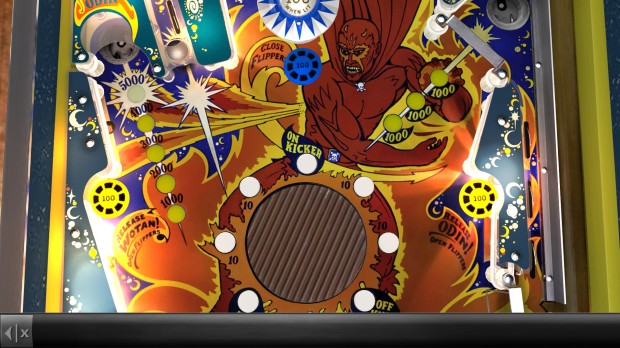
The famous spinner of Fireball is actually the most brutal part of it. It’s too big and too lethal from too many angles, at too many ball speeds. “Famous” doesn’t mean good. Ted Bundy was famous too, you know.
Hell, who knows though? Looking at the “professional home edition” (chuckle), I think it looks like it might be more fun than the real game. Because as novel and insane as Fireball is, it’s so ridiculously chaotic and difficult that it’s not really fun at all. The flippers are typical EM era shorties, and while the novelty of the zipper flippers is good for a smile or two, it wears thin when the biggest issue is starving outlanes being spoon-fed by the ginormous disc. Fireball is to the pinball scene what silver age comic books are: they feed into the false stereotype of what the medium is today. The general public considers pinball to be chaotic and random. “Controlled chaos.” It’s not true at all, but we owe that reputation to tables like Fireball. I’m happy I got to play it, but frankly, I think Gottlieb’s Ed Krynski had a better feel for how to give players value for their pocket change in the 70s.
#83: Al’s Garage Band Goes on World Tour
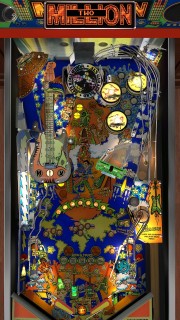 Featured in Alvin G & Co Pack (DLC)
Featured in Alvin G & Co Pack (DLC)
Included in Arcooda Software
Table Type: Finesse
TABLE FACTS
Designed by Jerry Armstrong
Art by Dan Hughes, Tim Elliott, and Andy G. Reynolds
Sound by Kyle Johnson
DMD by Vecennia Jordan
1992 Gottlieb, 1,000 Units Sold
TRIVIA
-All the characters, with the exception of Stitchy, were based on friends and employees of Michael Gottlieb.
-A VUK that was to be located in the horseshoe was removed from the final design, but still advertised on the table’s flyer.
-Al’s Garage Band has a reputation of being one of the most durable tables of its era. At a time with tables started having high failure rates and required frequent maintenance, it had a reputation for not breaking down.
TEAM RANKING: #88 of 96
Oscar’s Rating: Bad (#78)
Jordi’s Rating: Bad (#91)
Angela’s Rating: Bad (#78)
Eala’s Rating: Bad (#85)
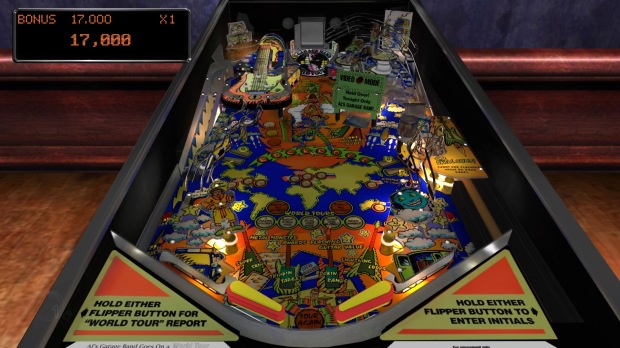
This is like what an old person thought kids of the early 90s were into. My sister, Angela, said “Like something Mr. Burns would design to appeal to Bart.”
What a miserable table. There’s a spin-disc at the top of the playfield that can’t be missed by the auto-launching plunger. If you hit it, and you sort of have to hit it, there’s a high probability it’ll drop the ball literally straight down the drain in a way that even nudging can’t save. I’ve had several instances where multiballs were ended immediately, even with ball save turned on, because the spinner dunked all three balls in the drain in under a second. And even if it doesn’t do it straight away, it might fling them into targets, but still in a way where they’re unplayable. I’m going to guess the real table doesn’t feed the drink as much, even if it’s ultimately a product designed to make quarters. And the really crappy thing? IT’S THE BEST SHOT ON TABLE! I love centralized rear-targets, and so I really should love this.
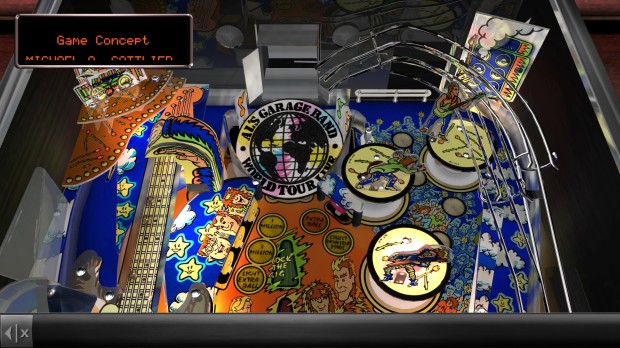
The one good shot in Al’s Garage Band. I’m a sucker for brute shots, and this is a solid one. The spin disc is unpredictable on a return, but clearing it actually does supply a sense of satisfaction. But the same spinner dunks balls that come from any other angle, including off the plunger. I just wish this wannabe Wayne’s World table had some balance. It has absolutely none.
I think Jerry Armstrong was given the task of creating a Dennis Nordman-esq valley-style table. And, while the operating system and scoring balance is certainly not as janky as Gottlieb’s tables from this era, the issue comes down to a limited design and poor flow. I do appreciate the jackpot is achieved by brute-forcing a ball past the spin-disc, but the physics don’t feel consistent for this. If they did, I might even go “good” on it. Also this is the era where jackpots were so out of whack that they were the only desirable scoring mechanic. Al’s Garage Band Goes on World Tour isn’t as bad as I initially had it, but it’s still pretty miserable. It’s a one trick-pony, because all you have to do is shoot the outer orbit, which is laid across clean angles. Do it enough times and you’ll open up Al’s pathetic wizard mode, which is fittingly called “Brain Damage.” Never has a table had a more fitting name for its wizard.
#82: Victory
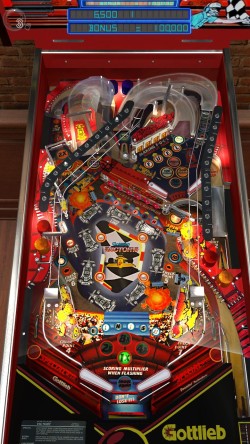 Featured in Gottlieb Table Pack 1 (DLC), The Pinball Arcade: Season Two (PS4 Disc)
Featured in Gottlieb Table Pack 1 (DLC), The Pinball Arcade: Season Two (PS4 Disc)
Included in Arcooda Software
Table Type: Pick ‘n Flick
TABLE FACTS
Designed by John Trudeau
Art by Constantino Mitchell & Jeanine Mitchell
Sound by Dave Zabriskie
1987 Gottlieb, 3,315 Units Sold
TRIVIA
-Victory was the first table to use Mylar images instead of silk-screened images. Several of the playfields had faulty glue and the concept was unpopular with operators in general, and traditional silk-screen replacement fields were commissioned.
-Victory was originally going to be a spiritual sequel to Black Hole & Haunted House by featuring a basement field, but the cost was too expensive and operated had previously loathed the maintenance demands (and high failure rates) of tables that featured basements and the idea was vetoed.
-Also vetoed was a Hot Wheels-style car being on the field that would advance based on what checkpoint the players were at, but the mechanism would have been more expensive than a basement would have been.
TEAM RANKING: #85 of 96
Oscar’s Rating: Bad (#87)
Jordi’s Rating: Bad (#81)
Angela’s Rating: Good (#61)
Eala’s Rating: The Pits (#90)
Victory feels like Gottlieb and John Trudeau trying (and failing) to have their own version of High Speed. You have to understand the circumstances. High Speed was snickered at by competition in the pinball industry, mockingly called “High Price” or “High Cost”. Then it came out, became the best selling table of the decade, was loved by operators, and triggered another golden era of the medium that pretty much lasted for the next twelve years. Gottlieb’s tables suddenly seemed old-fashioned and fundy-duddy by comparison. Much like how Addams Family and Twilight Zone triggered an arms-race for gothic-horror tables (leading to competitive tables like Tales from the Crypt, Mary Shelley’s Frankenstein, etc), High Speed had everyone else scrambling to do their own lightning-fast, combo-heavy table.
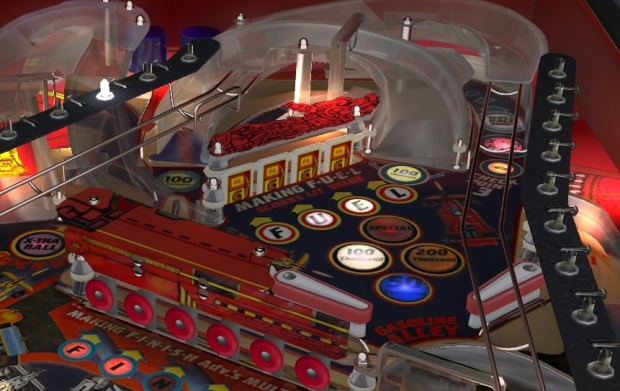
It’s also possible Victory was trying to follow F-14 Tomcat’s lead, since that table has occasional breaks in the action too. Of course, that table can get away with breaks. It’s a white-knuckle speed table. And High Speed’s breaks were always in service to building anticipation for a big mode to come. Victory’s breaks are constant, and even errand shots will inevitably lead to breaks. Take away the DUMB stop-and-go, red-light/green-light nature of Victory and it would have been a solid table. Maybe even a great table. The way you access the mini-field on the right is sharp and rewarding, but balanced and clever. What a waste.
That’s not what Victory is. It wants to be. It couldn’t be more obvious that’s what it’s aiming for. But while High Speed does have breaks in the flow, the non-stop breaks in Victory absolutely demolish its potential. The table has multiple “checkpoints” where the ball is captured so that an obnoxious revving sound can be made, and after a couple seconds of this, gameplay resumes. These “checkpoints” are absurdly easy to access, which results in the game stopping and going like you’re playing Red Light, Green Light in pinball form. Really, a better table to compare Victory to is Swords of Fury, which has a micro-table with five drop targets to shoot, but the flow between it and the main table is non-stop and streamlined. The microtable in Victory is completely segregated from the main playfield this time around. Some tables have poor flow. Victory has NO flow. Too bad, because Victory has decent targets and excellent scoring balance.
#81: Pistol Poker
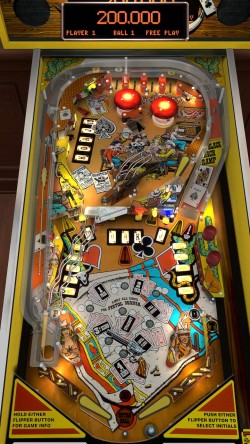 Featured in Alvin G & Co Pack (DLC)
Featured in Alvin G & Co Pack (DLC)
Not included Arcooda Software
Table Type: Finesse-Sharpshooter
TABLE FACTS
Designed by Wally Welch & Michael Gottlieb
Art by Dan Hughes
Sound by Matt Scott & Kyle Johnson
DMD by Vecennia Jordan
1993 Alvin G. & Co, 200 Units Sold
TRIVIA
-Pistol Poker was the fourth and final traditional table created by Alvin G. & Co. They also did a series of two-sided “head-to-head” pins that were unpopular with arcades as they couldn’t be placed alongside other pins to allow clearance.
-Pistol Poker is the rarest released table in Pinball Arcade at only 200 units. Goin’ Nuts’ ten test units technically makes it the rarest, but it’s considered officially unreleased. Pistol Poker isn’t the rarest traditional pin by Alive G. & Co, as only 103 Punchy the Clown tables were manufactured. However, that table was marketed to arcades as a redemption game.
-Designer Wally Welch’s likeness is shown on the “El Gusano” wanted poster, while the piano player is music designer Kyle Johnson.
TEAM RANKING: #91 of 96
Oscar’s Rating: Bad (#83)
Jordi’s Rating: Bad (#88)
Angela’s Rating: Bad (#83)
Eala’s Rating: Bad (#88)
I suspect this table would jump to “good” on any other pinball launcher. One with decent physics. Pistol Poker feels a bit more floaty than normal, and actually getting credit for hitting the targets felt especially wonky here. It’s not like this had potential to be amazing or anything. There’s literally dozens of tables out there that have pretty much the same poker concept, but with better layouts. Pistol Poker is one of those split-level tables where the lower flippers can’t really target anything on the top of the playfield, and instead you get a single right flipper to do all the target shooting. “A poor man’s Steve Ritchie design” as Oscar calls it. For Pistol Poker, the bumpers crowd the limited upper-flipper. I think it’s supposed to create a sense of urgency, but it’s not that hard to get to the upper playfield. This split-level didn’t work for me at all.

What a crying shame that the physics fail Pistol Poker. It wouldn’t be a spectacular table or anything, but it looks cool, has moderately balanced and rewarding scoring, and hey, I have a soft spot for old west themed tables. I tried harder to like Pistol Poker than anyone else who disliked it. I just couldn’t. The card targets are so poorly placed and often seem to not activate properly.
And the old west theme is barely used. There’s ONE fun mode where every light and target goes live and counts as a bullet being fired by a gunslinger. I wanted more of that type of stuff. But the bonus entrance that allows you to get cards you haven’t gotten the target lit for, which requires you to time a light indicator on the backglass, is too prominent. It’s literally right in front of the flippers and is arguably the primary target of the table. Bizarre to be sure. I wish I had more to say, since this just technically won “best in set” for the Alvin G. & Co pack, but ultimately Pistol Poker is just really boring. If they’re going to ever do another table like this, I’d rather they do the 1994 Data East table based on the movie Maverick. That’s a good card game based table. Pistol Poker is shooting blanks.
#80: TX-Sector
 Featured in Gottlieb Table Pack 3 (DLC)
Featured in Gottlieb Table Pack 3 (DLC)
Included in Arcooda Software
Table Type: Sharpshooter
TABLE FACTS
Designed by John Trudeau
Art by Constantino Mitchell & Jeanine Mitchell
1988 Gottlieb, 2,336 Units Sold
TRIVIA
-One of three tables with a “Vitrigraph” playfield (Victory and Diamond Lady being the other two). As with Victory, some of the playfields were replaced with traditional silk-screened artwork.
TEAM RANKING: #65 of 96
Oscar’s Rating: Good (#65)
Jordi’s Rating: Good (#69)
Angela’s Rating: Good (#53)
Eala’s Rating: Good (#45)

I’m the sole negative vote for TX-Sector as the team all felt this table played fine. For me, something felt off about it.
The cynic in me is guessing that TX-Sector came into being because Pin*Bot was scorching hot and Gottlieb wanted their version of it, similar to how Victory was their answer to High Speed. Maybe I’m wrong, because Sector doesn’t copy the theme directly. TX-Sector’s ambitious “teleporting ball” concept might have dazzled in 1988, as did its striking visual design. I happen to think both it and Victory (two of the three tables that used “Vitrigraph” Mylar overlays) are kinda ugly, but hey, gameplay is king. The problem with TX-Sector is, once again, poor flow, though that might be owed to this being one of the lesser-effort tables for Pinball Arcade. The ball feels a bit too bouncy and the slope feels sort of off. I haven’t played a real TX-Sector. Mostly it’s just a dull theme. You build up your “energy” by shooting port targets.

Behold the one-and-only decent target TX-Sector has going for it. It’s a drop target married to a hurry-up, with picture-perfect placement on the table along a slightly off-angle shot. Love it. So satisfying to complete properly. And I hate that it’s here because I’d rather have a table be 100% bad than have a really incredible shot surrounded by a mediocre table. It makes that incredible shot feel wasted.
But, the teleportation shots are uninteresting, with the possible exception of the hurry-up ramp shot. The ramp is blocked by a drop target and is a fairly interesting concept. But even the best shot is made overly simplistic and dull by the scoring system. That’s TX-Sector in a nutshell. The multiball is tied to raising the energy level to the max and feels like a grind, but once you get it, it opens an overly simple extra ball. I take back what I said about TX-Sector dazzling in 1988. Like Victory, the best thing I can say about TX is it has relatively balanced scoring. And, also like Victory, that fine-tuned scoring is wasted on a table that bores.
#79: Cirqus Voltaire
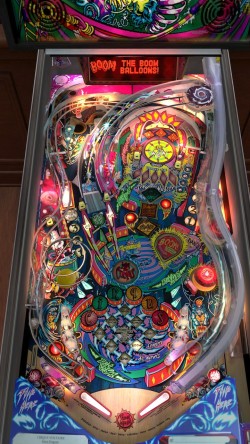 Featured in The Pinball Arcade: Season One (PS4 Disc Only)
Featured in The Pinball Arcade: Season One (PS4 Disc Only)
Included in Arcooda Software
Alternative Version: Pinball FX3 Williams Pinball Volume 5
Table Type: Finesse
TABLE FACTS
Designed by John Popadiuk
Art by Linda “Deal” Doane
Sound by Rob Berry & Dave Zabriskie
DMD by Adam Rhine & Brian Morris
1997 Midway Manufacturing, 2,704 Units Sold
TRIVIA
-Cirqus Voltaire had, adjusted for inflation, the highest production cost of any traditional table in pinball history.
-Cirqus is the first solid state table with disappearing pop bumper.
-One of two tables with a DMD display mounted on the playfield (the other being Capcom’s Flipper Football).
-Four versions of Cirqus Voltaire were made, each with a different neon tube color (and some with a different colored menagerie ball). Among pinball collectors, it’s generally agreed that Red and Yellow are more rare and desirable.
TEAM RANKING: #87 of 96
Oscar’s Rating: The Pits (#91)
Jordi’s Rating: Bad (#76)
Angela’s Rating: Bad (#84)
Eala’s Rating: Bad (#83)
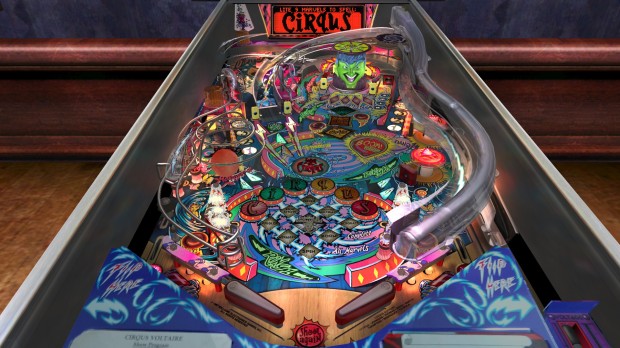
Amazing what a difference an engine makes. The Ringmaster in Pinball Arcade looks completely different from the one in Pinball FX3.
On Pinball FX3, I gave Cirqus Voltaire a “great” rating. In Pinball Arcade, it’s two full tiers below that, in the “bad” category. The Pinball Arcade version messes the bed and turns a fun table into a crap one, and that’s a crying shame. I honestly don’t know if this is more “true” to the real table or not. If the real table plays this bad, I say “here here” to what Pinball FX3 accomplished with their port. Let’s tally the damage: the Ringmaster orbit often leads to an instakill. A rejection on the ramp leads to an instakill. The left outlane almost never gives a kind bounce and is an almost certain ball loss if it comes anywhere near it. Cirqus Voltaire was already a hard enough table without having physics issues add more challenge that really shouldn’t be there. Or, if it’s truly there in the original table, didn’t need to be there, as Zen Studios proves. And really, those issues are just the tip of it. I had so many other shots, some of them seemingly successful ones, instadrain out without any hope of save, nudge or not, that I lost count. Drained a few off the balloon from angles that should have been safe. I right-outlaned a few times off the slingshots. Plus, in versus mode, the ball lock would glitch and spit up two balls. Actually, this happens a lot in Pinball Arcade in multiplayer games. We call it “Lock Drops.” The one positive thing I can say about that aspect is it makes the game more interesting, and since you don’t die if a single ball drops, it’s like a free multiball that doesn’t have jackpots attached. Of course, this also gives one player an unfair advantage in multiplayer, where the lock drops are 10x more likely to happen.
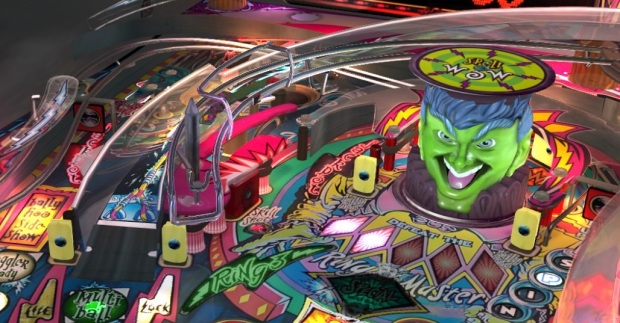
While the Ringmaster is the primary target of the table, High Wire Multiball I find drives scoring best and preps you to run through the rest of the modes. Cirqus Voltaire is one of those “you need to warm-up” tables that takes a while.
So brutally punishing is Cirqus on Pinball Arcade that it’s just not fun at all on this pinball platform. Not even a little bit. It’s not as if the PBFX3 version was a walk in the park. I had its difficulty classified as “above average”. But it wasn’t as straight-up unfair as the Pinball Arcade version. I feel like survival is too much based on dumb luck this time around. The only thing saving this from a ranking of “The Pits” is the fact that Cirqus Voltaire was 90% of a perfectly laid-out pinball table to begin with. I still think the caged ball near the left flipper is nothing more than table clutter, and I think the Ringmaster is one of the most over-rated primary target toys of the late arcade era. I don’t know if I feel bad for the people who bought Pinball Arcade just for Cirqus Voltaire (and its fans are some of the more passionate in the sport so it’s possible that happened a few times) or happy for them that this is “arcade accurate.” If it is, then it might give White Water competition for the most over-rated table in all of pinball. But, trust me, just stick to Pinball FX3’s version.
#78: White Water
Member of the 7K Club
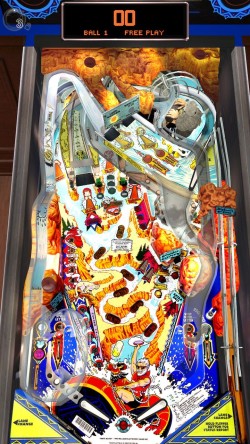 Featured in The Pinball Arcade: Season Two (PS4 Disc Only)
Featured in The Pinball Arcade: Season Two (PS4 Disc Only)
Included in Arcooda Software
Alternative Version: Pinball FX3 Williams Pinball Volume 4
Table Type: Kinetic
TABLE FACTS
Designed by Dennis Nordman
Art by John Youssi
Sound by Chris Granner
DMD by Scott Slomiany
1993 Williams, 7,008 Units Sold
TRIVIA
-The Bigfoot is modeled after designer Dennis Nordman’s appearance.
-The truck seen on the backglass was based on Nordman’s 1952 Dodge.
-Completing “Vacation Planner” is considered by many professionals to be the most difficult “Wizard” to achieve in modern (DMD) pinball.
TEAM RANKING: #59 of 96
Oscar’s Rating: Good (#59)
Jordi’s Rating: Good (#75)
Angela’s Rating: Great (#24)
Eala’s Rating: Good (#54)
White Water is still every bit as maddening, cheap, and unfriendly as it was on Pinball FX3. But, in one of the truly shocking moments of the Season Two Pinball Arcade disc, I actually liked this version more. The more floaty gravity makes the table more forgiving. Granted, it was like how classic arcade mode in Pinball FX plays better. For me, both Pinball FX3’s classic arcade modes for the Williams recreations and Pinball Arcade’s physics are nearly the same, only Farsight’s engine is slower than Pinball FX3’s. Is either true to a real table? No. But it’s either spend close to $10K on a table I hate or a couple bucks for a fake, inaccurate version of a table I hate. I’ll go with the latter.
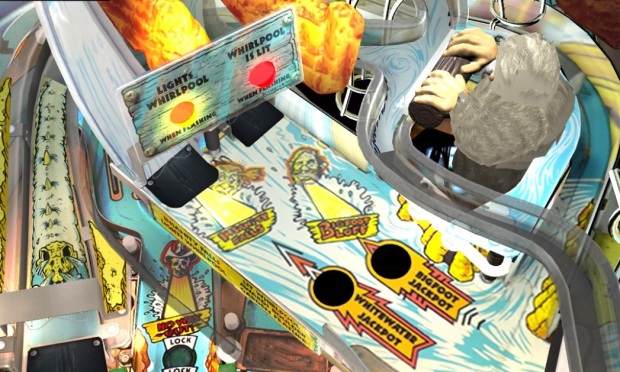
The bat flipper leading to two different routes is hypothetically good, and I imagine on a real table it’s easier. In Pinball Arcade (or Pinball FX3 for that matter), it’s so much harder to judge depth and get the timing down for, say, Insanity Falls. I put a lot more time than average into White Water than any other table that got a “BAD” rating, and so did Dad. Neither of us could clock the shot with consistency.
But, yes, this is an ultimately easier version of White Water. Which is like saying it’s probably easier to be guillotined than it is given the electric chair. I wasn’t ever a fan of this pin, and was actually surprised by how many people responded to my Pinball FX3 review of it with “glad someone besides me thinks that.” White Water has its fans, but even they tend to concede this is a problematic table. I think the issue is too much real estate is devoted to the housing the various ramps and orbits. The usable playfield is small, cluttered, and runs too fast for such a relatively limited amount of space. The orbit and ramp entry points are tight squeezes with clankable rails that drain out or especially get swallowed by the succubi outlanes. The right outlane of White Water is one of the notoriously brutal of the solid-state era, and finessing it requires.. frankly.. a real table with real-life tiling skills. I can’t stress enough the degree of difficulty of using an analog stick to simulate the subtly of rocking a 300lb pinball machine. That simply can’t be replicated even with the finest of tuning with a cheap piece of plastic and hard rubber. Well, unless you can make it a 300lb cheap piece of plastic and hard rubber shaped exactly like a pinball machine.
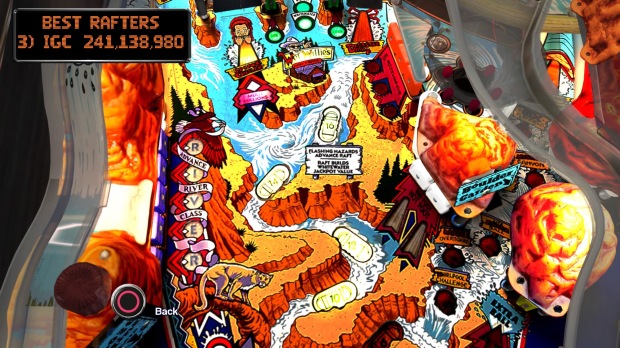
You really can’t appreciate how crowded White Water is until the ball is served to you. It’s one of those “fire at an angle designed to cause the ball to bounce off the outlane rail and hopefully drain out so the arcade operators get more quarters” type of deals.
And that’s the problem with White Water. The most common complaint I got about my Pinball FX3 review of it was that I was lumping in the real table (which I’m not overly experienced with since it’s not in our private collection) with the digital one in terms of calling it over-rated. Maybe that wasn’t fair, but I absolutely could have played a lot more of the real table than I have. I took other options, because I didn’t like the table because it’s overly frustrating and too damn hard. But, I can’t base my review of a digital-only experience on my expectations of how the real table plays, and I didn’t. I gave White Water a bad review on Pinball FX3 because I hated playing it on Pinball FX3. And I’m doing the same for Pinball Arcade. White Water on this platform sucks. It’s too hard, and even when you play well, the table turns on a dime so quickly and with such consistency that you can’t even enjoy doing good. You sit on the edge waiting for the other shoe to drop. That’s just not fun.
#77: Sorcerer
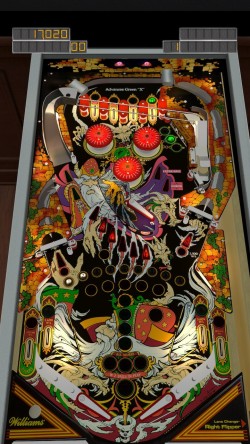 Permanently Delisted
Permanently Delisted
Not Included in Arcooda Software
Table Type: Sharpshooter
TABLE FACTS
Designed by Mark Ritchie
Art by Pam Erickson
1985 Williams, 3,700 Units Sold
TRIVIA
-Two color schemes exist for Sorcerer, one where the Sorcerer’s robe is royal purple with pink trim, the other where it’s blue with red trim. Each version’s skulls and feathers are also different colors. The blue/red version is considered the rarest.
TEAM RANKING: #62 of 96
Oscar’s Rating: Great (#30)
Jordi’s Rating: Good (#63)
Angela’s Rating: Good (#62)
Eala’s Rating: Good (#62)
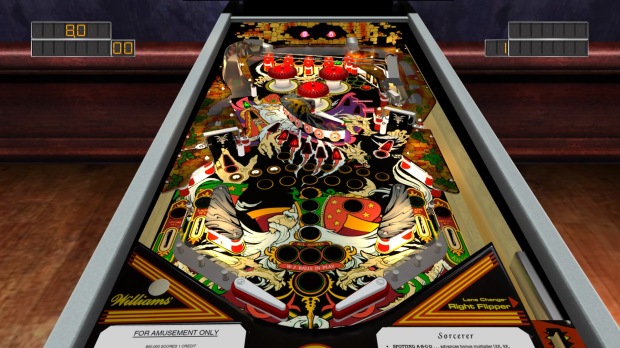
Dungeons & Dragons was scorching hot at the time, though Williams didn’t shell out for the license. Bally did, and a mediocre D&D table was released with weird-ass retractable outlanes in 1987.
In the interest of full disclosure, I didn’t get as much time with Sorcerer as every other table on this list. I typically put in, at minimum, 5 to 6 hours per table before writing it up. I did only about twelve play-throughs with Sorcerer (and a few more since then). It’s the only table I didn’t put a ton of Steam time into as well. For whatever reason, this one didn’t set well with my epilepsy. The weird thing is other tables have actual strobe lights on them, but with precautions (which includes sunglasses and drowning the room out with lights), I can play them relatively safety. It’s not comfortable, but it works. Except Sorcerer. When you lock balls for multiball, the entire table flashes. Even after adjusting the settings (Bulb Brightness: 0%, Room Brightness: 50% seemed to work), I felt uncomfortable pressing-on after getting triggered already by Sorcerer (the only time that happened in 100 tables, and it even happened a second time during my final run of the lineup).
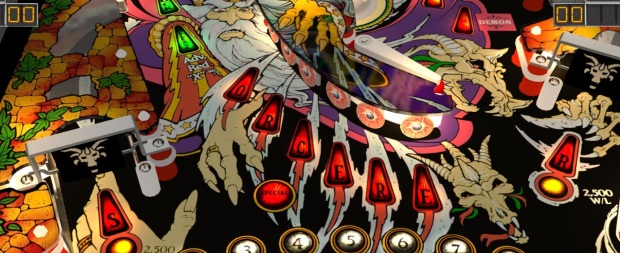
The S-O-R-C-E-R-E-R lights are what really needed a bat flipper. Especially the O, which is one of the worst-placed targets in Pinball Arcade. You’re almost certainly going to light it off a lucky bounce. That area is designed to be bouncy, so Mark Ritchie must have realized it, but seriously, come on, what the hell? Why is there a flipper for targets that didn’t need them, and no flipper for targets that absolutely should have one? Ridiculous that anyone rates this table good. And Dad says it’s great! You lose every argument about Theatre of Magic forevermore, Daddy. Deal with it.
That’s fine. Sorcerer I really didn’t feel is anything special. This is a perfectly stereotypical mid-80’s table with the one twist being a mid-field left flipper placed in a very congested area of the table to allow precision-shooting of.. um.. like three targets. Yeah. I mean, sure, you can also shoot the rollovers too, but those have access off the primary flippers. I don’t get this design element at all. It’s so limited and awkwardly placed. Really, the top part of the field was too cluttered to accommodate the flipper. The sad thing is, if this same idea had been done post-Lawlor era, where crowded layouts weren’t unusual, nobody would have batted an eye if Mark Ritchie lowered the placement of that upper-flipper.
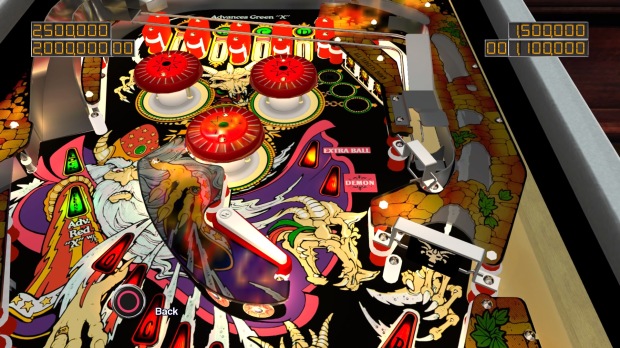
Really, he should have just done away with having an upper-flipper and turned Sorcerer into a two-flipper sharp-shooter design. Keep the targets in the flipper’s housing, but angle them to provide access to the upper targets. This flipper reminds me of those tacky types who outfit body-kits to their already nice cars, ruining them and looking like dorks in the process.
Ritchie should have lowered the upper flipper anyway. The ramp that feeds multiball is off-angle (then again, so is that upper-flipper and the targets it shoots), and there’s enough room to make the flipper have a little more value outside three targets and juggling. So, sorry fans, I don’t get Sorcerer. BUT, I’m also not arguing it’s a terrible table. I do appreciate the bizarre angles and fun multiplier integration. But the S-O-R-C-E-R-E-R targets are bland, the multiball throws the scoring balance off, the roll-over lights are annoying, and I just didn’t have fun playing it. Mark Ritchie already had a masterpiece in Firepower II and would go on to further greatness. This wasn’t a feather in his cap.
#76: Gladiators
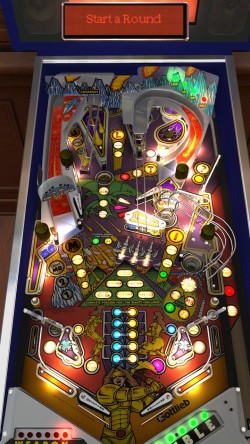 Featured in Gottlieb Table Pack 1 (DLC)
Featured in Gottlieb Table Pack 1 (DLC)
Included in Arcooda Software
Table Type: Finesse
TABLE FACTS
Designed by Jon Norris
Art by Constantino Mitchell, David Moore & Jeanine Mitchell
Sound by Craig Beierwaltes
Music by Duane Decker
DMD by Rand Paulin
1993 Gottlieb, 1,995 Units Sold
TRIVIA
-The original prototype of Gladiators was based on the Legend of Zelda series, as Gottlieb had a three-table licensing deal with Nintendo and released a Super Mario Bros pinball machine and redemption machine in 1992.
-During development, Gottlieb acquired the popular-at-the-time American Gladiators license, but the deal stipulated the table be released the next fiscal quarter. Gottlieb got out of the Nintendo agreement and had Jon Norris begin converting the table to fit the American Gladiator theme, but there wasn’t enough time to meet their unreasonable request. Gottlieb lost both licenses and so Norris had remove all references and change the table to simply Gladiators.
-Holding both flipper buttons disables Gladiator’s bumpers.
TEAM RANKING: #89 of 96
Oscar’s Rating: Bad (#80)
Jordi’s Rating: Bad (#86)
Angela’s Rating: Bad (#81)
Eala’s Rating: The Pits (#94)
The machine that was originally going to be based on Legend of Zelda, by the designer of the Super Mario Bros pinball table. Then it was going to be based on American Gladiators, but that fell through. So they kept the Gladiators name but also the Zelda-like theme, which probably saved Gottlieb (who was hemorrhaging money by that point) a lot of money. The history of this table is so much more interesting than the gameplay it hosts. Gladiators is a bizarre pin that feels unfinished. Like many mid-90s Gottliebs, it feels like it’s hurrying players artificially, with very limited after-ball bonuses. It’s like they felt the thing that would give them a competitive edge over other manufacturers would be if players spent ten to fifteen less seconds on a table watching bonuses add up. I can picture some out of touch manager saying “hey, it adds up! Arcade owners and route operators will LOVE US for it!” It’s so weird to drain a ball out and have the next one immediately load. It gives the whole thing this weird prototype feel. Which is strange because there IS an actual prototype table on Pinball Arcade (Goin’ Nuts).
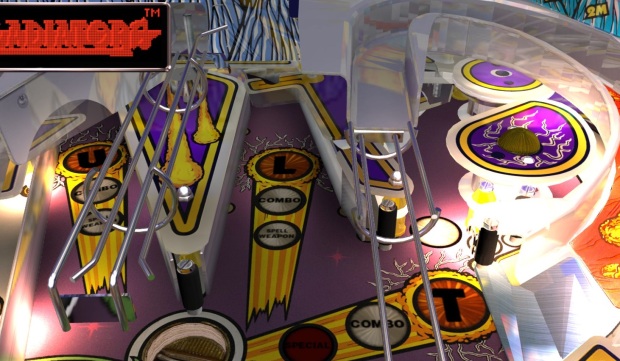
These are some of the most confusing orbits to follow in Pinball Arcade. This is by design. They were supposed to mimic the feel of getting lost in a dungeon in the old 2D Zelda games. It’s easily Gladiator’s most successful design element. The one idea that unquestionably works. I’m really not sure what they were aiming for with the swinging Catapult. What’s the Zelda 1 to 1 on this? Either way, the ultimate irony is, even without the Zelda license, this is still a better Zelda table than the Super Mario table is for Mario. Someone is modding a Gladiators to be a hybrid Gladiators and a modern Jersey Jack LCD scoring table themed on Zelda. This Legend might actually come true, even if it’s only as a one-off fan mod.
Not-Zelda/Not-American Gladiators seems like it should be fun. It’s got a nifty ramp system and a moving habitrail. It almost feels like a Japanese fan-style table with multiple orbits to shoot and build combos. The orbits are confusing, but deliberately so. They’re supposed to mimic the dungeon feel of the original NES Legend of Zelda and the SNES Link to the Past sequel. This is, shockingly, successful. It does sort of have a dungeon-exploration feel. The problem is the flow is wonky and grinding is just too easy. Hell, one of my Dad’s favorite design signatures is Steve Ritchie’s short upper-orbit. There’s a reverse-angle one here, and it’s excellent because a successful shot feeds the right flipper. The game rewards you NOT repeating orbits and outright challenges you to shoot specific ones. This should be awesome, even with flow as smooth as a backed-up toilet.
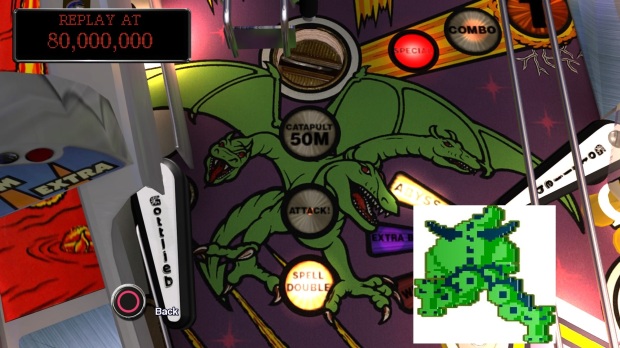
There’s no sign of Ganon, but you can see Gleeok’s representative on the table. Strangely, every Zelda spin-off seemed to focus on this relatively low-stakes fight. Even the Game & Watch for Zelda was based around this battle.
But then, there’s the scoring balance. Like most Gottliebs from this era, luck factors in far too much. The mystery rewards (that you’re awarded if the ball drains via an outlane) can be as low as zero, or as high as 20,000,000 points. As of this writing, in the (surprisingly still-populated weekly global leaderboards), the top of the board is usually around the 200M range. That means you’re getting 10% of what is considered a decent score by blind stupid luck. Also, this works even if ball save is on. You can get the mystery score AND the ball back, which is potentially a risk-reward thing IN THEORY, though it’s still sheer-luck. And if you love doing multiplayer duels, forget about it. Gladiators has fans, but this is NOT the table to test your skills against opponents. In four PS4 games and one Galactic Rules match (five balls, difficulty set to easy, we could only do one because the game crashed if you played more than one game with modified settings on ANY System 3 Gottlieb table), I swept Dad despite him EASILY out-playing me. His random rewards just didn’t touch mine. I could play average or worse, he could play above average or better, and I still won every game. And yes, I got the 20 million award all four of those games. His highest mystery award? 3,000,000. I mean, woo hoo for me and all that but it was garbage. Our Steam series ended similarly. Under our “Vice Rules” (if you don’t have the highest score of the best of seven series, you must win by two games or it goes into overtime), it went into extra games. We were both burned out by Game Ten and played poorly. Dad still played slightly better, but my top mystery reward was 20 million. His best was 5 million. As he put it: I didn’t win the series. I was awarded it. I love the layout for Gladiators. I didn’t at first, but it grew on me more than any other table did. But it’s still a bad table. And it’s all on bad scoring.
#75: Black Rose
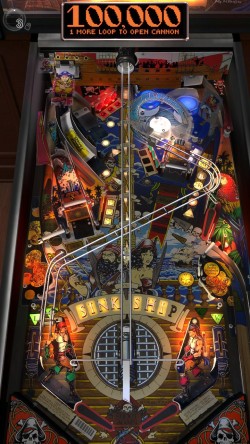 Permanently Delisted
Permanently Delisted
Included in Arcooda Software
Alternative Version: Pinball FX3 Williams Pinball Volume 1
Table Type: Finesse
TABLE FACTS
Designed by John Trudeau & Brian Eddy
Art by Pat McMahon
Sound by Paul Heitsch
DMD by Scott Slomiany
1992 Midway Manufacturing, 3,746 Units Sold
TRIVIA
-The original plan was for the game’s pinballs to be painted black, but this was abandoned before manufacturing began due to visibility issues.
-The original working title for Black Rose was, coincidentally, Black Pearl, which would go on to be the name of Jack Sparrow’s beloved ship in the Pirates of the Caribbean franchise.
TEAM RANKING: #72 of 96
Oscar’s Rating: Good (#66)
Jordi’s Rating: Good (#38)
Angela’s Rating: Bad (#72)
Jordi’s Rating: Bad (#73)
Black Rose being delisted on Pinball Arcade is no great loss, as the Pinball Arcade version is just not good. It’s uncanny how much tougher this table is, to the point of being demoralizing. It runs a LOT faster on Pinball Arcade, which is an issue for a crowded table such as this. The ball is also a bit too bouncy and features like the Sneak Attack are too hard to pull off because of it. But really, the killer for Farsight’s take on the high seas table is the right outlane. It’s absolutely starving. It makes an already high-difficulty table next to impossible to hope to excel at. It was uncanny how any ball that touched the rail drained out on that side. Unless the ball sunk the lane nothing-but-net style, you were sure to wobble into the outlane. This makes the brutally difficult multiball that much more unplayable as well.
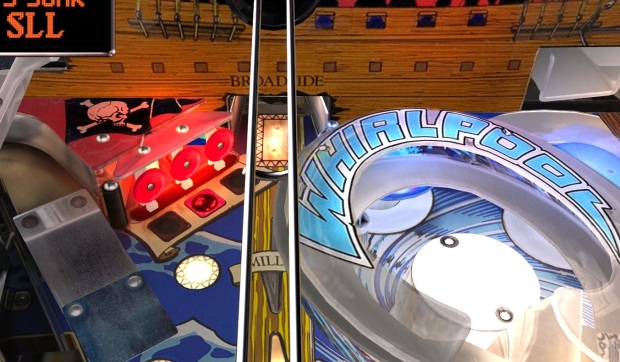
Brian Eddy’s signature design element made its debut in Black Rose. He’d go on to do great things. His partner on this table would go on to make us wish he didn’t have his name attached to so many tables.
The shame is, Black Rose always had potential to be one of the all-time greats. It’s the prototype for what Brian Eddy would later go on to do with Attack from Mars: the large, centralized target and combo-centric ramps and orbits that surround it. But, this format doesn’t work in a clogged, congested, valley-style field. Nor does the god awful lack of scoring balance. Any mode but the millions-mode feels like its a waste of time. Hell, once you’ve played the millions ramps with multiball, any version of millions without multiball feels like it’s not living up to its potential. Black Rose might be the most gorgeous early DMD table, but it’s also one of the most problematic. And, on Pinball Arcade, it wasn’t even worth the effort.
#74: Hurricane
 Permanently Delisted
Permanently Delisted
Included in Arcooda Software
Alternative Version: Pinball FX3 Williams Pinball Volume 4
Table Type: Pick ‘n Flick
TABLE FACTS
Designed by Barry Oursler
Art by John Youssi & Python Anghelo
Sound by Paul Heitsch
1991 Williams, 4,400 Units Sold
TRIVIA
-The concept of a ball being transported via a basket contained in a reel (as seen in Hurricane and prequel Cyclone’s Ferris Wheel) dates back to 1935’s Barrel Roll. It works functionally the same here as it did 85 years ago.
-A spinoff of Oursler’s Coney Island trilogy, The Pinball Circus, had a completed prototype designed by Python Anghelo. Three working units built. One is installed in the Pinball Hall of Fame in Las Vegas. Had it gone into full production, it would have cost over one-thousand dollars more than Midway’s SuperPin line did to operators, and it was also feared that it would have too high a failure rate and the project was cancelled. The fallout from Pinball Circus ultimately led to his leaving Midway.
TEAM RANKING: #79 of 96
Oscar’s Rating: Bad (#79)
Jordi’s Rating: Bad (#82)
Angela’s Rating: Good (#56)
Eala’s Rating: Bad (#76)
This is another one of those Pinball Arcade tables that Pinball FX3 should tell fans to compare and dare them not to say they did it better. Hurricane on PA does so much wrong. This seems to mostly relate to the interface cooperating sluggishly with the ROM (I should point out this didn’t happen on Steam). We had instances of shots not registering, of lag, and occasionally the whole engine would crap the bed. The ball would leave the playfield and get a hard-reset to the plunger. Immediately upon firing, we’d be credited with a Hurricane shot worth at least 200,000 points. Which makes sense, actually. After all, the ball goes from being on the playfield to traveling that ramp via the plunger. But, it makes the scores illegitimate. This was a rare occurrence.. if it hadn’t been, this alone would land Hurricane in Broken section.. but it happened enough to annoy.
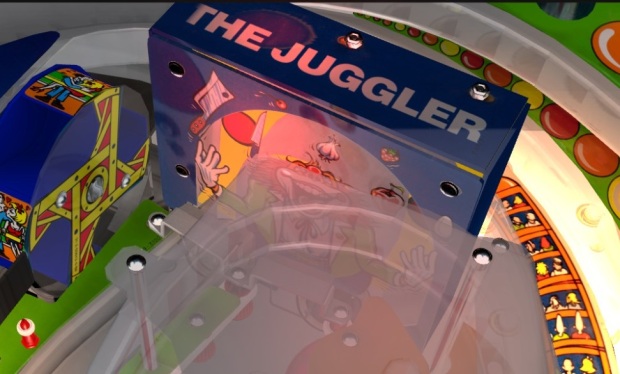
The Juggler toy is one of those “victims of The Curse of Digital Pinball™” situations. In Pinball Arcade, you can’t really see it at all from any viable angle.
Really, this is just a weak version of what is, at best, just a barely okay table. The biggest issue with Hurricane is something anything less than a full-remake of it can’t address: there’s too much downtime. Take the Ferris Wheel shot: regardless of whether the shot is lit or not, if the ball travels up its orbit, you’ll have to wait for it to ride the double-wheels before getting it back, even without it being worth anything. It’s so nonsensical. If there was something that gated the shot when it wasn’t lit, the table would play much quicker and be more satisfying. But downtown is hardly limited to the Ferris Wheels. The Juggler shot also pauses the games, albeit more briefly. The mystery spinner takes forever to choose its value and the skill shot involves two full rides across the Hurricane ramp. Hurricane is a pick-and-flick table through-and-through, but those don’t have to play this slowly.
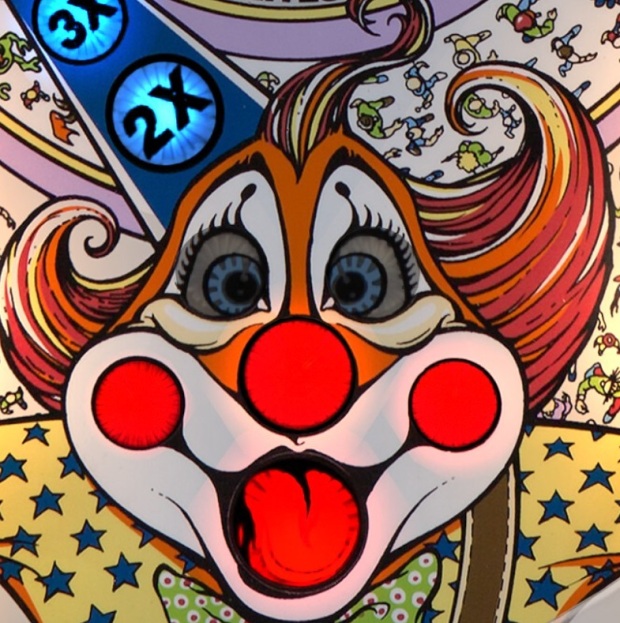
Given the most common complaint about Pinball Arcade’s physics, really, the clown is right: THEY ALL FLOAT DOWN HERE!!
#73: Big Shot
Honorary 12K Club Member
 Featured in Gottlieb EM Pack (DLC), The Pinball Arcade: Season One (PS4 Disc)
Featured in Gottlieb EM Pack (DLC), The Pinball Arcade: Season One (PS4 Disc)
Included in Arcooda Software
Table Type: Sharpshooter
TABLE FACTS
Designed by Ed Krynski
Art by Gordon Morison
1974 Gottlieb, 2,900 Units Sold plus 9,000 for Hot Shot
TRIVIA
-Big Shot is a favorite of old-school professional pinballers. It has been argued the best player at Big Shot is the defacto world champion of pinball.
-If you include all official clones of Big Shot, including ones for European markets and ones that feature “Add-a-Ball” for high scores instead of offering replays (which could be hypothetically used for gambling) it has combined sales of 15,039, which would make it the 12th-highest selling pinball machine ever made (thirteenth if you include El Dorado’s many clones).
TEAM RANKING: #55 of 96
Oscar’s Rating: Great (#31)
Jordi’s Rating: Good (#49)
Angela’s Rating: Bad (#75)
Eala’s Rating: Great (#37)
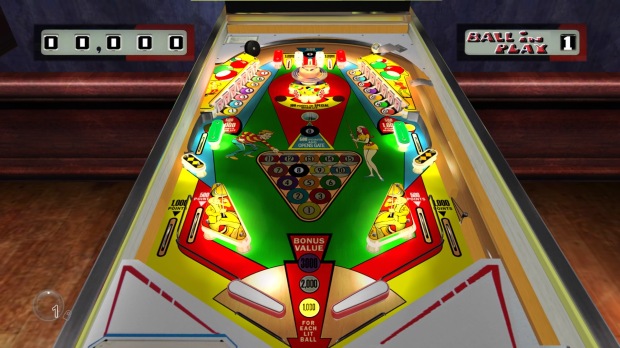
Love it or hate it, many purists consider this to be the best table ever. Many pinball championships were apparently decided on a Big Shot table.
Big Shot is a maddening table that I put more time into than most of the reefer-era Pinball Arcade classics. It just SEEMS like it shouldn’t be as difficult as it is. The pool theme is a total non-factor. It plays or scores nothing like pool. The billiards balls are used to represent fourteen drop-targets along the left and right walls (solids on one side, stripes on the other) along with an eight-ball chute on the top and an eight-ball kick-out hole in the center of the field. The object is simple: Knock down all the drop targets. How hard can it be? Well, in hours of playtime, I still only twice managed to knock all fourteen targets down. And the first time, I didn’t have the eight-ball, because of course I didn’t.
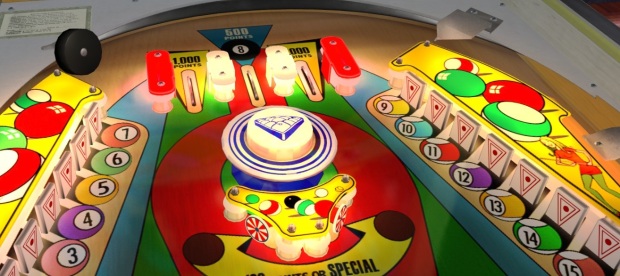
The #1 complaint I get from the pinball community.. and Dad.. and Jordi.. and two of my three dogs.. is that I don’t give a rat’s ass about theme integration. Having said that, how can people who DO put a lot of stock in being “true to the theme” like Big Shot? It has NOTHING to do with pool! Nothing at all! It doesn’t score like pool, incentivize shots like pool. There’s one saucer that doesn’t function like a pocket on a pool table. Really, this is the most removed-from-the-theme table I’ve EVER played. I don’t get you guys, sometimes.
I don’t know if it’s the physics or not. My Dad, who has more experience playing EMs than I have playing pinball, says it feels “close enough”, though I swear I can’t get over the weird glidey, uncanny valleyness of the movement physics. I will say, of all the EM tables, this one seems like it should be the most “fair” or most “modern”. And also, the PC version plays smoother. But it has starving outlanes and every target’s angles risk draining or hitting the bumper, and God knows what happens once you hit it. It just seems like Big Shot is harder than it should be. In multiple hours spent just on this table, I never once got a free ball, even though the targets are exposed and I met the conditions for it. Big Shot is just too damn hard to enjoy. I didn’t feel like my shooting, my skills, even my best play mattered. It felt like I was completely at the mercy of dumb luck.
#72: Phantom of the Opera
 Featured in Stern Table Pack 2 (DLC), Stern Pinball Arcade Add-On 2 (DLC/Physical)
Featured in Stern Table Pack 2 (DLC), Stern Pinball Arcade Add-On 2 (DLC/Physical)
Not included in Arcooda Software
Table Type: Finesse-Kinetic
TABLE FACTS
Designed by Joe Kaminkow & Ed Cebula
Art by Paul Faris
Sound by Kyle Johnson
1990 Data East, 2,750 Units Sold
Alterations: All Data East logos have been removed.
TRIVIA
-Phantom of the Opera is based on the 1910 Gaston Leroux book, not the Andrew Lloyd Webber musical.
-Artist Paul Faris used his daughter as the model for Christine.
-A special two-sided backglass was created that would reveal what the Phantom looks like under the mask when its light flashes.
TEAM RANKING: #73 of 96
Oscar’s Rating: Good (#55)
Jordi’s Rating: Good (#62)
Angela’s Rating: Good (#57)
Eala’s Rating: Bad (#81)

Not based on the Joel Schumacher movie. You can tell by the lack of nipples. In fact, this is based on the Gaston Leroux novel.
Data East in the early 90s had a reputation for over-paying for licenses. Robocop, Ninja Turtles, Monday Night Football, and several others. None of these licenses really made much of a dent. Their tables were never as popular as the stuff cranked at by Bally/Williams. The truth is, Data East didn’t really get their act together until around 1992. I’m also guessing they ran out their budget for 1990/91 because Phantom of the Opera is, how shall we say, an interesting theme choice for pinball. 1990 arcade goers being known for their enthusiasm of 1911 books, or 1986 Broadway shows. Yes, of course they wanted to capitalize on the Andrew Lloyd Webber musical, probably under the presumption a big-budget film adaption could hit at any time.
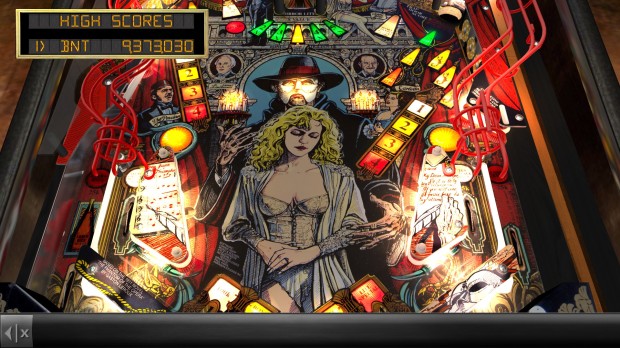
Phantom of the Opera is a looker for sure. Probably the best looking Data East pin. I just wish the table played as good as it looks. Also, for you Phantom purists out there, the table has the Persian in it.
I get flack for not reviewing themes, but here I gotta give Phantom props: it actually looks the part and the signature organ shot feels high-stakes and intense. It hits all the right notes, no pun intended. The problem is those damned “patented solid state flippers” it wears. For real, they really made a big deal about their flippers to arcade operators.
The issue is, those super technologically incredible patented flippers are essentially Lightning Flippers and much smaller than normal, making the gap between them less a drain and more a canal that you can drive a barge through. That signature organ shot is lethal from many angles because it feeds that flipper gap. That’s an issue because the table has no modes and is literally all about that one shot, which drives multiball. If I had a real Phantom of the Opera table, I’d swap out the Solid State Electronic Flippers™ for standard sized ones and probably have a decent table. Gameplay is extremely shallow, though there’s two really great shots: the ramp and trap door. Besides them, the now passe novelty of a table that has moving parts, and relatively decent scoring balance, Phantom basically has nothing going for it. Probably the most shallow solid state table you can still buy in Pinball Arcade.
#71: World Champion Soccer
Member of the 8K Club
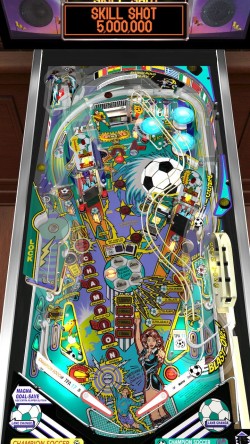 Released as World Cup Soccer
Released as World Cup Soccer
Permanently Delisted
Not included in Arcooda Software
Table Type: Finesse-Kinetic
TABLE FACTS
Designed by John Popadiuk & Larry DeMar
Art by Kevin O’Connor
Sound by Vince Pontarelli
DMD by Scott Slomiany & Eugene Geer
1994 Midway Manufacturing, 8,743 Units Sold
Alterations: All World Cup references have been removed, Raiden from Mortal Kombat has been removed.
TRIVIA
-Tim Kitzrow, famous for being the announcer for NBA Jam and NHL Hitz, provides the commentary.
-World Cup Soccer was originally to be a SuperPin and the cardboard goalie was originally to be a mini dot-matrix display, but management cut the budget, fearing that Soccer would have limited appeal in the United States.
-Features references to other popular Bally/Williams tables Funhouse, Creature from the Black Lagoon, and even Star Trek: The Next Generation.
TEAM RANKING: #61 of 96
Oscar’s Rating: Good (#48)
Jordi’s Rating: Good (#71)
Angela’s Rating: Good (#54)
Eala’s Rating: Good (#49)
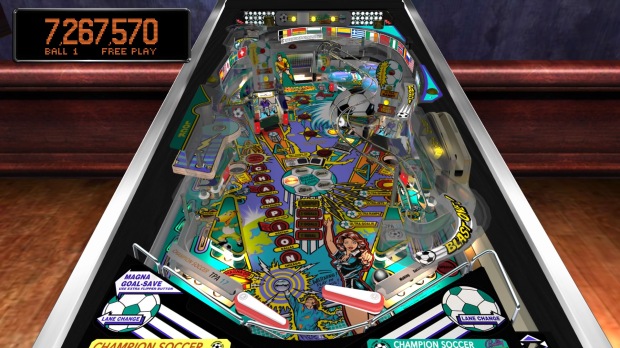
The most remarkable thing about World Cup Soccer? That it actually sold well in the 90s in the United States, when Americans couldn’t give two craps about the sport.
Due to licensing issues, World Cup Soccer is now World Championship Soccer. It’s the same table with the iconic tournament branding replaced with generic tournament branding. If that irks you, you’re too shallow to be reasoned with. This is better than nothing, even if the table is overrated to begin with. Possibly. The single most hungry right outlane in all of Pinball Arcade is here. How hungry? Dad and I played a best-of-three series with ten balls, each of us earning about 4 or so extra balls during the series, and all but ONE non-multiball was lost to the right outlane. That’s absolutely insane! That’s over eighty balls to one! Are you kidding?

The hardest ramp in Pinball Arcade is World Cup’s left ramp. It’s a frustrating, downright maddening ramp. Unlike some tougher ramps, it feels like sometimes even flush hits don’t work. It genuinely feels like clearing it is random and luck-based. I don’t know if this has the correct slope or what, but it doesn’t seem like it should be as inconsistent as it is.
Speaking of multiball, it’s maybe the most frustrating multiball in Pinball Arcade. The compact flipper zone combines with the hungry outlane AND the remarkably weak flippers (they feel like flippers where their power supply needs re-soldering) to make a multiball that is both unfair and unmanageable. World Cup’s multiballs clear each-other out more than any other table. It’s not even close. Now, I fully admit I *suck* at three-ball multiball. My Dad, on the other hand, is a very strong multiball player (he’s put roughly 2,000 hours into Firepower over the years, so duh). But we counted over ten instances (nearly a third of his games) where he’d get a multiball and the balls would clear each-other out in under five seconds. You can restart to a two-ball setup with a hurry-up, but again, a small flipper zone and weak flippers make working it next to impossible.

All credit where it’s due: the goal shot is one of the most clever ideas World Cup has going for it. The cardboard goalie sways back and forth, BUT, if you hit him, the game makes like you’re on defense and just did a good thing. If you make a goal, the game makes like you’re on offense and just did a good thing, with the occasional incentive to hit one or the other specifically. That’s so smart.
I have to believe it’s some kind of transition issue. There’s no way a table with that type of disproportionate a ball-loss ratio would leave the factory. It’s ridiculous. It’s the biggest of many, many problems with Pinball Arcade’s take on John Popadiuk’s first table. It’s one of those “the flippers feel like they don’t have enough punch to them” tables, where getting enough oomph off the flippers to clear ramps feels like it shouldn’t be this hard. Hurricane and World Cup feel like there’s too much slope, and if that were the only problem, it’d be bad enough. But, it’s not the only problem. The table is side-crowded like a valley-style table, only it’s so congested that my Dad coined the term “canyon-style” to describe Popadiuk’s World Cup and Arabian Nights tables. Big, huge sides, teeny, tiny central playfield with a primary target at the rear. It’s a fitting name. The actual scoring mechanics are nice and balanced (Dad couldn’t believe a Popadiuk table had balanced scoring), but World Cup is too tight and not fast enough to be likeable. At least it still has the NBA Jam guy doing commentary. World Cup Soccer is on fire.. because I covered it with gasoline.
#70: Junk Yard
 Standard version Permanently Delisted
Standard version Permanently Delisted
Included in Arcooda Software
Alternative Version: Pinball FX3 Williams Pinball Volume 1
Table Type: Pick ‘n Flick
TABLE FACTS
Designed by Barry Oursler & Dwight Sullivan
Art by Paul Barker, Pat McMahon, Linda “Deal” Doane
Sound by Kurt Goebel
DMD by Adam Rhine & Brian Morris
1996 Williams, 3,013 Units Sold
TRIVIA
–Junk Yard is the final table of Barry Oursler’s career.
-Contains modes from other Williams/Bally tables Creature from the Black Lagoon, Attack from Mars, Addams Family, and Terminator 2.
-References other tables such as Earthshaker, Dr. Dude, Safe Cracker, Who Dunnit, and The Getaway: High Speed II.
-The original design had a stabilizing magnet under the wrecking ball, but this was removed as a cost-cutting measure.
TEAM RANKING: #71 of 96
Oscar’s Rating: The Pits (#93)
Jordi’s Rating: Good (#36)
Angela’s Rating: Bad (#70)
Eala’s Rating: Good (#55)
None of my table reviews for Pinball FX3 get as much controversy as me rating Junk Yard, a universally despised table, as “good.” In fact, I have it near the top of that category. It’s a guilty pleasure, and hey, I’m not a professional player. My Dad despises this table, feeling that the “ball recycling” and limited layout that allow wood-chopping makes Junk Yard a boring slog. HOWEVER, we all agree that the junk collecting aspect and combing two items for modes is very smart. Whether it’s wasted on Junk Yard is a matter of taste. Junk Yard is pinball junk food: no nutrition value and not exact haute cuisine, but tasty nonetheless.
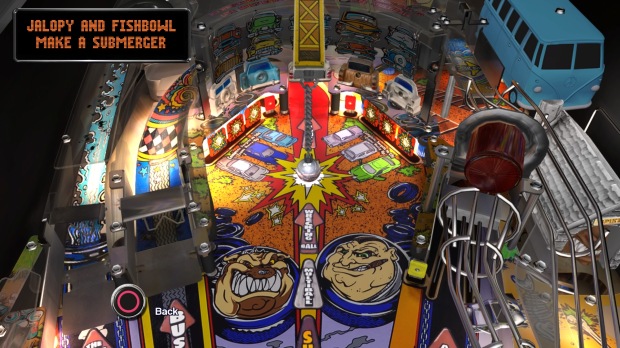
Junk Yard is the final table of Barry Oursler’s career, and it has that same “goodbye, farewell and amen” feel that many tables from this era did. I consider this the beginning of the “Late Arcade Era” for Williams/Bally, where designers seemed to have realized the end was near. Junk Yard tributes many popular past tables. The Mamushka from Addams Family is here, along with Attack from Mars’ video mode and animations from other tables. Nostalgia was already a thing in 1996, apparently. I was seven-years-old, so by that point all I was nostalgic for was getting to sleep all day while people wiped my ass for me.
But, the Pinball Arcade version failed to live up to its potential. During my 10-ball duel with my Dad, I had multiball lit and clearly collected on the shot to activate the mode. The ball went through the hole, the game froze for about ten seconds, then it simply kicked it back to the left flipper. It should have been impossible to not turn the mode on based on how the table’s mechanics work, but it didn’t. Immediately following this, I did make the shot, but the multiball I got was an everybody-out-of-the-pool situation, and all three balls bunched up and drained out in a second. I should have gotten them back, but I had no ball save, which was weird, as Junk Yard is usually generous with it. So the table is unstable, and that didn’t end there. Lots of times the wrecking ball just wouldn’t register despite flush-hits. I shouldn’t be surprised: turning good tables bad is what Pinball Arcade does. Or bad tables worse if you listen to my Dad.
#69: Haunted House
Member of the 6K Club
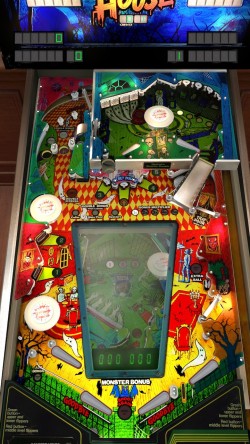 Featured in Gottlieb Table Pack 1 (DLC), The Pinball Arcade: Season Two (PS4 Disc)
Featured in Gottlieb Table Pack 1 (DLC), The Pinball Arcade: Season Two (PS4 Disc)
Included in Arcooda Software
Table Type: Pick ‘n Flick
TABLE FACTS
Designed by John Osborne
Art by Terry Doerzaph
1982 Gottlieb, 6,835 Units Sold
TRIVIA
-First three-level table where all levels are accessible with a single ball.
-Haunted House’s eight flippers was a record at the time of its release.
TEAM RANKING: #42 of 96
Oscar’s Rating: Great (#28)
Jordi’s Rating: Great (#32)
Angela’s Rating: Good (#63)
Eala’s Rating: Good (#36)
My vote for the weirdest and ugliest widebody ever, I don’t get the vaunted status for Haunted House. Black Hole I get. Awesome angles, great inclusion of theme, genuinely thrilling lower-playfield, and some of the most exhilarating shots of its era. Plus, the stakes are kept high by making the basement fatal if you miss a shot, which annoys me when I die on it, but after the game is over I sort of appreciate it does that. Especially when I play Haunted House, where that basement is just a break from the action. There’s more ways to access Haunted House’s signature-element than Black Hole’s, but dying is harder and the stakes are kind of nonexistent.
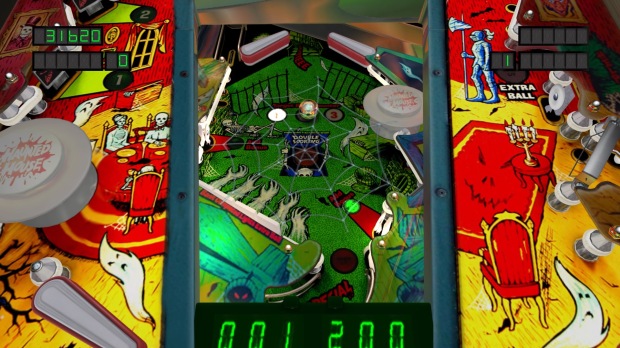
To Haunted House’s credit, people from the era still remember this element fondly, to this day. I think it’s a fail because of the lack of stakes and tension, but at least it fails in an interesting way.
All this in a hodge-podge mess of a table that has some of the most nonsensical angles and target placement in the history of the medium. For some people, that’s part of Haunted House’s charm. To me, the table fails on every single level. It’s ugly and the weird diamond-pattern looks more like a tacky, cheap table cloth than something spooky or paranormal. The cross-pattern upperfield is bland and overly simple. Haunted House was the first “triple-level” table that was played with one single ball, and props to it for ambition, but I’m left with the impression that everything is arranged in a way where they were just trying to get the triple-level concept to work. That came at the price of satisfying flow. For me, the coolest idea is actually the hidden tunnel to access the lowerfield. Great, except there’s already too many ways to access that field. Is Haunted House the most overrated table ever? It’s certainly the most overrated Gottlieb, and probably the most boring of any memorable early 80s pin. OR IS IT? I’d never played a real Haunted House, and while that’s still true, the Arcooda build opened my eyes as to how fun Haunted House can be. Still janky, but fun.
#68: Cactus Jack’s
 Featured in Gottlieb Table Pack 3 (DLC)
Featured in Gottlieb Table Pack 3 (DLC)
Included in Arcooda Software
Table Type: Finesse
TABLE FACTS
Designed by Reinhard Bangerter & Jon Norris
Art by David Moore, Constantino Mitchell & Jeanine Mitchell
Sound by Dave Zabriskie
1991 Gottlieb, 1900 Units Sold
TRIVIA
-Cactus Jack’s plunger topper is shaped like a cactus.
TEAM RANKING: #74 of 96
Oscar’s Rating: Bad (#74)
Jordi’s Rating: Good (#67)
Angela’s Rating: Good (#65)
Eala’s Rating: Good (#56)
“You know what kids these days like? Polka! Make a table about Polka! And lights! Just put a gagillion lights on the table. Make it look like a tacky game show. No logic needed. Just spam the table with those puppies. Oh wait, this is 1991. Do we even have the term ‘spam’ for that or is it still just disgusting canned meat? Can someone Google this? Oh wait..!” Yea, Cactus Jack’s is a visually loud table. But, it’s actually a very rudimentary design that feels like someone took an unreleased late-EM-era pin and added an alpha-numeric display and a mystery prize hole. The prominent bumper placement and wall of simple drop targets really hammers home what a traditionally-minded table Cactus Jack’s is. The main draw, at least in 1991, was presumably that Cactus Jack’s features one of the easiest two-ball multiball activation of its time. That’s be great if there was anything to do with it. But there really isn’t.
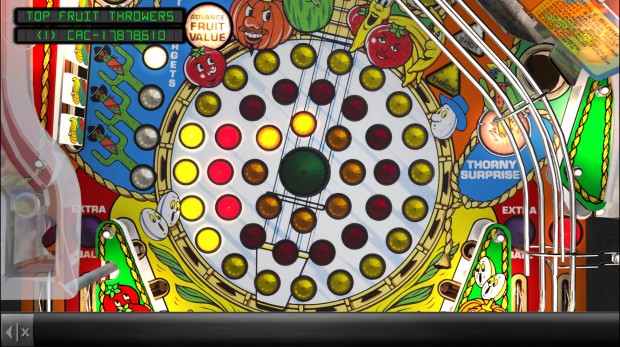
I swear to god it looks like a pricing game on The Price is Right. Speaking of which, how come there’s no Price Is Right pinball table? Get on this, someone!
Cactus Jack’s is a wonderful table to point at if you need to explain why Gottlieb lost so much ground to Bally/Williams in the early 90s. It feels older than 1991, and so behind the times. That they were so excited over a two-ball multiball for such a basic design is kind of shocking. Think about it: just three months after this, the groundbreaking Terminator 2: Judgment Day pinball machine was released by Williams. Three months. Imagine being an arcade goer in 1991 and seeing the latest machines from Gottlieb with their generic, almost soullessly unambitious designs sitting next to the wild and imaginary revolutionary pins Williams was putting out five years earlier, let alone the latest releases. Frankly, it’s amazing Gottlieb lasted until 1996. That Cactus Jack’s is one of their better 1985 – 1991 tables when it’s really just “quite boring and nothing special” speaks volumes to how out of touch they were. Even when they got more inventive (and they did, for it was Gottlieb tables that came up with the modern notion of “modes”), it felt like they were playing follow-the-leader instead of innovating. Cactus Jack’s is just plain boring and too simple. It’s symptomatic of everything wrong with Gottlieb from that era.
#67: Bone Busters Inc.
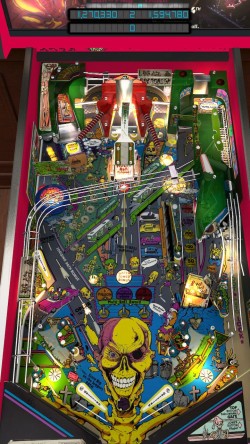 Featured in Gottlieb Table Pack 2 (DLC)
Featured in Gottlieb Table Pack 2 (DLC)
Included in Arcooda Software
Table Type: Finesse
TABLE FACTS
Designed by Ray Tanzer
Art by Constantino Mitchell, Brian R. Johnson, & Jeanine Mitchell
Sound by Dave Zabriskie & Craig Beierwaltes
1989 Gottlieb, 2,000 Units Sold
TRIVIA
-Bone Busters Inc. was conceived as a potential license of the cartoon series The REAL Ghostbusters, but in a way where, if the license was too expensive, it could be a generic Ghostbuster-like.
-The locks were designed to right-the-wrongs of Haunted House and Black Hole, Gottlieb tables that had a reputation for poor build quality and frequent breakdowns. Bone Busters Inc. (along with Lights…Camera…Action!) went through extensive stability tests to assure operators the tables would rarely breakdown, and this was apparently successful.
TEAM RANKING: #81 of 96
Oscar’s Rating: Bad (#81)
Jordi’s Rating: Good (#53)
Angela’s Rating: The Pits (#94)
Eala’s Rating: The Pits (#96)
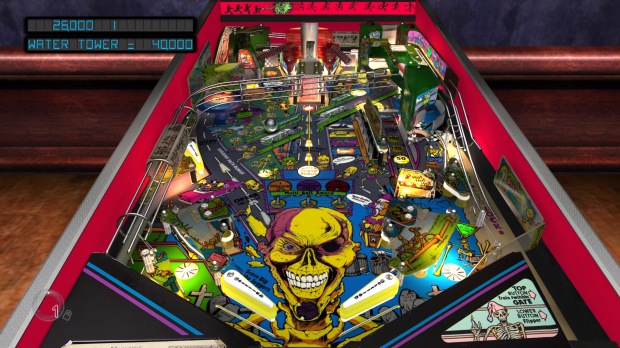
It looks like the animated Crypt Keeper from the weak-sauce children’s Tales from the Crypt cartoon. In reality, it was meant to be based on Ghostbusters (possibly the Real Ghostbusters cartoon).
One of the strangest tables I’ve played. It’s oddly basic and limited in layout, yet is based around a four-ball multiball. Unlike a lot of early big multiball tables, the locks getting there are relatively easy shots. In literally my first game ever of Bone Busters, Inc. I got the four-ball. No sweat. And you can actually get any multiball by simply locking a ball and shooting the insanely easy center target. Hey, quick and easy multiballs are fun. The problem is there’s just not a lot to this table. Plus getting the drop targets on the side is annoying because no camera properly picks up on them. The right orbit is also obscured. Bone Busters is somehow messy and clean. I prefer simple and clean, and it’s hard to let that go.
Really, this is one of those sarcastic “I can’t imagine why Gottlieb struggled” tables. Take a look at the backglass:
It’s seriously Ghostbusters. There’s proton packs and everything. Whether or not this was meant to be based on the mid-late 80s Real Ghostbusters cartoon or not is lost to history, but someone at Gottlieb was out of cares to give. But, that backglass sums up the difference in feel between Gottlieb and their competition at Williams/Bally. Gottlieb tables come across as the generic, dollar-store off-brand pinball. Bone Busters Inc. is still one of the better late 80s tables Gottlieb, at this point cranking out some of the most boring crap in pinball, released during that period. Yikes! I was on the fence about Bone Busters for a while and ultimately I can’t put it with the good tables. Gottlieb tried.. I think.. but it’s a failure. That this was as good as they got (along with Class of 1812) really says how bad of shape they were in. Go figure the Pinball Arcade version would have one of the more accurate-feeling tables in the entire library. It feels wasted on a table this uninspiring.
THE GOOD
#66: Scared Stiff
 Featured in The Pinball Arcade: Season One (PS4 Disc Only)
Featured in The Pinball Arcade: Season One (PS4 Disc Only)
Included in Arcooda Software
Table Type: Finesse
TABLE FACTS
Designed by Dennis Nordman & Mark Weyna
Art by Greg Freres
Sound by Paul Heitsch & Dave Zabriskie
DMD by Adam Rhine & Brian Morris
1996 Midway Manufacturing, 4,028 Units Sold
TRIVIA
-A sequel for Elvira and the Party Monsters was mandated because the original had incredible staying power among arcade/route operators. When Midway would get earnings reports, they were stunned to see Elvira consistently rank in the top twenty earning tables.
-The appearance of “Bad Head” is based on Steve Ritchie’s likeness.
TEAM RANKING: #48 of 96
Oscar’s Rating: Good (#54)
Jordi’s Rating: Good (#44)
Angela’s Rating: Good (#31)
Eala’s Rating: Good (#51)
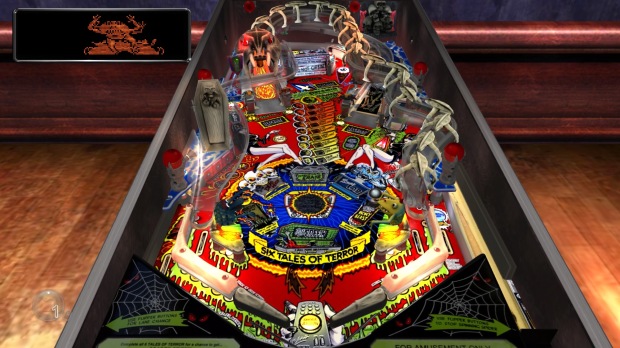
The strangest thing about Scared Stiff is how this feels a LOT more like a Tales from the Crypt table than the actual 1993 Tales from the Crypt table by Data East. That one is a TERRIBLE pinball machine. Everything about this feels like a “let me show you how it’s done” type of deal. Only THIS isn’t that good either.
At first, I had Scared Stiff pegged as a masterpiece. Then, crap started happening. Bad crap. Unfair crap. Downright frustrating crap. Crap that wasn’t supposed to happen. So much of what went wrong during my play session is tied directly to Pinball Arcade’s build. Like, I marooned the ball several times on the spider web shot. One of the key shots in the game. It’s accessible from multiple angles, but it was specifically shots from above where the ball lost momentum before entering the kick hole, causing the ball to get hung up. I could nudge the table, but there’s other instances in Scared Stiff that requires usage of it, which means you’re forced to call an attendant for a hard reset, wait fifteen agonizing seconds, then allow the relatively chaotic and high-risk auto-plunge to serve what by all rights was a ball you had under control. Scared Stiff, at least the Pinball Arcade version, is a straight-up bully of a table that robs you of high scores.
It doesn’t stop with stuck balls, either. The upper VUK, for whatever reason, kicks the ball out to the right. However, the right is crowded and the ball has a significant chance of quickly bouncing off something and ricocheting straight back into the VUK. Once this loop has happened a few times, the VUK throws the ball at high speed in a way that has about a 50/50 chance of banking off the wall and into the outlane in a way that could never be caught even with tilting. In fact, the balls getting clogged up in auto-movement hurts the table to an even bigger degree because so much of Scared Stiff is based around hurry-up shots. Hell, the titular Scared Stiff mode is a sequence of ten hurry up shots. The already slower-than-real life and possibly CPU-rail-assisted ball already handicaps these modes enough without balls getting stuck in a VUK. That’s on the simulation’s engine, not the real table. The ten-shot sequence is one of the all-time cherished series of shots among pinheads, but the digital port spoils the fun. Maybe. I mean, some people might like how you need near-perfection given that one errand shot can float around aimlessly for twenty miserable seconds. Weird people, but some people like having cigarettes put out on their tongues too. Different strokes you know.
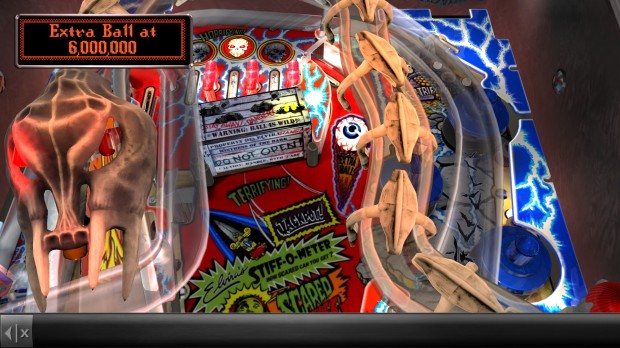
There’s nothing quite like seeing a count-down for one of the most legendary hurry-up modes in all of pinball, only the ball is caught in an infinite VUK loop. It’s like having a bully hold the ball above your head and having you jump at it. “Come you baby, it’s right here! Take it!”
I’m so angry because I suspect that Scared Stiff is a lot better than this port suggests. I know that because, before things started going wrong, I was having so much fun. The final Dennis Nordman valley-style table of the arcade era actually has a bit of a Brian Eddy vibe to it with a big wooden crate as the primary target. The crate has a hugely satisfying two-ball multiball attached to it. But even that glitched out. I had to check the rules, and yea, the box should be bankable every time, but at one point a ball drained out right after the mode was activated. The ball save put it back into play, but suddenly the jackpot was impossible to make, because the crate wouldn’t open. I had the mode, but no way to earn the jackpot from the mode. This glitch apparently exists in authentic Scared Stiff games. Go figure I’d hit the damn crate more times than I ever did in the mode before or after. Stuff like that just kept happening. This is one of the tables I was grateful we did a second go-around of all one-hundred tables for because Scared Stiff is better than I gave it credit for. The scoring is fine-tuned and razor sharp, perhaps second only to Medieval Madness from Bally/Midway. The fault in Scared Stiff is it’s too glitchy and unstable. Such a shame.
#65: Cue Ball Wizard
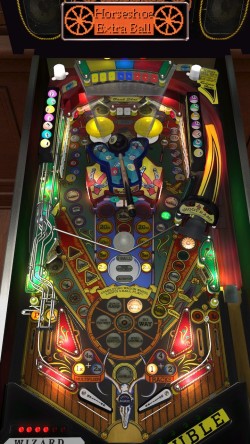 Featured in Gottlieb Table Pack 3, The Pinball Arcade: Season Two (PS4 Disc)
Featured in Gottlieb Table Pack 3, The Pinball Arcade: Season Two (PS4 Disc)
Included in Arcooda Software
Table Type: Pick ‘n Flick
TABLE FACTS
Designed by Jon Norris
Art by David Moore, Constantino Mitchell & Jeanine Mitchell
DMD by Rand Paulin
1992 Gottlieb, 5,700 Units Sold
TRIVIA
-Cue Ball Wizard was the best-selling table produced by Gottlieb after their acquisition by Premier Technology in 1984, and one of only two tables from Premier that sold 5,000 units (Street Fighter II is the other at 5,500).
TEAM RANKING: #83 of 96
Oscar’s Rating: Bad (#88)
Jordi’s Rating: Bad (#90)
Angela’s Rating: Bad (#89)
Eala’s Rating: Bad (#61)

I’ve always wondered why there’s so many pinball tables themed around Pool? I mean.. hypothetically, these would have been in arcades or bowling alleys or taverns. You know, places that.. hello.. probably had pool tables set up. I never understood this fascination with combining the two.
One of the last decent Gottlieb tables.. which is pathetic and sad because Gottlieb lasted another four years after its release.. Cue Ball Wizard is based around a pool gimmick. But, unlike Gottlieb’s more famous and iconic Big Shot, this time the pool concept is more than just a cookie-cutter theme. A real Cue Ball Wizard table uses authentic Brunswick pool balls and a real (albeit modified) cue stick. While every recreated table suffers from Curse of Digital Pinball™, gimmicky tables like Cue Ball Wizard suffer most because the charm and novelty of real world billiards elements is lost in the translation. You’re not actually striking a real cue ball with a real pinball. The Curse is especially damning here because Cue Ball Wizard has nothing else going for it. So much of the playfield’s real estate is taken up by the gimmick that there’s no room left for a nuanced, complex table. Of any worthwhile table that’s been digitally converted to modern platforms, Cue Ball Wizard’s journey to video games is the most tragic, because it’s still fun to play, so imagine how much it hurts for the loss of charm.
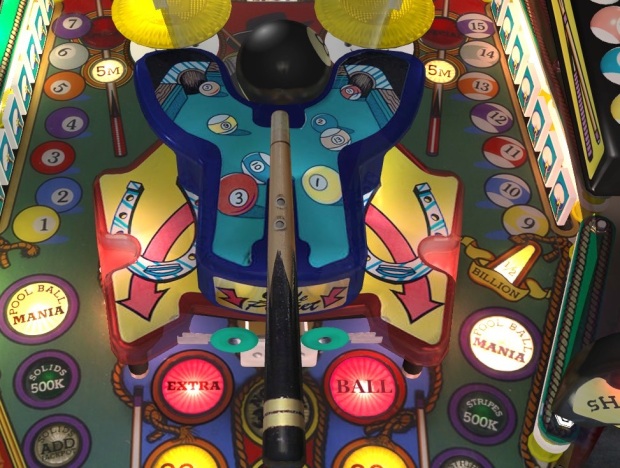
I’ve always suspected that they wanted this area to take up less space than it ended up doing. I don’t know. There’s something about the angles around the cue that feel like they were compromises. Cue Ball Wizard is a post-Superpin design. Maybe this was pitched as a Gottlieb Superpin and they said “sounds great! Do it in a standard body!” regardless of how reasonable that demand is. I’m going to guess that’s how it went down. It’s such a Gottlieb thing to do.
Of course, the table has balance issues up the wazoo. The primary shot isn’t the cue ball shot, but rather a slightly off-angle ramp shot that triggers the start of the game’s modes. From there, shots rely on timing the cue ball shot or a pair of upper orbit shots that are identical semi-blind angles. Scoring in Cue Ball Wizard comes down mastering a series of relatively simple shots and dealing with frequent hurry-up modes and the crowded lower-field/mid-field. The upper shots are extremely bumper-heavy, and combined with the overly-sensitive slingshots, make hurry-up modes provide players with as little as only one chance (in twenty seconds!) to make the called-for shot. Throw in outlanes that are extremely hungry (especially the left one) and risk/reward balance issues, and the worst video modes EVER and it’s sort of a miracle Cue Ball Wizard is fun at all. But, hand over heart, it kind of is. That’s really the Curse of Digital Pinball™ in a nutshell. A genuinely fun table rendered barely good at all in the conversion to digital.
#64: Class of 1812
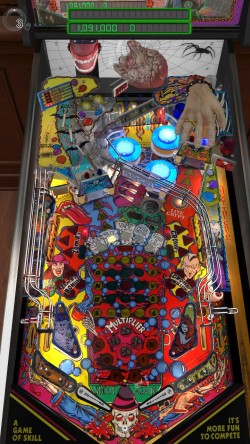 Featured in Gottlieb Table Pack 3 (DLC), The Pinball Arcade: Season Two (PS4 Disc)
Featured in Gottlieb Table Pack 3 (DLC), The Pinball Arcade: Season Two (PS4 Disc)
Included in Arcooda Software
Table Type: Sharpshooter
TABLE FACTS
Designed by Ray Tanzer & Joe Kaminkow
Art by David Moore, Constantino Mitchell, & Jeanine Mitchell
1991 Gottlieb, 1,668 Units Sold
TRIVIA
-The character on the center of the backglass is modeled after Lon Cheney’s appearance from the 1927 lost silent film London After Midnight.
-Meanwhile, the vampire on the backglass bears a striking resemblance to Al Lewis’ Grandpa Munster.
TEAM RANKING: #49 of 96
Oscar’s Rating: Good (#63)
Jordi’s Rating: Great (#24)
Angela’s Rating: Good (#51)
Eala’s Rating: Good (#47)
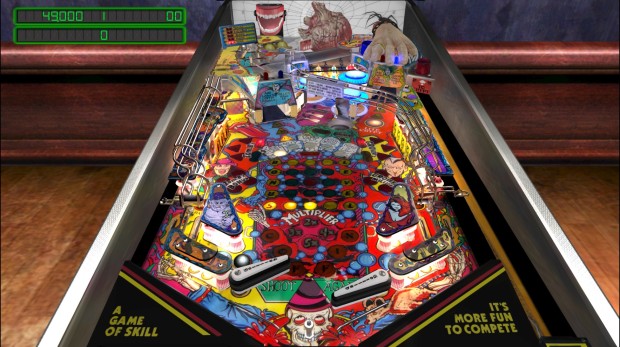
I honestly didn’t know the famous music piece this table is based on was called 1812 Overture. Da na na na nuh nuh nuh (clasp). I’m not a music person. Don’t laugh.
Class of 1812 grew on me. Like a tumor. This is a bad table and I know it, but I ended up liking it. 1812 centers around million-point shots or hurry-up shots with drop targets. The million point shot is insanely simple and laughably imbalanced: get a multiball (and like many Gottlieb tables from this era, two-ball multiball is absurdly easy to activate), then shoot the left ramp. BANG: million points. You can repeat this as many times as you can keep multiball alive. There’s no point in doing anything else. The hurry up shots are a little more aggravating: each of the left and right side and walls have four drop targets. If you knock all four down on a side, a hurry up mode begins, where you can score millions of points by hitting a designated target on that wall within the time limit. The angles are high-risk and even successful shots can lead directly to insta-draining. Also, the really weird thing is how the left side is a scoring countdown, while the right side is just always a two million point shot. Weird. The entire game is based around these three scoring mechanics, so you really just sort of spend entire sessions with Class of 1812 repeating the same three sequences over and over.
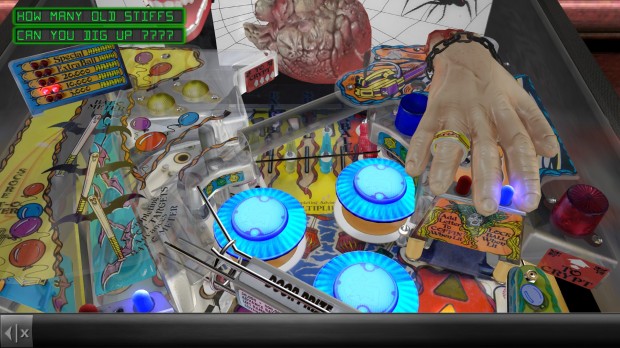
Possibly the last time Gottlieb was ahead of the curve. If only they’d invested in better programming for their scoring systems in the solid state era.
And, I sort of liked it. I even chuckled at the cynically desperate rapping monsters theme. I can’t explain why Monster Bash using the Universal Monsters to form a rock band works but rapping Dracula doesn’t. You’ll just have to take my word for it: Class of 1812 feels like something an old person would make to appeal to a 90s child. Or, perhaps like if the Simpsons had a joke table on the show that made fun of pandering to children. Because that’s what Class of 1812 feels like. Much like Cactus Jack’s, it just feels so grossly out-of-touch. I take back what I said about being ahead of the curve. Do you know why Monster Bash works? Because it KNOWS it’s silly. Class of 1812 thinks it’s cool. It’s not. It is, however, decent.
#63: The Machine: Bride of Pin•Bot
Member of the 8K Club
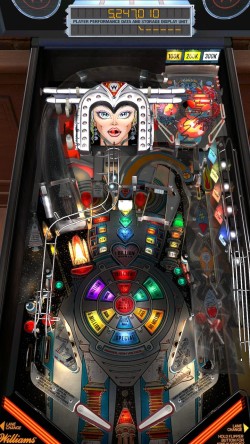 Featured in The Pinball Arcade: Season One (PS4 Disc Only)
Featured in The Pinball Arcade: Season One (PS4 Disc Only)
Included in Arcooda Software
Table Type: Finesse
TABLE FACTS
Designed by John Trudeau & Python Anghelo
Art by John Youssi, Python Anghelo
Sound by Jon Hey, Rich Karstens, and Dan “TOASTY!” Forden
1991 Williams, 8,100 Units Sold
TRIVIA
-Singer/Songwriter Stephanie Rogers provides the voice of The Bride.
-The Machine: Bride of Pin•Bot was the final alpha-numeric table by Williams.
TEAM RANKING: #46 of 96
Oscar’s Rating: Good (#51)
Jordi’s Rating: Great (#17)
Angela’s Rating: Good (#42)
Eala’s Rating: Bad (#68)
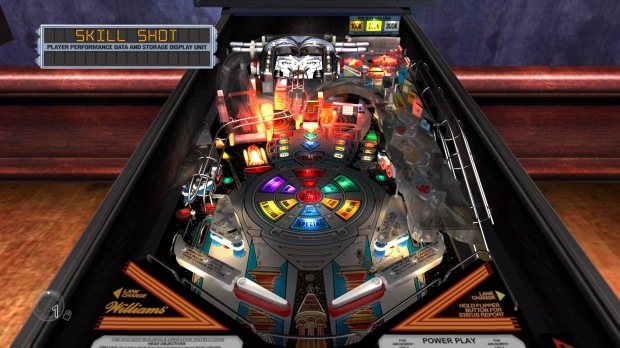
It’s sad that John Trudeau’s name is attached to this, because Python Anghelo was a much beloved figure and this was his proudest work. Which I don’t get at all. I mean, it ain’t all that.
The Machine: Bride of Pin•Bot has the worst random element in the history of pinball. The most game-breaking. The most absurd. The most unbalanced. It feels like a giant middle finger to the era where pinball was outlawed for being too random and thus potentially a form of gambling. Of course, I’m talking about the infamous Billion Point Shot. A ridiculous idea that should never have made it past the drawing board stage. In order to activate it, you have to complete the full transformation sequence of the titular Bride, then bank both balls on the ramp shot which spins the large wheel, which has a 1 in 6 chance of lighting a billion-point shot, which gives you a hurry up to shoot the Heart Ramp for a billion points. It’s totally governed by random chance. Mind you, the biggest point value in the large wheel is 50,000,000, or 5% of the total value of that shot, and it’s still total random chance to get THAT.
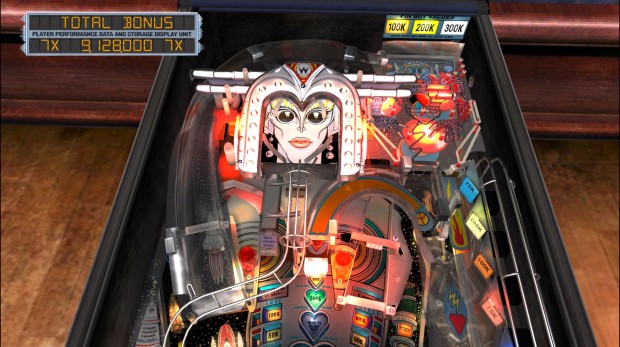
You’ll want to turn off the “event camera” because if you bank one ball while the other drains out, your turn will end when the camera gets stuck on the face and you won’t be able to see the action. How these glitches, which are super easy to trigger, made it through for so long (Bride was a Season 1 table) is beyond me.
I think Bride of Pin*Bot is the ultimate “should have been better than it actually is” table, and is sadly one of the most overrated tables ever made. I get no pleasure saying that. I know this was the legendary Python Anghelo’s baby. But, that the most skilled of play is still left up to the whims of chance to such a degree takes the glory of doing well. That’s a shame, because Bride should be a table that tests the might of pinheads. A crowded playfield where clanked shots are likely to drain out, you need to quick reflexes and precision to excel. But you also need a lot of luck to post high scores, and historic luck to post record scores. Combine all that with one of the all-time legendary plungers not translating well to the digital format and you have a table that can’t hope to live up to its legend. What a shame.
#62: Harley Davidson: Third Edition
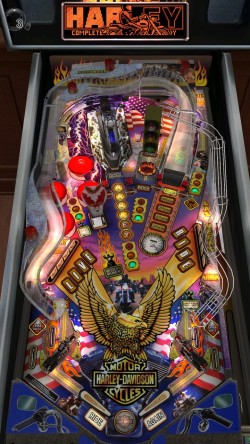 Featured in Stern Table Pack 2 (DLC), Stern Pinball Arcade Add on Pack 2 (DLC/Physical) The Pinball Arcade: Season One (PS4 Disc)
Featured in Stern Table Pack 2 (DLC), Stern Pinball Arcade Add on Pack 2 (DLC/Physical) The Pinball Arcade: Season One (PS4 Disc)
Not Included in Arcooda Software
Table Type: Kinetic
TABLE FACTS
Designed by John Borg & Lonnie D. Ropp
Art by Jerry Vanderstelt & Kevin O’Connor
Sound by Kyle Johnson
DMD by Kurt Andersen
2004 Stern, 300 Units Sold (Third Edition)
TRIVIA
-The video mode for Harley Davidson was recycled from the 1994 Data East table Guns ‘n Roses. The same mode with altered graphics was also used for Sega’s Star Wars Trilogy table.
-The third run of Harley Davidson tables, which Pinball Arcade’s build is based on, included chrome trim and some new art.
-The bike used for the multiball lock is a 2001 FLSTS Heritage Springe model.
TEAM RANKING: #44 of 96
Oscar’s Rating: Good (#46)
Jordi’s Rating: Great (#22)
Angela’s Rating: Good (#52)
Eala’s Rating: Good (#53)
I hope you like four-ball multiball, because that’s really all Harley Davidson: Third Edition has going for it. Well, that and one hurry-up shot that’s the same shot every time that you have to constantly repeat in order to get a “location badge.” Harley Davidson started life as a Sega Pinball table and eventually morphed into a decent but unspectacular series of re-released pins that represents everything wrong with Stern’s early existence. They made bland tables with a toy stuck somewhere in the upper playfield and relied to heavily on multiball to drive the score. Harley Davidson takes abuse of that concept to absurd levels. In my Dad and I’s first game against each other, we combined for 13 four-ball multiballs between us. It wasn’t uncommon to finish one and immediately begin the next.

The Harley itself is such a broad, open toy shot that it’s hard to miss. It’s such a stupid easy layout that they probably had to make the rails spoon-feed the outlanes just to make it reasonably profitable.
And that’s the problem with Harley: all it does is that four-ball over and over again. The only thing that changes is what the jackpot target is during those balls. The layout is minimalist and it really stinks of trying to make a pinball table to appeal to non-pinheads. I guess the assumption must have been that Harley owners would never play pinball, or wouldn’t be smart enough to understand complex rules, or something else that sounds insulting because it kind of is. Actually, the most shocking thing is that Harley still manages to be fun, but almost despite itself. The bumpers spoon-feed the outlanes. Rounds of it came down to whether or not the ball survived the initial launch off the auto plunger. If you could keep the ball alive for, say, fifteen seconds, you’ll be good to go and probably play at least two to three multiball modes during that ball. The biggest is Harley commits is that it feels like surviving the bumpers is pure luck, and pinball should never be that married to Lady Luck. Unless, you know, you’re the actual 1954 Gottlieb EM Lady Luck. Or the 1968 Williams EM Lady Luck. Or the 1986 Bally Solid State Lady Luck. You know, what, there’s a LOT of Lady Lucks in pinball.
#61: Cyclone
Member of the 9K Club
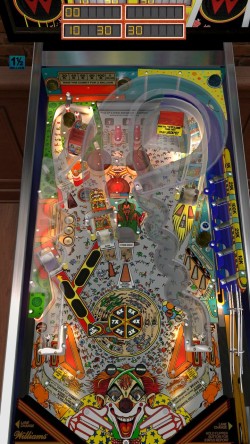 Standard version Permanently Delisted
Standard version Permanently Delisted
Included in Arcooda Software
Table Type: Pick ‘n Flick
TABLE FACTS
Designed by Barry Oursler
Art by Python Anghelo
Sound by Chris Granner
1988 Williams, 9,408 Units Sold
TRIVIA
-The carnival barker is voiced by Mark Ritchie.
-Python Anghelo was a fan of the Saturday Night Live sketch Coneheads and included a family of Coneheads on the art work, along with Mr. T’s likeness.
-Ronald & Nancy Reagan famously appear on the backglass.
TEAM RANKING: #75 of 96
Oscar’s Rating: Good (#72)
Jordi’s Rating: Good (#66)
Angela’s Rating: Good (#59)
Eala’s Rating: Bad (#78)
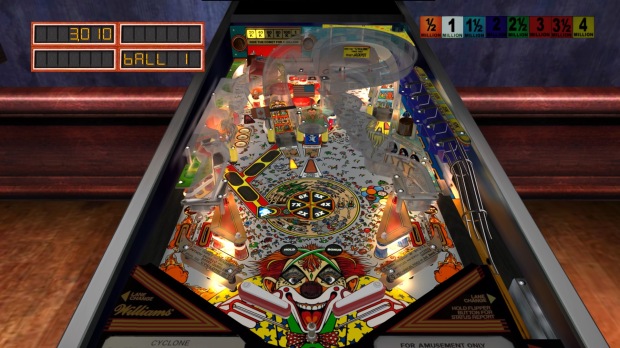
I have much love for Python Anghelo but I’m not a fan of his work on Cyclone or Hurricane. They look like they’re supposed to be tables based on Where’s Waldo?
Cyclone is the Jay Leno of pinball: bland but slightly entertaining. The second of Barry Oursler’s roller coaster trilogy (some call it the Coney Island Trilogy since that’s what he literally had in mind developing them), Cyclone is probably the most simple alpha-numeric table Williams ever did. Every single shot lays on simple, straight angles, with all the big bonuses being based around ability to repeat those shots. There’s multiball, so really, the game is simply about drilling these primary shots into your muscle memory. For many of my older readers, this seems to have been the first (and in many cases, only) pinball table they clocked. While the clown near the drain is nightmare fuel, the Comet and Cyclone shots are fun and memorable, the Ferris Wheel toy is cute, and really this is just a solid, unoffensive table. It even has a first-of-its-kind mystery wheel on the backglass. Nifty. Sure, this is vanilla now, but I imagine in 1988 it must have been.. well, still bland. I mean, come on, some pretty amazing, imaginative innovations had already happened by that point.
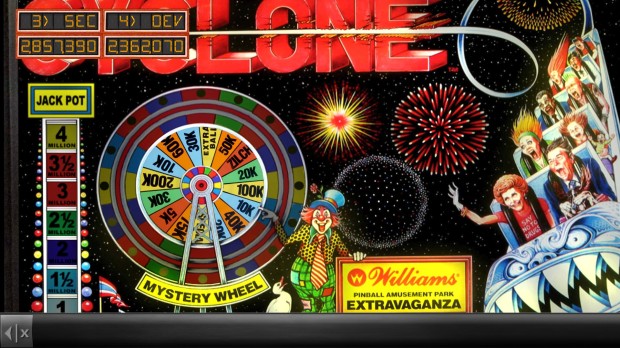
Yep, that’s Ronald & Nancy Reagan. Weird, because I never heard either were pinballers. Jimmy Carter was, and in fact, he owns one of those home-edition Fireball tables. No joke.
So what’s the issue? Well, there’s just no meat on these bones to get experienced silverballers excited. I think the best value for Cyclone is as an introductory table to newcomers of the sport. The angles are all common enough in pinball (especially the Ferris Wheel, Comet, and Cyclone shots) that it’s an excellent way to build muscle memory that can be applied to more advanced pins. Plus, since the game relies so heavily on repeating shots, Cyclone is a great way to practice getting into combo rhythms, or getting into shooting cycles. I’m not saying Cyclone is a baby’s table, but it’s too simple to excite. I’m curious how professionals find it. I know they hate Hurricane, but I mean, Hurricane has a lot more going for it. People complain that Hurricane is a wood chopping table? No, THIS is a wood chopping table. Also, I figure I should note that, while this is VERY close to the real table (one of the closest in Pinball Arcade, in fact), the skill shot is nearly impossible because of the lack of a plunger, and in fact, the only standard goal we didn’t earn for 2 of the three versions of Cyclone we have. When I attempted to use the nudge to assist it, the ball flew clean off the table and had to respawn. I did more than once. Since it happens off a serve, it doesn’t really matter, but I just thought it was funny. Having said that, imagine having a key scoring element tied to a plunger, and then having the absolute worst way of controlling a plunger AND unstable, inaccurate plunger physics to go with it. It hurts a lot of Pinball Arcade tables, but it really hurts Cyclone.
#60: Wipe Out
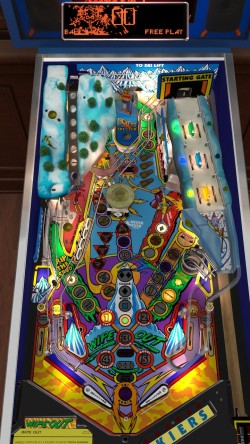 Featured in Gottlieb Table Pack 2 (DLC)
Featured in Gottlieb Table Pack 2 (DLC)
Not Included in Arcooda Software
Table Type: Pick ‘n Flick
TABLE FACTS
Designed by Ray Tanzer
Art by David Moore, Constantino Mitchell, & Jeanine Mitchell
Sound by Craig Beierwaltes
Music by Duane Decker
DMD by Rand Paulin
1993 Gottlieb, 2,150 Units Sold
TRIVIA
-An unrelated table with the name “Wipe-Out” is claimed by its creator to be the first solid state table. The electronic components of it were developed by missile manufacturer Numax Electronics of Hauppauge and used an Intel 8080 microprocessor. Its status as the first Solid State table is disputed.
TEAM RANKING: #76 of 96
Oscar’s Rating: Good (#62)
Jordi’s Rating: Good (#74)
Angela’s Rating: Bad (#85)
Eala’s Rating: Good (#57)
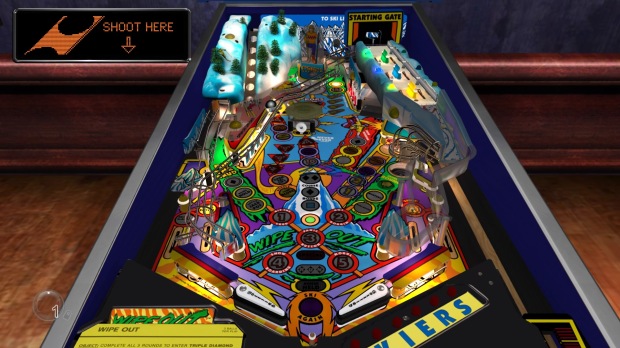
Yes, it’s based on the song “Wipe Out” which I always assumed was about surfing, not skiing. But, as reader/professional wrestler Massive Q said, “I mean, it’s only a surf rock song, as played by a band called The Surfaris, originally intended as a B Side to Surfer Joe and opens with the sound of a cracking surfboard. You can’t assume the artist’s intent from that!”
Wipe Out, released five months after Tee’d Off, is probably the last unambiguously good Gottlieb table. Or, at the very least, the last that’s been converted digitally, depending on how you feel about Stargate, which SHOULD have been Farsight’s #1 priority for translation. It also feels like it maximizes the skiing theme. The table signature is a unique tilting mini-table “slalom hill” that feels more like a carnival game. Using the flippers, you take the ball down a series of gates. It’s fun and it works well after getting the hang of it. The problem is it’s worth too much. That’s the issue with Gottlieb from this era in general: absolutely no shred of balance. The mystery hole makes success come down to random chance, while other modes score a fraction of the slalom hill. Plus, like Tee’d Off, it has a janky flow that feels like the slope is off.
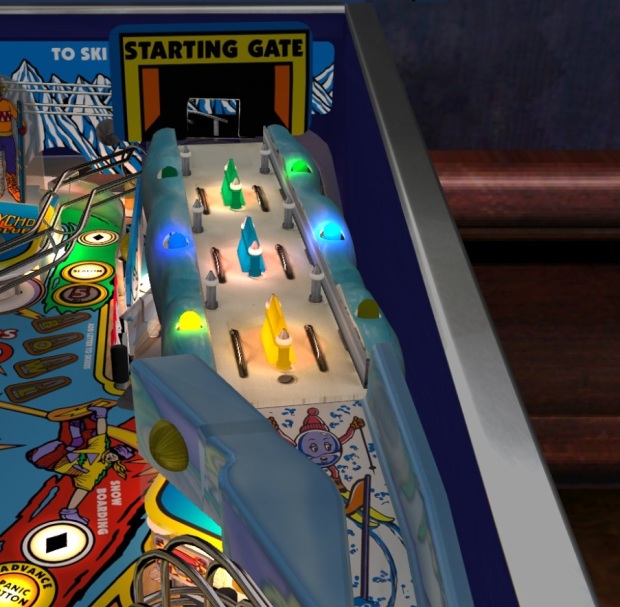
I think the notion that Gottlieb was out of ideas by the DMD era is a complete lie. Wipe Out’s ski run is one of THE great elements of the 1990s and even has fine-tuned scoring balance. Which is completely rendered pointless by the Mystery Score B.S. from Gottlieb System 3. Still, this shot alone is pretty much enough to elevate an otherwise okay table above many of its contemporaries. It’s a damn good shot.
But, Wipe Out can be fun in small doses. There’s some great target placement featured here. If this had modern-style balanced-scoring, this would be a great table, maybe even a masterpiece. Even the gimmicky ski lift is fun. Really, I’ve dunked on Ray Tanzer a few times in this feature, but I think he was saddled with a no-win situation. Gottlieb clearly had no clue what they were doing by this point, put their designers on nightmare deadlines, and asked them to compete with the greatest lineup of talent the medium had ever seen with the people working under the Midway umbrella. That includes he who shall not be named, a guy Gottlieb had and lost. Stuff like Wipe Out and Tee’d Off are a reminder that Gottlieb did have guys who were up to the task in the right circumstances. With a better operating system and more time to balance scoring.. and better use of licensing.. who knows? Maybe Gottlieb could have competed.
#59: Bram Stoker’s Dracula
Member of the 6K Club
Standard version Permanently Delisted
 Included in Arcooda Software
Included in Arcooda Software
Table Type: Finesse
TABLE FACTS
Designed by Barry Oursler & Mark Sprenger
Art by Mark Sprenger
Sound by Paul Heitsch
DMD by Scott Slomiany
1993 Williams, 6,801 Units Sold
TRIVIA
-Dracula was originally going to be based on the movie Alien 3.
-When the Alien license fell-through, Barry Oursler worked with artist Mark Sprenger to revamp the prototype to work with the Bram Stoker’s Dracula license. As a result, this is a rare table where the lead artist is also credited as a co-designer.
-Features “Lightning Flippers”, the 1/8th inch smaller flippers that were mandated by European route operators.
TEAM RANKING: #34 of 96
Oscar’s Rating: Great (#23)
Jordi’s Rating: Great (#19)
Angela’s Rating: Great (#23)
Eala’s Rating: Bad (#67)
THE PINBALL CHICK CERTIFIED EXCELLENT TABLE
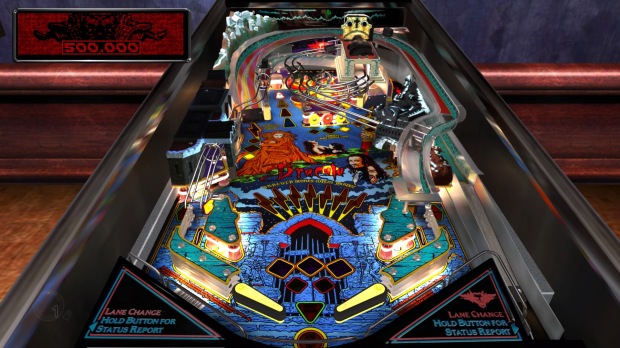
One of my favorite pinball stories relates to this table. One day after Williams closed, a private collector who owned this table got a package in the mail with an unsigned letter. The package contained one-of-a-kind glow in the dark plastic pieces for this table. The letter said “you were the only person on a website who registered ownership of BSD.” Someone at Williams gave someone a prototype piece of this table for the sake of thanking a fan and preservation of their medium. Come on, people! The guys and gals who worked on these were just cool. Well, most of them.
Bram Stoker’s Dracula is a potential all-timer brought down by its own brutal difficulty. It’s easy to see why this was a favorite of operators and sold over 6,000 units. It’s probably the most memorable table that nobody really talks about in iconic terms today. Of course, being tied to a movie that’s, at best, a frustrating pretentious and extraordinarily poorly-cast piece of crap doesn’t help anything to be remembered. Actually, it’s amusing to me that such a decent table is made out of such a horrible movie, but that’s pinball for you. Hell, Johnny Mnemonic is considered a classic table for reasons other than “wait, someone made a Johnny Mnemonic pinball machine?” But, while Dracula is striking to look at and has some unforgettable moments, the thrill of them is lost thanks to demoralizing design. Dracula had me screaming, and had me crying, and had me feeling embarrassed, and ultimately took every semblance of joy from my very being. Hell, maybe this really is just like watching the movie.
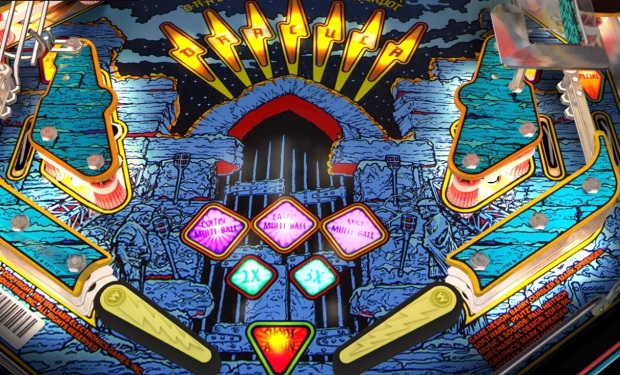
Yes, the slingshots are angled with concave outlane entrances to literally feed the outlanes. That’s why I don’t get why they had to go all-out with the lightning flippers. You mean to tell me this table wasn’t hard enough without them? That’s like telling a stuntman “you know, I don’t think this is hard enough just being on fire. Someone kick him in the balls before igniting him! He should be in a lot of pain already. Use steel-toed boots.”
For what it’s worth, all the problems in Dracula seem arcade-authentic from videos of the real table I’ve seen. The ball runs way too fast. On a finesse table clearly not designed with speed in mind. The infamous lightning flippers probably contribute in part to that, making trapping too difficult to perform and free-catches a true rarity. The cluttered right side of the playfield features multiple brickable shots that all become high-risk, making precision shooting a do-or-die situation (which is, frankly, why my Dad liked this table more than I did). No DMD table in Pinball Arcade has shorter ball times. The slingshots are among the most consistently lethal I’ve ever played with on a digital table. I played a stretch of twenty rounds of Dracula and marked down all the ways I lost the balls. I only earned seven total extra balls in that entire run (and all from the mystery hole on my third ball of bad games, making me think it rigs the game if you’re dying too fast), meaning I played 67 total balls. Of those 67, I lost 36 (53.73%) to the slingshots, 19 (28.35%) to the drain and 12 (17.91%) to the outlanes without slingshot assistance. That doesn’t include multiballs, most of which I lost off the slings too.

Bram Stoker’s Dracula nearly defies the Curse of Digital Pinball by being as spooky and unnerving digitally as it is in real life. It’s a table that doesn’t entirely lose its charm, and that’s a true rarity among digital conversions. Also, it actually wasn’t the first table that used a magnet to guide a ball across the playfield. Of all people, Sega beat them to that.. in 1973!
Look, I’m not naive. I know with percentages like those, it means Bram Stoker’s Dracula is doing its job. It’s killing players quick to earn more money. And, unlike a lot of brutally hard tables, I think players are inclined to keep trying at this one rather than give up and look for a more forgiving experience. Especially when Bram Stoker has so many insane “you have to see it to believe it” moments. Like having a ball just sort of float eerily from one side of the board to the other, and if you can successfully dislodge it from its path, you get a valuable multiball. It’s spooky while also being one of the most genuinely exciting shots of the DMD era. Of course, the ensuing multiball is horribly overpowered and destroys the scoring balance. There’s multiple highly-rewarding, balance-shattering multiball modes, along with some tremendously satisfying orbits. Hell, I can forgive the imbalanced scoring BECAUSE it’s so difficult. That’s when you know a table is truly tough: when it’s so hard that it makes perfect logical sense to toss out balanced scoring. Underneath the contemptible difficulty is one of the greatest tables ever made. If I ever get a real BSD table, I’d be tempted to deaden the rings on the slingshots and replace the lightning flippers and see how much fun I could have. That’s the story for Dracula for me: at the end of the day, I like it, but I want to like it more than I do and I can’t because it’s such a bastard.
#58: El Dorado
Honorary Member of the 12K Club
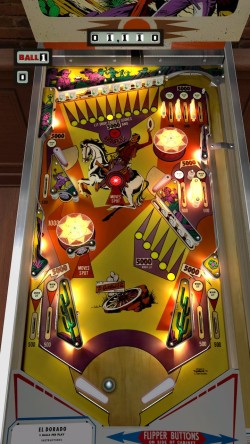 Featured in Gottlieb EM Pack (DLC)
Featured in Gottlieb EM Pack (DLC)
Included in Arcooda Software
Table Type: Sharpshooter
TABLE FACTS
Designed by Ed Krynski
Art by Gordon Morison
1975 Gottlieb, 2,875 Units Sold (17,258 for all EM variants with the same playfield)
TRIVIA
-El Dorado’s design was kept moderately simple so as to allow another 1975 table he was co-designing with Wayne Neyens, Spirit of 76, to have a higher budget and more complex rules. Spirit of 76 (and its two-player variant, Pioneer) went on to sell over 13,000 units.
TEAM RANKING: #60 of 96
Oscar’s Rating: Great (#35)
Jordi’s Rating: Good (#73)
Angela’s Rating: Bad (#79)
Eala’s Rating: Good (#46)
A table so nifty that the Pinball Arcade sells it twice. This is the original electro-mechanical made in 1975. This table was considered so good that, when the solid-state era arrived, it was remade as El Dorado: City of Gold in 1984, which you’ll be reading about in about a minute. In fact, this exact same layout was so popular that Gottlieb re-themed it multiple times. Gold Strike, Target Alpha, Solar City, Lucky Strike, and Canada Dry: all the same layout with different artwork. Of course, if you’re going to copy one table over and over, it’d probably be a table by Krynski.
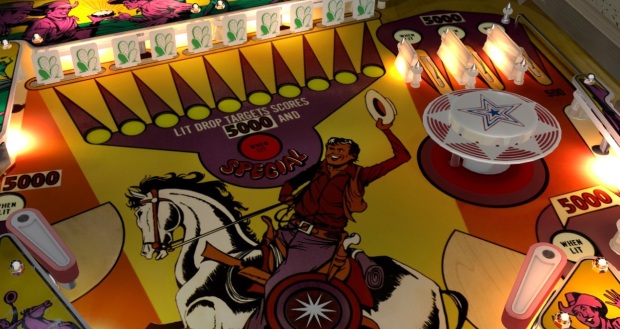
On the original EM table, the far-right target is frustrating to hit. In the reworked version, the bottom flippers have access to it. Purists will say “stick with the 1975 version”, but there’s valuable target practice in both the electro-mechanical and solid state versions. It won’t be exciting, but El Dorado is good for learning simple angles and off-angles.
And yes, I’m fully aware Bally did it too with machines such as Eight Ball. Zaccaria did it a few times. What can I say? El Dorado is a fun table, but it’s not so amazing that it could be reskinned six times. I also found it weird is that I initially preferred the EM version to the 1984 solid state remake, but the more time I put into the remake, the more I realized it absolutely slew the original. El Dorado is a very basic table: there’s drop targets. You shoot them. That’s really it. A real El Dorado table is a bit more rewarding, assuming you’re paying real money to play it. It’s based around winning replays. You can turn a single credit into nine. Imagine that! Of course, that excitement is completely lost in the digital translation. There’s achievements tied to the replay system, but once you’ve won those, they’re sort of pointless. All that’s left is a decent, simple layout that’s good but not great.

It looks like a 50s table and plays like a late-era EM table. Gottlieb, everyone!
It’s also worth noting that the replay system was used for gambling in some places. You could “cash out” your replays earned. In places where this was illegal, clone tables existed with a feature called Add-a-Ball that simply gave players extra balls instead of replays. The “Gold Strike” version is the Add-a-Ball clone of El Dorado. Either way, replays have little functionality here beyond one-time-only achievements. Why didn’t Farsight include the Add-a-Ball versions? It makes no sense, yo!
#57: El Dorado: City of Gold
 Featured in Gottlieb Table Pack 2 (DLC), The Pinball Arcade: Season Two (PS4 Disc)
Featured in Gottlieb Table Pack 2 (DLC), The Pinball Arcade: Season Two (PS4 Disc)
Included in Arcooda Software
Table Type: Sharpshooter
TABLE FACTS
Designed by Ed Krynski
Art by Larry Day
1984 Gottlieb, 905 Units Sold
TRIVIA
-El Dorado: City of Gold is the final table by legendary designer Ed Krynski.
-This was the last pinball machine produced by Mylstar, which was the trade name Coca-Cola used for Gottlieb during their year-long ownership of them.
TEAM RANKING: #58 of 96
Oscar’s Rating: Great (#34)
Jordi’s Rating: Good (#59)
Angela’s Rating: Good (#64)
Eala’s Rating: Bad (#75)
The final table from the legendary Ed Krynski, but sadly, it’s just a solid-state remake of his 1975 electro-mechanical El Dorado that you just read about. El Dorado was a fine table, but it wasn’t Krynski’s finest work by any means. I know City of Gold is one of the more popular tables among pinheads, but I think Jacks Open was a better EM table and if a spot on the roster could only go to one EM remake, Jacks to Open would have been my choice. Hell, I hope Zen Studios can get the Gottlieb license so that Krynski’s Amazing Spider-Man and Incredible Hulk tables could be adapted. There’s so much of the man’s later work I’d rather have than this. Which is not to say the game plays exactly the same. If you’re going to remake an electro-mechanical table, this is the way to do it. The scoring is actually more balanced here, with greater emphasis on hitting the lit-targets than the EM had.
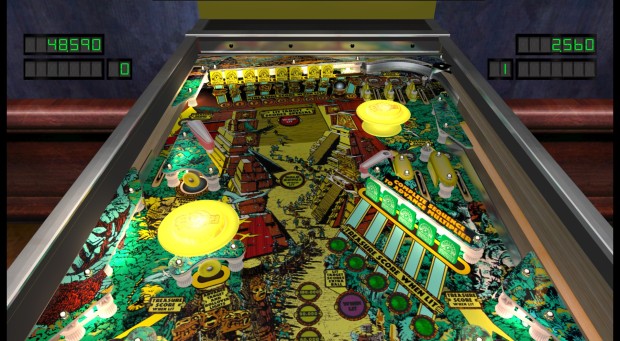
It’s just NOT an exciting layout. And it’s not a matter of layouts weren’t exciting back in the day. Hogwash. Tables like Centigrade 37 (still to come) provide genuine thrills. This feels more like a firing range. Hell, it should have had a gun theme.
Along with the new balanced scoring, you have a significantly smaller drain and one of the most effective drain posts in Pinball Arcade. Additionally, the upper-left flipper has been elongated to allow more precision shooting of the right-most upper-targets. It gives the table a sense of flow that wasn’t there before. El Dorado is a sharp-shooter table, and this is just plain better than it was before. The issue is, this wasn’t exactly an exciting table to begin with, and its riddled with problems. Unlike a lot of Krynski works, the subtle art of the nudge is less effective with the roll-overs. The left and right side (especially the left side) rolling channels spoon-feed the outlanes, and nudging is less effective because of how they’re oriented at an angle. If you get the hang of it, you can own this table, but it’s meant to be fun, and it’s merely okay. The two rows of targets are just boringly placed. This feels like it’s a table that only works to challenge elite snipers, and if you’re not that (and I’m not), you’re better off with other sharp-shooter tables that offer more angles and a better learning experience for beginners or those with a casual interest in pinball.
#56: Wild Card
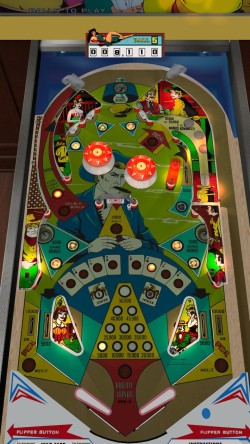 Permanently Delisted
Permanently Delisted
Not Included in Arcooda Software
Table Type: Sharpshooter-Boardwalk
TABLE FACTS
Designed by Steve Kordek (Probably)
Art by Christian Marche
1977 Williams, 901 Units Sold
TRIVIA
-Wild Card is the final Williams table that was exclusively Electro-Mechanical.
TEAM RANKING: #66 of 96
Oscar’s Rating: Good (#67)
Jordi’s Rating: Good (#72)
Angela’s Rating: Good (#67)
Eala’s Rating: Good (#52)

It would seem bland, sterile art work wasn’t limited to Gottlieb in the late EM era. They really phoned in the look of this one, except a cute visual gag on the backglass.
The Internet Pinball Database, which is like the Internet Move Database only with less careers that began on casting couches, at one point had Steve Kordek listed as the lead designer of Wild Card. But, in the late 90s, Mr. Kordek (then in his 80s.. dude was 100 when he died) provided historians with a list of all the tables he did and Wild Card wasn’t on the list. So IPDB no longer lists him as Wild Card’s designer. Dad and I are going with the Occam’s Razor solution here: that an old man who was legendarily prolific simply forgot to list one of his last tables. Thus, we’re listing Steve Kordek as the lead designer of Wild Card until someone shows us proof otherwise.

You have to LOL at the chick on the right signaling to the guy on the left. Man, pinball art is awesome sometimes.
Wild Card, being the last EM from Williams.. plus being over forty-years-old.. can’t help but feel like a relic. But the gameplay is actually really satisfying. Here, the object is to shoot simple targets to light playing cards. Doing so advances the bonuses and raises the value of the half-horseshoe kicker, which is far too over-powered once fully charged-up. It’s also close to being a blind-angle that requires either a vertical straight shot off the right flipper (and that’s a near-impossible shot) or a lot of assistance from the bumpers. The problem is, once ejected, it can get caught in a loop of bouncing off the bumpers and going right back down the horseshoe. Such lucky bounces were the deciding factor in 3 of 7 games Dad and I played against each-other. It’s a shame the placement of the bumpers factors in so much, because the remaining angles are well situated to be a great practice table for toe shots and primary angles alike. The two bonus kickholes are very tricky toe-shots, but they also are placed along angles that you’ll be using for tons of different tables. If you want to strip out all the bullcrap and practice the toughest straight-angles in pinball, this is the table for you.

Wild Card’s virtue and curse is this half-horseshoe kicker. The issue is the bumpers have a tendency to kick it back into the hole. You can nudge to help, but really, super high scores will benefit greatly from getting the ball trapped in a lucky cycle of the ball bouncing back and forth between the lane the bumpers while the cowboy modeled after Kirk Douglas watches in contempt. If you have the special lit, you’re scoring 100,000 points a kick.
Wild Card is fun, but I’m also happy this era died out. Tables like Wild Card played into the notion that pinball is always random and luck-based. I’m absolutely puzzled as to why Farsight chose this over so many higher prospect late-era tables. Wild Card doesn’t even have the distinction of being the real final Williams EM machine, but rather just the last one that was only an EM. As far as better prospects go, wide-body Big Deal is a significantly better table, a better representation of Steve Kordek’s ability, and a pseudo-wide-body that would flow well with Pinball Arcade’s physics. Or, Kordek’s most famous table: Space Mission, an 11K Club member that’s actually an honorary 12K Club member if you include the 4,000+ units it sold as a two-player machine called Space Odyssey. Wild Card is a mediocre choice. Worthy of preservation? Sure. But it suffers the same fate that Flight 2000 does: you can’t escape the niggling feeling that it’s taking the place of a more worthy table.
#55: Fathom
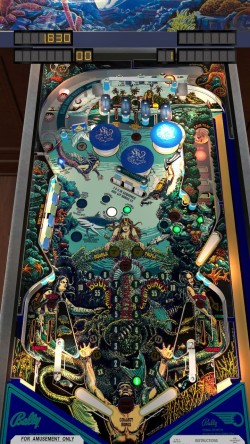 Permanently Delisted
Permanently Delisted
Not Included in Arcooda Software
Table Type: Sharpshooter
TABLE FACTS
Designed by Ward Pemberton
Art by Greg Freres
1981 Bally, 3,500 Units Sold
TABLE FACTS
-The original name for the table was “Deep Threat” but this was vetoed by Bally’s management. “Barracuda” was also rejected by management.
TEAM RANKING: #54 of 96
Oscar’s Rating: Great (#29)
Jordi’s Rating: Great (#30)
Angela’s Rating: Bad (#73)
Eala’s Rating: Bad (#77)
I don’t think Fathom is as pretty as a lot of people do, and really, I don’t get the love for this one. It’s fine, but it’s hardly special. The twist with the outlanes being inlanes and the inlanes being outlanes is clever and always screwed with my muscle memory. My father and I both had instances where we resigned ourselves to dead balls that were, in fact, alive. Have you ever just watched a live ball drain because your brain stubbornly refuses to commit to memory the rules of a different table? It’s quite embarrassing, and we both did it. A lot. We kept doing it eight hours later. Granted, there’s a chance of saving a dead ball in the true outlane with a nudge, something that a traditional outlane can’t do once the ball has cleared the entrance for it. But it takes a lot of practice to get the timing down just to have a slim chance of survival.

Doctor Who’s W-H-O is perhaps the most legendary sequence shot included in Pinball Arcade, but Fathom’s 1-2-3 EXTRA BALL sequence is, for my money, the most thrilling to hit. Damn shame that the table flows so poorly otherwise.
Besides that weirdness, Fathom is really a pretty average, run-of-the-mill 80s table that’s elevated by a memorably distinct art direction and several in-line target areas. The target placement is overly safe and dull, though, so it doesn’t really help Fathom that much. The table runs relatively fast, but what table from this era of Bally didn’t? Really, Fathom has one signature shot, though I concede it’s a good one: the 1-2-3 targets leading to an extra ball. It’s a memorable, thrilling sequence. I just wish it did more. Frankly, the inny-outty thing I found more annoying than anything. Fathom is so messy and so inelegant, and not really all that memorable outside the glorious extra-ball sequence. Like TX-Sector, it frustrates me to have a great element stand alone on a bland table. Every single seemingly decent shot here has something decidedly off about it. Something that prevents it from having the smooth flow that the target placement should allow. And I don’t think it’s on a bad engine for Pinball Arcade. It suffers from silverball constipation. No, Fathom is, as I said above, fine. Strange, because it should be better.
#54: Flight 2000
Member of the 6K Club
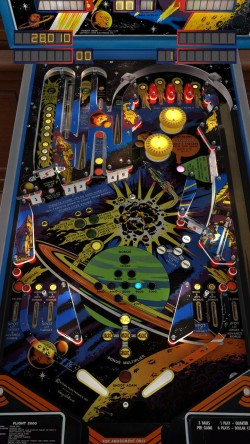 Featured in The Pinball Arcade: Season Two (PS4 Disc Only)
Featured in The Pinball Arcade: Season Two (PS4 Disc Only)
Not included in Arcooda Software
Table Type: Sharpshooter
TABLE FACTS
Designed by Harry Williams
Art by Gerry Simkus & Doug Watson
1980 Stern, 6,301 Units Sold
TRIVIA
-First talking table by Stern.
-Following the closure of Stern Electronics, Gary Stern began to sell conversion kits for Bally/Williams tables that would turn those tables into a new machine called Gamatron. Gamatron was essentially a standard-body remake of Flight 2000. Tables outfitted with the Gamatron kit are rare and valuable today.
TEAM RANKING: #36 of 96
Oscar’s Rating: Great (#19)
Jordi’s Rating: Great (#28)
Angela’s Rating: Good (#35)
Eala’s Rating: Good (#59)

The surprise winner in a fan poll for which classic Stern table to be adapted, Flight 2000 beat out Seawitch (1980), Catacomb (1981), Iron Maiden (1982), and the one that crushed my father when he found out it lost: 1979’s Meteor. My Dad has much love for Flight 2000, putting it in his Top 20 (and also he destroyed me 5 games to 20 when we dueled at it during the first play-through), but he’s beside himself that it was chosen over Meteor, a table that could have been in his top five.
Flight 2000 is by Harry “Yes, THAT Williams” Williams, and I think the name must be why it won a poll over more high-prospect tables. Which is not to say that fans chose wrong. I don’t know. The only table in the lot I’ve ever played is Meteor, and I’m fairly sure I like Flight 2000 more than I would have liked Meteor. But let’s keep it real: Flight 2000 is an insanely hard table with tons of blind angles. I don’t think I’ve ever given a table with as many such angles a “great” rating before. Flight 2000’s objective is simple enough: hit every roll-over target once (those are the blind angles), hit all the drop targets (including five that you must do in sequential order), lock all the balls, hit an ignition button in an extremely tight squeeze, and then lock a final ball to trigger a simple multiball. Okay, so there’s really nothing simple about it. But, in those rare instances where I did manage to complete all those steps, the multiball felt like such a well earned bonus that I didn’t care how much I sucked at keeping the balls in play by that point.
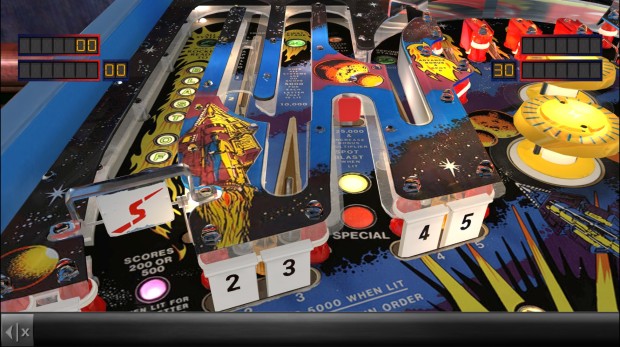
One of the strangest multiball locks, though it’s visually satisfying when you connect on shots. It’s nearly the perfect marriage of a sequence shot and a lock, but it’s also not quiet a lock as they exist today.
Flight 2000 is solid as far as early solid states go. Fun layout, clean shot. I just feel that it’s a bit grindy, and that the blind-angle rollovers and drop targets are so central to success. Also, the table is quite glitchy on the PS4 disc. Get this: my first score was barely over 200,000, but the game credited me with scoring 750,000 points and checked off that goal. The hell? By the way, this happened on all three platforms we played: PlayStation 4, Nintendo Switch, and Steam. Scored under 750K, got the 750K goal checked off regardless. Wonderful. Or even worse: more than once, I marooned a ball near the top of the chute. I could have nudged the ball off easily, BUT, I wanted to take advantage of the situation and respawn to the chute. Because I have NO shame (just wait until you see what I did playing Mustang). Well, when I did this, it actually reset the marooned live ball AND the two balls I’d banked for multiball. Into the chute. This wasn’t a multiball, mind you. Once a single ball went past the drain, it was game over for me. I was able to recreate this glitch too. This is so common and so easy to trigger that it makes me wonder if Farsight was disappointed Flight 2000 won the fan poll (you’ll note that none of the other tables in the poll ever were ported to Pinball Arcade) and phoned it in. I don’t know what the story is. All I know is I think Flight 2000 is good but not great.
#53: Last Action Hero
 Featured in Stern Table Pack 2 (DLC), Stern Pinball Arcade Add-On Pack 2 (DLC/Physical)
Featured in Stern Table Pack 2 (DLC), Stern Pinball Arcade Add-On Pack 2 (DLC/Physical)
Not included in Arcooda Software
Table Type: Finesse-Kinetic
TABLE FACTS
Designed by Tim Seckel, Joe Kaminkow, Ed Cebula, & John Borg
Art by Markus Rothkranz
Sound by Brian Schmidt
DMD by Jack Liddon & Kurt Andersen
1993 Data East, 5,505 Units Sold
Alterations: Music from AC/DC, Megadeth, and Queensryche have been removed.
TRIVIA
-Last Action Hero was the highest-or-second-highest budgeted pinball production (Gottlieb’s 1995 Stargate might be the highest).
-Arnold Schwarzenegger personally requested his head be drawn larger on the backglass.
TEAM RANKING: #69 of 96
Oscar’s Rating: Good (#61)
Jordi’s Rating: Good (#61)
Angela’s Rating: Bad (#76)
Eala’s Rating: Bad (#69)

“Guys, this is the one. The one that’ll put Data East Pinball on the map! Of course it’s worth overpaying the license for! Of course it’s worth spending an entire yearly budget on! It’s Arnold! It’s not like the movie is going to flop or anything!”
Believe it or not, THIS is the highest-or-second-highest-budgeted non-holographic pinball table ever made. It’s also a cynical, soulless, follow-the-leader table that has no direction and feels like a grab bag of ideas from more successful tables. Incredibly, almost unbelievably, it’s actually fun, but with more problems than an algebra textbook. To understand just how shameless Last Action Hero is, you have to understand the circumstances of how it came to be. 1992 had been the biggest year arcades had seen in a decade. Midway introduced three new tables into the 12K club: Fish Tales, The Getaway, High Speed II, and Addams Family, which became the best selling table ever.
But, Data East came out of nowhere with two tables that sold 10,000 units. Star Wars was a huge hit for them and, frankly, I’m surprised it only did 10,400. But, the big surprise was Lethal Weapon 3 moving only 50 units fewer than Star Wars to become the 30th highest-selling table of all-time. Nobody saw that coming. It was a coming-out party for them, and they just so happened to have secured (IE: over-paid for) the rights to 1993’s biggest movies: Jurassic Park and Last Action Hero. There was buzz that one of these tables could become the only table to cross 25,000 units, especially when Data East revealed how ambitious they were. Throwing a huge manufacturing budget at them, Last Action Hero would have a complex moving crane toy, six ball multiball, and a magnetic playfield. Terminator 2 was 1991’s best selling table and single-handedly smoothed over the transition to the DMD era, and here was Arnold’s next pinball machine. How could it lose?
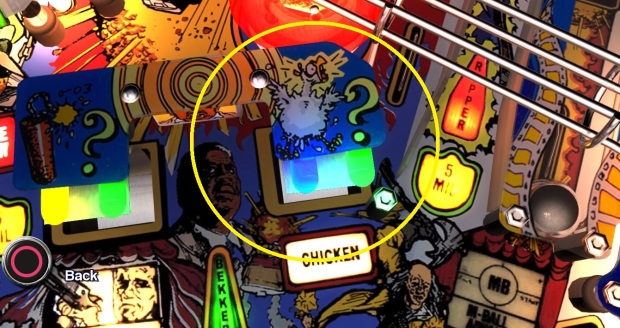
Here’s one way. Last Action Hero has two prominent dead zones that can cause balls to be marooned. One behind the right VUK, and one up by the crane. In digital tables, this isn’t a problem. A little nudge dislodges it, but if it doesn’t work, you can have the program magically teleport the ball back to the chute for a hard reset. That doesn’t work in real life, and Last Action Hero had players having to request arcade workers dislodge the ball or ask for a refund. If it’s on a route, you’re just screwed. To have two such locations on a single table is a massive failure of testing. On the plus side, I think the artist knew it. The question mark and chicken screaming in agony is telling.
Then the movie bombed badly and the table wore an OUT OF ORDER sign more than probably any other 1993 table, which is saying something. Data East intended 1993 to cement its reputation, and it did. And thus the company that was the darling of arcade operators in 1992 was being sold to Sega for pennies on the dollar by 1994. Yea, Data East was hurting badly in all areas by then, and they were mismanaged to begin with (they were overpaying for licenses for years, like their insanely ugly and borderline unplayable Ninja Turtles table, and I heard they even bought rights they never used, like Total Recall or Die Hard). Last Action Hero was rushed through development, had FOUR lead designers and feels like the product of four contrary voices. Plus, the table was clearly untested. There’s two prominent dead zones, behind the right VUK and next to the crane, that any amount of testing should have revealed. The mechanics were prone to failure. The crane toy’s motor would burn out. This was a table that shipped with gremlins, and word spread quickly. Operators nicknamed it “In-Traction Hero” or “No Action. Zero.” 5,500 units sounds like a lot, until you remember that was less than half their conservative estimate. Bizarre as this sounds, Data East and some prominent industry experts genuinely expected Last Action Hero to beat Addams Family. They even thought it could potentially do in the neighborhood of Street Fighter II (the video game, not the mediocre Gottlieb pinball machine) numbers if all the stars aligned correctly. Yikes!!
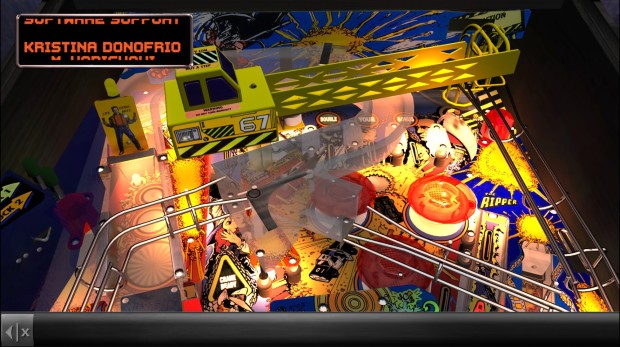
The crane LOOKS cool, but functionally it’s just a ball lock. A diverter would have been cheaper and easier to repair if it broke down. It’s amazing nobody at Data East said “do we NEED the crane?” Terminator 2 had the cyborg head ball lock, a facade toy that probably cost a buck or two and was a non-risk for breaking down.
This is peak 90 – 94 Data East. A good but frustrating mess of other people’s ideas shoved onto a playfield with little rhyme or reason. Modes are activated by a central, slightly off-angle scoop that you light by shooting the crane ramp, and they can be intense. An add-a-ball multiball that you get by shooting capture balls (there’s one above the left outlane and one in the upper-right mid-field) can be insane if you can keep it going, while the famous six-ball is muted by the frustrating magnetic field. Farsight didn’t quite get the hang of the magnets, though I genuinely think they’re more accurate here than they were with Addams Family. But really, the magnetic field feels more like it’s trying to copy Addams rather than top it. The skillshot is lifted directly from Terminator 2 (and the real table even has a gun). It feels like someone took all their favorite ingredients from various fast food joints and threw them into one unholy abomination that you bite into, and it tastes.. surprisingly not disgusting, but you’re a little ashamed for having done it in the first place. Decent angles that lead to underwhelming targets. Fun, but not as good as it could have been. I like Last Action Hero, but it’s the pinball definition of “trying too hard.”
#52: Cactus Canyon
 Featured in The Pinball Arcade: Season Two (PS4 Disc Only)
Featured in The Pinball Arcade: Season Two (PS4 Disc Only)
Included in Arcooda Software
Table Type: Finesse
TABLE FACTS
Designed by Tom Kopera & Matt Coriale
Art by Josh Youssi
Sound by Rob Berry
DMD by Adam Rhine & Jim Raff
1998 Midway Manufacturing, 903 Units Sold
TRIVIA
-Cactus Canyon was the final table ever released under the Bally brand, and the final standard table released by Midway.
-Designers were told to wrap-it-up in the middle of development to send Cactus Canyon into manufacturing, so that facilities could be devoted fully towards Pinball 2000.
-Manufacturing was halted after 900 units were completed to make way for Pinball 2000.
TEAM RANKING: #51 of 96
Oscar’s Rating: Good (#50)
Jordi’s Rating: Good (#58)
Angela’s Rating: Good (#50)
Eala’s Rating: Good (#44)
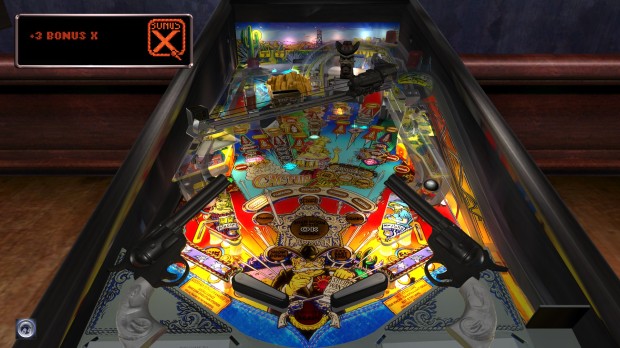
When it comes to gaming.. really, any form of gaming.. historic “lasts” rarely are impressive. In fact, you’re often lucky if they’re decent. Cactus Canyon is better than decent. Really, it’s at this point in the review that you can consider every “GOOD” table to be better than tolerable.
Cactus Canyon, which sounds more like a Mario Kart level, is the last ever traditional Williams/Bally pinball machine. And, like so many once giants, they went out with a whimper instead of a bang. I’m not saying Cactus Canyon is a bad table. It’s not. It’s just very underwhelming. Among the things that frustrated me: a very shallow flipper radius that makes trapping insanely hard (oddly enough, on the Pinball Arcade engine, a shallow radius also makes free catches too easy). Toe shots are flimsy and significantly more high risk than they should be. It’s not just the Pinball Arcade version either. A real Cactus Canyon has issues with flush-hits being overly weak. It’s just not a well-designed flipper system. I think we can attribute this to Cactus Canyon being led by two guys who aren’t really pinball designers so much as they are pinball technicians. Tom Kopera had never led the design of a table up to this point, and since Cactus Canyon, has only one other time directed a table (2011’s Rolling Stones pin by Stern). Meanwhile, Matt Coriale only contributed to the design and concept of one table prior to Cactus Canyon: 1995’s No Fear. No Fear is a mess of a table that has too many ideas. It had four lead designers, which is a great way to assure no one vision is fully realized.
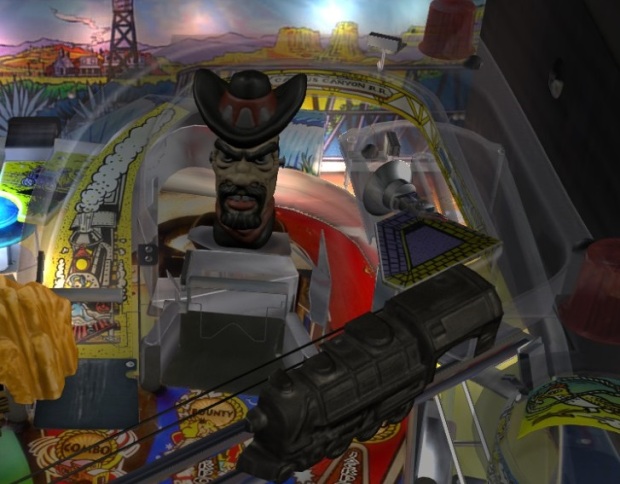
Early prototypes, and even some early production copies, included a test mode for saloon doors that would have been placed in front of the giant desperado head, a feature that was cut early-on. Remember, this table wasn’t even done when Midway’s bosses came in and said “wrap-it up, boys. We’re going to make gimmicky, mediocre holographic tables that cost tons more to arcade operators without drawing more money, will be prone to breaking, have heating issues, and will stink to high heaven of obvious desperation and telegraph to the whole world that we know our time has passed. I’m telling you, it’s going to be BIG!”
So, I guess you can say Cactus Canyon feels like it should: a middling-concept table by two guys without the design chops to carry it through. The flipper radius is brutal and wrecks the angles of the table, but only someone with a true passion for pinball design would understand why compromising your table’s primary angles with such an absurd design choice is a horrible idea. The generic gunfighter theme works, which is a fricken miracle given the circumstances. I especially liked the quick-draw gunfight modes (easily the highlight of Cactus Canyon) and the combo shooting. These timed “gunfighter” drop targets make for some of the most interesting and exciting hurry-ups in the late arcade era. But, that’s really all Cactus Canyon has going for it besides a series of utterly generic multiballs. Yes, some of them mix with the gunfighter targets, but only the wizard feels thrilling. The rest are just generic “shoot the lit orbit” ones. Like the designers knew what made Medieval Madness well-received and popular, but didn’t understand how to implement it into Cactus Canyon. It’s the lack of stacking, really. Still, fun table, even if it’s underdeveloped.

Cactus Canyon is arguably the easiest of the DMD era Williams tables. The five modes that set up the High Noon wizard mode aren’t out of reach and really come down to simple grinding. Despite being arguably pinball’s most mass-produced unfinished prototype (depending on how you look at Gottlieb’s Stargate, where it was sent into production despite having no stress-testing or location testing done because Gottlieb wanted to recoup the inflated budget of it back ASAP), this is actually the perfect newcomer table.
But, it would seem Williams had little faith in Cactus Canyon. Production of it was shut down before the game was completed. The ROM used is actually incomplete and.. this is completely unconfirmed.. might still have modes built into it that you can’t possibly access because the toys for them were either unfinished or removed before manufacturing began. Specifically, a saloon door toy and accompanying mode are alleged to have been included but are nowhere to be seen. Only 903 tables were made and sold to operators before Midway told arcade owners “don’t waste your time with this, HAVE WE GOT SOMETHING FOR YOU COMING UP!” That something was the holographic Pinball 2000. On the day production was shut down for Cactus Canyon, Midway basically told the very people they needed to buy this that better stuff was coming. I can’t imagine why they didn’t last that long into the 2000s with marketing instincts like that. When that flopped and they cancelled Pat Lawlor’s Magic Blocks, and then a couple weeks later, they also cancelled a table based on Playboy (designer unknown but likely also a Lawlor project), the writing was on the wall. Midway placed their money on Revenge from Mars (sequel to the mega-popular Attack from Mars) and a table based on Star Wars: Episode One. They couldn’t hope to recoup the production costs, and that was the end of the long legacy of Williams and Bally. It died at the hands of two gimmicky, mediocre tables. The last traditional table was Cactus Canyon, and it wasn’t even really finished. What a crappy way to end the 70+ year legacy of the biggest giant in pinball. No happy endings here, kiddies, except that their final “real” table still manages to be fun despite the circumstances.
#51: Xenon
Member of the 11K Club
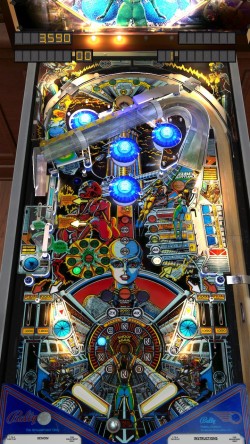 Standard version Permanently Delisted
Standard version Permanently Delisted
Included in Arcooda Software
Table Type: Sharpshooter
TABLE FACTS
Designed by Greg Kmiec
Art by Paul Faris
Sound by Suzanne Ciani
1980 Bally, 11,000 Units Sold
TRIVIA
-Five-time Grammy nominee Suzanne Ciani composed the music and provided the voice for Xenon. She had never played a game of pinball before being hired, but immediately showed aptitude as a game designer. Deciding that it would be more exciting if the music and sound effects sped-up as the game went along, she created one of the most iconic sound designs in the sport’s history. For her work, she was inducted into the Pinball Hall of Fame in 2013.
-The design of Xenon’s sound and music was featured on the PBS news magazine Omni: The New Frontier in 1981, which you can watch here.
-Xenon was the first Bally solid-state table with multiball. Originally, it was to be a single-ball table, but Bally management realized the industry was heading towards more frenetic gameplay and, in a single day, the multiball mechansim was added to the tube.
TEAM RANKING: #47 of 96
Oscar’s Rating: Great (#32)
Jordi’s Rating: Bad (#77)
Angela’s Rating: Good (#58)
Eala’s Rating: Great (#26)
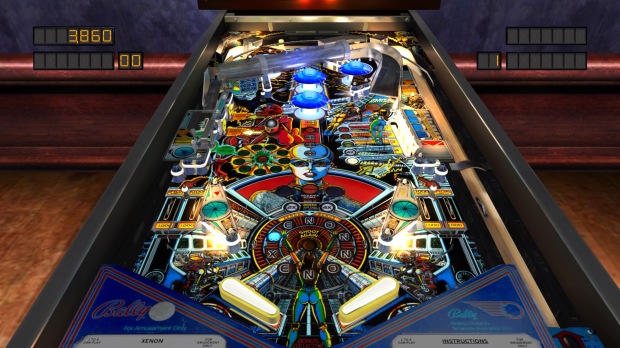
Xenon is a pinball table where you make a robot lady moan and orgasm as you smack her bumpers with your balls while trying to fill her tube. Yea. It was a different time.
I felt horrible that I hated Greg Kmiec’s Paragon, because Mr. Kmiec is one of THE legends of the sport, with a whopping SEVEN tables that moved over 10,000 units (three of which are in the 12K Club). Not only that, but this is a man who looked at apprenticing a new generation of designers as an investment in the future of the medium. We all owe a lot to Greg Kmiec, and so I’m happy I got to play at least one table of his I enjoyed. Yea, Xenon is pretty weird. It’s strange to make a cybernetic robo-lady moan orgasmically just from the ball hitting the most wide-open targets. I can’t explain why I don’t find that as sexist as Whoa Nellie, and I really can’t say enough how little cares I give about the whole topic to begin with. To me, Xenon is the prototypical early 80s table, and that’s what makes it stand out.
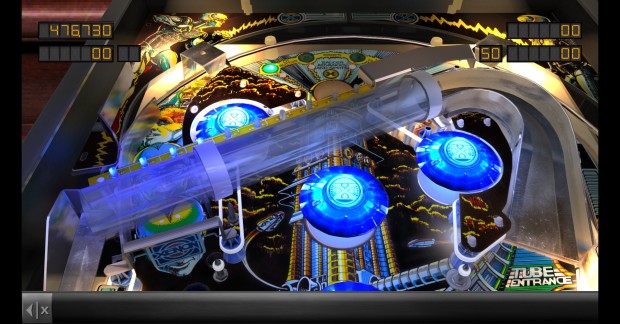
We need more tube ramps in pinball. I wonder why these didn’t catch on more? Oh right, the massive visibility issues.
Here’s your early 80s pinball formula: have a vast, wide-open table. Include traditional angles in the targets (in the case of Xenon, all the targets are on the sides). Have one primary target (in this case, a saucer on the top that feels similar to Big Shot’s, only higher up on the board). Finish the table by adding one experimental element. In the case of Xenon, it’s a ramp with a tube that acts as a lock for two-ball multiball. It’s very basic and probably boring if you’re not really into unobstructed target shooting. Jordi’s not a fan. I enjoy it just fine. Dad likes it a lot. Our ratings reflect such. There’s really not a lot else to say about Xenon. What little the table has is fine-tuned and well done. A great table to practice two-ball juggling on. I’d say I want a sequel, but that’s pretty much what Bride of Pin•Bot was. Creepy? Yeah. Could you get away with this today in 2020? Oh no. No no no no no. But, I’m happy it’s here.
#50: AC/DC
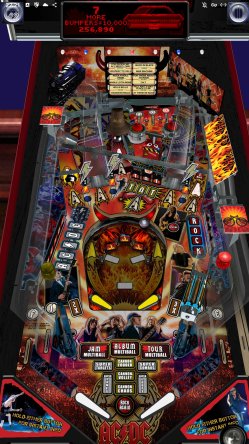 Featured in Stern Pinball Arcade (Physical Release Only, Delisted Digitally)
Featured in Stern Pinball Arcade (Physical Release Only, Delisted Digitally)
Not included in Arcooda Software
Table Type: Finesse
TABLE FACTS
Designed by Steve Ritchie
Sound by David Thiel
DMD by Mark Galvez & Tom Kyzivat
2012 Stern, Unknown Sales
TRIVIA
-Sound designer David Thiel created the iconic sounds of Q*Bert.
-Designer Steve Ritchie also provides the voice of the announcer, and frequently quotes some of his past tables. “Fire at will” was taken from Terminator 2. “You are champion” is from Black Knight 2000. “Do it again!” is from No Fear: Dangerous Sports.
TEAM RANKING: #37 of 96
Oscar’s Rating: Good (#44)
Jordi’s Rating: Great (#20)
Angela’s Rating: Good (#33)
Eala’s Rating: Masterpiece (#6)
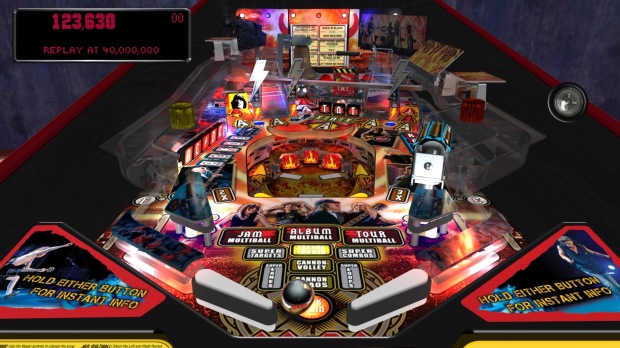
This is a table that makes me wish Zen Studios could make a deal with Stern. The physics are weird. Not horrible. Just weird.
The first table alphabetically was actually the final table of this project that we played. We didn’t exactly save the best for last. Don’t get me wrong: AC/DC isn’t bad. It’s just pretty much like any other Stern-era table: just alright. Daddy and Jordi disagreed, and Dad even initially had this as “great”, though I can’t forgive a table with this hungry of outlanes. And the outlanes are hardly the only problem. AC/DC has an under-field, and it’s absolutely pathetic. It’s just plain sad that Steve Ritchie, all-time legend of the media, couldn’t top Black Hole’s under-field 31 years later. It runs too fast, has unreliable target accuracy, and mixes as well with the overall table well as oil and water. It’s exhibit 34B on why Stern tables just kinda were there from 2001 to around 2018. Too gimmicky. Even the Maestro himself, Steve Ritchie, fell victim to this trend.

AC/DC will polarize, but man, the bell is quite awesome. I sort of wish it wasn’t placed directly above the drain, since the clapper is heavy and it often causes the ball to lose all momentum and plummet straight down.
Again, AC/DC isn’t bad. If you’re a fan of the band, all the songs are here. If you buy the physical version, you get all the special editions that really do nothing at all besides look different. As a table, it’s just pretty blandish. There’s a pair of ramps, a Terminator 2-style gun, and a giant bell in the.. wait, okay, so the bell is cool. It has a pinball at the base of the clapper and makes a dramatic GONG sound when you strike it. Of course, it tends to cause balls to drain out unless you risk getting a tilt warning. It’s a nice touch, sort of like Junk Yard’s wrecking ball converted to not be the central focal point of the table. I’d actually argue the ramp feeding the gun is AC/DC’s primary target, and if the bell had a little more protection for the player, it’d probably elevated the table to GREAT status.
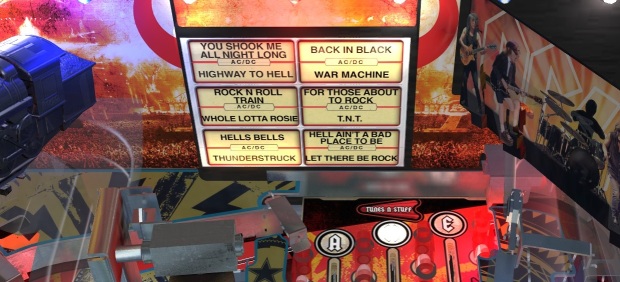
I think being a fan of the band matters. My Mom is a huge AC/DC fan and even my father Oscar, in his early 70s, adores them. I’m not a music person. Part of being autistic is I’ve got what’s called “amusia.” Which isn’t as amusing as it sounds. It means clinical tone deafness. The best way to explain it is “however music sounds to you, it doesn’t sound that way to me.” I do fine with orchestral stuff. Otherwise, I typically play games with the sound turned off. I usually recognize songs exclusively from movie and TV soundtracks. So like, Thunderstuck to me was “that song that plays in Varsity Blues during the game where the boys went out and got plastered the night before and they got slaughtered by a team they normally beat.” That’s just how my brain works.
As far as tables that pay tribute to bands go, this is pretty good. It feels weird to question a Steve Ritchie design. It’s like tugging on Superman’s cape. I’ve never understood that expression. To the best of my knowledge, Superman has never slugged a person into the sun for doing so. In fact, his whole shtick is he’s nice and probably wouldn’t do anything if someone tugged on his cape. But my point is, saying “this could have been better if only..” is so strange to do with someone like Steve Ritchie. And yet, I think if the Bell was moved into an off-angle shot, and if you just straight-up removed the entire underfield, AC/DC would have been better. Also, the Great Sphinx would have been so much better if they’d chiseled that nose one less time.
#49: Red & Ted’s Road Show
Member of the 6K Club
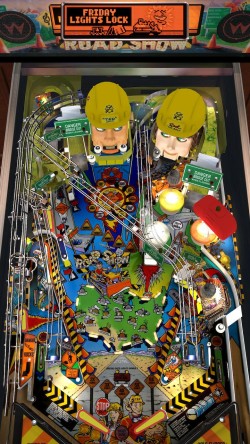 Standard version Permanently Delisted
Standard version Permanently Delisted
Included in Arcooda Software
Alternative Version: Pinball FX3 Williams Pinball Volume 4
Table Type: Finesse
TABLE FACTS
Designed by Pat Lawlor, Dwight Sullivan & Ted Estes
Art by John Youssi
Sound by Chris Granner
DMD by Scott Slomiany, Eugene Geer, Adam Rhine
1994 Williams, 6,259 Units Sold
TRIVIA
-Red & Ted’s Road Show was the final SuperPin. Originally, World Cup Soccer was designated to be the final SuperPin release, but it was changed to a standard-size and released shortly before Red & Ted.
-Red & Ted’s Road Show was originally going to be a direct sequel to Earthshaker titled “Earthshaker II: The Big One”, a double meaning to the massive size of SuperPins and earthquakes.
-Pat Lawlor’s likeness is featured as the driver of the Corvette on the backglass.
TEAM RANKING: #31 of 96
Oscar’s Rating: Good (#50)
Jordi’s Rating: Good (#42)
Angela’s Rating: Great (#22)
Eala’s Rating: Great (#19)
Red & Ted probably has more to do with the fall of pinball as a viable money-earner for arcades and route operators than most tables from the time period. Like all SuperPins, you can’t help but be taken back by its sheer size. But, unlike your typical Pat Lawlor table (especially fellow SuperPin Twilight Zone), Red & Ted has a big, wide-open playfield. The layout isn’t Lawlor-like at all either, and feels more like a Dennis Nordman valley-style table. It certainly amplifies Red & Ted’s targets, giving them that exhilarating “hitting shots feels so good” vibe that I love about the SuperPin line. But, I can totally see why operators apparently hated this table. It’s loud, the shaker is way-overdone, and the whole thing was prone to breaking down. Out of Order signs make no money (unless you’re a sign maker) and Red & Ted wore one more than most tables from the era. That’s not to mention it didn’t have marketing advantages other tables had, like having a famous property attached to it. It’s a generic, boring theme. While I’m not condoning Midway’s treatment of Lawlor from 1995 onward, it’s kind of telling to me that they started putting the screws to his tables following Red & Ted, when he had been the goose that laid the golden eggs after Fun House, Addams Family, and Twilight Zone.

Red & Ted is one of those tables that on both Pinball Arcade and Pinball FX3 where you can easily feel the difference the engine makes. The Fire-in-the-Hole shot is very high risk on Pinball Arcade, almost to the point of not being worth trying. It’s only a moderate-risk shot on Pinball FX3, which I feel is more along the lines of how the real Red & Ted plays. For whatever reason, on Pinball Arcade, it’s a deadly shot that’s not scored in a way that justifies the risk.
But, perhaps the biggest issue of all is that Red & Ted is so insanely complex and confusing that it’s probably unenjoyable for non-pinheads. This should give you an idea of just how complex: the Pinball Arcade instructions for it are 869 pages long. By comparison, Twilight Zone’s is 710 pages. Theatre of Magic has under 300, while Terminator 2’s has just a little over 300. Lawlor’s hallmark is complexity, and everyone who appreciates the sport loves him for it. BUT, there has to be some kind of seat belt attached to that crashing car, or you’re going to fly through the windshield. Red & Ted is too complex and has too many modes, many of which you’ll be bored with because they’re not the “good” modes. The ones that score real points. The scoring balance is out of whack. That’s before we even get to Pinball Arcade-specific problems like the Fire in the Hole shot spoon-feeding the right outlane, or multiballs clearing each-other out because the playfield is too open, or even the heavy necessity for nudging to avoid draining out on the top bat-flipper. Red & Ted is still fun, but a mere shadow of its Pinball FX3 counterpart, and for a table that already had more issues than National Geographic to begin with.
#48: High Roller Casino
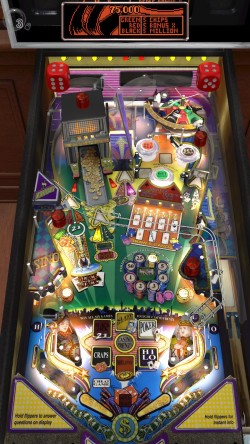 Featured in Stern Table Pack 2 (DLC), Stern Pinball Arcade Add-On Pack 2 (DLC/Physical)
Featured in Stern Table Pack 2 (DLC), Stern Pinball Arcade Add-On Pack 2 (DLC/Physical)
Not included in Arcooda Software
Table Type: Finesse
TABLE FACTS
Designed by Jon Norris and Keith P. Johnson
Art by John Youssi & Kevin O’Connor
Sound by Kyle Johnson
DMD by Mark Galvez
2001 Stern, 1,200 Units Sold
TRIVIA
-High Roller Casino was the last table by Stern to not be licensed. Whoa Nellie: Big Juicy Melons, while not being based on an IP, is technically licensed from its original Whizbang run.
TEAM RANKING: #52 of 96
Oscar’s Rating: Good (#64)
Jordi’s Rating: Good (#55)
Angela’s Rating: Good (#60)
Eala’s Rating: Great (#33)
In the interest of full disclosure, co-designer Keith Johnson (I mistakenly left out Jon Norris, who I think I pissed off doing so. It’s a 60,000 word feature. Accidents will happen) is a friend of mine. But, that’s not why I have this ranked higher than the only other table that owns being casino-based (Jack•Bot). I say “owns” because WHO Dunnit really is also casino-based and I have it ranked just barely ahead of High Roller. But, I think that’s more on the strength of translation, and that a real High Roller would handily beat a real WHO Dunnit. High Roller fundamentally GETS the casino experience and feels like the games drive the scoring instead of just being arbitrary. It also feels like the odds match real-world games. Before tinkering with the factory settings in pro-mode, we couldn’t win anything, to the point that the few victories we had felt accurate to the casino theme. And, unlike Jack*Bot, it doesn’t seem like the AI tilts to help a player that’s losing a versus game cover the gap.

I get tons of crap for not putting more stock in table themes. I feel they have no bearing on gameplay. But, I’ll comment here: I don’t like the dot matrix slot machine and I can’t stand the art direction of High Roller Casino at all. It’s lacking in pizazz. You’re a casino table. Go all glitz or all tacky. One or the other! High Roller Casino is restrained. It feels more like a strip mall card room than a fancy casino.
The real issue is the floaty physics cause balls to cluster-up too heavily in multiball, resulting in those modes being unworkable. Since those modes are so key to scoring bursts, that’s kind of a big deal. I also think the table layout is a bit too conservative. The playfield is wide-open with only a single row of drop targets on the right side occupying the center, and they’re angled to prevent the ball from returning off a shot. Really, High Roller is driven by happenings on the DMD display. My gut tells this was originally more ambitious, but Stern was in start-up at the time with shaky financing. Given how toy-heavy they became immediately following this, I suspect this started really ambitious but had the budget hammer brought down on it. Keith later went on to make a better card-based table, World Poker Tour, which is like an old EM target-shooter on steroids that I can’t believe hasn’t been digitized, because that’s Keith’s masterwork. High Roller Casino is fun, but that fun is limited by a bad physics engine.
#47: Elvira and the Party Monsters
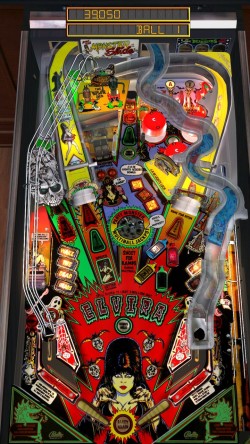 Featured in The Pinball Arcade: Season One (PS4 Disc Only)
Featured in The Pinball Arcade: Season One (PS4 Disc Only)
Included in Arcooda Software
Type: Pick ‘n Flick
TABLE FACTS
Designed by Dennis Nordman & Jim Patla
Art by Greg Freres
Sound by Chris Granner
1989 Midway Manufacturing, 4,000 Units Sold
TRIVIA
-Used Elvira tables were considered especially valuable by route operators long into the DMD era of pinball, as Elvira was considered one of THE best earning tables on the market, so much that Midway considered a DMD remake of it before deciding to create a full-on sequel (Scared Stiff).
-Elvira was the first table with a “Family Mode” that could be used to remove some of the more suggestive sound bites from Elvira.
-An 8-bit interpretation of Elvira and the Party Monsters, along with the Mark Ritchie/Barry Oursler classic Police Force, was included in Pinball Jam for the Atari Lynx. While it featured an accurate layout and scoring, this version plays especially poorly.
TEAM RANKING: #64 of 96
Oscar’s Rating: Bad (#77)
Jordi’s Rating: Bad (#80)
Angela’s Rating: Good (#43)
Eala’s Rating: Good (#58)

What a strange thing to happen: that the host of a cheap B movie anthology became one of THE icons of pinball.
Dennis Nordman seemed to have fallen in love with the valley-style layout during the late 80s alpha-numeric era of Williams/Bally. Party Zone, Dr. Dude, and Elvira. The weird thing is, each table has incredibly similar foundations and should play similarly. But, they don’t at all. Party Zone is a total, wood-chopping bore. Dr. Dude is so close in layout to Party Zone that it should fail too, but, well, you’ll see when you get to the masterpiece section of this guide. And then, there’s Elvira and the Party Monsters. It’s probably Nordman’s most iconic and famous table of his entire career. While it does withstand the test of time, I found it played just alright. Dad and Jordi didn’t like it at all. I think we collectively agreed was that Elvira was the table that’s popularity perplexed us the most.
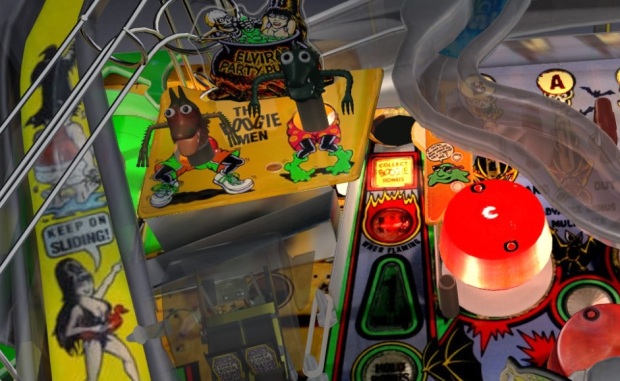
Dennis Nordman had suffered a horrific motorcycle during the design and production of Elvira and the Party Monsters, leading a longstanding rumor that Steve Ritchie, Mark Ritchie, and Jim Patla came in and redesigned the whole thing, something Dennis Nordman didn’t know until he saw the final product. Consider this rumor busted. Steve and Dennis agree that the whitewood (industry slang for prototype) was, more or less, the table that was released, with only some of the angles clearned up. Having said that, there’s one rumor that is true: the Boogie Men cameoed in The Party Zone because they were over-manufactured for Elvira and the Party Monsters, but their dancing was removed there. One of the things that surprised me most doing this project was that Elvira only did 4,000 units. It doesn’t even have club status. Again, this is one of the most iconic tables ever, so much so that they just did a second sequel (Scared Stiff is the first) thirty-years-later. I think everyone thought it did a lot better than it actually did. 4,000 units ain’t a flop by any means, but it ain’t that great either.
Elvira came about in an era where things like scoring balance started getting less consideration in favor of toys, ramps, and eye-catching gimmickry. It’s centered around shooting simple ramps in repetition along with unlocking and playing the simple three-ball multiball. The main targets lay on primary angles, making all necessary shots simple and fundamental. It should make for an easy experience. Oh lord, if only. The table runs faster and bouncier than it seems like it should (and trust me, it’s not just this digital version) with notoriously-cruel outlane rails that take unkind bounces with alarming frequency. I guess it’s aesthetically fitting that Elvira: Mistress of the Dark’s outlanes rip apart more balls than the monsters in the b-movies she shows. For a real table, if you can get the hang of nudging, you can can probably combat this. A digital version can’t translate that even with tons of fine-tuning. Honestly, I just find the layout and over-simplicity to be.. alright but bland. Dunno how else to put it. Decent table. Not deserving of legendary status. Happy it’s here, if only because it seems to open a lot of people’s eyes to the fact that it was never all that to begin with. Hitting the multiball ramp jackpots is still a thrilling shot thirty-years-later, and that counts for something.
#46: Tee’d Off
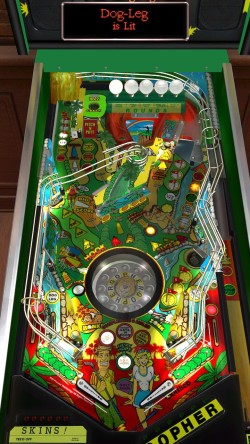 Featured in Gottlieb Table Pack 3 (DLC), The Pinball Arcade: Season Two (PS4 Disc)
Featured in Gottlieb Table Pack 3 (DLC), The Pinball Arcade: Season Two (PS4 Disc)
Included in Arcooda Software
Table Type: Pick ‘n Flick
TABLE FACTS
Designed by Ray Tanzer & Jon Norris
Art by Constantino Mitchell, David Moore, & Jeanine Mitchell
DMD by Rand Paulin
1993 Gottlieb, 3,500 Units Sold
TRIVIA
-The dancing gopher’s name is Gunther.
-Tee’d Off was Gottlieb’s highest-earning table of the 1990s, and probably would have sold even more if Gottlieb hadn’t had a policy that banned second and third manufacturing runs. It was the last Gottlieb table to routinely appear among the twenty highest-earning tables in arcades.
TEAM RANKING: #40 of 96
Oscar’s Rating: Good (#68)
Jordi’s Rating: Great (#34)
Angela’s Rating: Great (#30)
Eala’s Rating: Great (#35)
THE PINBALL CHICK CERTIFIED EXCELLENT TABLE
You mean to tell me neither Midway nor Gottlieb would spring for the Caddyshack license? That license had to be worth at least an extra 3,000 units in tavern installments. Especially if they got Chevy Chase and Rodney Dangerfield’s likenesses. Or that one guy. You know, the Groundhog Buster guy. Bill something. This is one of those weird things where a golf table makes sense. I mean, if there’s 2,000,000 different pool/billiards themed tables (give or take), surely there should be just as many golf tables. It’s just weird that both companies came to basically the same conclusion: “gophers.” I guess Dancing Gophers are memorable and profitable. Mostly. Candyshack 2 might like to have a word with them about that.
Thankfully, the similarities end there. No Good Gofers is a typical Pat Lawlor mad house, while Tee’d Off feels much more like a somewhat conservative 90s solid state. Gameplay is primarily based around a small jump ramp that feeds a “green” that activates your typical Gottlieb System 3 mystery scores. Those mystery scores, in my Dad’s opinion, single-handedly prevent Gottlieb DMDs from being able to reach “Great” status and the lack of balance between them swung more than one of our versus games. Then again, Dad also blew one by betting all his points on the S-K-I-N-S game and losing. Besides the green, there’s other holes (including one labeled a “volcano” because why not?) that drive gameplay. But, unlike the Lawlor’s No Good Gofers, Tee’d Off makes no effort to score like golf. It just uses golf terminology. How lazy is that? Then again, lazy is par for the course for this era of Gottlieb. See what I did there?

My gut tells me this was originally going to be something more. Besides, you know, PCP gopher boy here. Either way, Tee’d Off proves Jon Norris is right there with Ray Tanzer in the “too good for Gottlieb” field. If he’d been given proper budgets, reasonable deadlines, and decent licenses, who know what he might have done.
But, of all the 90s Gottlieb DMDs, this is the one that’s easily the best. Don’t get me wrong: the flow is crap and the table is overly bouncy. But, there’s excellent hurry-ups, nice target placement, and just a relaxing, less nuanced layout. I wasn’t a huge fan of the jump ramp, which feels imprecise and inelegant. I also think there must have been plans for an under-field ala Gottlieb’s Black Hole & Haunted House (wouldn’t it make sense for such a field to be a putting green? Come on, you can see it in your head right now. ADMIT IT! YOU CAN!) but it was cancelled in favor of a pace-killing roulette wheel to spell G-O-P-H-E-R instead. It’s so weirdly implemented and unsatisfying that my gut tells me they planned for a bigger feature to occupy this space. Otherwise, Tee’d Off is the best Gottlieb DMD that made its way to Pinball Arcade. It’s Alright. How pathetic that “alright” was 90s Gottlieb at its very best. Maybe Shaq Attaq or Stargate would have done better, but I have zero faith. Besides, I hear Shaq wanted money like it was 1994 and he was still playing for the Orlando Magic.
#45: WHO?dunnit
 Standard version Permanently Delisted
Standard version Permanently Delisted
Included in Arcooda Software
Table Type: Pick ‘n Flick
TABLE FACTS
Designed by Dwight Sullivan & Barry Oursler
Art by Linda “Deal” Doane & Paul Barker
Sound by Paul Heitsch
DMD by Adam Rhine & Brian Morris
1995 Midway Manufacturing, 2,416 Units Sold
TRIVIA
-Although the mystery elements are relatively simple and seemingly random while playing, WHO?dunnit has a complex story, with consistent character traits and a plot thread that reveals itself over the course of several games. A full breakdown can be revealed here.
-If the internal clock on a WHO?dunnit table reaches midnight during a ball, a special multiball mode called Midnight Madness will begin where all targets score 3,000,000 points.
TEAM RANKING: #43 of 96
Oscar’s Rating: Great (#36)
Jordi’s Rating: Great (#29)
Angela’s Rating: Bad (#69)
Eala’s Rating: Good (#51)
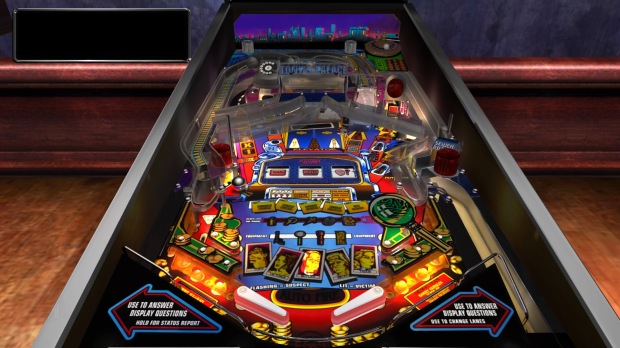
Not based on The WHO, or maybe it is and Oursler is saying they did something? WHO DID YOU KILL, WHO?! WHO?!
Once upon a time, Midway I guess was going to do tables based on popular board games. Safe Cracker was originally supposed to be Monopoly, while WHO?dunnit was supposed to be based on Clue. That’s Cluedo if you’re anywhere but the United States. The Monopoly part of the story has been confirmed to be 100% accurate, though for the life of me I can’t spot what elements were supposed to represent what Monopoly gameplay mechanics. Meanwhile, the Clue part of the legend has never been verified. But, if WHO?dunnit was meant to be Clue, I could believe it. Well, up to a point. The weird thing is, this is the table everyone knows as “the murder mystery pinball machine.” But really, it’s more of a gambling-themed pin with some very light murder-mystery elements in it. And honestly, the most famous parts of the table are the weakest parts. The mystery stuff slows everything down too much.
UPDATE 07/04/2020: And this whole legend is BUSTED. Two sources tell me that it’s a coincidence that Monopoly was licensed at the same time WHO?dunnit went into development. There you have it. Well, that whole paragraph was a waste. Well, not the whole thing, but most of it.
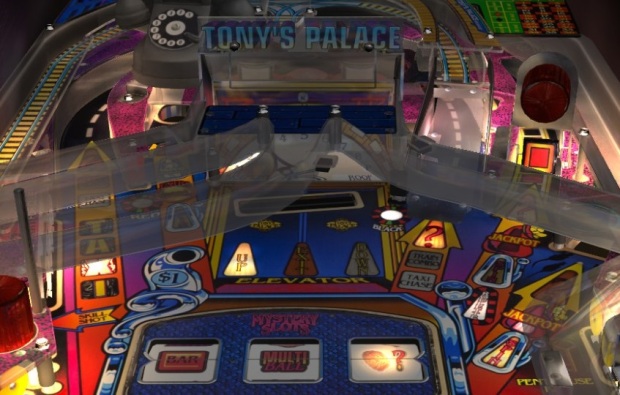
For the most part, Pinball Arcade succeeds in giving players a sense of depth and scale. WHO?dunnit is an exception. It’s extremely weird to play because the Tony’s Palace ramps and feeding them feels like the ball is traveling along a flat plane instead of being above the surface. This is literally the only time in 100 tables I felt that, so hey, that’s a positive. I look forward to seeing how Pinball FX3 handles it.
Like, when you go to plunge a ball, it takes forever for the murder stuff to show on the DMD. Sometimes it’s a live ball while the “plot” kicks off. And what’s the point of this? It’s not the most complex mystery to solve. You’ll “interrogate suspects” and often you can guess which of the five suspects is the killer just by going off what the first interrogation says. In fact, each person will say the name of the killer UNLESS they are the killer. So it sort of narrows down your options and makes the whole mystery thing smoke and mirrors. Really, the gameplay is driven by a large slot machine and a digital elevator that determine what modes you’re playing. It’s not as luck-based as it sounds, though still a little too much for me to consider it a “great” table. There’s sharp angles, but too much down time. The primary hurry-up, “The Roof”, is too fast and unreasonable. WHO Dunnit sounded so much more interesting than it turned out to be.
#44: Genie
Member of the 6K Club
 Featured in Gottlieb Table Pack 1 (DLC), The Pinball Arcade: Season One (PS4 Disc)
Featured in Gottlieb Table Pack 1 (DLC), The Pinball Arcade: Season One (PS4 Disc)
Included in Arcooda Software
Table Type: Sharpshooter
TABLE FACTS
Designed by Ed Krynski
Art by Gordon Morison
1979 Gottlieb, 6,800 Units Sold
TRIVIA
-Genie was the largest solid-state table produced by Gottlieb.
-The value of the left bumper was changed at the last minute from being worth 1,000 points to being worth 2,000 points after extensive playtesting found that it was the most lethal element on the table.
TEAM RANKING: #32 of 96
Oscar’s Rating: Great (#13)
Jordi’s Rating: Good (#56)
Angela’s Rating: Good (#45)
Eala’s Rating: Great (#28)
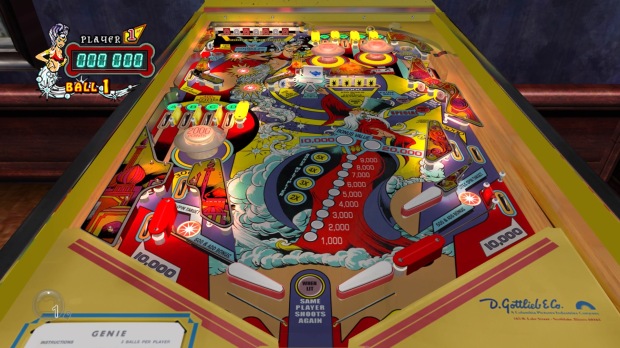
The digital version doesn’t do Genie justice. You have to stand in front of a real one to appreciate how huge it is.
In the late 1970s, pinball started to decline in the face of a new, more enticing medium called “video games.” Pinball had just transitioned from the electro-mechanical era to the solid state era (IE powered by microprocessors), but changing from scores displayed on reels to scores being shown on digital displays didn’t exactly set the world on fire. Pinball manufacturers collectively decided the solution was to make wider tables. Atari made the widest in the industry, and to this day, Nolan Bushnell insists that’s why Warner beached him. It’s not. He had a habit of calling meetings without Warner representation. In truth, Atari’s machines were too big, and arcade operators hated them because they took up a lot more space but didn’t earn a lot more money. And then Bally came out with Paragon, the first truly successful widebody. At nearly 10,000 units sold, Paragon saved the field of pinball for an entire generation. Gottlieb turned to their rock-star, Ed Krynski, to design their answer to it. While Genie wasn’t nearly as successful (moving around 6,800 units), it single-handedly allowed Gottlieb to transition successfully to the solid state era.
So, how does Genie hold up? Pretty well, considering how far pinball has come since 1979. It actually has a lot in common with Paragon, the table it was designed to compete with, in that Genie feels like an all-star game that lifted good parts out of every major pinball machine that came before it. The object isn’t complex: targets are mostly based around raising bonuses and multipliers. And it has some great ideas. The roll-over targets the ball has to travel through when plunged onto the playfield? There’s a second set of them below the mini-playfield (oh, there’s a mini-playfield, a first for Gottlieb) and triggering the target on one set deactivates the light on both. While raising the bonus is the primary object, there’s tons of chances for extra balls too. For its time, this was pretty complex.

I do like Genie, really and truly. But playing it is akin to watching an old person be explained something from another era and MOSTLY grasping it, but not quite applying what they learned correctly. If that makes sense.
And, frankly, it outdoes Paragon by virtue of balance and fairness. Especially on Pinball Arcade. It’s not even close. So, why didn’t it out-perform Paragon, which is a truly miserable, punishing experience? I think Gottlieb’s biggest mistake in that era was they still relied heavily on the style of comic art that looked more like it belonged to Archie than to DC or Marvel. Paragon was dynamic and visually striking. Genie looks like someone superimposed an issue of Superman’s Girlfriend: Lois Lane where she fantasizes about getting three wishes onto a pinball table. Genie is also plagued by some unfair design. There’s a slope that, if the ball catches once it clears the A-B-C-D roll-over, will lead to an almost certain drain-out even if you nudge the table. In the EM tables, the nudge worked well. For Genie? Not so well. And that’s sort of important because professionals consider it essential to playing the table well. Genie is an all-time important pinball machine, but the digital translation is merely a good one.
#43: Taxi
Member of the 7K Club
 Featured in The Pinball Arcade: Season One (PS4 Disc Only)
Featured in The Pinball Arcade: Season One (PS4 Disc Only)
Included in Arcooda Software
Table Type: Finesse
TABLE FACTS
Designed by Mark Ritchie
Art by Python Anghelo
Sound by Chris Granner
1988 Williams, 7,300 Units Sold
TRIVIA
-The character of Lola was named after the titular character of the song Lola by The Kinks.
-Ed Boon provided the voices of the male characters.
TEAM RANKING: #39 of 96
Oscar’s Rating: Good (#42)
Jordi’s Rating: Good (#57)
Angela’s Rating: Good (#40)
Eala’s Rating: Great (#25)

While Diner is the actual sequel to Taxi, the REAL sequel in terms of design and layout is actually Fish Tales.
Another great table that couldn’t possibly hope to survive the translation to digital. You’ll realize this about one second after beginning your first game. When you go to use the plunger, you’ll sit heartbroken when it hits you that Taxi’s historically-terrific serve into the “spin-out” can’t be done with an analog stick. I had to resort to nudging to be able to drain the spin-out at 100K. It robs the game of one of the most satisfying instances of clocking a mechanic in the medium. When you get the spin-out nailed down to the point that a miss is more rare than a hit on a real Taxi machine, man, it’s a moment. One that won’t be recreated without an authentic plunger. The rest of the table does a fine job, but the experience is already soured.
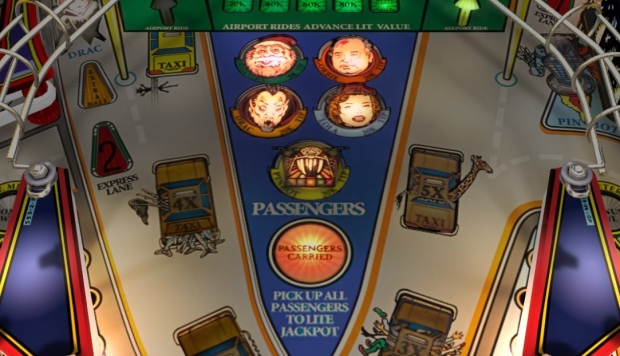
The Legend of Lola. Originally, the passenger that has a striking resemblance to one Marilyn Monroe. In fact, her name WAS Marilyn. This even made it into the first few hundred machines off the production line, though it’s up for debate how many of those ended up in circulation.
I love Taxi, but Taxi doesn’t love me back. A difficult table that runs fast and heavy. No pin has balls as consistently need saving via the tip of the flippers more. That’s by design, by the way. Orbits are angled in a way where, without a little bit of the silverball shimmy, you’ll be forced to barely finger-tip the ball with the flippers. You can’t relax for even a second if the ball is live, and gaining control of it for a trap-shot could be more difficult than most players are accustomed to. It’s genuinely thrilling, as is shooting orbital combos or making your shots. But, I can totally see why some people find Taxi completely overrated. There’s horrible scoring balance issues. The late 80s and early 90s had major problems with shots that were insane multiples over the standardized scoring. In Taxi, it’s the million point shot, which, frankly, shouldn’t exist. It’s not as game-breaking as the ridiculous billion-pointer of Bride of Pin•Bot, but it’s still off-balance enough that it forces players to build their entire games around making one shot. Pinball should be more than that. Taxi is still fun, but in a guilty pleasure sort of way.
#42: Ripley’s Believe it or Not!
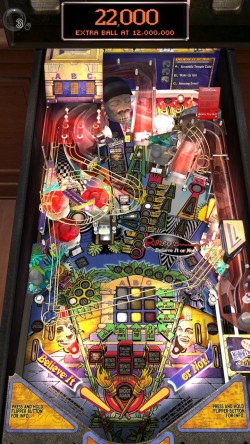 Featured in Stern Pinball Arcade Table Pack One, The Pinball Arcade: Season One (PS4 Disc)
Featured in Stern Pinball Arcade Table Pack One, The Pinball Arcade: Season One (PS4 Disc)
Not included in Arcooda Software
Table Type: Finesse
TABLE FACTS
Designed by Pat Lawlor & Louis Koziarz
Art by John Youssi
Sound by Chris Granner
DMD by Adam Rhine
2004 Stern, Unknown Sales (Likely under 1,000)
TRIVIA
-Features many callbacks to classic Pat Lawlor tables, such as saying the “it’s not plugged in yet” from Addams Family if you hit the Shrunken Head before lighting it. References to Twilight Zone and Funhouse are also included.
TEAM RANKING: #26 of 96
Oscar’s Rating: Good (#41)
Jordi’s Rating: Great (#26)
Angela’s Rating: Great (#17)
Eala’s Rating: Great (#20)
THE PINBALL CHICK CERTIFIED EXCELLENT TABLE
Ripley’s Believe it or Not! wanted so bad to be Twilight Zone. It’s what Stern wanted. It’s what Pat Lawlor wanted. It’s probably what Pinball Arcade wanted. When the platform launched, they gave away four free tables to show off the potential for the platform: Theatre of Magic (for the life of me, I can’t remember this being included but people insist), Tales of Arabian Nights, Black Hole, and this. My hunch tells me that when Farsight announced the project, fans said “do Twilight Zone!” It wasn’t part of their previous Pinball Hall of Fame sets. It’s ranked #1 at the Internet Pinball Database and even people who don’t like the rest of Lawlor’s catalog admit that Twilight Zone is something special. This, which is legitimately considered by the man himself to be the spiritual sequel to Twilight Zone, is the best they could do for a fraction of the cost. And really, it plays a lot like Twilight Zone. Similar placement on bumpers, many similar goals (shrunken heads instead of hitchhikers, for example), a less-than-generous ball save, remarkably balanced scoring (easily the table’s strongest suit), and your typical Lawlor mode fetish.
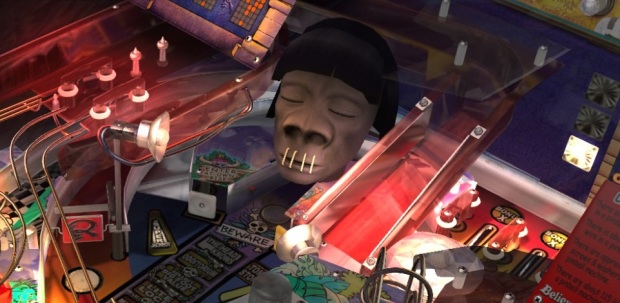
I strongly suspect that Ripley’s Believe it or Not! will never get another official digital release. Call it a hunch.
So, why isn’t this the masterpiece or all-time classic Twilight Zone was? I don’t give a crap about nostalgia OR repetition. Part of it could be that this isn’t a SuperPin. Maybe. I mean, it’s not that much smaller. And, like Twilight Zone, it feels crowded, though Ripley’s version of “crowded” is more like “congested.” Especially the left side, where, like Twilight Zone, there’s just no room to maneuver. Don’t get me wrong: great looking table, and all the targets are distinct, but the left side’s layout gives it a messy bedroom feel to it, as opposed to the intricate insanity that is Twilight Zone. I kinda look at it like Twilight Zone with a tighter budget. Plus, it just feels like the variety isn’t there. Ripley’s has a vari-target that acts as the primary target of the table and is ball-numbingly easy to hit from either flipper. It drives a variety of seven modes, each themed after a continent, that mostly come down repeating simple orbits or off-angle shots. I suspect Stern mandated Lawlor to alter his ideas to include more multiball modes, because there’s too many in Ripley’s (this is pretty much the only time the ball save is worth anything) and they’re kind of dull, though thankfully not as over-powered as Harley’s. Really, Ripley’s just can’t escape that “cheap alternate to Twilight Zone.” Hell, it might be worse than that. I’ve heard it suggested the table was originally going to be based on Guinness World Records, but the Ripley’s license was even cheaper. That would make Ripley’s the off-off brand license. Yikes!
#41: No Fear: Dangerous Sports
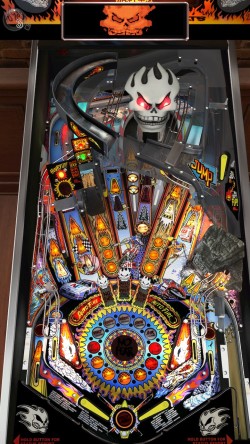 Standard version Permanently Delisted
Standard version Permanently Delisted
Included in Arcooda Software
TABLE TYPE: Kinetic-Finesse
TABLE FACTS
Designed by Steve Ritchie, Greg Freres, Matt Coriale, & Dwight Sullivan
Art by Greg Freres
Sound by Dan “TOASTY!” Forden & Vince Pontarelli
DMD by Brian Morris, Scott Slomiany, & Adam Rhine
1995 Williams, 4,540 Units Sold
Alterations: All corporate logos (Ford, Goodyear, etc) have been removed.
TRIVIA
-Based on the NO FEAR clothing line created by Mark & Brian Simo.
-Steve Ritchie is the voice of the skull while Greg Freres provides the voice of the “Wise Guy.”
-From early on the table’s creation, a debate raged among the designers as to whether or not a drain post should be included. All tables have a hole cut for a drain post and the first batch of tables shipped to arcades included a post as an operator’s option.
-Includes the likeness of all five athletes who were “brand ambassadors” for the NO FEAR clothing line, including Jeremy McGrath, Glen Plake, Robby Gordon, Sammy Duvall, and Dan Osman.
TEAM RANKING: #41 of 96
Oscar’s Rating: Good (#38)
Jordi’s Rating: Good (#68)
Angela’s Rating: Good (#37)
Eala’s Rating: Great (#34)

Quite the visual looker No Fear is. But, oddly enough, I think this is one of the few tables in Pinball Arcade that looks better in the game than the real tables do. I don’t know why.
No Fear is one of the more bizarre tables put out by Midway. It’s apparently not that desirable. It pops up on Craigslist quite often for around $3,000 or less (there was one in good condition once for $2,400 on the SF Bay Craigslist and my Dad is still kicking himself for not at least calling to take a look at it), making it a pretty good entry-point table for would-be collectors. It runs fast and is orbit heavy. Oh, and it’s based on a clothing line that was popular in the 1990s. That’s weird to me. It’d be like if Tommy Hilfiger had a pinball machine. It’d probably be a blank table, maybe one bumper, and cost $35,000. There’s also four designers credited, though most sources seem to say that Steve Ritchie was in charge. It doesn’t show. My Steve Ritchie-loving father called this the “least Ritchie Ritchie” and I tend to agree.

If you need to explain to someone what a “Japanese Fan” design is, this is the screenshot to show them, as no real table took it as far as No Fear. There’s several Star Wars tables from Zen Studios that come close, so check out my review. (sold as one complete set on Nintendo Switch).
No Fear feels like a spiritual sequel to Black Knight 2000, but man, does it not live up to it. I admire the balls it took to include SEVEN off-angle orbits/ramps (along with two primary angle shots thrown in for good measure). I mean, jeez. But, the main playfield is too orbit-heavy and the scoring balance is just awful. The Japanese Fan layout can work, but not with scoring balance this off. The Payback Time mode is so valuable that anything you’re doing besides trying to activate it feels like a waste of time. The upper orbit, which looks similar to BK2K’s, is the absolute hardest-to-master short-orbit in Pinball Arcade. I watched my father MURDER Ripley’s Believe it or Not! and Black Knight 2000’s short orbits, and he did so with a smile on his face. He walked away from No Fear a defeated man. And I think it’s on the Pinball Arcade. Change that, I know it is because I once saw him dominate No Fear’s short-orbit on a real table.
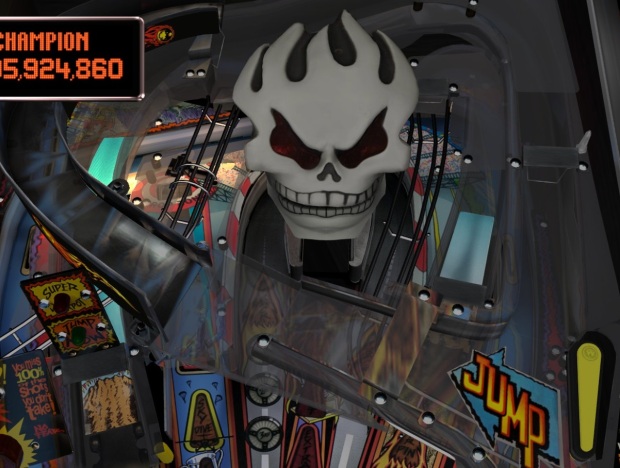
No Fear’s short orbit is actually a jump, but functionally, if done right, it’s just a short orbit. It’s one of those Curse of Digital Pinbal™ things where the charm is lost in video game form.
Then, there’s the issue of the modes. By this point in pinball’s existence, they should have had the hang of balancing them. But, too many in No Fear feel like simply checking off boxes arbitrarily. The thrills of completing them just aren’t there. But, the seven orbits are fun, the video mode is nice, and No Fear is very generous with ball save. Honestly, No Fear isn’t bad at all as far tables based on obsolete clothing lines go. Is it amazing? Nope. Is it memorable? Yep. Nobody playing it will forget just how damn strange it is. But, while I walked away happy from No Fear, I think it’s also one of those tables that’s value will be limited to short spurts instead of a desire of mastery. Weird is fine, but too weird is tiring.
#40: Creature from the Black Lagoon
Member of the 7K Club
 Featured in The Pinball Arcade: Season One (PS4 Disc Only)
Featured in The Pinball Arcade: Season One (PS4 Disc Only)
Included in Arcooda Software
Alternative Version: Pinball FX3 Universal Monsters Pack
Table Type: Kinetic
TABLE FACTS
Designed by John Trudeau
Art by Kevin O’Connor
Sound by Paul Heitsch
DMD by Scott Slomiany
1992 Midway Manufacturing, 7,841 Units Sold
Alterations: Several “songs” were removed from the digital table. Mortal Kombat characters have been removed, even if you deactivate “Family Mode” in the Pro Menu.
TRIVIA
-Because of licensing issues, Midway couldn’t use the likeness of Creature from the Black Lagoon actor Richard Carlson, so Trudeau’s teenage son became the likeness of Dr. David Reed on the backglass.
-Midway marketing agent Allison Quant was drafted to become the female voice in the table.
-Midway essentially only could use the name “Creature from the Black Lagoon” but couldn’t use details from the movie, which is why the table became a tribute to 1950s drive-ins.
TEAM RANKING: #56 of 96
Oscar’s Rating: Good (#40)
Jordi’s Rating: Good (#52)
Angela’s Rating: Bad (#74)
Eala’s Rating: Bad (#66)

The most common question I get asked about Creature from the Black Lagoon is “does the hologram work?” Yes, in both Pinball Arcade and Pinball FX3. So, just to leave any doubt, I decided to get a picture of it for Creature’s profile pick. Have a gawk. Yes, it looks fantastic in video form. Hey hey! A rare gimmick where the charm wasn’t lost. How about that?
Creature from the Black Lagoon’s experience on Pinball Arcade feels so much more player-friendly than on Pinball FX3. Even the ball save has had its settings adjusted to be more generous. But, the old chestnut of “some shots are easier, some shots harder” comparison is on display here. In Pinball FX3, the snackbar shot is so absurdly easy that you can use it as a dumper if you’re in need of a reset. Here, for whatever reason, I had a lot of trouble hitting it despite it being situated on a primary angle. Besides that one specific target, every other objective is just kind of easier in Pinball Arcade’s take on this over-rated monstrosity. Top notch table art, though. The clashing colors are neat. I’ve already reviewed this table to death. Just know that Creature from the Black Lagoon is one of the few Pinball Arcade ports that Pinball FX3 tried to top and came just short of. Then again, Pinball FX3’s tate mode on Switch absolutely MURDERED the Pinball Arcade’s (unreleased) Creature from the Black Lagoon, which makes the PBFX3’s Creature the virtual cabinet champion. Small victories are still victories.

Oscar has this table so clocked that his first step is always to repeat the KISS shot over and over until he’s gotten the free ball. It takes only a minute or so. It’s significantly easier on here than on Pinball FX3 or a real Creature table.
I’ve talked about Creature elsewhere, and I’ve said everything I can say. So, I’ve been dancing around this subject, and it’s finally time to get it out of the way. The question is “is it still okay to enjoy the works of a man who committed unthinkable crimes?” By most accounts, Creature from the Black Lagoon is John Trudeau’s baby, and John Trudeau is a disgusting monster. My heart aches for the young woman he is accused of abusing. It also aches for all his fans that he betrayed with his actions. There is no way to square his crimes with his impact on the medium. Every single work of his will carry the taint of what he’s done. Every single engineer, illustrator, and designer that he collaborated with will have their artistry admired a little less. It’s a sickening feeling, because I’ve spoken with some, and know they’re every bit as disgusted and heartbroken as fans are. So, what can we, as fans of pinball, do about it? Well, we can take a moment to remember that pinball is a collaborative effort. No table is the work of one man. A dozen people helped on Creature from the Black Lagoon, and it should take more than one person to sour it forever. Another thing you can do is make a contribution to RAINN, a wonderful organization that helps provide immediate help and outreach to family members of abuse. And finally, don’t say “I hate what he did, BUT..” There is no “but” when it comes to the abuse and betrayal of a child. This wasn’t a single act. This was a series of acts that took places over many years and extended beyond simply possession of gross material. It’s unforgivable. I would boycott any company that worked directly with him again. He’s finished in pinball, and I’m finished with him. From here out, any coverage of his tables will discuss the merits of them, and not him. I’ve said my piece.
#39: Tales of the Arabian Nights
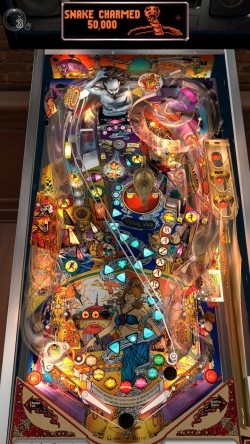 Featured in The Pinball Arcade: Season One, The Pinball Arcade: Season Two (PS4 Disc Only)
Featured in The Pinball Arcade: Season One, The Pinball Arcade: Season Two (PS4 Disc Only)
Included in Arcooda Software
Alternative Version: Pinball FX3 Williams Pinball Volume 5
Table Type: Finesse
TABLE FACTS
Designed by John Popadiuk
Art by Pat McMahon
Sound by Dave Zabriskie
DMD by Adam Rhine & Brian Morris
1996 Williams, 3,126 Units Sold
TRIVIA
-The lamp was pitched as a first-of-its-kind “horizontal spinner” during development.
-Tales of the Arabian Nights is the first pinball table with a vertical magnetic diverter, which is used for the Genie shot.
TEAM RANKING: #45 of 96
Oscar’s Rating: Good (#57)
Jordi’s Rating: Good (#40)
Angela’s Rating: Good (#39)
Eala’s Rating: Good (#60)
I’m not the biggest fan of Arabian Nights. I think it has too many inherit flaws. Overly crowded, littered with blind angles, while hosting one of the most chaotic magnets in pinball, Arabian Nights is designed to dazzle and frustrate. The problem is it doesn’t do equal parts of both. It’s downright annoying to be exploring the nuances of the table, only for an errant magnet attached to the table’s primary, mode-driving target to send the ball unfairly down the gutter. I’ve been over all this already with my reviews for Pinball FX3’s version. This is my third, and likely final, time I’ll talk about this controversial machine. Perhaps the biggest “is it or is it not amazing” internal debate I’ve had. I still lean towards not. It’s a masterpiece made merely okay by some straight-up B.S. Starting modes can send the ball immediately down the outlane. In Pinball Arcade, it’s a little easier to deal with via tiling than it is Pinball FX3, but outlanes still swallow balls too fast for my reaction speed. Starting modes should not be dangerous, and if it is, then modes should have a ball save attached to them. It’s the anti-Theatre of Magic. Popadiuk’s operator’s table instead of a player’s table.
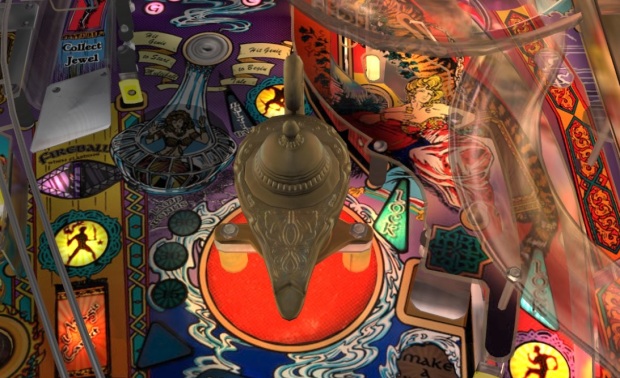
Popadiuk never put much stock in balanced scoring. The funny thing is, Oscar, my father, despises Theatre of Magic for lack of balance. But this? This is the most unbalanced Popadiuk shot ever. If you multiply the value of the Lightning Lamp, you can absolutely shatter every semblance of balanced scoring. But, it says something about this lamp toy that even my stone-hearted Dad got a kick out of spinning this. Everyone does. Sometimes fun matters more than logic.
When Arabian Nights works, it’s really fun. But, even the most fun things are fundamentally broken. The lamp bonus is too easy to chop wood with, especially after boosting the lightning lamp scoring. You can easily score in the 20M range ignoring everything else and shooting just it. Mind you, you only need 8,000,000 for an extra ball. That’s ridiculous. So is the ability to completely circumvent modes by simply shooting an easy-access kickhole that gives you a choice to take the mode’s jewel or something else that’s not nearly as valuable in the long run, something you can easily grind up yourself. If this was tougher to do, I could see it, but it’s literally no challenge at all. Granted, the table as a whole is tough to give a ball live on, but having a such an easy “instant win” option is bizarre. I played two games on the day I wrote this review where I didn’t complete a single mode legitimately and cleared every table objective. It’s the first time I’ve played a table where it feels like it had no faith in players. Maybe this was to appeal to casual goers at arcades (in which case, the genie’s magnet was a REALLY dumb idea). All I know is, despite these problems and so many more (I didn’t even get into how absurdly hard the Harem Multi-Ball is to activate in the Pinball Arcade version), this table can be so much fun. If I made a top ten list of my favorite shots in DMD pinball, spinning the lamp might be near the top. It’s just so satisfying.
#38: Mustang
 Featured in Stern Table Pack 2 (DLC), Stern Pinball Arcade Add-On Pack 2 (DLC/Physical)
Featured in Stern Table Pack 2 (DLC), Stern Pinball Arcade Add-On Pack 2 (DLC/Physical)
Not Included in Arcooda Software
Table Type: Finesse
TABLE FACTS
Designed by John Trudeau
Art by Camilo Pardo, John Youssi, & Greg Freres
Sound by David Thiel & Mike Kyzivat
DMD by Mark Galvez & Tom Kyzivat
2014 Stern, Unknown Sales
TRIVIA
-Legendary designer George Gomez “supervised” the production of Mustang.
-Made to celebrate the 50th Anniversary of the Mustang brand.
-To save money, Stern created wiring to include a shaker motor for owners, but didn’t include the shaker itself, which had to be bought aftermarket.
TEAM RANKING: #57 of 96
Oscar’s Rating: Good (#49)
Jordi’s Rating: Good (#50)
Angela’s Rating: Bad (#68)
Eala’s Rating: Bad (#70)
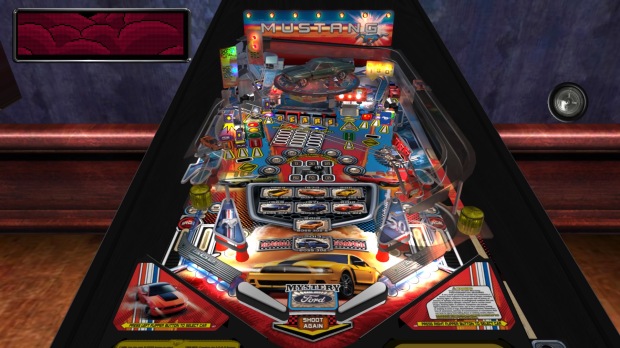
Mustang was our “Homer buys Marge a bowling ball with HOMER engraved on it” moment. We bought a real Mustang table for my Mustang-loving Godfather, AJ, who doesn’t play pinball. He saw right through it.
Mustang is a pick-and-flick table with big, wide-open shots to practice your skills on. Like Harley Davidson, it’s pinball made for non-pinheads. But, unlike Harley Davidson, there actually is some variety in modes with a lot of emphasis on touring the table. Before serving, you select which mode you want to start, each one tied to a classic car in the Mustang line. Notably, all the cars have actual music attached to them. I was totally stunned that the real-life Mustang pinball soundtrack carried over to the digital table with songs by the likes of The Beach Boys or Motörhead (so were the rights holders, who DMCA’ed my Twitter account over a 30-second clip of it). It certainly gives this a more casual, “pinball for everyone” feel. Which isn’t to say it’s stable or anything. In fact, I got a ball jammed in bumpers, scoring points without being able to move. I did the only reasonable thing one could do at that point: I left my PS4 on for 24 hours and became the console-version World Champion of Mustang for Pinball Arcade. No joke, I really am, even months after this happened.
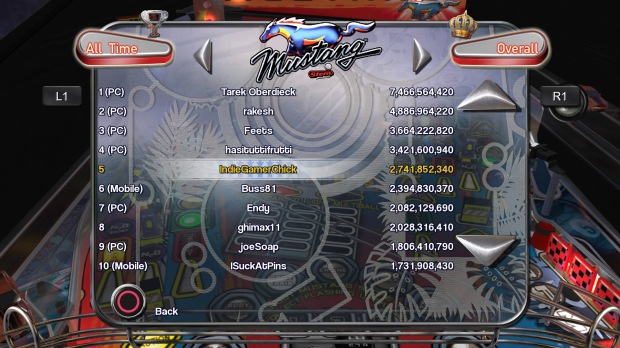
Really, it was only the goodness of my cold, dead little heart (and impatience) that I didn’t take the overall world record and settled for the console version. I could have. I’d needed to leave my PS4 on for almost a week, but I’m shallow enough to do it. So see, I’m nice. Also, I want to point out that I didn’t cheat. I actually made the shot that got stuck. I simply took advantage. So, like it or not, I’m YOUR console Mustang World Champion. Suck it.
And I like it. Mustang might be overly simple for some, and if you’re not a car person a lot of what the table offers might be lost on you. Like, if you don’t know who Tanner Foust is, the Rally Race portion will be less funny. If you’re on Stern Pinball Arcade, you can pay an extra $9.99 to buy a limited edition of the table that changes the center car toy and other art work, but really, you’re playing more or less the same table. Either way, Mustang is generous with ball save and extra balls, easy to dump balls to the bumpers if you need to catch a breather, and really just the perfectly average post-arcade Stern table. Really, the thing that stands out about Mustang most is that this was the best table in Stern Pack 2, because that’s.. not good. I mean, this table is good, but I don’t think it’s so good that it can carry the entire pack.
#37: Pin•Bot
Member of the 12K Club
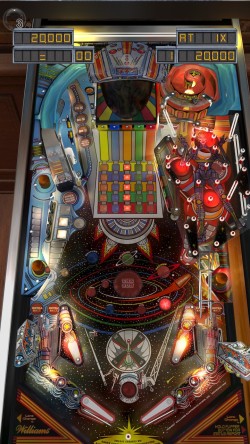 Featured in The Pinball Arcade: Season Two (PS4 Disc Only)
Featured in The Pinball Arcade: Season Two (PS4 Disc Only)
Included in Arcooda Software
Table Type: Finesse
TABLE FACTS
Designed by Barry Oursler & Python Anghelo
Art by Python Anghelo
Sound by Chris Granner & Bill Parod
1986 Williams, 12,001 Units Sold
TRIVIA
-Pin•Bot was adapted for the Nintendo Entertainment System by Rare Ltd. You can check out my thread about it here.
-Barry Oursler is the voice of the titular robot.
TEAM RANKING: #38 of 96
Oscar’s Rating: Good (#43)
Jordi’s Rating: Good (#64)
Angela’s Rating: Good (#49)
Eala’s Rating: Masterpiece (#7)
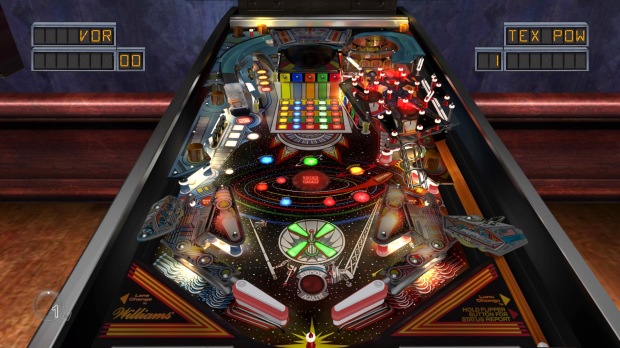
The Pin*Bot series is the Alien Trilogy of pinball. The first one was amazing, but the sequel took the series in a new and viable direction. The third one.. well.. it sure was a third one.
I’d never played Pin•Bot before this. I’d played a lot of Bride of Pin•Bot, but have never even seen the original table with my own two eyes. Probably a good thing. Mind you, as this left the factory, the team at Williams firmly believed this would be remembered as the greatest pinball machine of the 1980s. They didn’t realize that table already left production ten months earlier when High Speed was sent out. Pin•Bot did really good. It’s in the 12K Club. It’s remembered by a generation of arcade rats AND Nintendo fans thanks to a high-profile NES release. Hell, having played both NES conversions of High Speed and Pin•Bot, there’s no question Pin•Bot got the superior 8-bit rendition. But, I really think Pin•Bot is just okay. If the left outlane was as insanely vortexy as the version in Pinball Arcade is, I’d probably take a sledge hammer to it. The overwhelming majority of my balls were lost to that damn outlane. A statistically unlikely amount were so far down the inlane they were paying rent there, only to pop out and get sucked down the outlane. It made me wish that Sony had actually gone through with starting to shape their controllers like boomerangs because I wanted to throw the thing across the room. MADDENING! How could so many clearly safe and secure balls take such unlikely trajectories? It’s like Kirby was posted next to it after having Sansa Stark starve him for a week.

It’s amazing what a little effort does. Cactus Jack’s spams the table with lights, but there it looks tacky and desperate. Here, it does look enticing. It begs to be played. That’s why Pin•Bot still shines over three decades later. Having said that, it only works as a primary target once. It’s been done. If there’s ever a fourth Pin•Bot, I hope the 5×5 grid of lights is relegated to a secondary target. A wink. A cameo. Jack•Bot proved lightning doesn’t strike twice.
If not for that outlane, I don’t know what I’d think of Pin•Bot. Probably that it was too easy, though powering an outlane with a black hole seems to be an extreme measure to combat that. But seriously, the targets are simple and a skilled player can get the timing down to skip the grid of lights and open up the visor for multiball. Really, Pin•Bot, with its seemingly random planetary theme, I believe must have started life as a sequel to Oursler’s Space Shuttle table. They have a very similar vibe about them. What saves Pin•Bot, and in fact makes it the best of the trilogy on Pinball Arcade, is the razor-sharp scoring balance and how satisfactory lighting all the planets is. While I can’t imagine any time period where Pin•Bot would be considered revolutionary, because it’s a bit on the blandish side, I’ll fully admit that there’s still fun to be had here.
#36: F-14 Tomcat
Member of the 12K Club
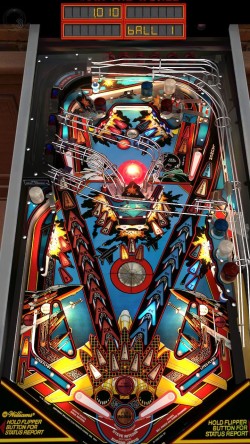 Standard version Permanently Delisted
Standard version Permanently Delisted
Included in Arcooda Software
Table Type: Kinetic
TABLE FACTS
Designed by Steve Ritchie
Art by Doug Watson
Sound & Music by Bill Parod, Chris Granner & Steve Ritchie
1987 Williams, 14,502 Units Sold
TRIVIA
-F-14 Tomcat is the first table with auto-save.
-The Jagov Kicker is the first kicker pointed at flippers on any table.
-The Ritchie Bros. provide all the voices.
TEAM RANKING: #13 of 96
Oscar’s Rating: Great (#9)
Jordi’s Rating: Great (#31)
Angela’s Rating: Masterpiece (#1 Ranked Table)
Eala’s Rating: Great (#17)
THE PINBALL CHICK CERTIFIED EXCELLENT TABLE
Steve Ritchie in the 1980s sure made some lightning-fast tables. I supposed, being the 80s, he had to cater to the cocaine-fueled masses. F-14 has a reputation of being the fastest not-orbital pin ever made, and.. yeah. It probably is. I do like fast-running tables, but I have my limits. Of course I do. That’s like saying I’d enjoy riding in a Ferrari but not being strapped to an ICBM. F-14 is just too god danged fast. But, you can’t say it isn’t built for speed. Simple targets hit with simple shots off primary angles, everything very symmetrical, and honestly, so brilliantly efficient that it’s kind of bland. My Dad loved the simple target layout and felt this was a close successor to his beloved Firepower, but even he had his limits, and F-14 Tomcat pushed them.
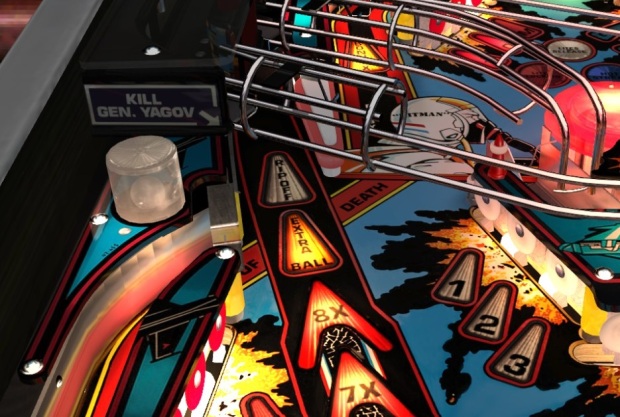
The legendary Yagov Kicker. “The Fastest shot in Pinball.” Despite that it’s really just a reverse kickback, man, does it live up to its legend. Having said that, F-14 is one of the smartest designed tables. There’s no cheap shots at all. This is the medium’s truest test of reflexes, and the table that requires nudging the least.
I’d bet good money that F-14 is one of the most scientifically-measured tables ever made. Do you realize that it was designed specifically to make every primary shot “low risk” if you master the angles of the flippers? No angle but straight-on feeds the drains. This was deliberate, because the challenge comes from keeping up with the breakneck pace. It’s not even close to the best Steve Ritchie design featured in Pinball Arcade, by any of our verdicts. And yet, this and High Speed are the tables Oscar keeps going back to. There’s something to be said for that. F-14 Tomcat is crazy difficult, but every death is on you, and you alone. And you know it when you play it. This is as white-knuckle as pinball gets. And then you get multiball, and you wonder if the table needed a multiball at all.
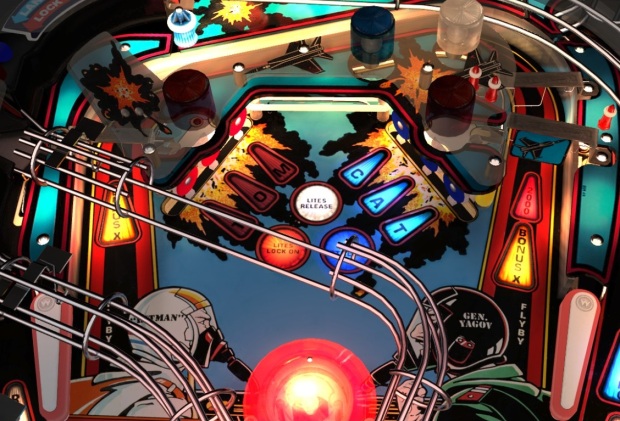
When things get crazy, you’ll struggle resist seal-clapping with the bat flippers in a feeble attempt to keep half the balls in the upper-field.
F-14’s four-ball multiball is probably the single most difficult multiball I’ve ever played. Because of the Steve Ritchie signature split-level design and the absurd speeds involved, it’s IMPOSSIBLE to manage the multiball. On the plus side, it lets me off the hook for seal clapping, because until the numbers thin out and you’re whittled down to a much more manageable two or three balls, you really have no choice but to seal clap and hope for the best. Unless you’re some kind of freak of nature that can keep track of them all. The shame is, everything else about F-14 feels so measured and precise. The target placement, the scoring allocations, the legendary Yagov Kicker (which is what Ghostbusters wanted its kickout to be, and it failed).. everything works, except when you play the game at its maximum potential, at which point it goes to hell. My Dad, who considers two-ball to be an impure experience said it best: this was a table dying to do a two-ball only multiball. Less is more, sometimes.
#35: Star Trek: The Next Generation
Member of the 11K Club
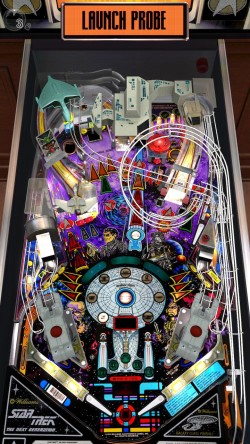 Featured in The Pinball Arcade: Season One (PS4 Disc Only)
Featured in The Pinball Arcade: Season One (PS4 Disc Only)
Included in Arcooda Software
Table Type: Sharpshooter
TABLE FACTS
Designed by Steve Ritchie, Dwight Sullivan, & Greg Freres
Art by Greg Freres
Sound by Dan “TOASTY!” Forden
DMD by Scott Slomiany & Eugene Geer
1993 Williams, 11,728 Units Sold
TRIVIA
-Originally, the white board for this table was based on the Steven Seagal flick Under Siege.
-Williams sent completed machines to the TNG cast. Patrick Stewart says he still plays his.
-To cut down on time required for VUK time, a revolutionary system was designed where each VUK already has a ball placed and ready to be kicked up. Steve Ritchie was awarded a patent for this design.
TEAM RANKING: #35 of 96
Oscar’s Rating: Great (#10)
Jordi’s Rating: Good (#43)
Angela’s Rating: Good (#32)
Eala’s Rating: Bad (#74)
If White Water is the most over-rated DMD pinball machine, Star Trek: The Next Generation is the second most over-rated. Which is not to say it’s not fun. Unlike White Water, I like TNG. But, I want to love it and I can’t, because it’s just too damn cruel. As a SuperPin, it has a big, wide-open layout that makes hitting your shots such a thrill. It popularized the “select a mode” concept that’s now central to Pinball FX/Zen Pinball’s original tables. It doesn’t play totally arcade perfect, and in fact there’s a noticeable slowness when the ball is in an open field, though weirdly the timing feels the same and my muscle-memory for the table kicked in and worked. And when Star Trek TNG is playing fair, it’s fun. A lot of fun.
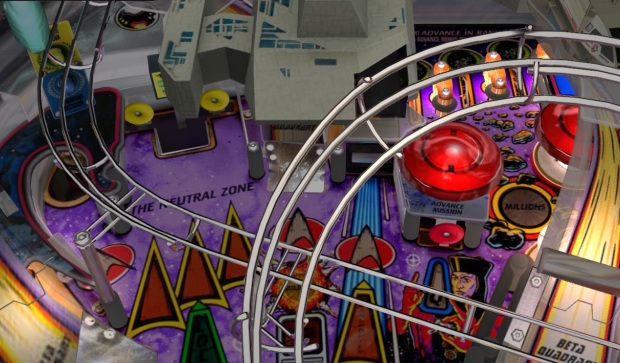
Like every SuperPin, it’s extremely satisfying to hit long-shots. And, like the other SuperPins, it lacks a “primary target.” There’s three cellar holes that drive gameplay, each of them requiring unique angles to master. Ritchie managed to turn the SuperPin concept into a sharp-shooter experience, but it has a much slower pacing than the table’s reputation would have you believe, even on real tables. If you play Star Trek: The Next Generation well, it’s actually a really plodding endeavor. “Deliberate” is a kind way of putting it.
Damn those outlanes. Those miserable, starving outlanes. I’m not naive. I get why they exist. In 1994, Star Trek: The Next Generation was the most expensive pinball table ever made. It was big, pricey, high-tech, and had the entire cast of the show (even including Majel Barrett-Roddenberry as the voice of the computer and John de Lancie as Q). It has the most memorable auto-launch in pinball history. Midway really went all-out for this one, but operators had to pay up for it. Star Trek: The Next Generation needed to lure players to drop quarters, but then it really needed them to run through three balls quickly so players could pay more. I wasn’t there, but I can’t imagine the shallow outlanes kept players coming back quite like seeing flippers snap along to a theme long like Addams Family would. It’s funny that Midway thought this could beat Addams Family, which they really did. They genuinely thought this would become the new #1 seller of all-time. Because games of TNG can turn on players quickly. In fact, in probably thousands of rounds played on a real table, I’ve never had a great game of TNG that didn’t end with me leaving angry and feeling like I’d been screwed.

Do you REALLY want to know why this table is so popular? Because Patrick Stewart is a God among nerds and you can hear him say “all hands prepare for multiball” playing this table. Okay, maybe that IS good enough to bounce this up a few spots. I didn’t rate it based on that. But I thought about it.
Of course, Addams Family had a lot more going for it than being a fun table. It came out alongside the Street Fighter II and Mortal Kombat boom, the last big explosion of arcades before they slowly started to fade out. Plus, yea, it cheated players with some of the outrageous magnetic field physics, but in a way that made you not feel like you were cheated. That ain’t Star Trek, TNG. My favorite rounds of it were ones where I’d physically block the outlanes. Well, you can’t do that here, and I swear to Christ the rate of rip-your-heart out bounces in the shallow lanes feels a little too cruel. Pinball Arcade is funny like that. Some of the recreations somewhat hush infamously hungry outlanes, while others amplify it. Star Trek: The Next Generation is one of those “I can’t believe I just played a dozen games in a row where the right outlane ate every ball” ports that makes you wonder if something in the geometry is wrong. AND I KNOW IT’S NOT WRONG! The right outlane of TNG has always been the bane of my existence. That’s been the story of this SuperPin: fun, until it’s not and certain to leave you sneering instead of smiling. But, it actually is fun. The twin guns (functionally the same as Terminator 2’s, only with a lot more targets), the precision shooting, the insanely satisfying missions, and tight squeezes that are Steve Ritchie’s real signature. Really great bat flipper too. This should have been so much better than it was, but arcade owners just HAD to eat and pay the rent, the selfish bastards.
THE GREAT
#34: Spanish Eyes
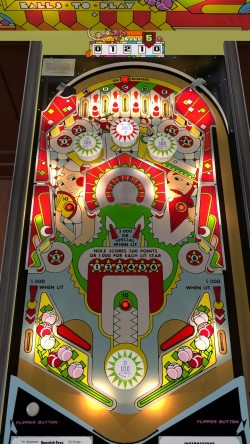 Permanently Delisted
Permanently Delisted
Not Included in Arcooda Software
Table Type: Boardwalk
TABLE FACTS
Designed by Norm Clark
Art by Johnny Craig
1971 Williams, 3,905 Units Sold
TRIVIA
-This was the only table that Johnny Craig, famed comic artist (including the infamous E.C. Comics severed-head cover that was the focus of a congressional hearing on comic books) ever did art for. Kind of.
-Williams put out another table with the art and a different layout, named Granada. The art was also used in a semi-unauthorized clone by the Zaccaria company.
TEAM RANKING: #72 of 96
Oscar’s Rating: Good (#69)
Jordi’s Rating: Bad (#87)
Angela’s Rating: The Pits (#93)
Eala’s Rating: Good (#41)
Wow, was the team all over the place with this one. I thought Spanish Eyes was a weird choice for an EM representation by the late, great Norm Clark. His 1974 work Dealer’s Choice is a rare EM that passed 8,000 units sold, one of the best sellers of the era for Williams. Other options were his 1968 Lady Luck (considered his best work by most) or the novel 1975 OXO, a Tic-Tac-Toe themed table in the 7K Club. But, I’m happy this is the table chosen. A distinctive look by John Craig, who worked only once in pinball (yet somehow had his work end up on three different tables, see the picture below for how), is married perfectly to a table that’s so original that nothing quite like has come out since. The most prominent feature is a massive bumper above the drain that makes this one of the most lively and kinetic tables of its time, or any time really. Does it work? Oh yes. In fact, I finished my session with Spanish Eyes wondering why we haven’t seen the drain bumper return since then.

You’ll be seeing this artwork again when The Pinball Chick does Zaccaria Pinball. Somehow, and I’m not exactly clear on how, but both Williams and Zaccaria ended up with this design. Williams and Zaccaria both released a table named Granada with the exact same art but with different layouts. Granada by Williams has four bumpers, while Zaccaria’s has two. Zaccaria Pinball is coming soon to The Pinball Chick and their version of Granada is included in their Electro-Magnetic pack.
And it’s not like it throws the challenge balance out of whack. The outlanes, while relatively shallow, can eat up enough balls to frustrate, while the flippers each lie on top of secondary drains, preventing you from seal-clapping. Of course, that doesn’t take away from the visceral joy of hitting that horseshoe shot correctly. That’s always good to put a smile on my face. You’ll never shake the feeling that Spanish Eyes is a novelty table more than a table that can survive on its own merits. I wish it had a better, less luck and/or nudge-based upper-playfield. Any Pinball Arcade game relies on the very flimsy, inaccurate plunger to drive scoring suffers, and Spanish Eyes is among their ranks. The roll-overs at the top are too important to scoring, but once the ball clears them, it’s too hard to get the ball back up to them with accuracy. Spanish Eyes’ art might not be unique to it, but the gameplay is one-of-a-kind and the EM we played the most (I think we put more time in Spanish Eyes but Dad says Centigrade 37 was more. It doesn’t keep track), but those issues make it stop short of reaching masterpiece status.
#33: Mary Shelley’s Frankenstein
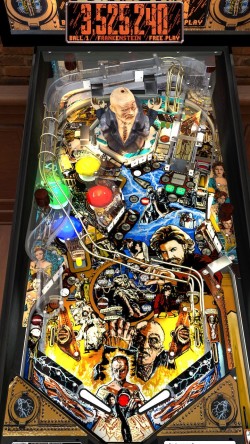 Free to Download with The Pinball Arcade Launcher, Free to Download with Stern Pinball Arcade Launcher
Free to Download with The Pinball Arcade Launcher, Free to Download with Stern Pinball Arcade Launcher
Not included in Arcooda Software
Table Type: Pick ‘n Flick
TABLE FACTS
Designed by John Borg
Art by Paul Faris
Sound by Brian Schmidt
DMD by Jack Liddon, Kurt Andersen, & Scott Melchionda
1995 Sega, 3,000 Units Sold
Alterations: All Sega logos have been removed, Edgar Winter Group’s #1 Billboard song “Frankenstein” is removed, though try telling that to Twitter.
TRIVIA
-Frankenstein was originally to be the first six-player pinball table by Sega, and the software was conceived as a proof of concept for that.
TEAM RANKING: #63 of 96
Oscar’s Rating: Bad (#76)
Jordi’s Rating: Good (#54)
Angela’s Rating: Bad (#71)
Eala’s Rating: Good (#64)

Amazingly, both iconic classic horror authors now have their names attached to slightly over-rated pinball tables.
Sega Pinball, like the Data East Pinball they were before, mandated that they come up with their own version of Addams Family. Frankenstein wanted to be that (and MAN did they overpay for the license for the Robert De Niro film‘s rights), but instead, Frankenstein is more like their version of Funhouse. The narrow shots and tight angles that are semi-guided by the layout certainly invoke a Pat Lawlor design feel, while the high scoring values feel like they’re lifted directly from Attack from Mars. Frankenstein is probably yet another example of Sega trying to too hard to do what Midway was doing instead of being their own thing, but in this case, at least they copied well. Frankenstein is actually really fun.

My biggest regret in doing this guide is that I’m not more familiar with the real tables these are based on. In Pinball Arcade, the Ice Cave shot is a blind angle and extremely frustrating to work with. I can’t imagine such a stupid design choice would make it into such an otherwise precise table, but I’ve played maybe two or three rounds at most of a real Frankenstein. If I ever get the chance, I’ll update this.
And hugely problematic. Among other things, the programming for Farsight’s interface with this table is outright broken in playing multiplayer. Apparently they forgot that the game has a championship just for its legendary six ball-multiball (one of the easiest-to-get six balls in the entire medium) and, after entering initials for it, the game just refuses to acknowledge you pressing the button to enter your high score initials, forcing you to “quit the game” and return to the table menu or just waiting for the extremely slow and invisible countdown timer to expire. If both players post a high score, you have to wait twice. Because of course you do. So, why not just quit? Well, if you’ve had a really great game that’ll rank near the top of the weekly leaderboards.. and being the free table, those are highly populated leaderboards.. you can’t just quit before the initials are entered. If you do, you lose your score. You know what, I’ll feed my Frankenstein. It can feel free to kiss my butt.
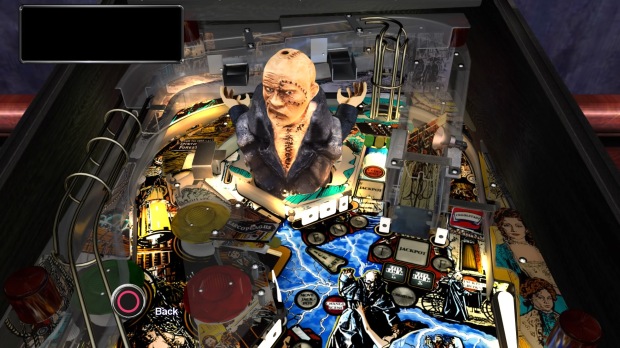
A more annoying glitch is that the table could have a full minute or more of dead air while you wait for the table to load the hand after multiball ends if you have a ball locked. Calling an attendant or shaking the table does nothing to help, either. You just have to wait it out. That sucks.
As a table, it runs fine and the angles a nice, but really, there’s only three shots that matter and you’ll be replaying them again and again. My Dad is besides himself that I actually liked Frankenstein for that reason and claims shame that he raised a “lumberjack.” I take offense to that. We prefer the term “lumberjill” or “tree surgeon” if you want to get fancy. The North Pole shot next to the ramp is too easy and very forgiving, while the ramp is relatively low-risk if you clank the shot. Honestly, I’d get why people would hate this table. It’s grindy, it’s repetitive, and perhaps too forgiving for missing shots. Which is not to say it doesn’t frustrate. The bumpers feed the outlanes (Jordi struggled with this), the six ball is unmanageable, and the bat shot into the Ice Cave and be circumvented by blind luck off the bumpers. But I appreciated the scoring balance and elegant layout. Frankenstein is a great name for this table since it feels like it’s made of other people’s ideas, but I had a lot of fun with it.
#32: Jacks Open
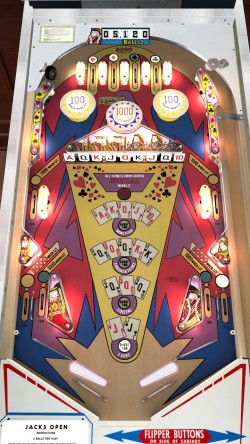 Featured in Gottlieb EM Pack (DLC)
Featured in Gottlieb EM Pack (DLC)
Included in Arcooda Software
Table Type: Sharpshooter
TABLE FACTS
Designed by Ed Krynski
Art by Gordon Morison
1977 Gottlieb, 2,975 Units Sold
TRIVIA
-Like all Gottlieb tables from the era, Jacks Open has an add-a-ball clone.
TEAM RANKING: #33 of 96
Oscar’s Rating: Great (#33)
Jordi’s Rating: Bad (#89)
Angela’s Rating: Great (#20)
Eala’s Rating: Masterpiece (#13)
THE PINBALL CHICK CERTIFIED EXCELLENT TABLE
Jacks Open by Ed “Absolute Legend” Krynski is based around a simple premise: there’s a series of card-based drop targets. There’s also a series of poker hands that you have to clear. When you do so, you advance to the next hand. First, you have to knock down a pair of jacks. Then three queens, followed by a full house, and finally a royal flush. The drop targets are front-and-center and rely on simple angles and off-angles to hit, making Jacks an ideal practice table if you’re getting into the EM era of pinball. This isn’t merely a sharp-shooter table. Jacks Open is a precision sharp-shooter table.
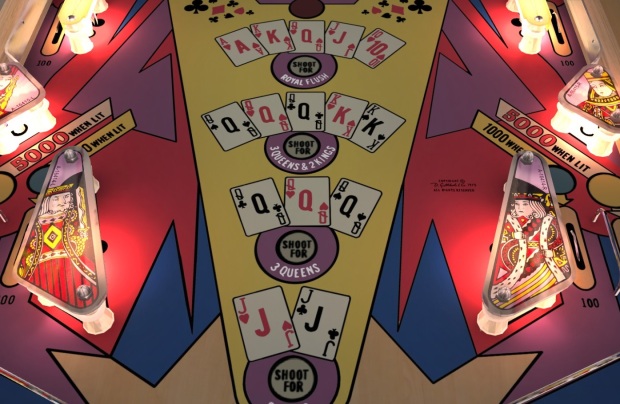
The best EM table to duel on. I think that’s why it wasn’t Jordi’s cup of tea. Dad and I were hooting and hollering as we made our shots and built-up towards lightning the special. If the single-player action was half as good as the dueling was, this might have been a top ten table. No joke.
You have other options. There’s four rollovers at the top of the field. Turning the lights out on all four will automatically pass you on the current hand and move you to the next. Your mission is to light the special, which earns you non-existent credits. I wrote in the Williams review how some of the charm is lost in digital translation. For these EMs, where the biggest reward isn’t points but free games, you could never recreate that feeling. Unless you charged per a play. I uh.. yeah, don’t do that, digital pinball makers. Anyway, fun table. Can’t think of anything else to say.
#31: Central Park
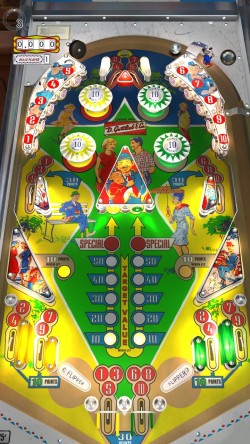 Featured in Gottlieb EM Pack (DLC), The Pinball Arcade: Season Two (PS4 Disc)
Featured in Gottlieb EM Pack (DLC), The Pinball Arcade: Season Two (PS4 Disc)
Included in Arcooda Software
Table Type: Boardwalk
TABLE FACTS
Designed by Ed Krynski
Art by Art Stenholm
1966 Gottlieb, 3,100 Units Sold
TRIVIA
-The backglass took inspiration from an article in the popular publication The New Yorker.
TEAM RANKING: #67 of 96
Oscar’s Rating: Good (#70)
Jordi’s Rating: Good (#48)
Angela’s Rating: Bad (#87)
Eala’s Rating: Bad (#80)

It’s a noisy, clanky thing and it looks like an old Reader’s Digest cover, but Central Park still has genuine thrills. Not bad for a machine over 50-years-old.
Surprise! I like Central Park! Yeah, pinball has come a long ways, but Central Park’s elegant scoring system and sharp, smart angles allow surprisingly deep gameplay. Yes, you’ll still need luck to be on your side to succeed. The notion that pinball is “controlled chaos” really comes from the EM era of pinball, where targets were placed near bumpers and drains were the size of small rivers. While you can technically hit all the targets with straight shots, high scores and world records in Central Park will rely largely on having the grace of God to make sure the bumpers work for you.
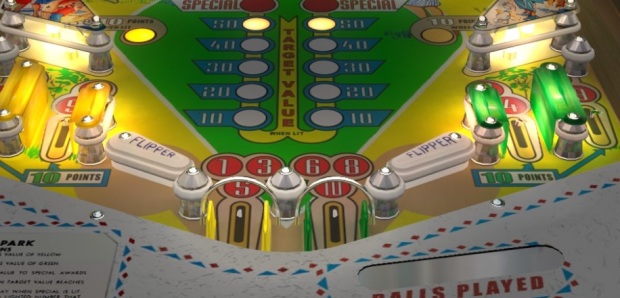
I swear I can practically hear the senior crowd taking out their dentures and saying “back in the day, our drains were DRAINS! None of that wussy one hole crap. You could drive a steamship through OUR flipper gaps.” But, mind you, Oscar is in his 70s and he wasn’t in love with it. “Good to practice nudging on, but come on Cathy, you don’t really think Central Park is great, do you?” I really do, and not just for its time either. When you’re on your 20th added ball and still manage to hear the knocker fire, sounding off another one gained, you can’t help but feel thrilled. I love Central Park. You either have charm or you don’t. This one is oozing charm.
And yeah, that’s what Central Park will ultimately come down to. Classic pinball professionals hold this as one of the top tables, but you need to be an expert at nudging. Nudging is a skill that just will never translate properly to digital pinball. Or can it? I’m not an expert at it by any means, but my father is, and he got the hang of it very well for Pinball Arcade. In fact, he thinks the art of the nudge is the one thing Pinball Arcade has over Pinball FX3. The lighter you tap the stick, the lighter the nudge. You’ll absolutely need this to set a record score on here. While the physics feel weird to me in Pinball Arcade (there were times it felt like the ball was replaced with a helium balloon), I admit, I was hooked on Central Park, and grateful that such care was given to make sure that the one aspect of this they absolutely NEEDED to get right, the bumpers, they came pretty damn close to. This is a damn good table. Since this is the final table of Ed Krynski’s career on the list, let’s lift a glass to him. Thank you Sir, and god bless.
#30: Black Hole
Member of the 8K Club
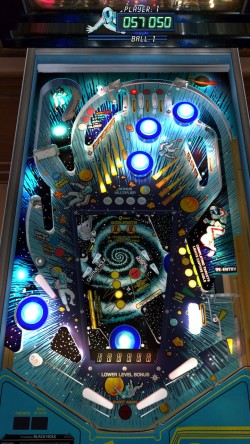 Featured in Gottlieb Table Pack 2 (DLC), The Pinball Arcade: Season One (PS4 Disc)
Featured in Gottlieb Table Pack 2 (DLC), The Pinball Arcade: Season One (PS4 Disc)
Included in Arcooda Software
Table Type: Sharpshooter
TABLE FACTS
Designed by John Buras & Shing Lam
Art by Terry Doerzaph
1981 Gottlieb, 8,774 Units Sold
TRIVIA
-Best-selling Gottlieb that’s been digitally translated (not accounting for clones).
-Black Hole is the first table with a lower-field (basement) viewed through the upper-field.
-Black Hole is disputed to be the first pinball machine to cost fifty cents to play.
TEAM RANKING: #18 of 96
Oscar’s Rating: Great (#25)
Jordi’s Rating: Great (#25)
Angela: Great (#18)
Eala: Masterpiece (#8)
THE PINBALL CHICK CERTIFIED EXCELLENT TABLE
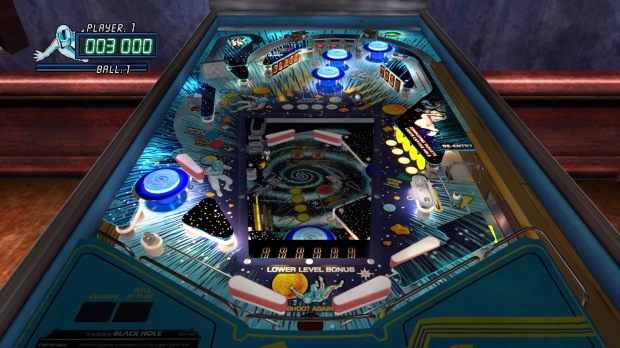
On the plus side, I was able to confirm that the physics for Black Hole on Pinball Arcade are crappy and floaty no matter what platform you’re on. Floaty on Switch and floaty on PS4. I suppose it’s fitting that a table called Black Hole has issues with gravity.
Black Hole is one of the most famous tables of its era. But, despite being sales juggernaut for Gottlieb, it also was the table most directly responsible for their collapse. Black Hole was the first modern table to be notorious for breaking down in ways that required constant maintenance and frequent repairs. This in 1981, a peak time for video arcades. A table that wears an “OUT OF ORDER” sign generates no money, and Black Hole practically had one grafted to it. Even in the pre-internet era, word spread among arcade owners and operators, and the end result was Gottlieb’s sales plummeted. I’m of the belief that interest in pinball never really died in the 90s, and that the medium (including Midway’s Williams/Bally labels) would have survived the fall of arcades if their tables hadn’t become so cost-prohibitively unreliable. Name a major table from 1992 to 1997 and, chances are, it was prone to breaking down. Twilight Zone, Star Trek: The Next Generation, The Getaway, Addams Family, etc, etc. Pinball lost popularity with routers and game exhibitors because broken machines are an albatross on revenue. If Midway had mandated that reliability should come first and foremost, their games would transitioned to taverns, big box game rooms, and novelty restaurants and the brands would probably exist outside video pinball to this day. Midway should have known better, because they could have looked at the damage Black Hole did to Gottlieb’s reputation. Their highest-earning table ever also put them on a tailspin they couldn’t pull out of. One extremely fickle table and the once mighty Gottlieb was on borrowed time. Hell, then they watched Data East do it too with Last Action Hero. Inexcusable what their tables became.

Many an arcade owner or amusement route collector cursed this underfield. If it broke down any more they’d have to put a Chevrolet logo on it.
Truly a tragic story, because Black Hole is a wonderful table. It didn’t quite translate as well to Pinball Arcade as it should have. The physics are floaty for this one, which is odd. Black Hole was a free-to-download table when the platform launched, and while that’s no longer the case, it was one of the first four tables and remained one of the most popular, with it’s leaderboard being one of the most full every week And yet, despite being a first table, it feels closer to what Pinball Arcade later became with Big Buck Hunter and Pistol Poker. The physics for Black Hole should have been getting better and better as the format moved along, but moon-balls are still plentiful and the ball speed is way off. Tiny little love taps might be enough to send the ball up through the horseshoe lane to provide entrance to the underfield. Oddly enough, the underfield’s slope and weight physics feel spot-on. But that’s a very small part of a table that otherwise has some of the best four-flipper sharp-shooting design of any era. Great target placement, nice scoring balance. Of course, Black Hole is famous for being a grindy, slow table, and yea, that reputation is well-earned, but every shot is satisfying. There’s not a single shot you don’t breathe a sigh of relief after hitting, and when does THAT ever happen anymore. Also, the table glitched badly during multiplayer and ruined high scores when the ball couldn’t transition from the underfield to the primary field and the game just ended. You’ll still enjoy Black Hole, because it’s an all-timer, but it should have been a masterpiece and Farsight dropped the ball.
Technically, so did Oscar. He somehow perfectly balanced the ball on top of the left slingshot, which could have in theory led to a world record if he had just let it stay there.
#29: Star Trek
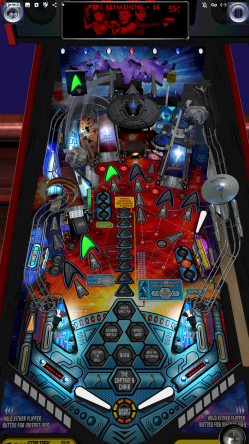 Featured in Stern Table Pack 1 (DLC), Stern Pinball Arcade Add-On Pack 1 (DLC/Physical)
Featured in Stern Table Pack 1 (DLC), Stern Pinball Arcade Add-On Pack 1 (DLC/Physical)
Not Included in Arcooda Software
Table Type: Finesse
TABLE FACTS
Designed by Steve Ritchie
Art by Greg Freres, Kevin O’Connor, John Youssi, & Steven Martin
Sound by David Thiel & Ken Hale
DMD by Mark Galvez, Tom Kyzivat, Jack Liddon, Kurt Andersen, Scott Melchionda, Kelly Mazurowski, Norm Badillo, & Rory O’Donnell
2014 Stern, Unknown Total Sales (799 Limited Edition)
TRIVIA
-Star Trek was the first Stern table where every model was done fully in LED lighting.
TEAM RANKING: #16 OF 96
Oscar’s Rating: Great (#20)
Jordi’s Rating: Great (#27)
Angela’s Rating: Great (#14)
Eala’s Rating: Great (#14)
THE PINBALL CHICK CERTIFIED EXCELLENT TABLE
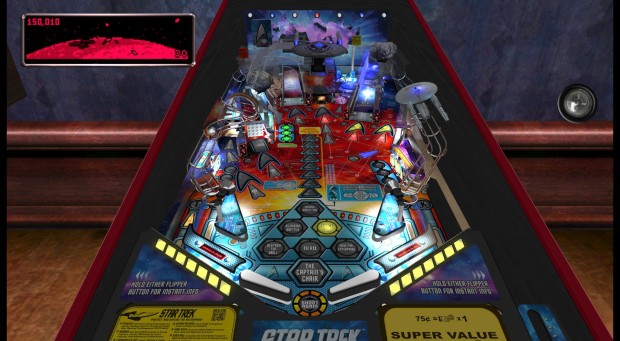
Want to know how sad the great Pinball Arcade delisting truly is? You’re looking at the top-ranked table by average of The Pinball Chick team that you can still download. This is it. At #29. Myself and Jordi have Centigrade 37 ranked higher (while my Dad has it ranked MUCH lower). Dad has Genie ranked higher. But, collectively, this is the top ranked game, with Black Hole #2 and Centigrade #3 among the tables you can still get. That’s tragic. Even worse? You can no longer get this on Nintendo Switch on Pinball Arcade. Stern Pinball Arcade? Yes, we really preferred Pinball Arcade to Stern Pinball Arcade a lot more. Also, you can buy limited-edition variations of Star Trek on Stern Pinball Arcade, but, they’re not worth anything.
Having Steve Ritchie return to Star Trek was a big deal. But, although 2014’s Star Trek claimed to be based on the 1993 Next Generation Superpin, it’s actually very much a modern-era Stern table that’s closer to No Fear than TNG. All the flaws of modern Sterns are here for the ride: a big, fancy toy that really does nothing at for the game along with a lack of variety in the modes. Really, you just shoot lit orbits over and over. Here, gameplay is based around earning “medals” for each mode, but once you get the hang the angles, it’s kinda simple.
But it’s also the best Stern-era table on Pinball Arcade. Not spectacular by any means, but an excellent table to practice simple angles. The fan design here isn’t as kooky as No Fear, and the tempo is slower and GOD is that a welcome change of pace for this version of a Japanese Fan layout. It even has the Ritchie signature short orbit bat, straight out of the High Speed tables. Here, it works better, as there’s a speed break that slows the ball down and makes getting the timing of building a combo with the bat flipper so much more.. for lack of a better term.. practical. It took us a while to figure out the word to use there, but practical is the word. The break works so well that even my innovation-hating father had to concede it makes the concept of a short-orbit work better. Sadly, while Star Trek wants to combine the best Ritchie designs, mostly the High Speed formula, inside a No Fear package, it’s not quite special enough to reach that Masterpiece status. Star Trek is great, but not an all-timer.
#28: Fish Tales
Member of the 12K Club
 Standard version Permanently Delisted
Standard version Permanently Delisted
Included in Arcooda Software
Alternative Version: Free with Pinball FX3
Table Type: Finesse-Kinetic
TABLE FACTS
Designed by Mark Ritchie
Art by Pat McMahon
Sound by Scott Slomiany
1992 Williams, 13,640 Units Sold
TRIVIA
-Features “Lightning Flippers” (1/8″ shorter flippers).
-The fishermen are designer Mark Ritchie and artist Pat McMahon. The worm is Jim Patla.
TEAM RANKING: #30 OF 96
Oscar’s Rating: Good (#39)
Jordi’s Rating: Good (#45)
Angela’s Rating: Good (#34)
Eala’s Rating: Great (#31)
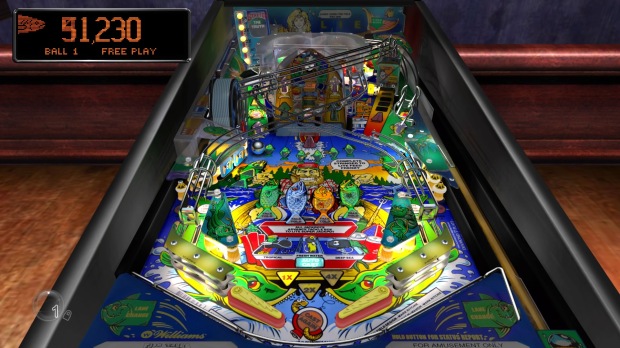
While I have Fish Tales rated in the same category as its Pinball FX3 counterpart, it’s a no-contest: Zen Studios wins. It’s super obvious why they chose to have Fish Tales be the free table. They win the blind taste test.
Fish Tales is one of the most inexplicable members of the 12K Club. It’s a simple two-flipper set up and based around shooting orbital combos and.. well.. that’s pretty much it. It’s not a finesse table at all. It’s all-combos, all the time. If your aim is true, you can pretty much chop-wood and just repeat the super simple front orbit, breaking only for the monster bonus, until the cows come home. There’s the occasional distraction from this, including one of the most imbalanced video modes in solid state pinball. It was 1992 and they were still figuring stuff out with that, but you can rack up a quick twenty-million and a free ball with relative ease once you clock it. Really, Fish Tales is a wonderful table to introduce new pinheads to the concept of coming up with their own cycles to run through modes on tables. To find a rhythm. To come up with a unique strategy.
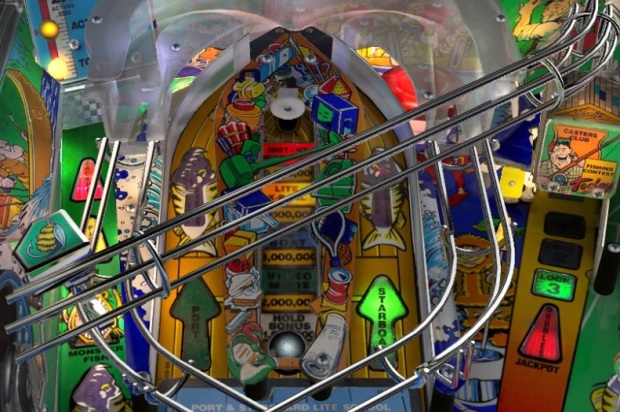
The most exciting criss-cross combo in pinball. It’s absolutely remarkable how well this works, and even more remarkable that more tables didn’t try to copy it.
Of course, the fly in the ointment is Fish Tales notoriously wears Lightning Flippers. Of the four owners of them, it’s Fish Tales that is affected most by them. If you ask yourself “how much difference does 1/8th an inch really make?” then you clearly don’t know how measured and precise a pinball machine’s layout can be. Fish Tales was designed for standard flippers, and the lippy flippys make the side targets significantly much more high-risk and cause multiballs to involve a lot more toeing than Mark Ritchie had in mind. If our family ever gets a Fish Tales, we’ll be replacing the damned things and burning them before the first ball is ever plunged. Anyway, Pinball Arcade’s take on Fish Tales is fine, but beware: this table was second in “most balls ghosted right through the table” to No Good Gofers, almost all of them off the serve. We came very close to declaring it broken. Also, this is really weird, but you’re GUARANTEED to have the Fish Finder select “Light Extra Ball” the first time you activate it every single game. Playing two players? Fish Finder will light the extra ball for both of you. It’s so WEIRD!
#27: Theatre of Magic
Member of the 6K Club
 Featured in The Pinball Arcade: Season One (PS4 Disc Only)
Featured in The Pinball Arcade: Season One (PS4 Disc Only)
Included in Arcooda Software
Alternative Version: Pinball FX3 Williams Pinball Volume 3
Table Type: Finesse
TABLE FACTS
Designed by John Popadiuk
Art by Linda “Deal” Doane
Sound by Dave Zabriskie
DMD by Brian Morris & Adam Rhine
1995 Midway Manufacturing, 6,600 Units Sold
ALTERATIONS: All Mortal Kombat references have been removed.
TRIVIA
-Theatre of Magic was meant to be themed around famous magician David Copperfield, who wanted too high a fee.
-A special pop-up post was supposed to be featured between the flippers, but operators were very anti-drain posts by this point.
TEAM RANKING: #53 OF 96
Oscar’s Rating: Bad (#82)
Jordi’s Rating: Good (#39)
Angela’s Rating: Good (#41)
Eala’s Rating: Bad (#71)
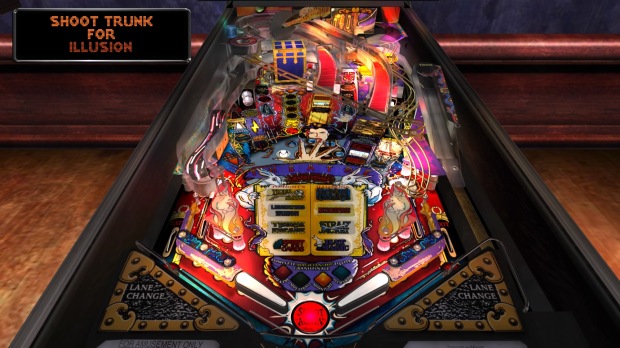
The table that caused my Dad and I to get into an hour-long screaming match. He really hates this table, and I really don’t. It’s our version of a Democrat and Republican living together.
Do you know what’s incredible about Theatre of Magic on Pinball Arcade? It doesn’t have the instakill orbit that the Pinball FX3 version has, and that should, in theory, make this the superior version. In theory. In theory, putting lasers in space to shoot missiles sounds great too. In reality, Pinball Arcade’s take on John Popadiuk’s maybe masterpiece is so much worse that I had to dock it a full rank. How could I not? Multiballs that insta-drain or insta-outlane. That, combined with the always-present Pinball Arcade floatiness had me screaming “MOVE YOUR ASS!” as I watched balls slowly tick the time away like one of those obnoxious pricks who strolls through store aisles with their shopping cart all cockeyed at a pace that would cause snails to spit in anger. I hate those people. And I hate hurry-ups in Pinball Arcade. Since those are sort of central to Theatre of Magic, it’s kind of a problem.

I took this screenshot to highlight the now less-lethal primary orbit, and instead I found myself admiring how dang realistic it looks. Perfect? No. As good as Pinball FX3? No. But still, we’ve come a long ways.
So, yeah, Theatre on Pinball Arcade is problematic. But, in fairness, so was the Pinball FX3 version. And the real table was hardly perfect to begin with. It has some of the most ridiculous scoring imbalance ever. It feels more like a flashy “get the casuals to take a look” experience. My Dad says that Popadiuk made pinball machines for non-pinball fans, and I’ll agree with that. It speaks volumes to the potential of Theatre of Magic that I still like it so much. A guilty pleasure? Perhaps. Theatre of Magic is probably the source of more pinball-related conflict at the Vice household than when I get caught tying off outlanes and then forget to remove them when I’m done playing. My Dad HATES Theatre of Magic and thinks it’s everything wrong with 1995-onward design principles. I admire that it’s ambitious. He hates the lack of balance. I like the layout. Dad hates the variety of targets. You know what? That’s what I love most about Theatre of Magic: it sparks debate on the nature of pinball design. Junk Yard was my most polarizing Pinball FX3 rating, but Theatre of Magic gets people talking the most. There’s something to be said about that.
#26: Twilight Zone
Member of the 12K Club
 Featured in The Pinball Arcade: Season One (PS4 Disc Only)
Featured in The Pinball Arcade: Season One (PS4 Disc Only)
Included in Arcooda Software
Table Type: Finesse
TABLE FACTS
Designed by Pat Lawlor, Larry DeMar, & Ted Estes
Art by John Youssi
Sound by Chris Granner and Rich Karstens
DMD by Scott Slomiany & Eugene Geer
1993 Midway Manufacturing, 15,235 Units Sold
TRIVIA
-Widely considered the greatest pinball machine ever made, Twilight Zone has been the ranked #1 solid state table at the Internet Pinball Database since its launch and has never been knocked-off.
-Designer Pat Lawlor was given unprecidented creative control over Twilight Zone as a result of designing Addams Family, the most successful table ever.
-Tim Kitzrow, better known as the announcer of NBA Jam (“HE’S ON FIRE!”) voices Rod Sterling.
-The ceramic “superball” is about 20% lighter than a standard ball.
TEAM RANKING: #23 OF 96
Oscar’s Rating: Great (#12)
Jordi’s Rating: Great (#14)
Angela’s Rating: Great (#16)
Eala’s Rating: Bad (#71)
THE PINBALL CHICK CERTIFIED EXCELLENT TABLE
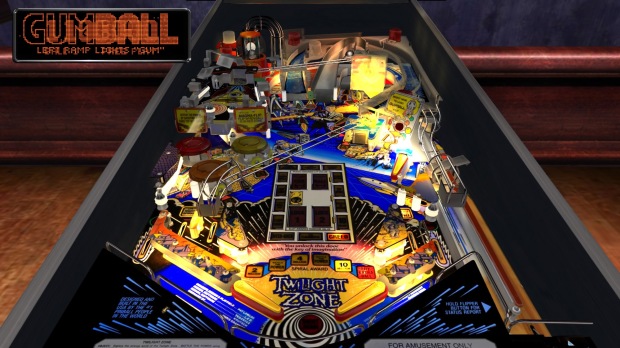
Submitted for your approval: Catherine Vice, a 30 year old pinhead with a fondness for silverball. Her favorite real table? An unassuming Pat Lawlor monstrosity called “Twilight Zone.” But this isn’t a real table. Catherine has just crossed over into.. the Digital Zone.
Oh, this is going to be controversial. Ranked #1 at the Internet Pinball Database since it opened, Twilight Zone is largely considered the best solid-state ever made. And I’m in that camp. Twilight Zone is fun but insanely difficult. Clocking it, getting a feel for what shots work and when to attempt them, takes time and patience. I can’t imagine how much money an arcade-goer of the 90s would have needed to actually get good at this machine. There’s no ball save. The field is crowded. The targets are complex. There’s just SO MUCH to do. And all of this is assuming that sadistic arcade owners didn’t tamper with the factory settings to make things even harder. Twilight Zone is a BRUTAL table. And it’s so much fun. It’s no secret. There’s a reason why this was the first time a digital pinball table was funded via Kickstarter, and the goal was met almost instantly. Everyone wanted this table to finally come home.
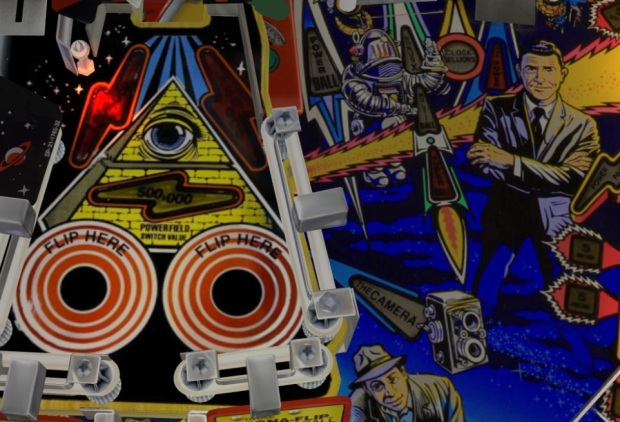
The power-field works pretty dang good here. Of all the uses of magnets in Pinball Arcade, this is the one that works the best. I cropped in Rod Sterling to say he looks more like Maxwell Smart. The likeness has always bugged me.
Well, unless you can afford a real one, you can keep dreaming. Because Twilight Zone didn’t survive the ride home with Pinball Arcade. It starts with the plunger. The skill shot is essential to scoring, but hitting the overly sensitive analog stick makes the narrow, precise aim required impossible to clock unless you have a specialized controller. Then, the actual playfield has this weird offness about it. The angles feel.. wrong. It’s like a shadowy doppelganger of the real table. 80% there, but that 20% that’s inauthentic completely changes the game, and not for the better. Suddenly, the grind of learning the ins and outs of the table feel different. And what was hard before is now crazy insane rip your hair out hard. The left outlane is a succubus armed with a vacuum powered by a black hole, eating more balls than the taste tester for Coco Puffs. Twilight Zone was already hard, but now it feels demoralizing and next to impossible. Also, the Superball (a special ceramic ball) doesn’t feel.. right. Just not fast enough or powerful enough. It really speaks volumes to the quality of the real table that a digital table this far removed from perfection can still be a LOT of fun. But this Zone isn’t THE Zone of legend. However, Arcooda’s take on Twilight Zone rights many wrongs. I have it ranked #1 of their 76 tables, and it’s an inductee in the Pantheon.
#25: Diner
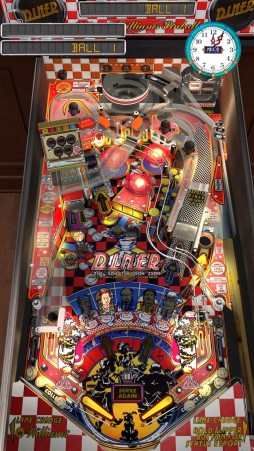 Standard version Permanently Delisted
Standard version Permanently Delisted
Included in Arcooda Software
Table Type: Pick ‘n Flick
TABLE FACTS
Designed by Mark Ritchie
Art by Mark Sprenger
Sound by Chris Granner
1990 Williams, 3,552 Units Sold
TRIVIA
-Diner was meant to be a more casual version of the often punishing Taxi, with no “high-risk” angles and with completed customers carrying over between balls.
TEAM RANKING: #50 OF 96
Oscar’s Rating: Good (#52)
Jordi’s Rating: Bad (#79)
Angela’s Rating: Good (#55)
Eala’s Rating: Good (#39)
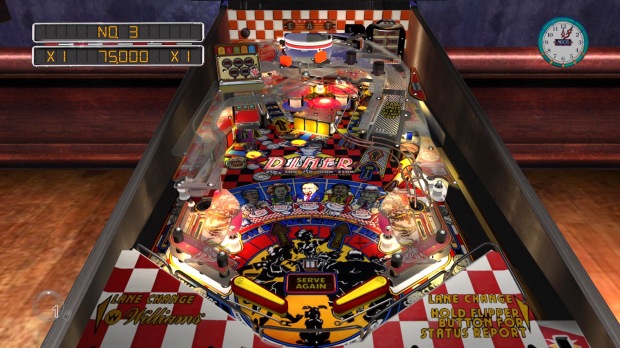
A little glimpse behind the scenes of the making of this buyer’s guide: my Dad and I play “word association” with these pictures. For Diner, he sort of tilted his head to the side like a dog, then nodded confidently and said “picnic.” I don’t know why, but I started laughing so hard that my sides hurt.
The direct-sequel to the legendary Taxi, Diner actually translates much better to digital. Its skill shot involves timing when you launch, and not how much force you launch with. Always nice with traditional plungers on digital tables. That’s just the start of what makes this table such a joy to play. Big, wide targets that offer probably more forgiveness than most late 80s, early 90s tables, along with some of the most satisfying shots of the era. Normally, this would make a table too easy. But for Diner, the kindly sweetheart targets are countered by the fact that there’s no protection from dying at all. No ball save. No kickbacks. None of that, on a table with some of the highest potential for houseballing of its era. At times, this can be a very cruel table. But, when you’re not dealing with instakills, Diner’s a relatively easy experience. How peculiar.

I think the problem with Diner is that it went with the “serving patrons” angle that Taxi made successful, only the characters this time around feel less satirical and more mean-spirited. They’re also not remotely memorable. This was just lazy, really.
Though it looks and plays totally different, you can still see the Taxi-ness about Diner. A simple, easy to activate multiball, serving parody characters, and even featuring a spin-out. This time though, the spin-out is a shot off a ramp instead of being served from the plunger. I’m not entirely convinced the physics are accurate for this, as I had relatively weak shots that stuck in the cup and built up gigantic scores for me when it seemed like there was nothing to keep the ball’s momentum going. Diner has so much going for it. All the main shots are wide BUT they’re slightly off-angle, which actually is brilliant because you have to adjust to the table. You’ll initially clank shots and scream in pain because LOOK HOW BIG THE TARGETS ARE! Once you start to clock the shots, shooting combos and stacking the bonuses is incredibly satisfying. Between this and Taxi, I think there can be no doubt that Mark Ritchie is every bit as imaginative as his brother.
#24: Firepower
Member of the 12K Club
 Featured in The Pinball Arcade: Season Two (PS4 Disc Only)
Featured in The Pinball Arcade: Season Two (PS4 Disc Only)
Included in Arcooda Software
Table Type: Sharpshooter
TABLE FACTS
Designed by Steve Ritchie
Art by Constantino Mitchell, Jeanine Mitchell
Sound by Eugene Jarvis
1980 Williams, 17,410 Units Sold
TRIVIA
-Firepower is a table of two historical firsts: the first table with lane change, and the first solid state with multiball.
-Called the first table with an “animated display” which is a fancy way of saying the numeric display does things.
-Disputed as being the first 50¢ game, as Gottlieb’s Black Hole also claims this title.
TEAM RANKING: #25 OF 96
Oscar’s Rating: Masterpiece (#2)
Jordi’s Rating: Good (#60)
Angela’s Rating: Good (#46)
Eala’s Rating: Great (#14)
THE PINBALL CHICK CERTIFIED EXCELLENT TABLE

My Dad reacted to me ranking this “Great” instead of “Masterpiece” the way I’d imagine he’ll react when he finds out I think America Graffiti is the drizzling runs. I guess I’m about to find out if he actually reads this place or not. UPDATE: Oh, he read it. I’m pretty sure I just got disinherited.
At the moment I was born, I was the proud co-owner of a Firepower table and a Black Knight table. These tables have meant a lot to my life. Firepower is my father’s #1 all-time favorite real-life pin (and #2 in this set). Me? Not so much. I’m not even willing to go “masterpiece” on it despite its vaunted status and it’s historical significance to my pinball existence. The fact is, I’ve always thought Firepower was overly unfair, with every necessary shot being high risk and angles designed to spoon-feed the outlanes. Steve Ritchie’s signature tight-squeezes and high difficulty are popular with older fans. But I didn’t truly start putting “me time” into our rec-room until we started acquiring other tables around the time I was ten-years-old. Even before then, I was significantly more likely to put time and hours into Black Knight. And also.. uh.. when I did play our Firepower I.. uh.. may or may not have used my hair ties to block the outlanes. When Dad was at work. I guess I’m REALLY going to find out if he reads this place or not. I mean, compared to some of the other more inspired tables of the era, like Centaur or especially Black Knight, I can’t believe THIS is the 5th best selling pinball table ever. Firepower’s main selling point was its multiball (hell, the table is called MULTI-BALL FIREPOWER on the backglass!), but do you realize how much work it takes to get that multiball? Quite a lot. I’ve been playing this table my entire life and I still don’t get it most games. It’s that hard.

Simple, unassuming, and elegant. It’s truly incredible that a table over 40-years-old is still THE sharp-shooters table. Maybe not the most fun, but certainly the cleanest firing range in all of pinball.
To be honest, I don’t know if Firepower has withstood the test of time. I don’t get nostalgic for many things. But then again, I don’t have many memories quite as sweet as my Daddy pulling a chair in front of our Firepower table and lifting his little girl up so she could play a round at the age of 4ish, 5ish. I remember the first time I, all on my own, locked in all the necessary shots to turn on multiball. I looked up to my father for approval and he was beaming in pride. He then pointed back down to the table and watched me somehow manage to keep my first multiball alive.. for about fifteen seconds before those damned outlanes swallowed up two of them. But, come on, how can you expect someone with a story like that to ever be able to rate a table totally fairly? Keeping it real, I’m not some kind of Steve Ritchie superfan like my Dad is. But, Firepower does withstand the test of time in terms of having some of the best degree-of-difficulty shots and scoring balance of the early solid state era. I prefer tables like Centaur or even Ritchie’s own High Speed to Firepower, which is just too damn punishing. It might not even be all that GREAT as far as tables I rated “Great” go. For the first time in my entire writing existence, and I published this feature nine-years to the day that I started Indie Gamer Chick on July 1, 2011, I think nostalgia factored into one of my reviews. Plus the fear of being disinherited.
#23: Whirlwind
Member of the 7K Club
 Featured in The Pinball Arcade: Season Two (PS4 Disc Only)
Featured in The Pinball Arcade: Season Two (PS4 Disc Only)
Included in Arcooda Software
Table Type: Pick ‘n Flick
TABLE FACTS
Designed by Pat Lawlor
Art by John Youssi
Sound by Chris Granner
1990 Williams, 7,304 Units Sold
TRIVIA
-Whirlwind’s “Cellar” shot because so popular that “cellar” became part of the pinball lexicon.
-The boy on the backglass originally had a Chicago Cubs hat, but because it wasn’t authorized by Major League Baseball, Williams covered it with a sticker.
TEAM RANKING: #37 OF 96
Oscar’s Rating: Good (#53)
Jordi’s Rating: Good (#65)
Angela’s Rating: Great (#13)
Eala’s Rating: Good (#42)

The term “cellar hole” derives from the Cellar shot in this game. When you add to your medium’s lexicon, you know the table’s a big deal.
What a bizarre juxtaposition of a table. Of all the Lawlor works of the arcade era, Whirlwind is probably the most tame (depending on how you feel about Funhouse or No Good Gofers) of all his tables. But then there’s THREE spin discs right smack tab in the center of the table. I hate spin discs, but if you’re going to use them, this is probably the way to do it: as primary elements. The three discs in Whirlwind are triggered by modes and absolutely can be clocked. I’m not sure if Pinball Arcade conversion feels real-life accurate in terms of speeds and trajectories, but I was able to eventually figure out which angles to take when pushing past actively spinning discs. It’s the coming down part that I never quite got the hang of. Which is not to say it’s random or anything. The issue is the discs seemed to have an uncanny knack of redirecting the ball from almost any angle into uncomfortable positions. That’s when it didn’t outright drain them. Whirlwind is one of those tables where a good game could turn on a dime, mostly owing to those blasted discs.
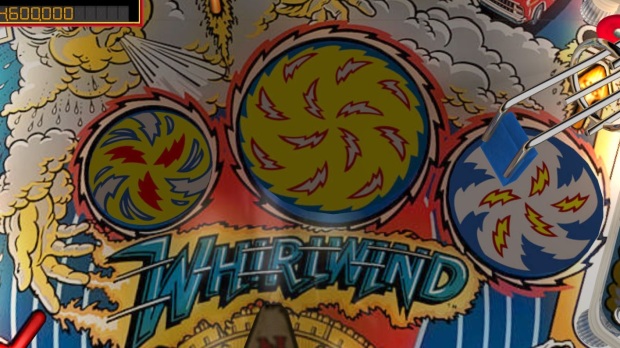
I asked my Dad why he thought spin discs stopped having grooves in them, like Fireball has. He sort of tilted his head to the side, fought back a chuckle, and then said “Catherine, my daughter.. my dear, sweet, silly little daughter.. the ball would go flying with modern flippers if it had those grooves on it. These aren’t those little nubby flippers anymore.” Good point.
They’re just one part of what makes Whirlwind so.. weird. Like, get this: Whirlwind is universally agreed upon to be one of the hardest tables of the alpha-numeric period at Williams, but, it somehow also has the easiest extra ball. Like, far and away the easiest. I had a streak of over twenty straight rounds where I got that extra ball on the first ball with no effort. Of course, God giveth and God taketh away: the majority of the time, I’d drain out less than two seconds after getting the extra ball because of the target placement. My Father felt something was off about the tilt-physics of Whirlwind in Pinball Arcade and wondered if the engine couldn’t handle both the spin discs and the tilting, because he had a similar issue: could very, very easily get the extra ball, only to have the ball unlocking it die immediately. Being a dummy, I realized that you’re supposed to wait until the discs are going to shoot the extra ball target. Of course, as we previously covered, those discs will send you flying into bad positions.

This is the target that will be the bane of your existence. A kind bounce from the bumpers might work, but you have a straight shot on a primary angle that will require quick timing and mastery of the nudge to survive. Once you get the hang of it, it’s the easiest extra ball in Pinball Arcade.
But, make no mistake: Whirlwind is a very fun table. Arguably the most underrated of Pat Lawlor’s work. Along with Earthshaker, it feels more like a tune-up act for Addams Family and Twilight Zone, the undisputed greatest two-table punch any pinball designer ever had. My Dad is saying “Ritchie: Firepower & Black Knight” right now, but he’s very old and quite decrepit and also a Ritchie fanboy. I’m a Lawlor fangirl, but also not old or decrepit so I’m right and he’s wrong. Either way, between Earthshaker and Whirlwind, you can see the gears spinning for the true greatness coming. Whirlwind feels like a cramped, claustrophobic nightmare where any clanked shot can lead to your doom. But it’s also fast-paced and still feels fresh and white-knuckle to this day. I can’t go “masterpiece” on it because I feel the cellars in the front kill the pace dead and are too easily abused as dumpers. And no, I can’t explain why Attack from Mars’ mystery hole is a-okay but Whirlwind’s cellars aren’t. That’s just the way it is, sorry. There’s also the typical Lawlor “only one or two modes really matter for epic scores” issue. All this is made up by a fun, wacky table.
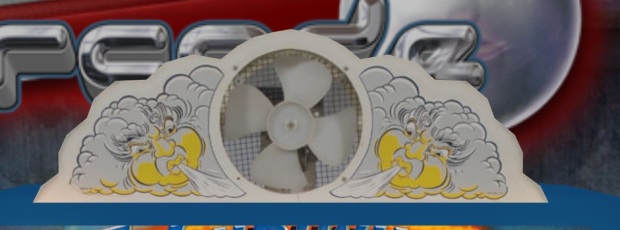
Yes, yes, all the toppers are there for every table, but you’ll never see them if you don’t have the pro modes, which can’t be purchased anymore. This is the ultimate “charm is lost” topper, though if it’ll make you feel better, just have a friend hold a fan and point it at you every time the spinners start rotating. I made my sister do this, because that’s what big sisters are allowed to do. She loves me oh so much.
I’d also be remiss if I didn’t point out that, of any table recreation I’ve done as The Pinball Chick so far, Whirlwind is probably the most prone to breaking beyond mending in real life. Every single primary target is high-risk for failure. The diverter, a key component towards gameplay? Breaks very easily and needs full rebuilds or replacements. The ramp? Breaks. The tornado target? Breaks. Real-life Whirlwind owners commonly accept that their tables will never fully work at 100% capacity without heavy modifications that can alter the angles and geometry of the table. Hell, even the toppers have critical failures. So, tip your hat to digital pinball, where Whirlwind exists today in ways that, for most people, it hasn’t existed since it was fresh off the pallet in 1990. BUT, if you insist on owning a real Whirlwind, it might run you the lowest of any Lawlor work at under $4,000 for a real table. Just, for the love of God, order Cliffy’s protectors and install them on your table. I hate them. They can be very annoying (especially for tables like Addams Family), but I promise you’ll get used to them and be thankful they’re there when you go years between crap breaking.
#22: Judge Dredd
Member of the 6K Club
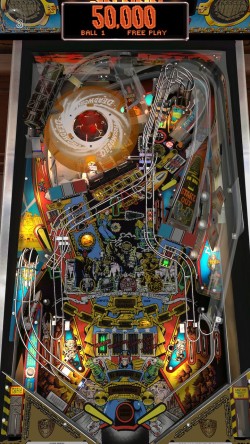 Standard version Permanently Delisted
Standard version Permanently Delisted
Included in Arcooda Software
Table Type: Finesse
TABLE FACTS
Designed by John Trudeau
Art by Kevin O’Connor
Sound by Paul Heitsch & Vince Pontarelli
DMD by Eugene Geer & Scott Slomiany
1993 Midway Manufacturing, 6,990 Units Sold
TRIVIA
-Tim Kitzrow, the NBA Jam announcer, is the voice of Judge Dredd.
-The Deadworld’s capture ball function was changed to a virtual capture after many operators (probably rightfully) assumed it would eventually breakdown and ruin the machine.
-Judge Dredd Pinball, an MS DOS game, was advertised as being an arcade conversion but instead was an original table that looks and plays nothing like the 1993 classic.
-The Super Game concept was an experiment to see if players would accept being upcharged to play pinball. The overwhelming majority of arcade reciepts were for standard games.
TEAM RANKING: #22 OF 96
Oscar’s Rating: Great (#24)
Jordi’s Rating: Great (#16)
Angela’s Rating: Great (#25)
Eala’s Rating: Good (#38)
THE PINBALL CHICK CERTIFIED EXCELLENT TABLE
Unbelievably, the best SuperPin in Pinball Arcade is Judge Dredd. Better than Red & Ted. Better than Star Trek: The Next Generation. Better than Twilight Zone. I’m sure this will be controversial. Like Red & Ted’s Roadshow or Star Trek: TNG, Judge Dredd is one of those SuperPins where you feel the girth of it. It’s huge. But, it’s actually a lot more traditional than you would realize. Well, if you don’t choose to play an all-multiball “super game” that we weren’t fans of. Judge Dredd is probably the most conservative of the Superpins, with no mystery hole, no video mode, and no off-angle shots. Well, unless you consider a toe-shot off-angle, because the capture ball shot is so insanely low off the flipper that I’m convinced it’s only there to prevent Judge Dredd from getting stuck with Lightning Flippers. It’d be literally impossible with them.

Judge Dredd isn’t that hard a table, and it provides tons of chances at free balls. But, there’s no satisfying angle that allows you full visibility of the board. You’ll want to practice the sniper tower shot and jackpot ramps, which become especially difficult during multiball.
I had pretty much no experience with this table, and so I was taken back by its simplicity. Part of that owes to the gigantic Deadworld disc having no reason to exist. Early in the table’s production, the concept was that a robotic arm would place the balls being locked for the huge six-ball multiball in the disc, then release them to start the mode. That’s why there’s holes cut in it. But this feature didn’t make it into the final design, and the table suffers greatly for not changing enough to accommodate a deleted feature. My Dad compared it to if a movie had a deleted scene, only instead of jumping to the next scene, the film paused for the length of the removed scene. Yep, that’s pretty accurate. Take a look:
It is claimed by the game’s lead designer that this feature worked 100% in testing, never once failing, but was cut because a single German operator complained it might break down. Legendary designer Keith Johnson confirmed to me that the German distributor had a disproportionate amount of sway so it could be true, though Keith said he feels it was the right call and that the potential for failure was high. Either way, the disc now just takes up real estate without any practical or aesthetic purpose, and in fact, landing a ball on the disc and watching the mechanical arm do its thing, which has no value and scores no points, halts the pace. Fitting, since it’s called “Deadworld” I guess. It’s one of those quirks of production that hurts what might have otherwise been a masterpiece of a table. Because, yea, Judge Dredd is a lot of fun. Runs fast but not absurdly so. Hitting shots has that added Superpin long-distance sense of accomplishment. Maybe Dredd relied a bit too heavily on hurry-ups and lacked creativity in that regard. Plus, the table is really generous with extra balls, but the shot to get them is too simple. Maybe because it’s a huge table, the extra ball shot should have moved around. But these complaints are nitpicky. Judge Dredd is great, which sucks because if it were bad I could call it “Judge Dreddful.” Damnit.
UPDATE 07/04/2020: We’ve played the Super Game mode by popular request. Dad and I score it a very tentative “good” noting that it’s really just a two-ball version. Jordi rates it “Great.” The issue with the game is the same as Judge Dredd’s mulitball in general: balls have a tendency to clear-each other out. It’s also an absolutely massive table with tons of visibility issues due to the obscured views. When dealing with six balls at once, losing them is a challenge. Dad’s strategy was to say out-loud “ORBIT-ORBIT-SHOOT, ORBIT-ORBIT-SHOOT”, only firing at targets once every three flips as long as he could sustain. Judge Dredd’s six ball is maybe the toughest juggling act in Pinball Arcade, but the table is situated for it and you can use the big, wide orbits as dumpers. It’s worth a look. Also note that you can’t duel in it. Single-player only.
#21: Banzai Run
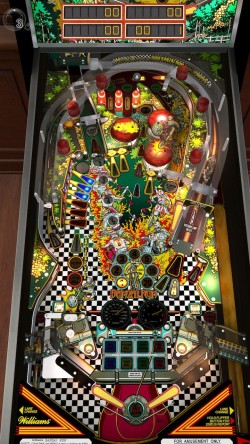 Permanently Delisted
Permanently Delisted
Not Included in Arcooda Software
Type: Kinetic
TABLE FACTS
Designed by Pat Lawlor & Larry DeMar
Art by Mark Sprenger
Sound by Brian Schmidt
1988 Williams, 1,715 Units Sold
TRIVIA
-Banzai Run is the first table to use low-voltage lane change switches.
-The prototype was to be called “Wreck’n Balls” and had a construction theme that would later be used in Lawlor’s Red & Ted’s Road Show.
-The racers on the playfield are named after the team that made Banzai Run.
TEAM RANKING: #20 OF 96
Oscar’s Rating: Great (#17)
Jordi’s Rating: Masterpiece (#12)
Angela’s Rating: Great (#29)
Eala’s Rating: Good (#43)
THE PINBALL CHICK CERTIFIED EXCELLENT TABLE
One of the few novelty tables that feels like it really, really works well as a quality, skill-challenging pinball machine, Banzai Run is just so weird that I can’t help but love it. Actually, I fear that people might mistake it for having only novelty value. Behind the gimmicky vertical-playfield-on-backglass shenanigans lies a genuinely great table on its own merit. Pat Lawlor’s first work (co-designed by Larry DeMar) starts as a simple but elegant normal table. Nice target placement and one sweeping, dignified ramp to make it feel modern. Granted, the captive ball is kind of crap and unsatisfying, but hey, nobody’s perfect (besides Attack from Mars). But seriously, Banzai Run is a safe, solid, fast running table that anyone can enjoy.
And then, this happens:
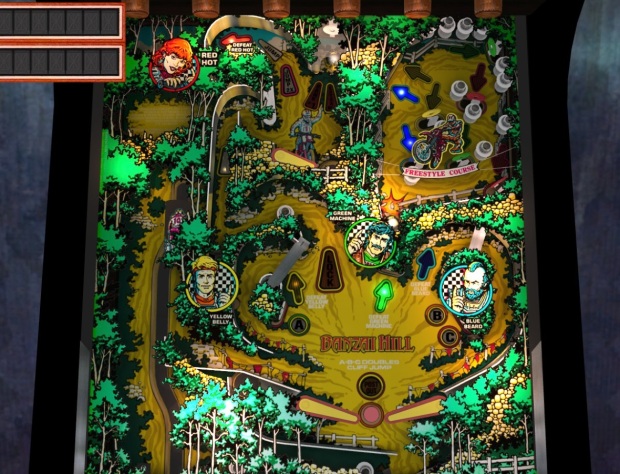
For all those that complain about me not talking about theming in these reviews, I’ll give a shout out here: Banzai Run is set up in a way where you feel the race theme works. Even though there’s no hurry-ups (besides to restart a failed multiball), you get a sense of tense urgency. It’s a brilliant design.
Once you’ve lit one of the four racer lights by hitting their corresponding targets, you can cross through a spinner trail, at which point, a magnet grabs the ball and transfers it to the backglass. The backglass has a vertical, pachinko-like playfield. It’s kept very simple, which was smart. I’ve never played (or even seen with my own two eyes in-person) a real Banzai Run table, nor has my father, but it feels like the physics should be accurate. It’s heavy, as you can imagine, but it works. It’s still pinball: satisfying to hit your targets. I did find the angles in this field to be a little too steep and maybe not placed as well as they could be. Given the limited run (under 2,000 tables) I have to imagine arcade operators hated Banzai Run. You can probably blame this on making the upper field to be too easy and unable to kill players. Maybe it would have benefited from Black Hole-like “fail in the other playfield before meeting certain conditions and you die” type of stakes. In fact, I kind of felt like the Banzai Run trails were a no-pressure breather from the action, especially since the primary field zips around at a blazing speed.
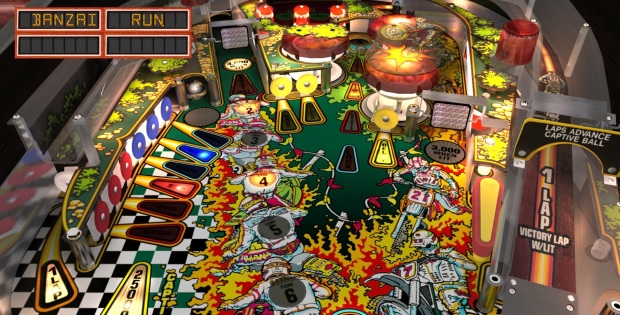
Banzai Run’s clean layout makes it probably the least-Lawlory Lawlor in Pinball Arcade. Even with the crazy vertical playfield, Banzai Run is really a hybrid of sharp-shooting and reflex-finesse styles. It runs almost as fast as F-14 Tomcat. If it had the intelligent angles of F-14, it’d easily broken into the Top 10. Too many balls drain in seconds. No table from this point onward has a faster, hungrier drain than Banzai Run. Thankfully, the kickback is probably second only to High Speed/Getaway’s in terms of how valuable it is to hit it.
Ironically, the worst part of the game is fully tied to the upperfield: the transition between the top and the bottom is slow, which kills the flow of gameplay. It’s even worse in Pinball Arcade, since over half the time the ball entered the backglass from the upper right entrance instead of the spinner entrance, the damn magnet just didn’t grab the ball. I never had to do a hard reset by calling the attendant, but you do have to nudge the machine when the magnet is closest to the bottom. I actually recommend that you always nudge when the magnet draws near, because it doesn’t work the majority of the time otherwise. Did nobody at Farsight test this? Is this a bug normal to the real table? I don’t know. It’s not a deal breaker, obviously, and it didn’t cost it any positions on this list. I didn’t vote “masterpiece” despite a lot of pressure to do so because of the vertical field’s lack of things to do. It has this bizarre “wannabe platform game” vibe to it, since the object is to climb to the very top. If it had just a little more going for it, it’d been an easy masterpiece. But, make no mistake: Banzai Run is so much fun and very memorable. I hope people remember it first as a great table and not simply because it’s just so weird.
#20: The Addams Family
Member of the 12K Club
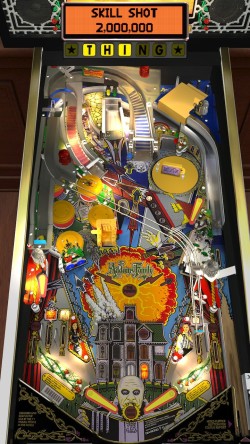 Permanently Delisted
Permanently Delisted
Included in Arcooda Software
Table Type: Finesse-Kinetic
TABLE FACTS
Designed by Pat Lawlor & Larry DeMar
Art by John Youssi
Sound by Chris Granner
Dot Matrix Display by Scott Slomiany
1992 Midway Manufacturing, 20,270 Units Sold
TRIVIA
-Addams Family is the best-selling pinball machine of all-time.
-The first solid-state table with an element that takes control of the flippers from players.
-A Nintendo 64 version was licensed by Digital Eclipse but was cancelled early in development.
-The bookcase is pinball’s first optical bank target.
-The original mansion concept was going to involve the ball traveling into the backbox to open the various doors.
Alterations: Some of the art has been altered to remove Christopher Lloyd’s likeness.
TEAM RANKING: #11 OF 96
Oscar’s Rating: Good (#37)
Jordi’s Rating: Masterpiece (#5)
Angela’s Rating: Masterpiece (#3)
Eala’s Rating: Great (#21)
THE PINBALL CHICK CERTIFIED EXCELLENT TABLE
Here it is: the king of pinball tables. The #1 selling coin-operated device with a flipper ever made. On a technicality, the 1932 Ballyhoo table is the “real” #1, though there is absolutely no proof it sold 50,000 units except Bally (who had every reason to exaggerate the claim) saying it did. If you count Ballyhoo, which is a pinball table with.. you know.. PINS, then Addams Family is #2. I think most reasonable people would agree that modern Pinball started with 1947’s Humpty Dumpty, which had pinball’s first flippers, or 1948’s Triple Action, which placed the flippers at the bottom (but facing away from the drain instead of towards it). Regardless of whether you believe the modern game began with Humpty Dumpty or Triple Action, Addams Family towers over them. Hell, you could double the sales of those two tables and add them together and Addams Family would still have outsold that super-table by 1,446 units.
Or, an even more staggering statistic: I added up the total units sold of the final ten tables made by Gottlieb:
- Barb Wire
- Waterworld
- Stargate
- Shaq Attack
- Mario Andretti
- Frank Thomas’ Big Hurt
- World Challenge Soccer
- Rescue 911
- Freddy: A Nightmare on Elm Street
- Wipe Out
And Addams Family, at 20,270 units sold, outsold all ten of those tables COMBINED by 65 units.

Beyond just being the greatest seller and most famous solid-state table, Addams Family introduced the optical target bank to pinball, which has since become standard in design. If you want to get really technical, once engineers developed it, it’d become standard anyway, but Addams was first.
So, it’s a pretty big deal, as far as pinball machines go. It was the most requested table Farsight (and now Zen Studios) ever had. They ran a Kickstarter and raised $115,276 to pay the $90K licensing fee. Of course, they had to remove Christopher Lloyd’s face from the drain because apparently just having his face there would have cost them more than what the license cost. Because, as you know, it’s a valuable, in-demand face. It’s also entirely possible he had an exclusive likeness deal with The LEGO Dimensions people and couldn’t be seen in a recreation of a table he was already on in 1992. Either/or. My point is, this wasn’t just a table everyone wanted. It was THE table everyone wanted. They got it.

I heard a rumor that Zen Studios is experimenting with advanced magnetic simulations. Why would they ever need to do that? Hmmmm..
But is it any good? Well, yeah. It’s Addams Family. But, I do wish it were better. To Farsight’s credit, they did a better job with Addams Family than they did with Twilight Zone. The angles and muscle-memory any regular Addams Family player has built up are true to a real table, a remarkable achievement. Even the ball rolling and weight doesn’t frustrate as much as a typical Pinball Arcade title. This is one of the few pins that I wasn’t sweating every hurry-up shot. Everything here has the same flow and rhythm as the real table. It’s an incredible accomplishment.. until you factor in the magnetic field, and to a lesser-degree, the plunger.

Besides the magnetic stuff, Addams Family is a much more accurate representation of its real-life counterpart. My muscle memory for the real table worked wonderfully here, as did my father’s. There was no learning curve. That was nice, since getting the staircase shots down pat on the real deal took quite a lot of time. The red staircase is one of the most tricky bat shots in pinball, while the blue staircase shot is slightly off-angle enough that you’re likely to clank off the left handrail. And then Lawlor really trips you up by putting the extra ball/multiball shot right next to it. You’re going to bang that left staircase handrail like Gomez and Morticia.
Magnets are a hard thing to simulate, so I’m not totally surprised that they didn’t get them right. They’re also going to vary from table to table, based on condition. I wasn’t playing Addams Family when it was brand new in 1992. Maybe it was this powerful once upon a time. But here, the magnets felt like Gandalf was screaming at players about not passing. It made modes like the Seance hurry-up next to impossible. We put more time into Addams than any other table and neither I nor my significantly more-talented father successfully completed Seance once until shortly before publication of this feature. In fact, the magnetic field had an uncanny knack of dropping our balls into the right outlane. Not that this never happens on a real table, but there’s methods a person can use, especially in multiball, to overcome the power. Those tricks didn’t work here. Combine that with the always imprecise Pinball Arcade plunger, on a table that absolutely requires the skill shot to excel, and Addams Family, which was always a bit over-rated to begin with, is merely a great experience and not a masterpiece. I’ve argued that any really good table that released alongside the Street Fighter 2 craze was certain to break the record. As a thought exercise, ask yourself if it had been Attack from Mars, Medieval Madness, or Twilight Zone that came out in 1992 instead of Addams Family, would THEY have been the biggest selling pinball machine of all-time? I think so. Angela disagrees, and in fact she has ranked the Arcooda Software version of Addams Family #1 among the 76 tables in that collection.
#19 Earthshaker!
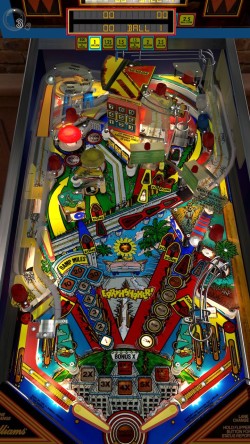 Standard version Permanently Delisted
Standard version Permanently Delisted
Included in Arcooda Software
Table Type: Pick ‘n Flick
Designed by Pat Lawlor
Art by Tim Elliot
Sound by Chris Granner and Jon Hey
1989 Williams, 5,257 Units Sold
TRIVIA
-Earthshaker was the first pinball machine with shaker motor.
-The first 200 units of Earthshaker off the production line had an Earthquake institutue that would sink into the table. This was so expensive compared to other elements on the table that it was removed.
-One of the first tables to have different ROMs for “family friendly” settings. The family friendly version simply removes the phrase “bitchin'” from the game.
TEAM RANKING: #28 OF 96
Oscar’s Rating: Good (#60)
Jordi’s Rating: Good (#47)
Angela’s Rating: Masterpiece (#11)
Eala’s Rating: Great (#23)
Earthshaker! was Pat Lawlor’s first solo design, and all his design signatures are on full display. A heavily congested playfield, with tight angles, primary shots off a bat flipper, double return lanes, high-risk targets, and difficult multiballs. Of course, that’s not what people think of first and foremost when they think of Earthshaker! They think, holy crap, the entire table is shaking. Of course, being a life-long San Francisco Bay Area resident, I don’t even feel anything less than a six-pointer, joke often about it, but live a daily life with the knowledge that a big one will hit in my lifetime (in fact, I was alive for the big one of 1989. I was three months old). Also, while writing this, I had a hilarious though: eight months after this came out, the famous World Series quake happened. You see where I’m going with this. When that happened, some dude had to have been playing this in a Bay Area arcade and thought “holy crap, what mode is this? It’s so realistic!” IT HAD TO HAVE HAPPENED!
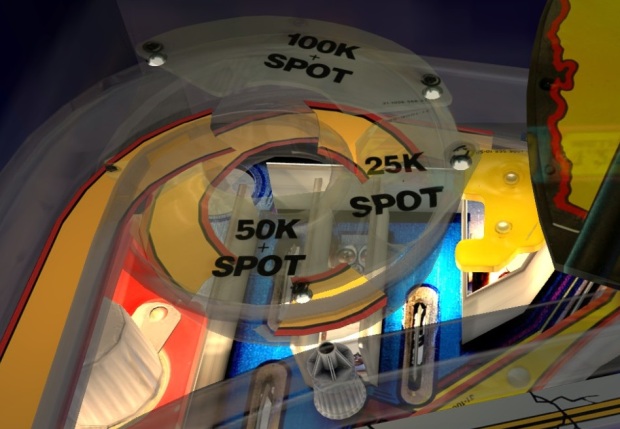
Plungers are just plain problematic in Pinball Arcade. A trend I’ve noticed is that people who hate auto plungers in real life embrace them in video games, because analog sticks, mice, and touchpads are poor substitutes for a stick on a spring. You just can’t clock them. I couldn’t. My Dad mastered nudging but couldn’t get a single plunger right. I know I said I wouldn’t talk about the horrible.. truly TRULY horrible.. $399.99 dumpster fire that is the Toyshock 12-in-1 Gottlieb that runs off a modified Pinball Arcade engine. But, the one positive I can say about it is it has a plunger, and the plunger works relatively well.
It’s weird that Whirlwind is the direct sequel to this, because really, it feels like it has more in common with Funhouse. There’s no Rudy, but the angles and orbits actually have a lot in common. Really, Earthshaker feels like a stripped-down, more fundamental version of that legendary table. But, in many ways, it’s better. There’s a lot more flexibility and open room, which makes multiball feel more chaotic. None of the holes are so simple that you can use them as dumpers, like you can in Funhouse. The Shelter shot, especially, is a lot trickier and more rewarding than any of the major hole shots in Funhouse. I think the team at Farsight had much love for Lawlor because his tables seem to.. mostly.. have more care given to them (Twilight Zone’s issues not withstanding). Earthshaker! is a table notorious for technical issues, and having an accurate digital version seems like a nice deal. This one goes high on my wishlist for Pinball FX3, lest it now forever be a one of the tragic “lost forever” pins of Pinball Arcade. I suspect we won’t wait much longer.
#18: The Getaway: High Speed II
Member of the 12K Club
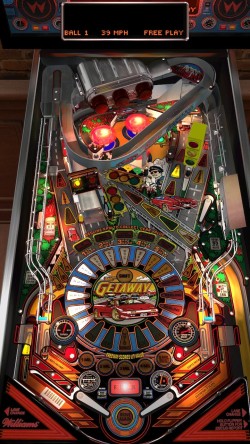 Permanently Delisted
Permanently Delisted
Included in Arcooda Software
Table Type: Kinetic-Finesse
Alternative Version: Pinball FX3 Williams Pinball Volume 1
Designed by Steve Ritchie
Art by Mark Sprenger & Doug Watson
Sound by Dan “TOASTY!” Forden
DMD by Scott Slomiany
1992 Williams, 13,259 Units Sold
TRIVIA
-ZZ Top’s La Grange serves as the theme song.
-A port was made for the Game Boy that retains the scoring and a true approximation of the original’s layout.
-The driver on the backglass is Steve Ritchie.
-The Getaway: High Speed II is notorious for having technical problems. The most famous of which is balls would get stuck in the slingshots, breaking the bulb and creating a short-circuit that would fry the MPU board. A misprint in the game’s manual also provides the wrong voltage for bulbs.
-The table can also lose track of how many balls are locked. This glitch is in-tact in the digital version. For this reason, Getaway is rarely used in tournaments.
TEAM RANKING: #5 OF 96
Oscar’s Rating: Masterpiece (#4)
Jordi’s Rating: Masterpiece (#2)
Angela’s Rating: Masterpiece (#6)
Eala’s Rating: Masterpiece (#11)
THE PINBALL CHICK PANTHEON OF DIGITAL PINBALL INDUCTEE

Almost all the fun of a real Getaway without the risk of a ball getting caught on the slingshot and shorting out the MPU. Yes, that really happens with this one.
In eighteen head-to-head match-ups with Pinball FX3, only three times did I prefer the Pinball Arcade version of a table. But, only one of those three is actually ranked in a higher tier than its Pinball FX3 counterpart. Getaway is that table. The reason is simple: Pinball Arcade’s floatiness actually makes shooting combos easier because the ball isn’t going so fast that it becomes nearly impossible to time. This wouldn’t be an issue on a real table, where flippers are instant and the physics are much more life like for reasons that I’m having trouble explaining. But it matters here, because that upper short-orbit is essential to gameplay, but hard to get if the ball is traveling faster than a human can reasonably track.
UPDATE: I’ve since upgraded the Pinball FX3 version to MASTERPIECE status and consider it superior to the Pinball Arcade port.
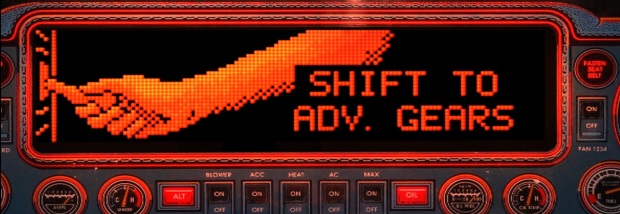
One of the biggest casualties of The Curse of Digital Pinball™ is losing the gear shift on Getaway. Gimmicky? Sure. Neccesary? Not at all. But if charm is part of the sport, losing that charm does hurt. Maybe only in the “skinned knee: get a band-aid and a kiss from your Mommy” type of way, but a wound is a wound.
For me, The Getaway: High Speed II is the definitive “tight squeeze” table. The boys love it, both ranking it in their top four. For me, I just guess it just doesn’t work for me on the same level it works for them. Shooting the short-orbit in the upper playfield is exhilerating. Love it. I don’t love when you don’t hit it with sufficent pressure and the ball sort of putters out into a wobble and falls limply into the bumpers. So awkward when it happens. I just don’t what to say except I like Getaway but I don’t think it even comes close to High Speed. The angles here are designed to feed the outlanes and drain, whereas High Speed was a bit more forgiving. I guess that makes sense. They were all-in on High Speed. If it flopped, Williams was in trouble. High Speed II feels like the Master Quest version of High Speed. The table designed for those who finished the first quest and want a further challenge. I never got that good at High Speed, so that’s not me. But, if it were me, I’d like this version better than Zen Studios’ take.

I figured White Water would be the big controversy in my Pinball FX3 review (and indeed, the Pinball Arcade review as well), but instead, it’s Getaway. What can I say? I think it’s a fine table that suffers from balance issues, and frankly, the Super Charger is just a ramp that holds the ball. It’s a cool visual, but from a gameplay perspective, it’s functionally just a lock. An expensive, tarted-up lock. Yippie? High Speed is just a better table. The sequel is like a Fast & Furious sequel: bigger, louder, and much, much dumber. Speaking of which, I’m guessing its inevitable that Stern will call Steve Ritchie to do a Fast & Furious.
It might have just been me, but the Pinball Arcade version of Getaway’s shots felt less tight, and the table slightly more forgiving overall. Don’t get me wrong: clank the ramp shot and you’re draining out. Or maybe I’m just overrating this because I managed to beat my Dad 4 games to 1 (mind you, I’d NEVER beaten him at a Ritchie table in a best-of-seven), then proved it wasn’t a fluke by beating him a doubles 10-ball match. Even after that, my Dad called this his favorite DMD that we don’t own for real (it’s his #1 ranked Pinball FX3 table), while I bumped Getaway from “good” on Pinball FX3 to “great” here. I’m sure with patching, Pinball FX3 will take the lead. Or they’ll break the lightspeed record and make the table even harder. One or the other.
MASTERPIECES
#17: Centigrade 37
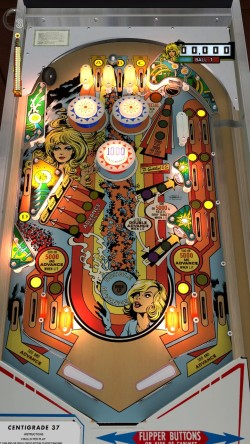 Featured in Gottlieb EM Pack (DLC)
Featured in Gottlieb EM Pack (DLC)
Included in Arcooda Software
Type: Boardwalk
TABLE FACTS
Designed by Allen Edwall
Art by Gordon Morison
1977 Gottlieb, 1,600 Units Sold
TRIVIA
-Rumored to have originally been based on the NBC television show The Bionic Woman.
TEAM RANKING: #29 OF 96
Oscar’s Rating: Good (#56)
Jordi’s Rating: Masterpiece (#13)
Angela’s Rating: Good (#66)
Jordi’s Rating: Great (#15)
THE PINBALL CHICK CERTIFIED EXCELLENT TABLE
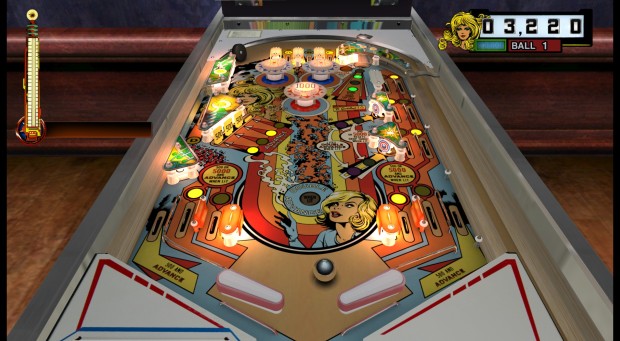
While I do think the artwork has a cool EC Comics vibe about it, I’m not exactly sure what exactly the table is implying. Take the backglass, for example. Someone explain to me what it has to do with temprature? It’s hot, I guess?
37 centigrade is equal to 98.6 degrees Fahrenheit, aka the temperature of a normal human body. Centigrade 37 is an ambitious 1977 pinball machine that’s so much more fun than I expected any EM table to be. I’m sure retro pinball fans saw my skewering of the Atari 2600 when I did Flashback for Switch and winced at the thought of what I’d say about electro-mechanical pin recreations. Well, if they were all as fun as Centigrade, they wouldn’t need to worry. This is a table that feels like it relies more on skill than luck. I was able to figure out the right angles to shoot down the right side “tubes” to build points.

Sure, luck will inevitably factor in. It’s an EM. It’s what they do. But one of the top ten thrills in Pinball Arcade is seeing the ball hit all the right lights as it travels down the rollovers.
Centigrade is a rarity among EMs. You feel YOU’RE the one in control. Not the bumpers. Not the fates. You. And the gameplay is so rewarding. The object is to fill a thermometer on the backglass, which allows you to score specials. The thermometer grows as the ball travels through a series rollovers separated by rails down the right side of the field. The catch is the furthest right rail will inevitably go down the outlane. Watching the ball start to travel down these is one of the most genuinely exciting moments I’ve had as the Pinball Chick. What a wonderful surprise! Who knew a table from 1977 could be so thrilling? Age really is just a number.
#16: Gorgar
Member of the 12K Club
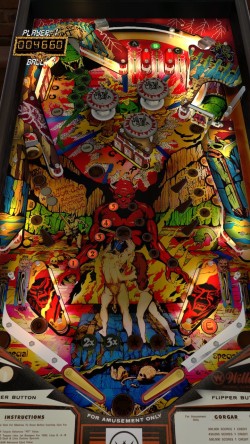 Featured in The Pinball Arcade: Season One (PS4 Disc Only)
Featured in The Pinball Arcade: Season One (PS4 Disc Only)
Included in Arcooda Software
Table Type: Sharpshooter
TABLE FACTS
Designed by Barry Oursler
Art by Constantino Mitchell and Jeanine Mitchell
Sound by Eugene Jarvis
1979 Williams, 14,000 Units Sold
TRIVIA
-The first pinball machine with speech.
-The full seven-word vocabulary is: “beat”, “Gorgar”, “got”, “hurt”, “me”, “speaks”, and “you”.
-An earlier table, Williams’ Disco Fever, was meant to have speech and shown at trade shows, but the production models had the cost-prohibitive chip removed. Buzz is it was unintelligible anyway.
-The German metal band Helloween wrote a song about Gorgar that was included in their Walls of Jericho album.
TEAM RANKING: #14 OF 96
Oscar’s Rating: Great (#16)
Jordi’s Rating: Great (#35)
Angela’s Rating: Masterpiece (#5)
Eala’s Rating: Great (#24)
THE PINBALL CHICK CERTIFIED EXCELLENT TABLE

It’s a shame Gorgar’s legacy is as the first talking pin, instead of being a historically amazing table that happened to talk.
The first talking pinball machine (see, I’m guilty myself), Gorgar is a lightning-fast experience that I was absolutely dazzled by. Golly, does this table just.. bounce. And why wouldn’t it? It’s a big, wide-open playfield with the majority of the targets to the side, and ones that aren’t are angled to assure the ball keeps going up when you hit them. Gorgar has one the cleanest, simplest layouts ever. It’s minimalist, almost like the artwork by Constantino Mitchell and Jeanine Mitchell knocked everyone at Williams so far out of their socks that they didn’t want to cramp it with bumpers and targets and crap. If everything here wasn’t near perfect, this table would have been boring.
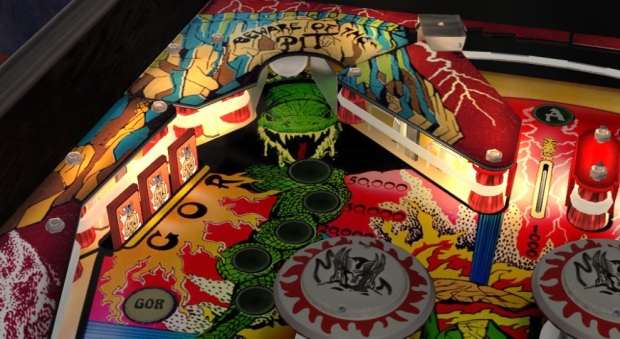
Gorgar’s Pit shot is probably the most famous off-angle shot in pinball history and still a joy to master over 40-years-later.
It’s brilliant. Every angle, every bonus, the target placement.. ironically everything BUT the repetitive voice of Gorgar, which only has seven lines and wears thin in record time.. is near enough to perfection that you can’t help but fall in love with this machine. Yes, it’s overly simple, even by the standards of the era. But, make no mistake: this is a very, very fun table. It’s everything you want from an early solid stable: speedy, white knuckle, exhilarating to see the bonus build, with every target accessible on your raw skill alone. Am I over-rating Gorgar? Probably. But not because darned thing talks. I love it because this is pinball at its scoring-driven purest. Even retro-hating Jordi gave it props. That says it all.
#15: Black Knight
Member of the 12K Club
 Featured in The Pinball Arcade: Season One (PS4 Disc Only)
Featured in The Pinball Arcade: Season One (PS4 Disc Only)
Table Type: Sharpshooter
TABLE FACTS
Designed by Steve Ritchie
Art by Tony Ramunni
Sound by John Kotlarik
1980 Williams, 13,075 Units Sold
TRIVIA
-Black Knight is the first table with a multi-level playfield.
-Black Knight is the first fifty-cent game by Williams, and maybe the first pinball table to be priced that in general.
-Steve Ritchie is the voice of the Knight. If it sounds familiar, it’s because he’s also the voice of Shao Kahn in Mortal Kombat II (he also came up with the name Mortal Kombat).
-The first game to use “Magna-Save” which became commonly used later.
TEAM RANKING: #9 OF 96
Oscar’s Rating: Masterpiece (#7)
Jordi’s Rating: Great (#18)
Angela’s Rating: Great (#26)
Eala’s Rating: Masterpiece (#9)
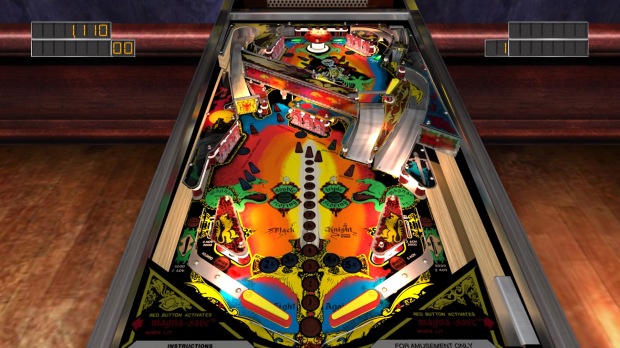
It LOOKS like Black Knight, only a little off. I tinkered with the lighting and it didn’t help. I think the issue is the flippers and ramp look like they were added in post-production for a cheap science fiction movie.
Firepower was the first table my father ever purchased, around 1984. Black Knight was the second, around a year later. I came into being in 1989, but we didn’t buy our next table until around the year 2000. Given that we actively collect tables now, it might speak volumes to how content my father, a certifiable pinball nutjob, was with the two 1980 Steve Ritchie tables he had. The two tables also display the wild differences in my father and I’s taste in silverball. He likes the fine-tuned, traditional, fast-paced target shooting elegance of Firepower while I preferred the more fast-running (not the same as fast-paced), white-knuckle, high-pressured Black Knight. To me, Black Knight is the prototype for what pinball later became. With its three ramps, hurry-up-based targets, and stop-and-go tunnels, Black Knight changed pinball forever. Playing it in 1980, when tables just didn’t look or play like this, must have been as startling to players as any gaming technology leap. Gone were the days of flat layouts with scattered bumpers and simple drop targets, maybe a sinkhole or two, maybe a spinner. Oh no, those days were done for. Was it inevitable? Unlike other gaming innovations, I’m not so certain. Because, believe it or not, there’s nothing truly innovative in Black Knight besides the magna-save. Everything here, including triple-ramps, had been thought of before and even used. But the industry resisted such changes because they brought the costs up and the amount of maintenance required for tables up. Black Knight changed all that. It kicked open doors that could never be closed again.

The main issue I had with the digital version of Black Knight is that using the Magna-Save on a real Black Knight table is super comfy and intuitive. That’s why it’s famous. It’s harder to switch your fingers from one row of triggers to the other on a game controller and I really struggled to use the Magna-Save as effectively on Pinball Arcade as I can on the real table. Actually, it feels great on the Switch Joycons. Too bad that version was only sold for about two hours. And also, that version is broken in multiplayer.
And it holds up wonderfully. Especially if you’re looking for a challenge. Perhaps no table of the alpha-numeric era (actually, numeric-only in this case) can have a good game turn sour on players as suddenly as Black Knight can. You must have precision and fast reflexes because botched use of ramps or clanked drop-target shots can drain out so fast that you can barely process your own failure. If there’s a faster-playing table older than Black Knight, I’ll eat my hat. That’s sort of what makes the Pinball Arcade version one of those tables where the physics engine itself hurts the gameplay. If the ball is slightly slower or floatier than a normal table, you can adapt and accept the situation for what it is. That is, except for hurry-up modes. In those situations, it’s annoying to see a ball slowly lose momentum before coming back down. What digital pinball really needs is more compensation for each engine. In the case of Pinball Arcade, you need to give a bit more buffer to hurry-ups. Black Knight’s drop targets ARE hurry-ups. A non-stop series of them. Getting one less shot is still getting one less shot. And, to everyone who says “just get good and don’t miss”, eat my asshole. Misses happen. I don’t think it’s asking for the world that a simulation of a real pinball machine offer the same amount of second-chance shots. But otherwise, Black Knight’s legend lives on. Every bit as fun and challenging today as it was nearly a full decade before I was born. Incredible table.
#14: Centaur
 Featured in The Pinball Arcade: Season Two (PS4 Disc Only)
Featured in The Pinball Arcade: Season Two (PS4 Disc Only)
Table Type: Sharpshooter
TABLE FACTS
Designed by Jim Patla
Art by Paul Faris
1981 Bally, 3,700 Units Sold
TRIVIA
-Centaur is the first table with an auto-launcher (multiball only).
-Jim Patla based Centaur on the 1956 Bally classic Balls-a-Poppin.
TEAM RANKING: #24 OF 96
Oscar’s Rating: Great (#27)
Jordi’s Rating: Great (#33)
Angela’s Rating: Good (#44)
Eala’s Rating: Great (#27)
THE PINBALL CHICK CERTIFIED EXCELLENT TABLE
No table has ever looked quite like Centaur. But, there’s few tables of its era that play as well as Centaur does. It has one of the smartest layouts of the early solid-state era with perfect angles and target placement. Centaur is a fantastic pinball experience. One of the best tables ever made. Successfully pulling off objectives like shooting the O-R-B-S targets or the numbered side targets in sequential order feels exhilarating. The openness of the table also allows the five-ball multiball to be easier to juggle. It’s such a tragedy that Jim Patla retired from making tables before the 80s were up. Everything here works and feels like refined, idealized versions from the best tables of the era up to that point. A stronger multiball, with stronger bonus multiplying, and perfectly balanced difficulty. Centaur’s marvelous, but what a weird overall story. A sequel was made, though by “sequel” I mean it’s literally the exact same table with the same objects and same table appearance and art. Only the backglass changed. That’s not a sequel. That’s not even a remake. It’s a re-release, and adding the “II” to it is a move so skeezy that I’m surprised it didn’t cost Bally more.
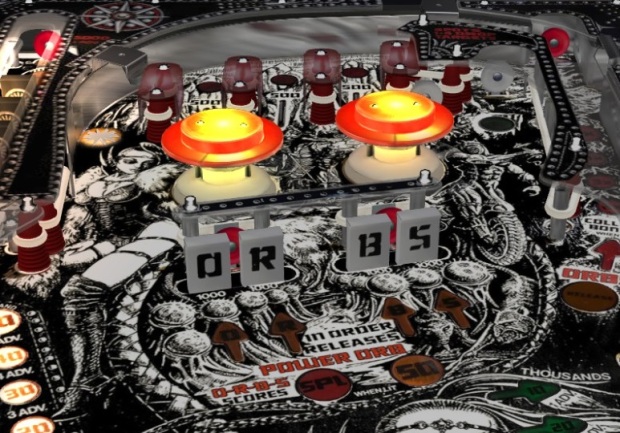
I loves me some sequence shots, and the O-R-B-S sequence, if you can hit it in sequential order, is so satisfying. This is about as perfect as target placement gets. I once said that Attack from Mars is the only “perfect” pinball table, in that I couldn’t identify a single flaw in it. While I’d need to play a real-life Centaur more, I suspect I’d add a second table to that. It’s PERFECT. Perfect balance. Perfect targets.
So, what’s the flaw? Well, here, it’s all related to the Pinball Arcade engine. It would seem Farsight didn’t respect Centaur on the same level I did. One of its most famous features is having second-chance outlanes where there’s a chance the ball could bounce just right and squeeze through a hole in the outlane. That happens here, but it looks skippy and unnatural. It breaks the illusion you’re playing a real table. There’s also a horrible glitch that prevented me from posting high scores unless, between each game, I quit out to the main menu and returned back to the Centaur table. Any attempts at playing the table twice in a row resulted in every game but the first posting a score of 0 regardless of what I actually scored. This bug isn’t just reserved for the PS4 version. In fact, it’s on Switch and Steam too. You can’t get any version of Centaur but the PS4 Season 2 UK-only disc legally anymore, but still, that a known bug for a game that sold tens of thousands of copies has such a terrible glitch retained is inexcusable. Centaur’s an amazing table and plays really fun, but this is an imperfect port of a perfect table. What a miscarriage of justice it is that Centaur didn’t do better in arcades. Hell, add Centaur II’s sales with it and it still wouldn’t reach 6K Club status. That hurts my heart.
#13: Firepower II
 Permanently Delisted
Permanently Delisted
Not Included in Arcooda Software
Table Type: Sharpshooter
TABLE FACTS
Designed by Mark Ritchie
Art by Constantino Mitchell & Jeanine Mitchell
1983 Williams, 3,400 Units Sold
TRIVIA
-Firepower II is the Pinball Chick team’s highest rated Pinball Arcade that’s fully de-listed and can’t be acquired by any legal means, including Arcooda Software.
TEAM RANKING: #15 OF 96
Oscar’s Rating: Great (#18)
Jordi’s Rating: Good (#37)
Angela’s Rating: Great (#21)
Eala’s Rating: Masterpiece (#10)
THE PINBALL CHICK CERTIFIED EXCELLENT TABLE
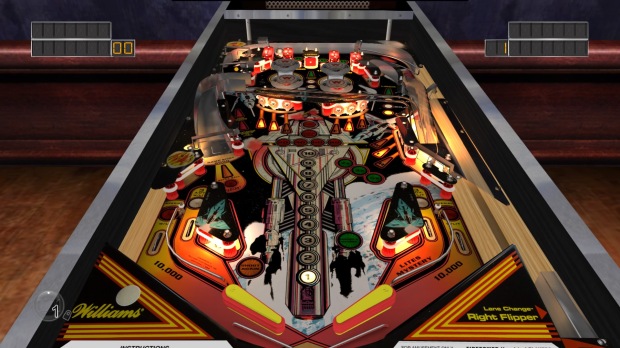
Firepower II came into being because Williams over-produced what was supposed to be the next revolution in non-digital arcade gaming. It was called Hyperball, and it was sort of like a mix between a firing range and a single-player version of the board game Crossfire. Designed by Steve Ritchie, Williams thought this would do Defender/Robotron numbers, forecasting an absolutely insane 50,000 units of this would be sold. Mind you, that would make it two-and-a-half times more successful than the most successful pinball game ever, Addams Family, which wouldn’t even come out for another decade. I’ve never met anyone who played Hyperball who didn’t walk away thinking it was very cool, but the 50K estimate was absurd and baseless. Every single problem with pinball would be inherit to Hyperball: it took up space, it would require a multiple of the maintenance a video game would, it would be prone to breaking down, it would be noisy, and it would be more expensive to purchase. Thankfully, they didn’t manufacture 50,000 of these, but they did over-manufacture the backbox for it. Mark Ritchie was told to convert it into a pinball. The end result is Firepower II. There’s some fun trivia for you.
Firepower II is perhaps the greatest sequel in pinball history, and certainly the most underrated. Not that the competition is stiff. This is the medium where Centaur got a sequel that’s literally the exact same table with a different backglass. In fact, most of the greatest follow-ups in pinball are of the spiritual sequel nature. Ripley’s Believe it or Not? is not the sequel to Twilight Zone, but it sort of is. Diner is not stated as being a sequel to Taxi, but it sort of is. Here, there’s a II attached, while the art is consistent (and better, in my opinion) and the signature targeting format is retained. Plus, it’s made by the younger brother of the original. There’s no questioning the lineal connection of Firepower and Firepower II. But, I liked Firepower II more, even if my Dad is saying that I’ll be struck by lightning for saying it.
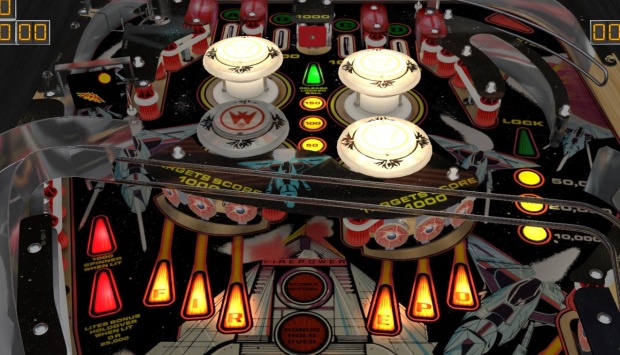
“You’re no daughter of mine” my Dad said after I sung the praises of Firepower II dropping down to a two-ball multiball setup. “Sacrilege, plain and simple.” What can I say? All the target-shooting glory of Firepower, now in a more manageable package.
This is a genuinely thrilling, intense table that hits all the marks. The triple-targets are back. The multiball is a much more elegant two-ball design, and one of the best two-balls in the sport. That was the difference maker for my Dad: that an iconic three-ball table’s sequel is only a two-ball affair. For me, the more relaxed multiball allows you go focus more on the precision shooting. The target placement is great, the bumpers and slingshots are less lethal, and it’s just a table that is more inviting and fun to play. It’s a CRIME that Firepower II sold less than 20% of the units the original did, though I can totally see why arcade operators would not love this one as much: players would last longer on it. It’s not as punishing. And I can imagine players of the 80s would probably be disappointed that Firepower II subtracted from the madness instead of adding to it. I feel that the short ramp and the orbit more than make up for the third ball. Excellent scoring balance and satisfying bonus building make this a truly lost treasure. Maybe the most underrated 80s table ever. Pinball’s proof that sometimes you CAN do addition by subtraction. Either way, this is the best table that can’t be acquired by any means now.
#12: Swords of Fury
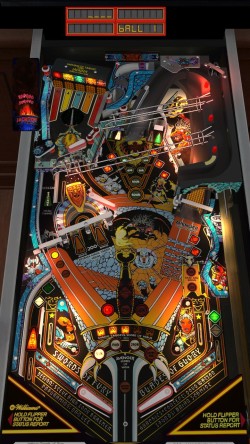 Standard version Permanently Delisted
Standard version Permanently Delisted
Included in Arcooda Software
Table Type: Sharpshooter
TABLE FACTS
Designed by Steve Kirk & Tony Kraemer
Art by Doug Watson
Sound by Brian Schmidt
1988 Williams, 2,705 Units Sold
TRIVIA
-One of the first tables to use the concept of dividing the playfield into “zones”, which later drove the gameplay of tables like Doctor Who.
TEAM RANKING: #21 OF 96
Oscar’s Rating: Great (#14)
Jordi’s Rating: Great (#21)
Angela’s Rating: Good (#36)
Eala’s Rating: Good (#40)
THE PINBALL CHICK CERTIFIED EXCELLENT TABLE
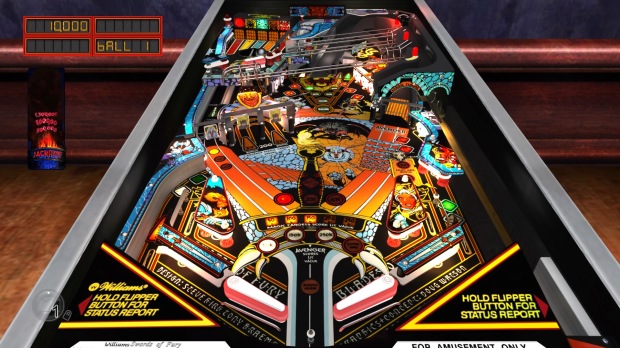
Probably one of the most popular tables NOT associated with any the Williams/Bally Dream Team of pinball designers.
Similar to Sorcerer, Swords of Fury came with a reputation of being underrated. This time, the rep was justified. Swords of Fury, one of the most complex tables of the 80s, was a joy and a pleasure to discover. I believe the intent was to make it a third entry in the Black Knight series. It sure looks pretty, I’ll give it that. But it’s also tremendously fun. The primary mechanics involve transferring the ball between three different and distinct zones. Off the serve, you usually start in the mini-field in the upper-left corner. It’s one of the best mini-fields in modern pinball, and certainly the best with a single flipper. Here, you shoot five targets with short-but-bankable angles. In multiball, the jackpot is tied to this field and holy crap, is it ever satisfying to earn. Meanwhile, the main playfield has both primary AND off-angle entrances, a tunnel that’s aligned with a toe shot, and a primary-angle that drives the multiball locks. This is THE table to practice shooting on.

I initially had Swords of Fury listed in the Great tier, but I had to concede that few tables have as many genuinely satisfying shots as it does. Mastery of the minifield is the key to scoring, but also, it’s just damn fun. If the greatest attribute to a masterpiece is how much fun you can have playing it, Swords of Fury is a masterpiece. It’s fun, and that’s why we’re all here.
My main knocks on Swords of Fury are the same ones that every split-level table has: multiballs are unmanageable unless you have two heads (and presumably two brains to go along with it) and there’s serious scoring balance issues. To Swords’ credit, you can’t really chop wood here. Multiball drives the scores too much. If anything, multiball might be too easy, with too small a barrier to access. I also feel the table might be a little too driven by transferring from zone to zone. Finally, it’s one of those tables where you can steal the work of other people if you’re playing competitively and take their multiball locks, which I usually don’t gripe about. Here, with the lock being a primary angle with no sub-locks, it makes choosing to shoot the second lock scary if you’re not confident you can make the third one. Ask my Dad. He turned three different shades of purple from me stealing his multiball locks. I was THIS CLOSE to collecting my inheritance via massive heart attack. Of course, I bet many would argue that’s actually a point in the table’s favor. A feature, not a bug, because it makes dueling more exciting. And you know what? They sort of have a point.
#11: Dr. Dude and His Excellent Ray
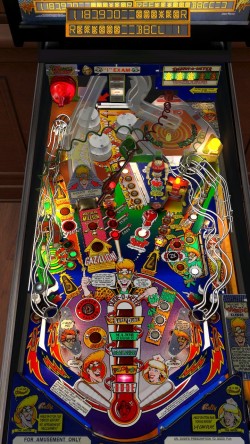 Featured in The Pinball Arcade: Season Two (PS4 Disc Only)
Featured in The Pinball Arcade: Season Two (PS4 Disc Only)
Included in Arcooda Software
Table Type: Sharpshooter
TABLE FACTS
Designed by Dennis Nordman
Art by Greg Freres
Sound by Chris Granner and Jon Hey
1990 Midway Manufacturing, 4,000 Units Sold
TRIVIA
-The Gazillion Point Shot is a parody of Bride of Pin*Bot’s billion point shot, which Dennis Nordman personally disliked as it was based on chance instead of skill.
-Dr. Dude is rumored to have been conceived as a mad scientist’s lab-themed sequel to Elvira and the Party Monsters.
TEAM RANKING: #19 OF 96
Oscar’s Rating: Great (#26)
Jordi’s Rating: Great (#23)
Angela’s Rating: Great (#28)
Eala’s Rating: Great (#22)
THE PINBALL CHICK CERTIFIED EXCELLENT TABLE
At this point in my Pinball Chick existence, it’s safe to say Dennis Nordman is my arch nemesis. In Pinball FX3’s Williams buyer’s guide, I’ve done two of his tables as of this writing. One I ranked “Bad”, the other “The Pits”. I came up with the concept of “operator’s designer v player’s designer” based on his work. What I’m trying to say is, I’m not a fan. In fact, I think Dennis Nordman’s pinball tables are responsible for a 5% increase in my blood pressure. Even worse, Dr. Dude really isn’t that much different from the miserable Party Zone, right down to having very similar angles to activate the modes. So, imagine my surprise that Dr. Dude is one of the better tables in Pinball Arcade. It’s an incredibly simple concept based around hitting three specific targets in sequential order. Hitting these targets, all of which are slightly off-angle, allows you activate a multiball mode. From there, you have to raise your “level of coolness.” Okay, maybe instead of Bill & Ted, this was based around Parker Lewis Can’t Lose. Coolness.

Dr. Dude inspired another doctor.. THE Doctor in fact. The 1 – 2 – 3 sequence with shots away from each other was recreated in Doctor Who. The placement isn’t the same, and here it actually drives the gameplay instead of simply accenting it, but both shots equal the same thrills.
There’s not a lot to Dr. Dude, but what’s here is superb. The shots are challenging. The hurry-ups are perfectly timed for appropriate challenge without being unfair. My main knocks on the pin are the tendency for multiballs to instadrain out in a way so consistent, despite being off-the-bumpers, that I’d swear it’s rigged, along with a particularly hungry drain. Everything else works. Objective targets are tight squeezes, but in a way that feels right. What limited modes are here are insanely exhilarating and lots of fun. This, ladies and gentlemen, is Dennis Nordman’s magnum opus. One of the most underrated pinball machines ever, and a genuine treat for silverball fans. I loved Dr. Dude. YOU WIN THIS ROUND, BUT I’LL GET YOU NEXT TIME NORDMAN! (shakes fist) NEXT TIME!
#10: Black Knight 2000
 Permanently Delisted
Permanently Delisted
Included in Arcooda Software
Table Type: Finesse
TABLE FACTS
Designed by Steve Ritchie
Art by Doug Watson
Sound by Dan “TOASTY!” Forden, Brian Schmidt & Steve Ritchie
1989 Williams, 5,703 Units Sold
TRIVIA
-During the unveil of Black Knight 2000, a man dressed like a knight rode a horse on the stage. The horse then turned it’s butt to the audience and let out a knightly crap.
-Steve Ritchie again voices the Black Knight, and he also helped compose the table’s theme.
TEAM RANKING: #10 OF 96
Oscar’s Rating: Great (#21)
Jordi’s Rating: Masterpiece (#10)
Angela: Masterpiece (#10)
Eala: Great (#32)
THE PINBALL CHICK CERTIFIED EXCELLENT TABLE
I’ve never really felt that Black Knight 2000 feels like a true successor to Black Knight. That’s sort of bizarre too, since it really does match what Black Knight did. Split-level, orbital loop on the top (though with locked multiball hole), U-Turn, Magna-Save, and all it on a strikingly similar layout, sans the double ramps of the original. I mean, it clearly is Black Knight 2(000). But, I always felt this played a lot faster and more white-knuckle, similar to stuff like High Speed or F-14 Tomcat. This is a game of building momentum. My Dad says Black Knight 2000 is what Black Knight would have been if Ritchie discovered orbits sooner. Perhaps he’s right. All I know is, I can play both tables for hours and not feel like one is redundant over the other. They both feel like their own thing, in the best way possible. Like how identical twins aren’t really identical, Black Knight and Black Knight 2000 each have their own personality. Black Knight 2000 is loud and fast and it doesn’t give you a second to breathe. The lowerfield is one of the most claustrophobic table elements ever, while the upperfield feels like a high-pressure juggling act with the biggest drain in the sport. God, it’s glorious.

Shooting loops in the short orbit is absolutely breathtaking. There’s few moments in the sport as satisfying as building up a run of loops in Black Knight 2000. Easily my favorite short-orbit in 100 tables. Dad, what’s wrong with you? This deserved Masterpiece status. (His retort: “I thought you hate mystery scores?”)
I absolutely LOVE Black Knight 2000. But, it’s got some fairly glaring annoyances. Juggling multiball with split-levels might be more reasonable if you’re one of those freaks who can rub their head and pat their belly at the same time. I can’t even stand on one leg and talk at the same time, so I’m kinda screwed managing it. The roulette wheel is too essential to gameplay, though I’ll say it’s probably one of the easiest to activate in pinball. And also, the Magna Save isn’t as intuitive or easy to use here as a real table. But, make no mistake: shooting that top orbit over and over and over, getting a long string of loops going, is exhilarating. Really, this should have been a Top 5 or even Top 3 table. But, I think the extra ball hurry-up is too short and, indeed, my Dad is right: there’s too many mystery scores. I’m fine with it here. At least they’re not as insanely imbalanced as Gottlieb’s System 3 tables.
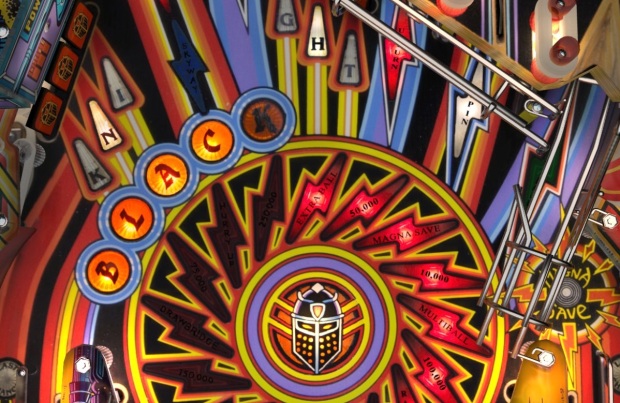
Just looking at Black Knight 2000 makes me want to do the horns with my fingers. Why is it not okay when Cactus Jack’s spams the center of the table with lights but perfectly fine when Black Knight 2000 does it? Because Black Knight 2000 is cool. You’re either cool or you’re not, and Cactus Jack’s is not. Of course, BK2K’s coolness comes at a steep price in Pinball Arcade..
Actually, the turd in Black Knight 2000’s punch bowl is the visual issues. It’s too easy to lose the ball(s). I found none of the optional decorative balls that you can purchase as DLC (at least ones that’ll still count for online leaderboards) to be satisfactory, nor any lightning option, nor any playable camera angle. Even with tables I was familiar with in real life, I couldn’t get the hang of the camera trailing the ball, so that was out. I usually stuck to camera #3 and locked it, but the balls just blend in too much because Black Knight 2000 is so visually loud. Yes, this can be an issue on real BK2Ks, but at least there you’re in front of a real table with real balls that have depth and mass. I wish Pinball FX3, with its optional comet tails, would adopt Black Knight 2000 if it ever gets around to doing alpha-numerics. Those tails would have come in very useful here, where my primary method of dying was, I’m embarrassed to admit, losing track of where the ball was. Usually it was the lower playfield and involved shooting the U-Turn. Even after 20+ hours on just this table alone, across three platforms, I still would find my mind wander just enough to lose where the ball was at on the table. It’s a problem unique to Black Knight 2000, but a problem nonetheless. The one big flaw in an otherwise incredible masterwork.
#9: FunHouse
Member of the 10K Club
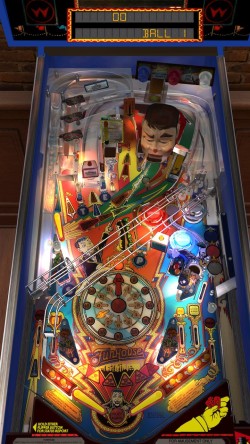 Featured in The Pinball Arcade: Season One (PS4 Disc Only)
Featured in The Pinball Arcade: Season One (PS4 Disc Only)
Included in Arcooda Software
Table Type: Pick ‘n Flick
TABLE FACTS
Designed by Pat Lawlor & Larry DeMar
Art by John Youssi
Sound by Chris Granner and Jon Hey
1990 Williams, 10,751 Units Sold
TRIVIA
-Funhouse is a remake of a 1956 Williams table designed by company founder Harry Williams.
-Mortal Kombat creator Ed Boon voices Rudy.
-The mechanical clock that was later adapted for Twilight Zone was designed for Funhouse.
TEAM RANKING: #12 OF 96
Oscar’s Rating: Good (#47)
Jordi’s Rating: Great (#15)
Angela’s Rating: Masterpiece (#7)
Eala’s Rating: Masterpiece (#12)
THE PINBALL CHICK CERTIFIED EXCELLENT TABLE
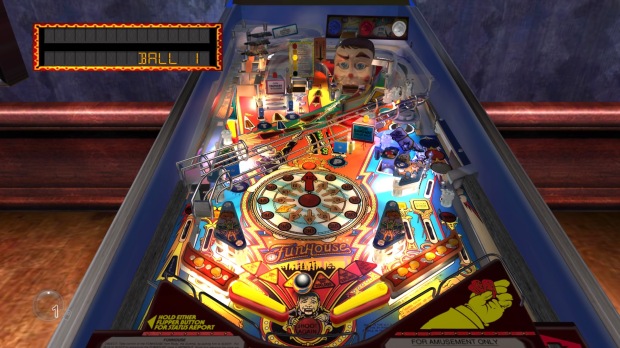
Fun fact: Rudy is voiced by Ed “Mortal Kombat” Boon, who also was the voice of “GET OVER HERE” Scorpion and Shang “Flawless Victory! Fatality!” Tsung too.
Maybe no table of the alpha-numeric era is remembered more fondly among my fans than Funhouse. The funny thing is, it was also the start of the OUT OF ORDER era of pinball. I’ve probably seen more Funhouse tables on route in the wilds of the San Francisco Bay than any other pin, and I’d guesstimate half of them had some sort of active problem despite being plugged in and costing money to play. I’ve seen Rudy’s mouth stuck permanently open. I’ve seen the bat flipper not working. I’ve seen probably more warping on the playfield than any other. This was probably between 1998 to 2000. By then, routed Funhouses had gotten a lot of love, and love hurts.
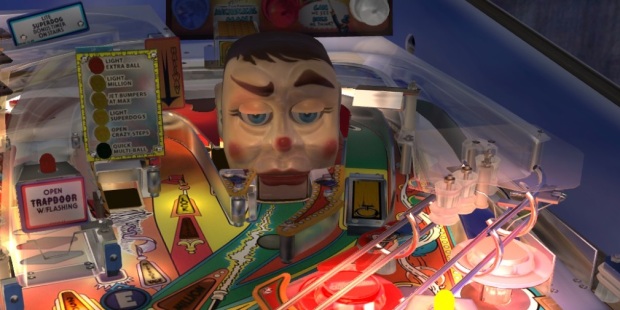
This is a true story: while I grew up with Firepower & Black Knight, we didn’t get another table until I was around ten-years-old. A friend of my Dad’s kids left for college and they wanted to do-away with their family room. Dad loaded up their two tables: The Machine: Bride of Pin•Bot and Funhouse. I liked Bride just fine. Funhouse I didn’t warm up to immediately. In fact, I was terrified to play it. Then, one day while my Dad was at work, I went to play Bride and the switch that turned it on turned on Funhouse too. I looked over at it, Rudy spoke, and I was never again alone in our game room until my teens. Fun to laugh at now. Not so funny back then.
There’s something special about this table that defies description. For many, this was the turning point of pinball that either psyched them for the future of the medium or turned them off for good. You can understand why someone reared on electro-mechanicals or early solid-state machines like Firepower or Gorgar or Genie would be turned off by Funhouse. It’s one of the most cramped, claustrophobic tables ever. As my father points out, every shot is sort of railed off for you. You can cycle easily through the multiball shots, build up your bonus by whacking Rudy in the mouth with the bat, and chop a whole lotta wood with Funhouse. I can totally see why people would hate this table.
I love it.
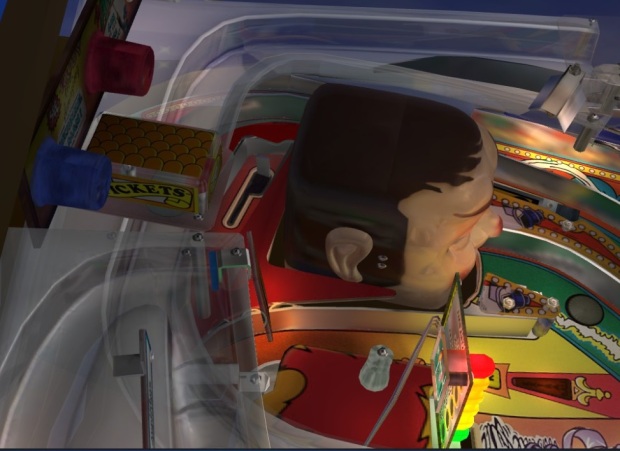
I had difficulty mastering the Rudy’s Hideout shot on the digital version of the table. Otherwise, this is probably the single best translation in Pinball Arcade. I suspect those who worked on it have as much fondness for it as those who follow me on Twitter do and put a LOT more effort into it than other tables, and it shows. A whole generation of gamers cherish this machine. No table had more “I played that table SO MUCH as a kid/teenager” stories as FunHouse, and every single one of them can remember exactly where they played it, or if it had something mechanically wrong with it. That makes me smile. How can it not?
It’s not Pat Lawlor’s best work (though it is the top ranked Lawlor for Pinball Arcade. And you guys thought I’d be bias. HAH!). In fact, the layout is kind of inelegant and looks like everything was just sort of packed in unorganized. Like all these ideas were written on a legal pad and then Lawlor just started assembling and cramming the components onto the table like he was playing Tetris with pinball parts. Maybe it’s a miracle it works at all. But I’ll be damned if it’s not downright exhilarating. The bat flipper shot into Rudy’s mouth or the trapdoor are among the most exciting and satisfying shots any table has ever had. If a bat-style flipper has been used better, I haven’t seen it. Hell, shooting orbital combo with it is fun. FunHouse is fun. Polarizing for sure. You either love it or you hate it. To me, the most telling aspect of FunHouse’s value is that there’s few tables non-pinheads remember as fondly from an entire generation of video game players who just had to put quarters in it during their arcade visits, and they all walked away happy. Defeated, but happy. That’s worth something.
#8: Monster Bash
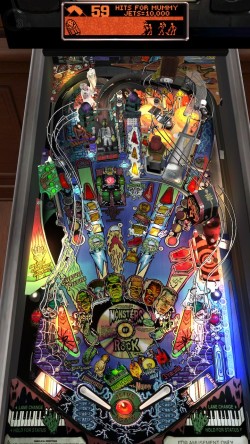 Featured in The Pinball Arcade: Season One (PS4 Disc Only)
Featured in The Pinball Arcade: Season One (PS4 Disc Only)
Included in Arcooda Software
Alternative Version: Pinball FX3 Universal Monsters Pack
Table Type: Finesse-Kinetic
TABLE FACTS
Designed by George Gomez
Art by Kevin O’Connor
Sound by Vince Pontarelli
DMD by Adam Rhine
1998 Midway Manufacturing, 3,361 Units Sold
TRIVIA
-Monster Bash was the final traditional table released under the Williams label.
-As revealed in the Pinball Chick interview with designer George Gomez, Monster Bash was originally intended to be based on the novelty song Monster Mash.
-One of the few pinball machines with a “cheat code.” When starting a game BUT before launching the first ball, press the left flipper 11 times, the right flipper once, the left flipper 5 times, the right flipper once, the left flipper 6 times, and the right flipper once. The game’s music will change and Williams software designer Lyman Sheats Jr. will comment on the game.
TEAM RANKING: #17 OF 96
Oscar’s Rating: Great (#22)
Jordi’s Rating: Masterpiece (#7)
Angela’s Rating: Good (#38)
Eala’s Rating: Great (#30)
THE PINBALL CHICK CERTIFIED EXCELLENT TABLE

Playing this across two different platforms confirmed to me that Monster Bash is the easiest DMD with the easiest wizard mode in all of DMD pinball.
Monster Bash has a ton of issues, mostly related to a serious lack of challenge. Frankly, this table is a cakewalk. Yet, I had it second only to Medieval Madness in the Pinball FX3 ranking. It doesn’t stand as high in Pinball Arcade, where it has to compete against more tables with licenses that Zen Studios hasn’t gotten yet. The reason is simple: Monster Bash is pure, fun mayhem. Easy-to-crack stackable modes make this one of the most wired-for-entertainment tables in pinball history. By this point, it was 1998. The medium was fading, operators were halting their table orders, and Midway was preparing to announce their Pinball 2000 initiative. The finality of Monster Bash feels authentic. This was likely the end, and designer George Gomez (who did Revenge from Mars for the Pinball 2000 holographic line) acted accordingly.
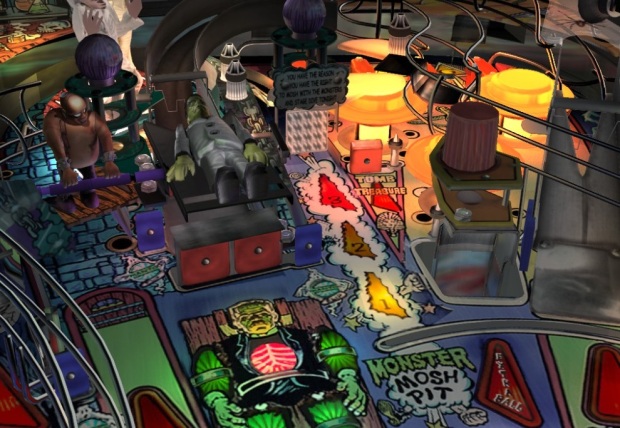
The one advantage Pinball Arcade’s version of Monster Bash has over Pinball FX3 is Dad and I both felt the Frankenstein shot was less lethal. It’s a clank shot. No way around that. In Pinball Arcade, it was downright useful for feeding the left inlane, as opposed to the outlane like in Pinball FX3.
The result is the definitive love letter to the late arcade era of pinball. Nobody, not even the most slobbering Gomez fanboy, can spin Monster Bash on its elegance or its nuance. It has neither, with all orbits, targets, and toy placement seemingly coming down to “where there was room for it to go.” Monster Bash’s angles are so incredibly simple that, if not for the overwhelming amount of mode stacking, I’d say this is an ace table for newcomers to build muscle memory on. But, while newcomers can appreciate Monster Bash because it’s so fun and inviting, this was made for people like me. People who have enough experience that we realize just how frick’n crazy this machine is. Monster Bash is the end of an era for pinball. There’s something about this table that feels like it tells players “thank you, we never took you for granted.” It also came out July 11, 1998. And that’s the exact same day I turned 9-years-old and got a Nintendo 64 for with Banjo-Kazooie for my birthday, locking me into gaming for life and putting me on the path towards becoming Indie Gamer Chick. And I published this feature nine-years to-the-day after starting IGC. That doesn’t mean anything, but I think that’s cool.
#7: Doctor Who
Member of the 7K Club
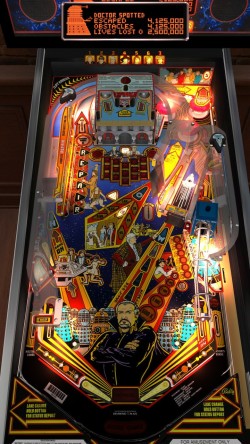 Standard version Permanently Delisted
Standard version Permanently Delisted
Included in Arcooda Software
Table Type: Pick ‘n Flick
TABLE FACTS
Designed by Barry Oursler & Bill Pfutzenreuter
Art by Linda “Deal” Doane
Sound by Jon Hey
DMD by Scott Slomiany
1992 Midway Manufacturing, 7,752 Units Sold
TRIVIA
-Prototypes included a Dalek topper that moved left to right. About 100 of these units were released to operators.
-Features the likeness of the first seven Doctors from the series.
TEAM RANKING: #6 OF 96
Oscar’s Rating: Great (#15)
Jordi’s Rating: Masterpiece (#9)
Angela’s Rating: Great (#15)
Eala’s Rating: Masterpiece (#2)
THE PINBALL CHICK CERTIFIED EXCELLENT TABLE
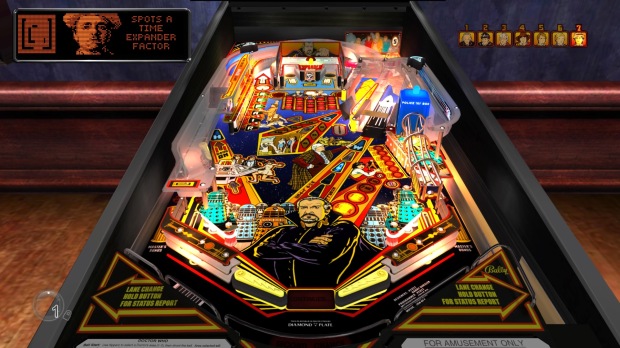
Doctor Who is one of the few tables where modes are divided into “mode zones.” Why isn’t this design copied more? It’s so smart.
Doctor Who does the unthinkable: it reaches masterpiece status with those damned lightning flippers. Four tables had the displeasure of wearing them: Fish Tales, Bram Stoker’s Dracula, Popeye Saves the Earth (the only of the four that was built with them in mind from the ground-up) and Doctor Who. Popeye might never get the digital translation due to the rights holders being complete tosspots who think Popeye is worth a gazillion dollars in the 21st century. Sounds legit to me. Why, not a day goes by where I have to hush up a ten-year-old who won’t stop raving about the hidden depths of Popeye and how, with a can of spinach, he can easily take out Goku. Anyway, Doctor Who was probably the single most anticipated of all the tables I played for this marathon. I admit, I rolled my eyes a bit at that. Doctor Who ain’t my thang. I thought the Christopher Eccleston version was fine. That was my introduction to the series. I got bored halfway through the David Tennant run, haven’t liked anything I’ve seen from anything since Matt Smith took over, and couldn’t even make it through the slog of the first episode with the new female Doctor. In short, I’m not a fan of this show.

The time expander opens into a row of three Daleks in a fashion similar to Pin•Bot’s visor. In fact, I wouldn’t be surprised if they recycled the molds or parts from that table. Either way, I’m not even kidding when I say that hitting these shots is one of the single most rewarding, satisfying shots I’ve ever experienced. I have GOT to get a real Doctor Who table. Of course, they did miss out by NOT turning the bumpers into Daleks. I can’t believe Master of Time did one thing better. Eh, it’s a cosmetic upgrade, not a gameplay one. Still, I did enjoy Master of Time’s bumpers sounding like filth-spewing Coneheads that had throat cancer. What? What would YOU say a Dalek sounds like? Conehead with throat cancer is accurate.
I can’t imagine how good this table must be for fans. On its own merit, as a pinball experience, Doctor Who is so fun and rewarding to play that I can’t believe it’s not held in higher esteem by fans of the medium in general. Despite being a Barry Oursler/Bill Pfutzenreuter joint production, it feels a lot like a Brian Eddy work at times. A great big centralized target is the launching point for one of the most exhilarating multiball experiences I’ve had as the Pinball Chick thus far. Surrounding this is a near-perfect layout of ramps and targets that never feel cheap or designed to rob players. The concept of each Doctor having their own unique rules is so well implemented. Really, Doctor Who was probably the greatest pinball fan service of its time. If not for those damned Lightning Flippers, Doctor Who would probably be in the discussion for the top spot of the Pinball Arcade’s rankings. There’s some arcade owners in Europe who have no idea just how much their whining screwed-up some amazing pinball machines.
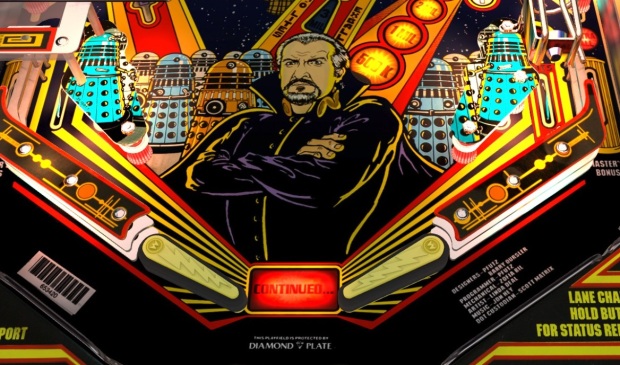
Lightning Flippers turn every pinball’s drain into a TARDIS: bigger on the inside. Sorry. I swear, that sounded more clever in my head.
It’s sort of amazing to me that the Farsight saw this colorful, whimsy table and their only takeaway from it was “that W-H-O sequence is pretty swell.” Because that’s literally the only carry-over from the original. Incredibly, the Pinball Arcade will have a Doctor Who table in both the top and bottom tier of the rankings. Which is not to say that this masterpiece doesn’t have flaws beyond the lightning flippers. The video mode angle is technically a blind one (though the shot to get to it can be guided by shooting behind the Seventh Doctor’s zone), the multiballs have a tendency to drop straight through the drain (which you get back via ball save, though it threw my timing off and I struggled getting the balls re-synced), and the rules are little too convoluted. The biggest flaw though is in Pinball Arcade’s translation. A truly horrible glitch caused the table’s sound effects (as in the noise the flippers and targets make, not the audio from the DMD) to mute. Once this happened, the effects remained muted for ALL tables afterwards. It forces you to completely restart Pinball Arcade from the dashboard if you want them back. This was a table funded via Kickstarter, so I find it obnoxious that this was never patched (and presumably never will be now that it’s been delisted). I’m not going to take away from the gameplay because of that, but if you want to get immersed and feel like you’re playing a real Doctor Who table, you’ll need to close the program and restart it between each round of play. Someone get Farsight a Sonic Screwdriver.
#6: High Speed
Member of the 12K Club
 Standard version Permanently Delisted
Standard version Permanently Delisted
Included in Arcooda Software
Table Type: Sharpshooter-Kinetic
TABLE FACTS
Designed by Steve Ritchie
Art by Mark Sprenger and Python Anghelo
Sound by Steve Ritchie, Bill Parod, Larry DeMar, and Eugene Jarvis
1986 Williams, 17,080 Units Sold
TRIVIA
-High Speed is the first Williams table with alpha-numeric display.
-First table to “play a complete song.”
-First pinball machine where jackpots were exclusive to multiball.
-High Speed’s first-of-its-kind operator report option for owners was considered a revolutionary time-saver for arcade management. This was considered a major gamble by Williams, as industry pundits had labled it “High Cost” and expected the table to be a historic failure.
TEAM RANKING: #4 OF 96
Oscar’s Rating: Masterpiece (#1 Ranked Table)
Jordi’s Rating: Masterpiece (#8)
Angela’s Rating: Masterpiece (#12)
Eala’s Rating: Masterpiece (#4)
THE PINBALL CHICK PANTHEON OF DIGITAL PINBALL INDUCTEE

After a few hours of playing High Speed, it moved high up our “real table” wish list, and probably also to the #1 spot for Pinball FX3’s alpha-numeric wish list.
High Speed is a legend. The 6th best-selling solid state machine and a genuine experiment in using more complex CPUs for pinball. Heck, it probably even has the most interesting story of any pinball attached to it, because creator Steve Ritchie once led police on a 146mph chase in his Porsche 928. Translating that tale, tall or not, to pinball was something relatively unheard of at the time. High Speed employed the new Williams 11 system and higher-cost components to make it work, which led to companies like Gottlieb snickering that the table should be called “High Cost” or “High Price.” Thankfully, arcade operators took a chance on it. It paid off. The amount of firsts that High Speed achieved is staggering. The first Williams alpha-numeric game. The first pinball ever where the jackpot is tied exclusively to multiball. It even introduced the operator report for owners.

The San Diego freeway shot is a tight-squeeze teased with a seemingly straight-angle. When the pressure was on, I clanked more shots trying to sink this than pretty much any other major shot on any table. I just couldn’t get the hang of it. Oh, it was on me for sure. Dad could make it with his eyes closed.
I’m always skeptical of tables that get too much acclaim from older games. Tables that come with the legend of John Henry’s hammer I almost feel sorry for. There’s no way the cruel test of time can be fair to them. And frankly, High Speed had a sequel. A critically-acclaimed, beloved sequel that did almost as well as the original. But, whereas I feel that Getaway: High Speed II tends to be brutally difficult, the original high speed is perhaps the most perfectly-balanced challenge in the medium’s history. It’s not a slouch, but it’s fair and when you die, you know it’s on you. And you will die. Missed orbital shots feed the outlanes, while misfired stoplight shots feed the drain. Precision is necessary, but there’s just enough leeway to get away coming short of perfection. Getaway often lacked such mercy, and that’s why High Speed is a better table.

The fatal flaw of High Speed on Pinball Arcade is an extremely annoying glitch that’s seemingly exclusive to multiplayer dueling. Sometimes, the game accidentally spits a locked ball out before multiplayer, giving you two balls to work with. This happens in Gateaway as well, and if it happens during Video Mode for that table, you’ll lose the extra ball. If it happens in High Speed, you get to play both balls and don’t die if one is loss. “Ball Locking” we called it. I wrote about it much earlier, but I figure 90% of the people reading this probably skipped ahead to the Masterpieces. Anyway, absolutely bizarre glitch, and it ruined several games Dad and I had.
But, High Speed’s greatest achievement is that it holds up today, in the year 2020. A table older than me left me dazzled and excited and giddy to play more. High Speed is fast and white knuckle, but smart and elegant too. Perfect target placement and one of the all-time great short-orbits make this table such a thrill to play, even today. I think only Funhouse’s bat surpasses the bat in High Speed among the best of its breed. Finally, the multiball is in the pantheon of the concept. Everything High Speed does is fine-tuned and as close to flawless as you can get. There’s a reason why people who make pinball machines like Pat Lawlor or Dwight Sullivan usually list this as their favorite table. Sometimes the legends live up to their reputation.
#5: Indianapolis 500
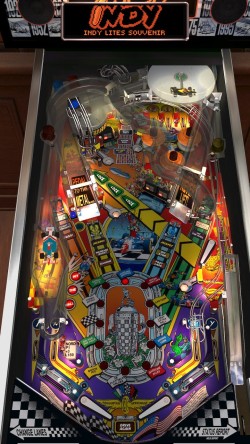 Standard version Permanently Delisted
Standard version Permanently Delisted
Included in Arcooda Software
Table Type: Pick ‘n Flick
TABLE FACTS
Designed by Dennis Nordman
Art by Dan Hughes and Paul Barker
Sound by Chris Granner
DMD by Adam Rhine and Brian Morris
1995 Midway Manufacturing, 2,249 Units Sold
TRIVIA
-Commentary includes longtime Indy 500 announcer Paul Page and Tom Carnegie along with three-time Indy 500 winner Bobby Unser.
-Legend has it whether Indianapolis 500 would be a Bally or Williams-branded game was determined by a coin flip.
TEAM RANKING: #8 OF 96
Oscar’s Rating: Masterpiece (#8)
Jordi’s Rating: Masterpiece (#11)
Angela’s Rating: Masterpiece (#8)
Eala’s Rating: Great (#29)
THE PINBALL CHICK PANTHEON OF DIGITAL PINBALL INDUCTEE

I wonder if the theme is why Indy 500 isn’t more legendary. If you’re not a racing person, you might not be inclined to try a racing-themed pin. I’m more of a Formula 1 chick, but they don’t have a pin based on it yet.
Indianapolis 500.. hence forth referred to as “Indy 500” because I’m a lazy snot.. is the single most underrated table in pinball history, and the single greatest stroke of luck of my pinball existence. For, you see, once upon a time we had an unworking Creature from the Black Lagoon table in our personal collection that was demon possessed. The cursed thing never worked, possibly because the previous owner, in attempting to mend it himself, replaced the power supply with the wrong voltage and may or may not have fried.. well.. everything. Plus the hologram had decomposed too (no joke, they actually rot), which I’m still convinced is the only reason people hold a bland-but-decent-at-best table in such high esteem. Finally, my Dad found a local dealer who would accept a trade of otherwise good-condition Creature and our broken Pinball 2000s for Lethal Weapon 3 (which he had too many of and nobody to unload them on) and Dad’s choice of one of four other pins: Shaq Attaq, Maverick, one he can’t remember, and Indy 500. Lethal Weapon 3 is.. eh. I mean, it’s fine. It was Data East’s second-best-selling table (just fifty units behind Star Wars) for a reason.
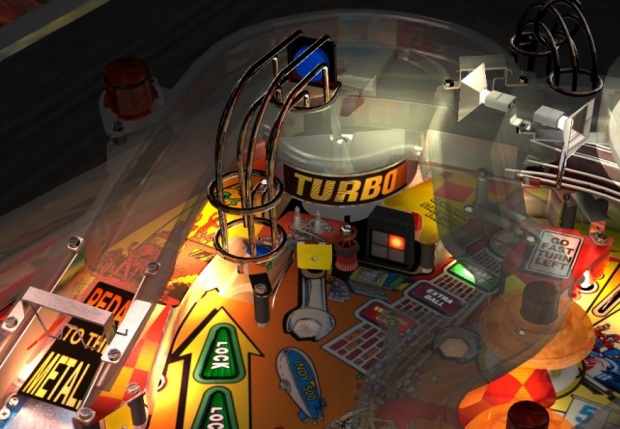
The turbo shot is maybe the most deceptive shot in Pinball Arcade. It’s a tight, precision-shot that is always a bit higher than you think it is.
But, that trade netted us Indy 500, which became one of my favorites, and by far the game I enjoy dueling my Dad at the most. I didn’t realize at the time he brought it home, though. It was our Jack and the Beanstalk moment. The Lethal Weapon had to be part of the trade. The Dealer had three of them and couldn’t get rid of them. But, I had hoped that, for the second table, Dad would select the Data East pin based on Maverick. Indy 500? Seriously Dad? After playing a couple games of Indy 500, he assured me I’d like this table more, and I sulked like a spoiled brat for about five minutes. Mind you, I’d never played High Speed or Getaway, which Indy 500 is an unofficial sequel to (fans of those will find Indy 500’s layout very familiar). Then I played it, and I was hooked. Thanks Daddy. Good call. Good call.
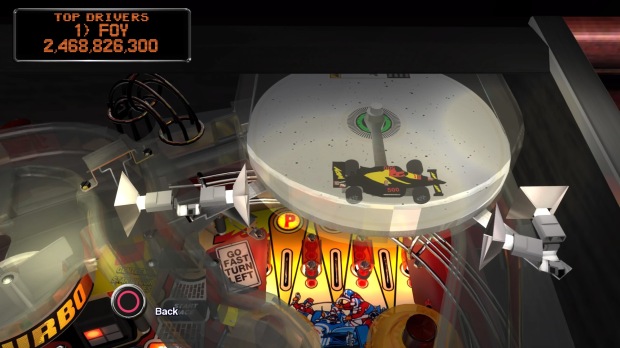
I always wondered if this was meant to be a Taxi-like spinout that got cut because the table was already too complex and expensive. If this same concept had been done in the post-Arcade era by Stern, it absolutely would have been something else instead of a pointless toy spinning around for the shaker. And it’d probably have sucked, too. It sort of sucks here. It obscures the view for the P-I-T lights, and since there’s no shaker, the charm is totally lost. I don’t get it at all. It seems like a waste of money and, unlike other famous toys like the Terminator head or the shuttle in Space Shuttle, nobody’s attention is being caught by this cheap toy spinning around. It’s so dumb.
I think Indy 500 is one of the best grab-bags silverball has seen. There’s a heavy emphasis on shooting orbits, loops, and combos, as you’d expect. But, despite the racing theme, Indy 500 works fabulously as a slower, more deliberately placed sharp-shooter table with some of the most difficult shots in the sport. There’s no kick-holes, which is insanely rare for the era. The off-angle right ramp is, for my money, the toughest ramp on a good table in Pinball Arcade (the toughest is World Cup Soccer’s, and that one I have to believe has something wrong with it). When you get on a roll with it in multiball, where you alternate between the left and right ramps for jackpots, man, it feels like a genuine accomplishment. Speaking of multiball, the only table that feels better oriented for it is Medieval Madness. That’s saying something, and in some ways, Indy 500 is even better. It has a layout tailor-made to juggle the balls, keeping them separated and managed so that you have one ball prepped to shoot at the jackpots. If you’re introducing someone new to the game, this is THE table to educate them on ball management with. Those who watched me play know I’m not exactly amazing with multiball. All I can say is, you should have seen me before Indy 500. This is the table that taught me how to juggle. It’s just fantastic. It’s so overlooked on so many levels.
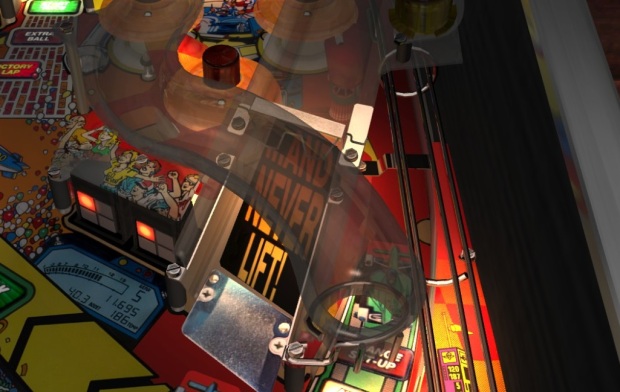
It looks so innocent, and it doesn’t look steep. But, anything short of a flush-hit won’t be enough to clear the right ramp. Which is perfect, because a rejection is low risk. Not risk free. If you completely wiffle ball it, you’ll almost certainly drain out. But, getting a full-force hit won’t be easy. If you want to learn how to manage ramps, Indy 500 is perfectly situated to practice on.
So what can I say? It feels like the excellent final act of a tremendous trilogy. Dennis Nordman took the High Speed formula, but fixed some of the issues Getaway had transitioning to DMD gameplay by adding more stuff to do. Whereas Getaway felt more like a special-edition than a true sequel, Indianapolis 500 IS the sequel to High Speed many of you never knew existed. The same idea, with nearly the same layout, but more multiball modes, more targets, less tight squeezes. and less reliance on the upper orbit to drive the flow of the game. The layout is nearly flawless, and possibly the best of the post-1993 pinball renaissance. That includes Attack from Mars and Medieval Madness. It’s so fun, so rewarding, and genuinely thrilling to trade shooting the left/right ramps for jackpots. Sadly, some major issues with scoring hold it back. The balance is out of whack, with combos not rewarded as much as they should be. The game is too reliant on multiball (“what post-Addams Family table isn’t” quips Dad. Good point), and Indy 500 has one of the very worst, most unfair video modes in DMD pinball. Whatever. I still love this table. If it had any other theme but the one it has, it’d be remembered as one of the all-time greatest. The forgotten masterpiece of DMD pinball.
#4: Attack from Mars
Featured in The Pinball Arcade: Season One (PS4 Disc Only)
Included in Arcooda Software
Alternative Version: Pinball FX 3 Williams Pinball Volume Two
 Table Type: Kinetic
Table Type: Kinetic
Alternative Version: Pinball FX 3 Williams Pinball Volume 2
Designed by Brian Eddy
Art by Doug Watson
Sound by Dan “TOASTY!” Forden
DMD by Adam Rhine & Brian Morris
1995 Midway Manufacturing, 3,450 Units Sold
TRIVIA
-Attack from Mars is the first gaming device with an epilepsy warning.
-The video mode is based on the Apple ][ game Sabotage.
-Artist Doug Watson wrote the dialog and voiced the Martians.
-NOT based on Mars Attacks, the film that came out after the table, nor the Topps trading cards.
TEAM RANKING: #2 OF 96
Oscar’s Rating: Masterpiece (#5)
Jordi’s Rating: Masterpiece (#6)
Angela: Masterpiece (#2)
Eala: Masterpiece (#3)
THE PINBALL CHICK PANTHEON OF DIGITAL PINBALL INDUCTEE
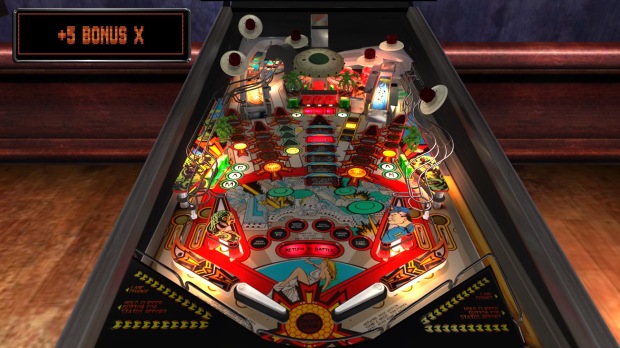
Comparing the exact same table on two different pinball launchers with different physics engines is such a surreal experience. There’s nothing to compare it to in my IGC existence so far.
In my Williams Pinball review for Zen Studios’ Pinball FX3, I have Attack from Mars ranked, as of this writing, 3rd of 18 recreations on the platform. I also noted that the table was “perfect.” I stand by that. It has no flaw that actually matters to gameplay, with only non-essential stuff being kind of annoying. The fact that scoring is centered around millions instead of thousands is dumb and gimmicky. Consistent with the theme? I suppose, but I think themes should be kept to the table and modes. But seriously, I’ve now had months to come up with something of substance to knock about Attack from Mars and still can’t come up with anything. This is a table wholly without flaw. The funnest table ever? No, but I think the most refined and polished.

One of the most deceptively dangerous shots in pinball is, in fact, the primary targets of the saucer. If I had a nickel for every time I drained or out-laned off those, I’d have.. probably around $10. Hey now, that’s a lot of nickels. Now, the question is “will the holographic sequel Revenge from Mars ever RETURN TO BATTLE, SOLDIER?” I don’t know. They say emulating Pinball 2000 is too hard. I say making a really great home version of Attack from Mars would be tough too, yet here we are. I suspect we haven’t seen the last of Pinball 2000.
And, it’s also the best table to compare the two primary digital pinball engines against each-other. Attack from Mars on Pinball Arcade is Attack from Mars, but not the same Attack from Mars you can get in Pinball FX3’s Williams Pinball Volume 2 DLC pack. Certain shots are simpler on each version. In Pinball Arcade, it’s easier to shoot combos. On Pinball FX3, it’s easier to bank the multiball locks. On Pinball Arcade, it’s perhaps too easy to put the ball in the mystery hole. In Pinball FX3, it’s much harder to get a Dirty Pool blowing up the saucer in multiball. How much difference do different physics engines REALLY make? A lot. I give the edge to Pinball FX3’s port because it plays smoother, but both versions are incredible ports of a truly amazing table.
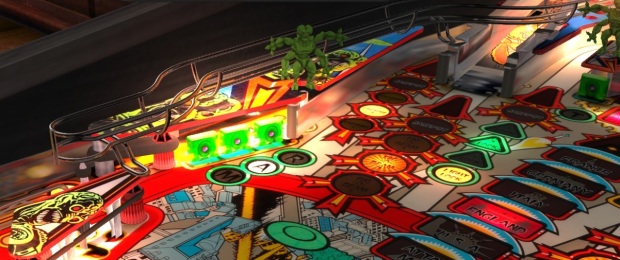
Oh my God!! I thought of something that Attack from Mars could have done better! It could have awarded extra points for taking out the Martians in attack-mode in a specific order! I DID IT! Well, wait, that’s not exactly a flaw, is it? Because the mode is awesome and hugely satisfying even if there’s a way it could have been even better. Damnit. The search continues.
I love Attack from Mars. I love its sense of flow. I love getting into a groove and shooting the M-A-R-T-I-A-N targets. I love the hurry-ups (which, yea, are all the same, but hey, unlike Harley Davidson that did the same thing, that same shot here is always exciting!). I love the pace. I love the multiballs. I love the risk/reward balance and the targets that are so perfectly placed for temptation. “I could destroy the saucer, but I’m only one lock away from multiball. I have been hitting my shots, but I only have one ball left. Hmmmm..” Attack from Mars is the most chaotic sharp-shooter ever made. It feels like an early 80s table on steroids. A sharp-shooter that DARES YOU to go ahead and try to play a live ball to earn more points when you know you’re losing control. It’s fast. It’s chaotic. And it’s so much fun. Attack from Mars is truly a work of art. Not the best table ever, but the most perfect. If that makes sense.
#3: Medieval Madness
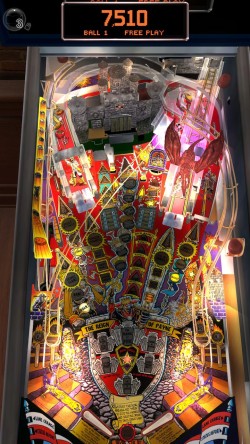 Featured in The Pinball Arcade: Season One (PS4 Disc Only)
Featured in The Pinball Arcade: Season One (PS4 Disc Only)
Included in Arcooda Software
Alternative Version: Pinball FX3 Williams Pinball Volume One
Table Type: Finesse
Designed by Brian Eddy
Art by John Youssi and Greg Freres
Sound by Dan “TOASTY!” Forden
DMD by Adam Rhine and Brian Morris
1997 Williams, 4,016 Units Sold
TRIVIA
-Tina Fey of Saturday Night Live fame provided the voice for the Opera Singer and the Cockney Princess.
-Kevin Dorff, famous for playing a variety of characters for Conan O’Brien’s various talk shows and writing for shows like Comedy Central’s Review (a person favorite of Cathy’s) voices some of the male characters.
TEAM RANKING: #3 OF 96
Oscar’s Rating: Masterpiece (#6)
Jordi’s Rating: Masterpiece (#3)
Angela’s Rating: Masterpiece (#9)
Eala’s Rating: Masterpiece (#5)
THE PINBALL CHICK PANTHEON OF DIGITAL PINBALL INDUCTEE
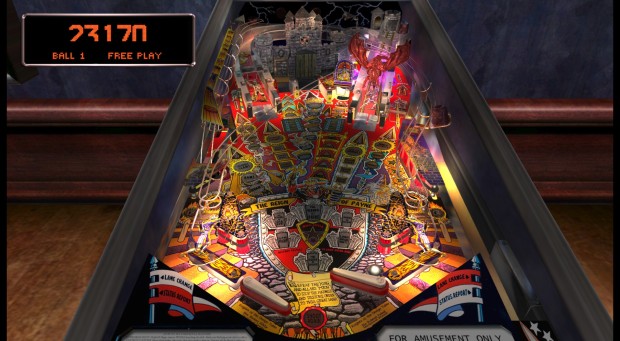
Both Attack from Mars and Medieval Madness are types of Japanese fan designs, though Medieval Madness has a color-coating scheme to make it more obvious. But, if you want to learn angles, you can use those colors.
The current champion of Pinball FX3 is a top contender for the Pinball Arcade “best table” title as well. Maybe Brian Eddy’s fact-based historic study of the plights of dark age social climbing (wait, you’re telling me that’s not what Medieval Madness is about?) just lends itself to digitization. There’s no plunger to screw-up. The angles are mostly simple, with the Damsel ramp as the only relatively complex angle, and both Zen Studios and Farsight managed to replicate it without crapping the bed. Really, like Attack from Mars, Medieval Madness is deceptively simple. A table by a designer who fundamentally understands the ultimate truth of pinball: the greatest challenge is the pressure players put on themselves.
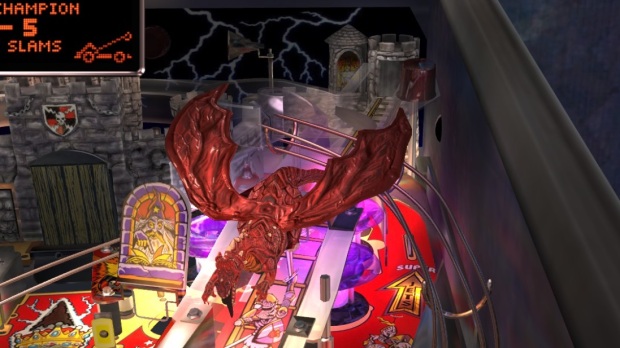
The Dragon Ramp is much easier to hit on Pinball Arcade than on Pinball FX3. There, you practically have to be Euron Greyjoy no-scoping Rhaegal. Don’t get me wrong: the Damsel Shot is very hard on real tables. And it should be, because the reward is great. See how that works?
There’s an unsung hero of the kingdom in Medieval Madness. His name is Lyman Sheats, and he’s responsible for a lot of the fine-tuned scoring you see in Medieval Madness. He’s had his hand in other tables you’ve seen in Pinball Arcade, all of which are notable for their scoring balance. Last Action Hero? Sheats did that one. Attack from Mars? Sheats worked on the scoring there. Monster Bash? Yep, that’s Lyman Sheats. Even the horrible Big Buck Hunter Pro, I must concede, has very balanced, fair and rewarding scoring that factors in risk/reward as well as possible on a god-awful table. The man is a genius, and this is his masterpiece too. Because Medieval Madness has the greatest scoring sheet of any “famous” table. It’s practically scientific, and it makes for thrilling single player games and especially exciting multiplayer games. If you’re lucky enough to have pro mode and can turn tournament mode on, eliminating the randomness from Merlin’s Magic, matches with this and Firepower will let you know who is the better player with who you duel with. Mr. Sheats, you’re a hidden legend, but a legend nonetheless.
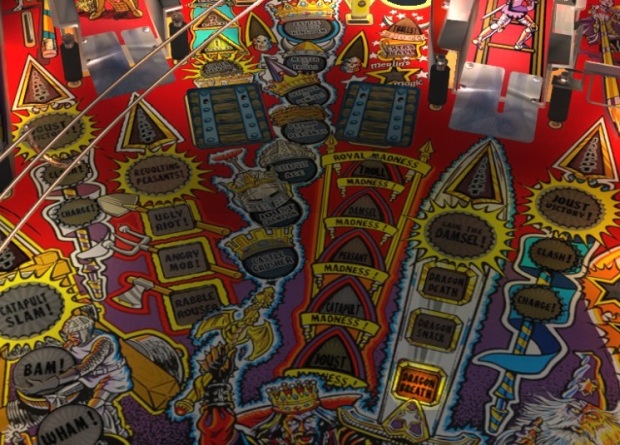
Medieval Madness was made for EVERYONE. If you’re a veteran, you can do your thing. If you’re a newcomer, there’s actually guider-lines to every angle you can use to practice on. Just try to put the ball in the middle of the color-coated light paths. I like that. It just plain works.
Again, I’m giving the edge to Pinball FX3, even if that’s format’s “boosts”, especially the multiball multiplier, were never designed with Medieval Madness in mind. But, if you go through the trouble of ordering the out-of-print PS4 Season One disc for Pinball Arcade, you’ll find a masterpiece of a table that’s good for different reasons. Here, it’s a bit tougher to shoot orbits and the catapult is a bit harder to access. The trolls are slightly tougher to avoid a drain-out. The Dragon Ramp leading to the Damsel Shot is easier, go figure. But, in terms of ball speed and angles, this is actually closer to a real Medieval Madness. You can’t go wrong with either version, but since you can’t purchase the Pro version anymore, you get more flexibility and a better version of the game rules with Pinball FX3. While we’re on the subject, when is Pinball FX3 going to let us open the coin doors? Come on, guys, it’s in the ROM! Yea yea, I know. It’d mess up the game’s ratings if people could turn off Family Mode. Sell us a higher rated version and region lock it! There’s ways around that.
#2: Space Shuttle
Member 7K Club
 Featured in The Pinball Arcade: Season Two (PS4 Disc Only)
Featured in The Pinball Arcade: Season Two (PS4 Disc Only)
Included in Arcooda Software
Table Type: Sharpshooter
Designed by Barry Oursler & Joe Kaminkow
Art by Mark Sprenger
Sound by Eugene Jarvis and Bill Parod
1984 Williams, 7,000 Units Sold
TRIVIA
-Space Shuttle is considered the first solid-state table with a toy.
-Instead of being named after a real vessel from NASA’s fleet, the shuttle is named “Defender” after the Williams classic (and Cathy’s personal #1 golden age arcade game).
TEAM RANKING: #7 OF 96
Oscar’s Rating: Great (#11)
Jordi’s Rating: Masterpiece (#4)
Angela’s Rating: Great (#19)
Eala’s Rating: Great (#16)
THE PINBALL CHICK CERTIFIED EXCELLENT TABLE
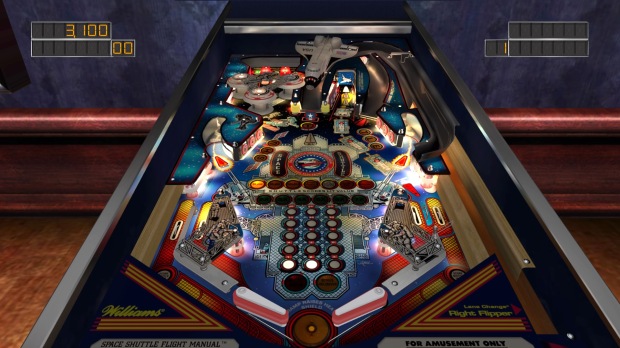
The table that makes me hope 1up Arcade and Zen Studios team up for an alpha-numeric model. I want this table to finally, at long last, be celebrated for its greatness. It feels like it slipped through the cracks of history, and that’s a crying shame.
Space Shuttle is often credited as “saving Williams pinball” though I’d argue that the true credit should go to Williams assembling the right talent and giving them enough freedom (not to mention the budgets) to finally advance past the conservative traditions of the pastime. Hell, Gottlieb had talented designers like Jon Norris and Ray Tanzar, but talent means nothing if they’re also not provided the tools to succeed. Flip the script and give each company’s designers the other team’s constraints and freedoms and it would have been Gottlieb that dominated the late 80s through the 90s, and you know I’m right. So, credit to Williams for giving their designers room to thrive. Plus, I think true credit should really go towards starting to theme tables based on stuff people can feel a connection to. Comet, F-14 Tomcat, High Speed, Pin•Bot, Sorcerer, Fire, and so many more did follow in Space Shuttle’s wake, and I guess the argument is that, if not for Space Shuttle’s success, they’d never happened. I’m not sure I buy into that. Really, once they stopped doing surreal acid-trip designs like Barracora, Cosmic Gunfight, and yes, probably even Centaur, and instead used themes that were easy to recognize and comprehend, Pinball was all set to enter another boom period. The days of bland tables like Laser Cue were over, and good riddance.
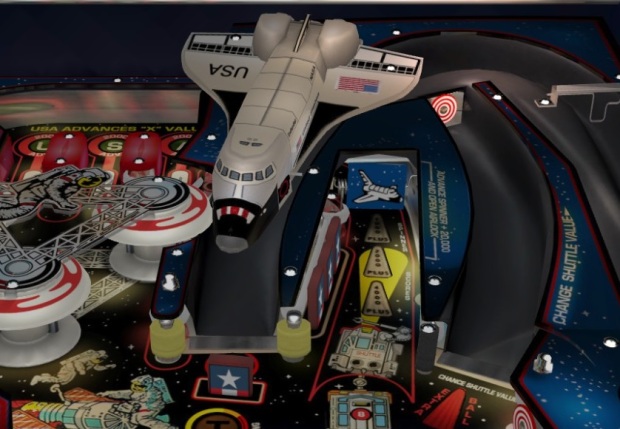
Space Shuttle’s.. ahem.. space shuttle, actually isn’t the first toy in pinball history. Hell, going back to 1935, a company called Stoner included a model airplane in their Zoom table. That’s back when the “pin” in pinball meant the table was covered in actual pins. But, toys were considered an unnecessary expense. The game and the art work were the draws. I’m sure it was cheap to manufacture the shuttle itself, relatively speaking, but Space Shuttle was already looking to be one of the most complex tables ever made, and they wanted to put an actual space shuttle on it? Guess what? It might have saved the company. It might have even saved pinball.
Having said that, yeah, Williams pushed their chips all-in on Space Shuttle. They spent a lot of money on this, and the risk was incalculable. If Space Shuttle flopped, that would have been it for Williams, and every legendary table that came after probably never happens. They were banking on the huge shuttle toy catching people’s attention. It didn’t do anything. It didn’t move. It’s decorative. It’s also eye-catching and it worked. So did the perfect sound-effects, speech, lane-changing, and the simple target placement. The one flaw, in my opinion, and the part that kept it from the #1 spot on the board (where it was for months during the writing of this project), are three drop targets that feel crowded-in, as if they weren’t put there by design but because that was the only real estate left they could find room for them. Weird to think there could be a moment of inelegance this late on the list, yet here we are. I hate these targets.
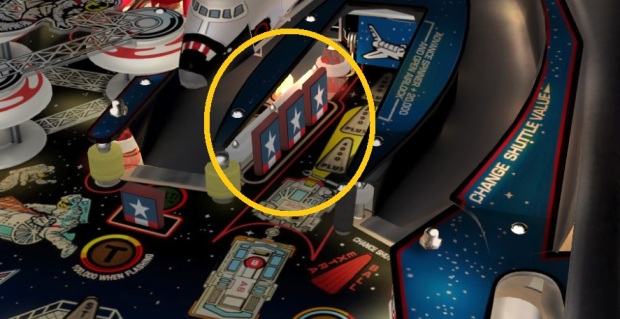
On a real table, these aren’t so bad. On Pinball Arcade, I couldn’t find a good way to hit them consistently. And on Pinball Arcade, they’re one of the five “standard goals” for Space Shuttle. Usually, those take about five seconds (give or take) to knock out. Space Shuttle’s took a lot longer. The only standard goal on any table I had a tougher time getting was hitting the top-valued skill shots on tables like Cyclone, which you can blame on the plunger system. Keeping it real, I still haven’t quite figured out a viable, consistent way to shoot these targets in Pinball Arcade or on a real Space Shuttle. How could they put these here? Maybe there was originally a side flipper? I can’t imagine where. Ugh, what a blight on an otherwise perfect table.
Space Shuttle does deserve credit for being an absolute masterpiece in the annals of pinball. A player’s table with simple targets, generous extra balls, and fast multiballs. Everything about this table works, with the possible exception of the three drop-targets that are borderline blind-angles. The U-S-A multiplier roll-overs are some of the best placed in pinball history. The S-H-U-T-T-L-E targets are perfectly located for chaotic bouncing AND for carefully-aimed shooting. You can have a simple two-ball multiball or the standard three-ball with easy locks and quick and simple activation without the steps becoming more convoluted. I don’t now how popular this was with operators since good games can go quite long on it, but Space Shuttle is my favorite 80s table. This is really something special, and I wish we could get a modern remake that retains the spirit of the original but in a slick and modern package.
#1: Terminator 2: Judgment Day
Member of the 12K Club
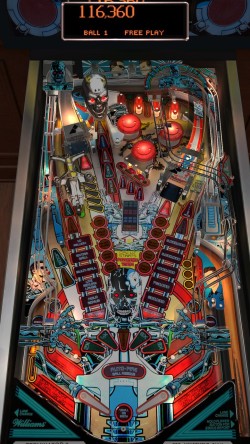 Featured in The Pinball Arcade: Season Two (PS4 Disc Only)
Featured in The Pinball Arcade: Season Two (PS4 Disc Only)
Included in Arcooda Software
Table Type: Sharpshooter
TABLE FACTS
Designed by Steve Ritchie
Art by Doug Watson
Sound by Chris Granner
DMD by John Vogel and Scott Slomiany
1991 Williams, 15,502 Units Sold
TRIVIA
-Terminator 2 is the first Williams table designed with a DMD. Production delays resulted in Gilligan’s Island being the first released. It’s still the first under the Williams lable, as Gilligan was released as a Bally table.
-First table with an auto-plunger off the serve.
-First table with a video mode.
-First table with a swing-out cannon fired by the player.
TEAM RANKING: #1 OF 96
Oscar’s Rating: Masterpiece (#3)
Jordi’s Rating: Masterpiece (#1 Ranked)
Angela’s Rating: Masterpiece (#4)
Eala’s Rating: Masterpiece (#1 Ranked)
THE PINBALL CHICK PANTHEON OF DIGITAL PINBALL INDUCTEE
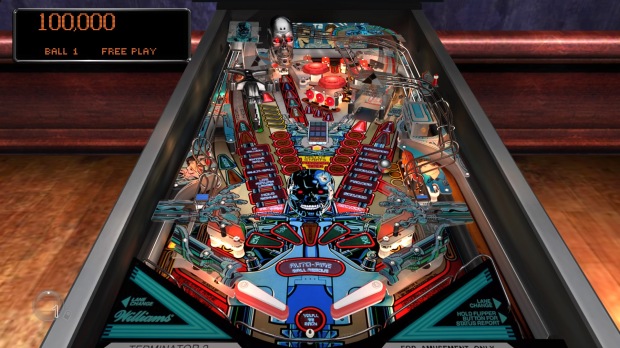
If you’re still reading at this point, thanks. Unless you skipped ahead to see what was #1. You did, didn’t you? Nine months spent writing this and you skipped 99% of it? You monster! Well, at least you clicked the link. I guess. Well, could you at least lie to your friends and tell them you read the whole thing and it’s fantastic, and link them to it? Thanks. I’ll take your pity link.
Terminator 2 isn’t the best pinball machine ever made, but it’s Pinball Arcade’s best adaption. I’m going to go ahead and say it: no movie-based table has ever been better than Terminator 2: Judgment Day. I know Addams Family has its supporters, and being a Pat Lawlor fanatic, you’d think I’d be team Addams Family. I’m not. This, my friends, is the greatest movie pinball machine ever, real or digital. The right look, the right use of theme, the right objectives. It has the first use of an auto-plunger, but it does that as right as can be expected (even if clocking the timing is absurdly easy). It has the first ball cannon and utilizes it to perfection with, gasp, clear targets that you can see from any angle. It was the first Dot Matrix Display game (though not the first to market) and it feels like it sets the bar high right from the start on the new scoreboard. It sold over 15,000 units, and yet all the big DMD hits that came after it have sort of buried it in the modern conversation. I hate that. Terminator 2 paved the way for Addams Family to set records. It’s true and beyond dispute.
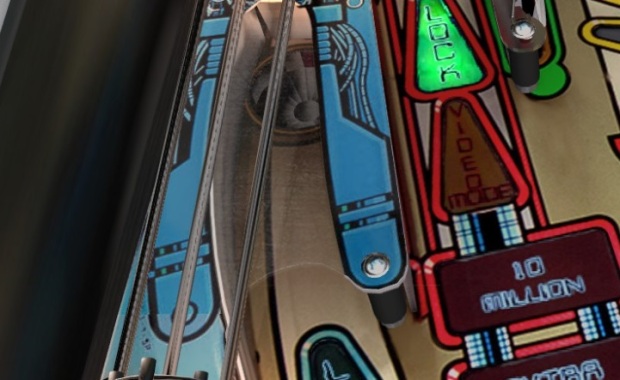
The Database lock is maybe the one poorly-implemented target placement in T2. It’s too easily accessed and acts as an easy dumper if you need to gain quick control of a ball, or to calm a multiball quickly. And it even rewards you for it by raising the jackpot. Maybe a drop target leading to it would have balanced it out somewhat.
Terminator 2 does risk/reward balance than just about any other table. Some shots are downright fatal if you miss them, like the Lab ramp. It directly feeds the drain at such an angle that the post won’t give you a kind bounce if you end up getting returned on shooting it. The Advance/Escape/Route targets are high-risk. The Skynet ramp is high-risk. Hell, you can easily lose control on the seemingly normal Escape Route orbit and feed the drain. This is a not an easy table. So, why does it terminate the competition? Because T2 successfully marries speedy gameplay and the quick reflexes tables like that require with the precision of a sharp-shooter and the dexterity of a combo-heavy table. It’s no wonder that Data East tried to cram everything into Last Action Hero (and Jurassic Park, for that matter). Terminator 2 did! The difference is, Steve Ritchie knew what he was doing and had a plan. It would seem Data East’s plan was just “License Last Action Hero, disassemble several Williams tables, and stick their best parts wherever you can find room for them.” They weren’t alone. Hell, even Williams and Midway in general didn’t fully understand what they had with Terminator and couldn’t recreate it with No Fear, with Flintstones, with Dirty Harry, and many others.
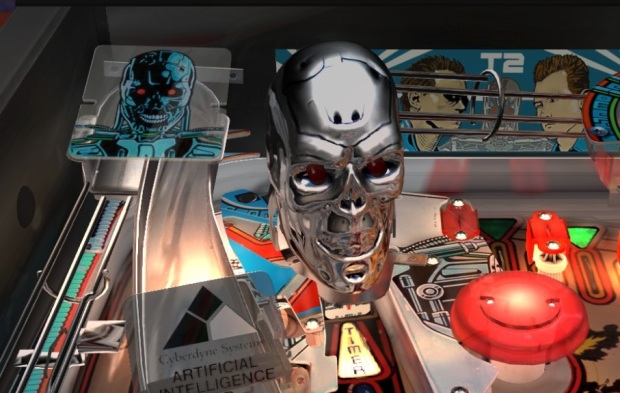
Terminator 2: Judgment Day’s cyborg head is the greatest siren call in pinball. I imagine that anyone who saw this in 1991 just had to try it. Just once. And they either walked away impressed or feeling like they just got punched in the gut and had two quarters stolen from them. One or the other. Also, it looks like Butthead from Beavis and Butthead behind the cyborg head on the wall. It can’t be unseen. You’re welcome! Huh huh huh.
If there’s a flaw in Terminator besides the Database lock being a somewhat underwhelming target, it’s really in the amount of time one has to put into the table to get a feel for the flow of it. Terminator has a slightly sharper learning curve than most tables, and it’s somewhat confusing trying to figure out what exactly you’re supposed to be doing with the checkpoints and lock sequences. But, I don’t necessarily think that’s a bad thing. A major moment of my childhood was when I hit all six targets of the Payback hurry-up mode. I hate my Dad wasn’t there to see it. Once upon a time, he stood a little girl in a chair and taught her how to play Firepower. About eight years later, while he was at work, I finally had an incredible game of Terminator 2 and hit every Payback shot. I’m not sure if he ever believed me, or maybe thought I was cheating. I admit, I was known to dabble in some tomfoolery from time to time, but in that one instance, yes Daddy, I really did make those shots. And, I did it on my first ball, no less. A moment for sure, and that I remember it over eighteen-years after it happened really speaks to how great Terminator 2: Judgment Day is. How memorable it is. This happened in the summer of 2001. At that point, Terminator 2 was ten-years-old, and I never took a moment to wonder what it meant to be timeless. Here we are, in 2020, and no better word describes Terminator 2. Ironic for a table based on a movie dealing with time travel.
Timeless.

I guess that’s the other big knock on T2: it’s not a great beginner’s table. You’ll want to practice up on angles and speed-shooting before you really try to “git gud” at this one. It can be difficult to the point of demoralizing. This is the 100th Pinball Arcade table I’ve reviewed, and as I finish this project, I wondered “would I have put this #1 if I hadn’t owned a real T2 and put a LOT of time into it? Would I have found it too frustrating? Too difficult?” I don’t know. Jordi doesn’t own it, and he put it #1.
What a truly marvelous table. Steve Ritchie’s best work in my opinion. Everything you’d want from a 90s onward table is here and polished to a mirror shine. Shooting orbital combos? Feels great. Sequential targets laid out along primary angles? Here, and executed brilliantly. If I have to knock something, and I sort of do, I think the rollover targets and multipliers are made too easy by generous bumper placement and responsive lane changing. I also wish the Terminator head wasn’t positioned in a way that required nudging to the degree it does to not drain out, pin or no pin. But those are nitpicks. Terminator 2 is magical. It’s one of the all-time great tables to introduce people to the medium, even if it’ll kick their butts, because they’ll WANT to get better. It’s gorgeous to look at. It has Arnold Schwarzenegger! And yes, it really is him doing the voice work, and he’s not even half-assing it! I don’t know if my former governor.. that still looks surreal when written down like that even a decade later.. is a pinball fan or not. Given how he’s been generous with his likeness license, I think it’s safe to say he’s proud of his contribution to the pastime. As he should be. T2 is one of my top three favorite real-life pins ever and this is an excellent port of it. The best in in Pinball Arcade. It’s worth the price for an imported Pinball Arcade: Season Two disc alone. At least until Pinball FX3 does their inevitable port and renders it obsolete.
ACKNOWLEDGEMENTS
Dad, thank you for.. well.. everything! But especially for passing on your love of pinball to me. Working on this project with you has been the happiest time of my life.
Mom & Angela, thanks for putting up with the approximately 600 hours Dad and I took up the living room playing this.
Jordi, this wouldn’t have gotten off the ground without your help.
Brian, thanks for listening to me drone on and on about the science of pinball and never getting bored.
William, your friendship I treasure and cherish. You’re always there when I’m feeling blue and turn my feelings around quickly.
Farsight, thanks for providing us with the delisted tables. Made our year!
Swimming33, your help really put this over-the-top for us.
Indie Gamer Team, thanks for the support and encouragement. I love you all.
Xin, thanks for being my rock.
Jon & Aki, the brother and sister I wish I always had.
Keith P. Johnson, thanks for the insider point of view you provided. It was very educational.
Eala Dubh Sidhe, one of the greatest parts of this project was meeting you and gaining your friendship.
Masterblud, thanks for the hand getting me started as IGC.
Saud, your friendship is invaluable.
McP, I hope all your dreams come true.
Ryan, I hope you don’t stay obscure.
Mac, you always have something to say to make me smile.
Andy, you have a bright future. The smartest kid I know.
Bob, your support has helped me find an entirely new audience. I can’t thank you enough.
To the entire internet pinball community, thank you for making me feel immediately welcome and loved.
Fun With Bonus, thanks for getting the word out The Pinball Chick had opened.
To all my fans and followers on Twitter who didn’t unfollow me when my feed suddenly had thousands of pinball clips instead of indie game clips, thank you. It means the world to me.
Finally, to the amazing designers and artists who crafted the tables, we never took you for granted. Thank you, from the bottom of my heart.
Please do not reprint, republish, or reproduce this guide. This was made exclusively for ThePinballChick.com and was the result of hundreds of hours of playing and hundreds of hours of writing.

